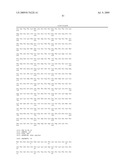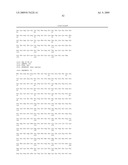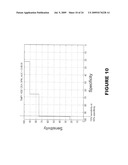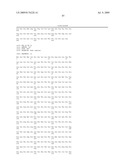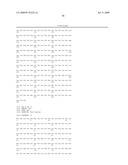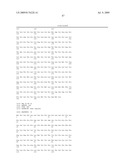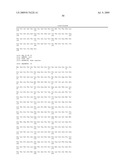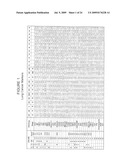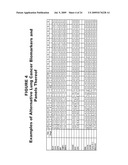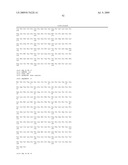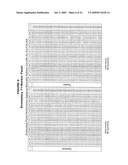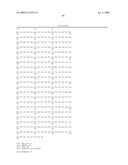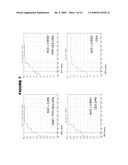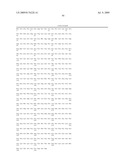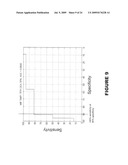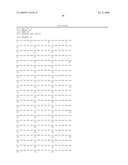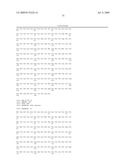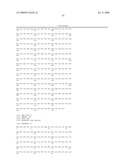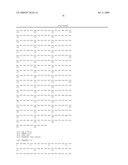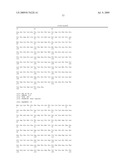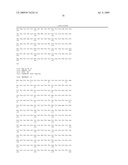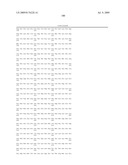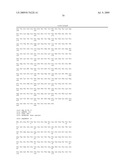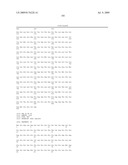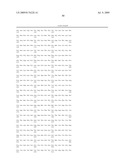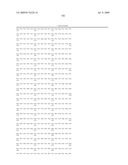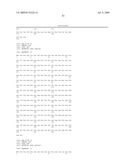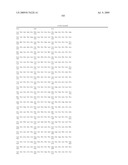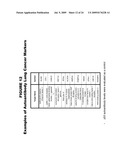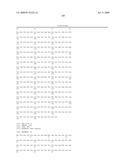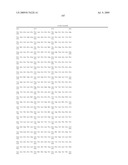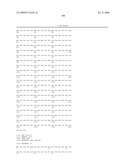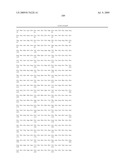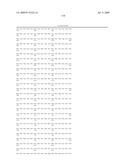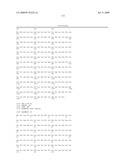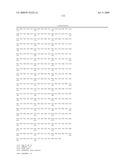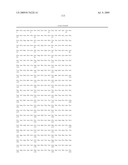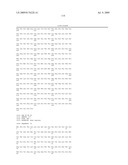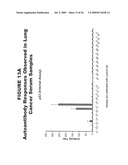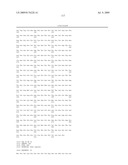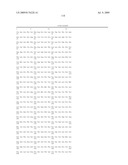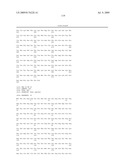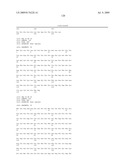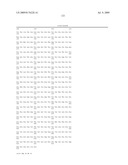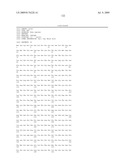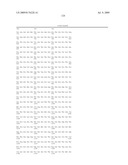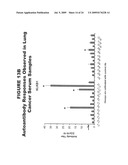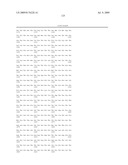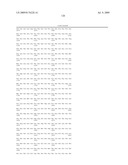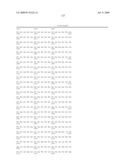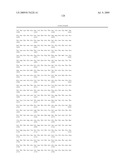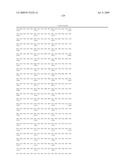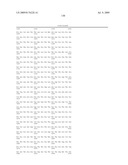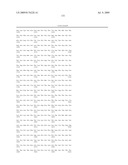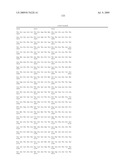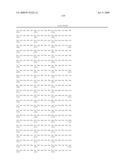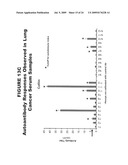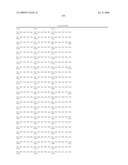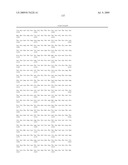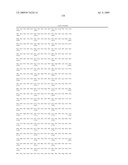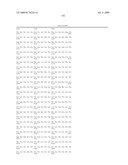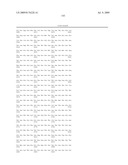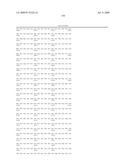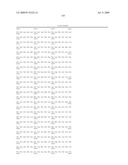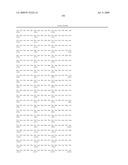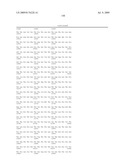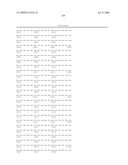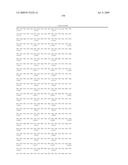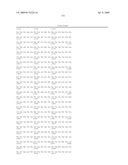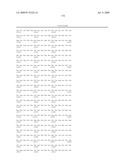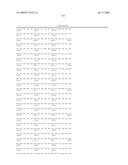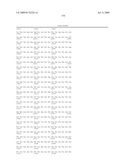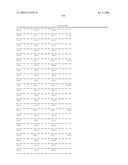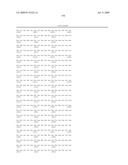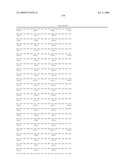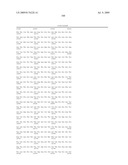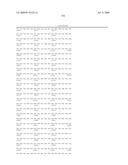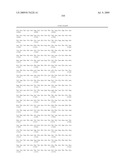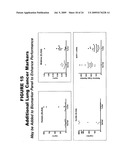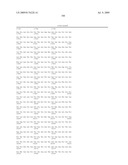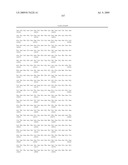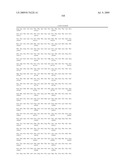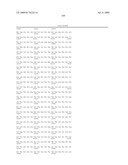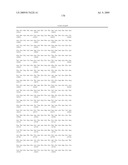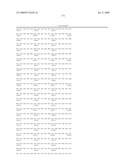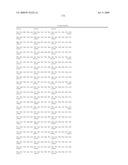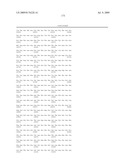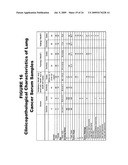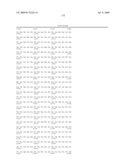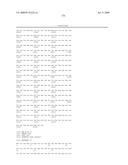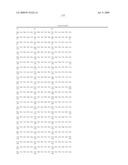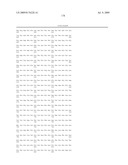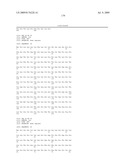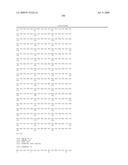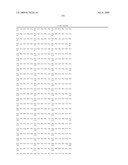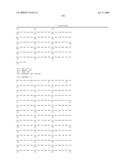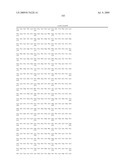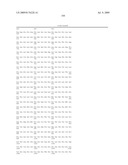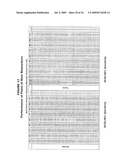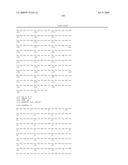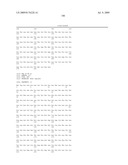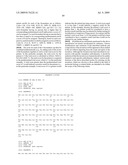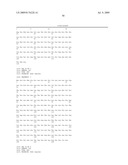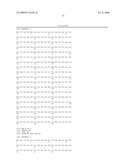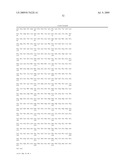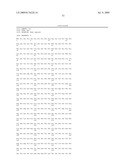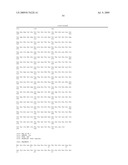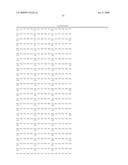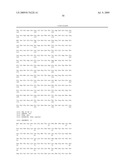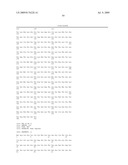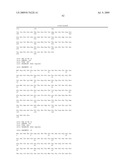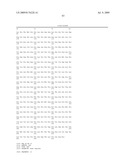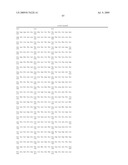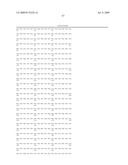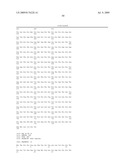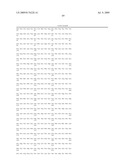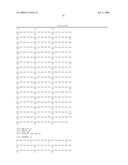Patent application title: LUNG CANCER MARKERS, AND USES THEREOF
Inventors:
Charles Birse (North Potomac, MD, US)
Marcia Lewis (Cohasset, MD, US)
Steven Ruben (Brookville, MD, US)
Mehdi Meari (North Potomac, MD, US)
Assignees:
CELERA CORPORATION
IPC8 Class: AC12Q168FI
USPC Class:
435 6
Class name: Chemistry: molecular biology and microbiology measuring or testing process involving enzymes or micro-organisms; composition or test strip therefore; processes of forming such composition or test strip involving nucleic acid
Publication date: 2009-07-09
Patent application number: 20090176228
Claims:
1. A method of detecting lung cancer in an individual, the method
comprising detecting the level of TFPI in a sample from said individual,
wherein an elevated level of TFPI indicates that said individual has lung
cancer.
2. The method of claim 1, further comprising detecting the level of at least one marker selected from the group consisting of Cyfra, SLPI, TIMP1, SCC, CEACAM5, MMP2, OPN, and MDK in a sample from said individual, wherein an elevated level of the marker indicates that said individual has lung cancer.
3. The method of claim 2, wherein the method comprises detecting the levels of the markers Cyfra, SLPI, TIMP1, CEACAM5, and MDK, wherein elevated levels of a plurality of said markers indicate that said individual has lung cancer.
4. The method of claim 3, wherein the method further comprises detecting the levels of the markers SCC, MMP2, and OPN, wherein elevated levels of a plurality of said markers indicate that said individual has lung cancer.
5. A method of detecting lung cancer in an individual, the method comprising detecting the levels of a panel of markers selected from the group consisting of the panels provided in Table 5, wherein elevated levels of a plurality of said markers indicate that said individual has lung cancer.
6-8. (canceled)
9. A method of determining whether lung cancer in an individual is adenocarcinoma or squamous cell carcinoma, the method comprising detecting the levels of a panel of markers selected from the group consisting of the panels provided in Table 7 in a sample from said individual, wherein differential levels of the markers indicate whether said lung cancer is adenocarcinoma or squamous cell carcinoma.
10. A method of determining the stage of lung cancer in an individual, the method comprising detecting the levels of a panel of markers selected from the group consisting of the panels provided in Table 8 in a sample from said individual, wherein differential levels of the markers indicate the stage of said lung cancer.
11. The method of claim 10, wherein said stage is stage I or stage III.
12. A method of determining whether lung cancer in an individual is small cell lung cancer (SCLC) or non-small cell lung cancer (NSCLC), the method comprising detecting the levels of a panel of markers selected from the group consisting of the panels provided in Table 9 in a sample from said individual, wherein differential levels of the markers indicate whether said lung cancer is SCLC or NSCLC.
13. The method of claim 12, wherein the panel of markers comprises the marker OPN.
14. A method of determining whether a lung lesion in an individual is a malignant tumor or a benign lesion, the method comprising detecting the levels of a panel of markers selected from the group consisting of the panels provided in Table 10 in a sample from said individual, wherein differential levels of the markers indicate whether said lung lesion is a malignant tumor or a benign lesion.
15. The method of claim 14, wherein said lung lesion was observed by computed tomography (CT) screening.
16. A method of detecting small cell lung cancer (SCLC) or non-small cell lung cancer (NSCLC) in an individual, the method comprising detecting the levels of a panel of markers selected from the group consisting of the panels provided in Table 11 and 12 in a sample from said individual, wherein differential levels of the markers in Table 11 indicate that said individual has SCLC and differential levels of the markers in Table 12 indicate that said individual has SCLC or NSCLC.
17. A method of monitoring for lung cancer regression or recurrence in an individual, the method comprising detecting the levels of one or more markers selected from the group consisting of the markers provided in FIG. 19 in a sample from said individual at an earlier time point and a later time point, wherein an increase in said levels at the later time point as compared with the earlier time point indicates lung cancer recurrence, and a decrease in said levels at the later time point as compared with the earlier time point indicates lung cancer regression.
18. The method of claim 4, wherein the detecting comprises detecting the marker by immunoassay.
19. The method of claim 18, wherein the immunoassay is ELISA.
20. The method of claim 4, wherein the marker which is detected is a polypeptide.
21. The method of claim 4, wherein the marker which is detected is an mRNA molecule.
22. The method of claim 20, wherein the detecting comprises contacting the sample with an antibody that selectively binds to the marker and detecting the binding of the antibody to the marker.
23. The method of claim 21, wherein the detecting comprises contacting the sample with an oligonucleotide that selectively hybridizes to a nucleic acid molecule encoding the marker and detecting the binding of the oligonucleotide to the nucleic acid molecule.
24. A composition comprising a substrate and detection reagents for detecting a plurality of lung cancer markers comprising Cyfra, SLPI, TIMP1, SCC, TFPI, CEACAM5, MMP2, OPN, and MDK, wherein the detection reagents are coupled to the substrate.
25. The composition of claim 24, wherein the detection reagents are antibodies that selectively bind to the markers.
26. The composition of claim 24, wherein the detection reagents are marker polypeptides or antigenic fragments thereof.
27. The composition of claim 24, wherein the detection reagents are oligonucleotides that selectively hybridize to nucleic acid molecules encoding the markers.
28. A kit comprising at least one container and detection reagents for detecting a plurality of lung cancer markers comprising Cyfra, SLPI, TIMP1, SCC, TFPI, CEACAM5, MMP2, OPN, and MDK, wherein the detection reagents are stored in one or more of the containers.
29. The kit of claim 28, wherein the detection reagents are antibodies or antigens for use in an immunoassay.
30. The kit of claim 28, wherein at least one of the detection reagents is labeled with a detectable moiety.
31. The kit of claim 29, wherein the immunoassay is an ELISA.
32. The kit of claim 28, wherein the detection reagents are antibodies, and wherein the antibodies are at least one of monoclonal, polyclonal, fully human, humanized, chimeric, single-chain, and anti-idiotypic antibodies.
33. The kit of claim 28, wherein the detection reagents are antibodies, and wherein the antibodies comprise an antibody fragment selected from the group consisting of:a) an Fab fragment;b) an F(ab')2 fragment; andc) an Fv fragment.
34. The method of claim 4, wherein the sample is a serum sample.
35. The method of claim 4, further comprising the step of providing a prognosis to the individual.
36. The method of claim 4, wherein the method is carried out following lung cancer treatment.
37. The method of claim 4, further comprising selecting a lung cancer treatment for administration to an individual based on the level of a plurality of said markers, and administering the treatment to the individual.
38. The method of claim 4, further comprising selecting said individual for inclusion in a clinical trial of a therapeutic agent.
39-43. (canceled)
44. The method of claim 17, wherein the method is carried out in conjunction with lung cancer treatment.
45. The method of claim 44, wherein the earlier time point is before the lung cancer treatment and the later time point is after the lung cancer treatment.
46. The method of claim 44, wherein the lung cancer treatment comprises at least one of administration of a therapeutic agent, surgical resection of at least a portion of a lung tumor, or radiation therapy.
47-50. (canceled)
51. The method of claim 5, wherein said elevated levels are either greater than predetermined cutoff levels, or greater than or equal to predetermined cutoff levels.
52. (canceled)
53. The method of claim 5, wherein said panel is selected from the group consisting of the following panels:panels comprising the 9-marker panel (Cyfra, SLPI, TIMP1, SCC, TFPI, CEACAM5, MMP2, OPN, and MDK); andpanels comprising the 6-marker subset of the 9-marker panel (Cyfra, SLPI, TIMP1, TFPI, CEACAM5, and MDK).
54. The method of claim 53, wherein the panel further comprises at least one marker selected from the group consisting of the markers provided in Table 4.
Description:
FIELD OF THE INVENTION
[0001]This invention relates to the field of disease assessment and therapy. The invention provides compositions and methods for assessing and treating diseases, especially cancer, and particularly lung cancer.
BACKGROUND OF THE INVENTION
[0002]Cancer is one of the leading causes of death worldwide, and cancer, especially lung cancer, is difficult to diagnose and treat effectively. Accordingly, there is a need in the art for new compositions and methods for assessing and treating various cancers, particularly lung cancer.
[0003]Lung Cancer
[0004]Lung cancer is the second most prevalent type of cancer for both men and women in the United States and is the most common cause of cancer death in both men and women. The five-year survival rate for lung cancer continues to be poor at only about 8-15%. This low survival is because lung cancer is commonly not detected until it has spread beyond the lungs. Only 16% of new lung cancer cases in the United States are detected at the earliest stage, when the cancer is still localized to the lungs. At this early stage, survival is considerably higher, with estimates as high as 70-80%. Therefore, procedures for detecting lung cancer are of critical importance to the outcome of a patient since these procedures have the potential to reduce mortality. Thus, there is a need for new diagnostic compositions and methods that are more sensitive and specific for detecting early lung cancer.
[0005]Furthermore, there is also a need for new diagnostic compositions and methods for determining the stage of a patient's disease. Stage determination has potential prognostic value and provides criteria for designing optimal therapy. Biomarkers that are indicative of different stages of lung cancer would be useful to facilitate the staging of lung cancer.
[0006]Lung cancer patients are typically monitored following initial therapy and during adjuvant therapy to determine their response to therapy and to detect persistent or recurrent disease or metastasis. Thus, there is clearly a need for lung cancer markers that are more sensitive and specific in detecting lung cancer, its recurrence, and progression.
[0007]Although imaging modalities, such as computed tomography (CT) screening, are being studied to aid in the early detection of lung cancer, controversy remains as to the ability of these methods to impact mortality (1-ELCAP Investigators, NEJM 2006 (355):1763-71 and Bach et al. 2007. JAMA 297:953-961). In addition, the most advanced imaging technologies under study are expensive and not widely available. These CT imaging tests may lead to over-diagnosis of lung cancer, resulting in significant expenses to the health care system to manage patients with pulmonary nodules observed through these CT imaging tests. Furthermore, there is significant morbidity associated with the management of the pulmonary nodules in an effort to ascertain whether the nodules are malignant or benign. It is estimated that 10-50% of smokers in a high risk group have pulmonary nodules upon imaging studies (CHEST 2007 Supplement--Evidence for the Treatment of Patients With Pulmonary Nodules: When Is It Lung cancer?: AACP Evidence-Based Clinical Practice Guidelines). Thus, there is a significant need for novel diagnostics that can be used either independently or with imaging modalities for early diagnosis and improved management of patients with lung cancer. For example, a blood test for biomarkers that has high performance (e.g., high sensitivity and specificity) for detecting lung cancer could provide a low cost complement to CT testing for early detection of cancer. If the performance of a biomarker test were sufficiently high, such a test could serve as a lower cost alternative to CT or X-ray testing. For example, only those patients that tested positive in a biomarker test may then need to undergo more expensive imaging tests. Furthermore, a biomarker test could be used, for example, in a yearly screening regimen for lung cancer.
[0008]Although there have been reports of circulating tumor markers and antigens with potential use in lung cancer (see Schneider, J. 2006. Advances in Clin Chem, 42: 1-41 for a review), markers currently used generally suffer from low sensitivity and less than desirable specificity, especially among smokers (Schneider, 2006), and are typically only used to monitor for recurrence of lung cancer. Thus, there is a need in the art for a panel of markers with high sensitivity (and varying specificities, depending on the clinical indication), such as for detecting lung cancer. Furthermore, there is also a need for novel markers that are useful individually or as part of a panel for detecting lung cancer. Such markers, and panels of markers, would facilitate management of patients with lung cancer, for example.
[0009]For a further review of lung cancer diagnostics, including the use of tumor biomarkers as well as CT screening, see the following citations: Schneider, "Tumor markers in detection of lung cancer", Adv Clin Chem. 2006; 42:1-41; Bach et al., "Computed tomography screening and lung cancer outcomes", JAMA. 2007 Mar. 7; 297(9):953-61; and International Early Lung Cancer Action Program Investigators et al., "Survival of patients with stage I lung cancer detected on CT screening", N Engl J. Med. 2006 Oct. 26; 355(17):1763-71. Also see Pepe et al., "Phases of biomarker development for early detection of cancer", J Nat'l Cancer Inst. 2001. 93(14):1054-1061
[0010]Description of Tables 1-2
[0011]Tables 1 and 2 provide further information for lung cancer markers ("LCM"), including their names, symbols (alternative symbols are indicated in parentheses), Genbank protein accession numbers, and an exemplary protein sequence for each marker (except for the carbohydrate antigens CA 242, CA 19-9, and CA 72-4, for which representative journal citations are provided for each). Exemplary LCM protein sequences are provided as SEQ ID NOS:1-65 (additionally, the carbohydrate antigens CA 242, CA 19-9, and CA 72-4 are also provided). Nucleic acid sequences (e.g., mRNA transcript sequences and genomic DNA) and alternative protein sequences for each marker are well known in the art and can readily be derived using the information provided in Tables 1-2, for example.
[0012]The LCM provided in Table 1 are as follows (alternative names/symbols are indicated in parentheses): SLPI, MIF, TIMP1, TFPI, ENO2 (NSE), CEA (CEACAM5), MMP2, AMBP, Cyfra 21-1 (Cyfra, KRT19), SCC (SERPINB3), OPN, defensin (DEFA1, HNP-1, HNP1-3), CA 242, CA 19-9, CA 72-4, MN/CAIX (CA9), ProGRP (GRP), KRT18 (TPS), ECAD (CDH1), TIMP2, CD44, LGALS3BP, ERBB2 (HER-2), UPA (PLAU), DKK (DKK1), CHGA, VEGF, KITLG, PBEF (visfatin), SORT1 (sortilin), MDK (midkine), IGFBP3, IGFBP4, CTSC, ICAM3, CTGF, LCN2, EGFR, BGN, TIMP3, HGF, MUC16 (CA125), NCAM, CRP, SERPINA1 (ATT), PKM2, RBP, KLK11, KLK13, SAA, and APOC3.
[0013]The LCM provided in Table 2 (which are particularly useful as autoantibody markers) are as follows (alternative names/symbols are indicated in parentheses): TP53 (p53), KLKB1, CFL1 (CFLN), EEF1G, HSP90α (HSP90AA1), RTN4, ALDOA, GLG1, PTK7, EFEMP1, SLC3A2 (CD98), CHGB, CEACAM1, ALCAM, HSPB1 (HSP27), LGALS1, and B7H3.
[0014]Elevated levels of each of these LCM are indicative of lung cancer, except for sortilin (SORT1), for which low levels are indicative of lung cancer.
[0015]Description of Tables 3-12
[0016]Table 3 provides 35 different panels of 11 markers (each row of 11 markers represents a panel) that have at least 98% specificity and 82% sensitivity for detecting lung cancer. The total number of occurrences of each marker in these 35 11-marker panels is indicated at the bottom of Table 3. Seven markers (SLPI, TIMP1, TFPI, SCC, OPN, CEA and CA242) appear in all 35 of these panels, GRP appears in 33 of these 35 panels, MIF appears in 29 of these 35 panels, and NSE and HNP-1 each appear in 15 of these 35 panels. AMBP, Cyfra, MMP2, Ca72-4, Ca19-9, and CAIX each appear in 7-9 of these panels, as indicated in Table 3.
[0017]Table 4 provides markers the can be included in any of the panels disclosed herein. For example, the markers in Table 4 can be added to any of the panels disclosed herein and/or can replace one or more members of any of the panels disclosed herein. As a specific example, the markers in Table 4 can be added to any of the panels disclosed in Table 5 and/or can replace one or more members of any of the panels disclosed in Table 5. The markers disclosed in Table 4 are also disclosed in Table 2.
[0018]Tables 5-12 provide data for the analysis of various panels in various lung cancer uses, such as distinguishing lung cancer samples versus normal samples such as for diagnosing/detecting lung cancer (Tables 5-6 and 11-12, for example), as well as certain specific uses (these specific uses, which may be referred to herein as "indications" or as determining or assessing lung cancer "characteristics", are provided in Tables 7-10, for example). In Tables 5-12, each row represents a panel (a panel may comprise an individual marker). For each panel in Tables 5-12, data are presented based on logistic regression and/or split point analysis (as indicated in each table). Area under the curve (AUC), sensitivity at 95% specificity, and specificity at 95% sensitivity are indicated. "Size" (second column) indicates the number of markers in the given panel. Further information regarding characteristics of the sample sets (the "54×53", "50×50", and "44×44" sample sets) used in each of the analyses is provided in FIG. 16 (the "104×103" sample set used in Table 8 is the "54×53" and "50×50" sample sets combined). In Tables 5-12, and elsewhere herein, "trained" refers to the sample set (which may be referred to as the "training set") which was used to formulate cutoff levels, and "tested" refers to the sample set (which may be referred to as the "testing set") to which these cutoff levels were applied (such as to classify a sample as a lung tumor or normal sample, or other specific use, based on whether marker levels were above or below the cutoff levels established from the training set).
[0019]Table 5 provides data for logistic regression and split-point analysis of the 9-marker panel of Cyfra, SLPI, TIMP1, SCC, TFPI, CEACAM5, MMP2, OPN, and MDK, and all subcombinations thereof (including individual markers), in distinguishing lung tumor samples versus normal (i.e., control/healthy) samples, such as for diagnosing/detecting lung cancer. For each panel in Table 5, data are presented based on logistic regression and split point analysis and based on analysis of either training and testing on the same 54×53 (54 controls and 53 cases) sample set, or training on the 54×53 sample set and testing on the 50×50 (50 controls×50 cases) sample set (see FIG. 16 for characteristics of these sample sets). Area under the curve (AUC), sensitivity at 95% specificity, and specificity at 95% sensitivity are indicated. The panels are sorted based on the AUC indicated in the third column. "Size" (second column) indicates the number of markers in the given panel. Thus, Table 5 provides the 9-marker panel of Cyfra, SLPI, TIMP1, SCC, TFPI, CEACAM5, MMP2, OPN, and MDK, and all panel subcombinations thereof, including each of these nine markers individually (each row represents a panel).
[0020]Table 6 provides data for split-point analysis of panels (including individual markers) that include any of the nine markers in the panels provided in Table 5 and/or various other markers (which are not in the panels provided in Table 5) in distinguishing lung tumor samples versus normal (i.e., control/healthy) samples, such as for diagnosing/detecting lung cancer.
[0021]Table 7 provides data for logistic regression analysis of the 9-marker panel of Cyfra, SLPI, TIMP1, SCC, TFPI, CEACAM5, MMP2, OPN, and MDK, and subcombinations thereof (including individual markers), in distinguishing adenocarcinoma versus squamous cell carcinoma types of lung cancer.
[0022]Table 8 provides data for split-point analysis of the 9-marker panel of Cyfra, SLPI, TIMP1, SCC, TFPI, CEACAM5, MMP2, OPN, and MDK, and subcombinations thereof (including individual markers), in distinguishing stage I versus stage III lung cancer. In addition to their utility in distinguishing between early and late stage lung cancer (e.g., stage I or II versus stage III or IV), the panels provided in Table 8 are also useful for distinguishing between any other stages of lung cancer (e.g., any of stages I, II, III, and IV).
[0023]Table 9 provides data for split-point analysis of various panels in distinguishing small cell lung cancer (SCLC) versus other types of lung cancer (e.g., non-small cell lung cancer, NSCLC). In the left-side of Table 9, marker levels are higher in NSCLC (as compared to SCLC). In the right-side of Table 9, marker levels are higher in SCLC (as compared to NSCLC).
[0024]Table 10 provides data for split-point analysis of the 9-marker panel of Cyfra, SLPI, TIMP1, SCC, TFPI, CEACAM5, MMP2, OPN, and MDK, and subcombinations thereof (including individual markers), in distinguishing malignant lung tumors versus benign lung lesions.
[0025]Table 11 provides data for split-point analysis of various panels in distinguishing small cell lung cancer (SCLC) versus normal (i.e., control/healthy) samples.
[0026]Table 12 provides data for split-point analysis of various panels in distinguishing lung cancer (including both small cell lung cancer (SCLC) and non-small cell lung cancer (NSCLC)) versus normal (i.e., control/healthy) samples.
BRIEF DESCRIPTION OF THE FIGURES
[0027]FIG. 1. Shows relative expression levels for exemplary lung cancer markers (LCM) screened by ELISA in a sample set of 12 lung tumor and 12 normal serum samples. The left portion of the table shown in FIG. 1 provides tumor samples identified by histology and tumor state (histology abbreviations for tumor samples are "AS"=adenosquamous, "A" adenocarcinoma, "SC"=squamous cell carcinoma, and "BAC"=bronchioalveolar carcinoma), and the right portion of the table shows normal samples (identified as "N" for histology). The table is based on mean concentration values of each sample and uses 2 standard deviations (2SD) above normal mean as the cutoff; the value is expressed as fold change from normal mean (thus, any fold change with 2SD above normal mean is above the cutoff). The column labeled "CRA MS" is a summary of mass spectrometry data that indicates the number of differentially expressed lung tumor samples and the median mass spec ratio of these samples (numerical representation of over-expression is indicated by 2.0 or more, whereas numerical representation of under-expression is indicated by 0.5 or less) (lung tumor sample abbreviations for mass spectrometry are "CL LU"=lung cancer cell lines, "TS LU"=lung cancer tissues, and "CM LU"=lung cancer conditioned medium).
[0028]FIG. 2. Shows relative expression levels based on ELISA screening of a sample set of 12 lung tumor (upper section) and 12 normal (lower section) serum samples for the eight markers TFPI, SCC (interchangeably referred to as SSC), CEA, CA242, MNCAIX, OPN, Cyfra 21-1, and MIF (as also shown in FIG. 1). The table is based on mean concentration values of each sample and uses 2 standard deviations (2SD) above normal mean as the cutoff; the value is expressed as fold change from normal mean (thus, any fold change with 2SD above normal mean is above the cutoff). Any value below the cut-off is recoded as 0. Any or all of these eight markers may be used in combination as a panel for lung cancer assessment, and the panel may optionally include additional markers.
[0029]FIG. 3. Shows the performance of the eight marker panel of TFPI, SCC, CEA, CA242, MNCAIX, OPN, Cyfra 21-1, and MIF. Using an algorithm in which markers greater than or equal to two standard deviations were scored "positive", this panel of eight markers had a sensitivity of 92% and specificity of 100% among the 12 sera from lung cancer patients and 12 sera from healthy controls ("FP"=false positives, "TP"=true positives, "FN"=false negatives, and "TN"=true negatives)
[0030]FIG. 4. Shows relative expression levels based on ELISA screening of a sample set of 12 lung tumor (left portion; histology ("Hist") abbreviations are "AS"=adenosquamous, "A"=adenocarcinoma, "SC"=squamous cell carcinoma, "OC"=oat cell carcinoma, and "BAC"=bronchioalveolar carcinoma) and 12 normal (right portion; identified as "N" for histology) serum samples for alternate panels of LCM, including a panel of the markers SLPI, TFPI, OPN, MIF, TIMP1, and MMP2. Any or all of these markers can also be used in any combination with any or all of the following markers: CA242, SCC, CEA, NSE, CA72-4, CA19-9, Cyfra 21-1, and MN/CAIX, as shown in FIG. 4. The table is based on mean concentration values of each sample and uses two standard deviations (2SD) above normal mean as the cut-off; the value is expressed as fold change from normal mean (thus, any fold change with 2SD above normal mean is above the cutoff). Any value below the cut-off is recoded as 0.
[0031]FIG. 5. Shows scatter plots of ELISA data for the six markers CEA, TFPI, MIF, TIMP1, OPN, and Cyfra 21-1 in 44 normal and 44 lung tumor samples, with exemplary cut-offs indicated (dotted lines). Cut-offs can be applied that maximize sensitivity while not compromising specificity of the panel, for example.
[0032]FIG. 6. Shows results of ELISA analysis for the 11 markers Cyfra 21-1, MIF, TIMP1, TFPI, CEA, OPN, SCC, SLPI, HNP-1, GRP, and CA242 in 39 control (normal) samples (left portion, labeled "Control") and 39 lung tumor samples (right portion, labeled "Tumor"). Values shown are concentration (ng/mL). Manually defined cut-offs are indicated immediately below each marker name. The columns labeled "#>cutoff" indicate the total number of markers with elevated expression (i.e., a concentration greater than the manually defined cut-offs) in a given serum sample. "Stage" indicates lung cancer stage, and "Hist Type" indicates histology type. Any or all of these 11 markers may be used in combination as a panel for lung cancer assessment, and the panel may optionally include additional markers.
[0033]FIG. 7. Shows performance of exemplary panels of markers, demonstrating that increased sensitivity can be achieved by including additional markers. The marker CEA provides 55% sensitivity and 90% specificity, the two markers CEA and OPN provide 60% sensitivity and 90% specificity, the three markers TFPI, CEA, and OPN provide 67% sensitivity and 90% specificity, and the four markers TIMP1, TFPI, CEA, and OPN provide 69% sensitivity and 90% specificity. The score is the sum of the log2 of the ratios of the tumor concentration to the mean concentration in normal serum. ROC curves can be constructed by varying the cut-off of the score needed to call a sample a tumor.
[0034]FIG. 8. Shows examples of applying a cut-off for various markers (Cyfra 21-1, MIF, SLPI, TIMP1, SCC, NSE, TFPI, CEA, MMP2, OPN, and AMBP are shown) that provides desirable performance for that marker. The circles show the approximate location of an exemplary cut-off for each marker which is the point on the curve that is closest to the upper-left corner. Different criteria can also be used, for instance false negatives could be weighted more heavily than false positives.
[0035]FIGS. 9-10. Shows AUC (area under curve)=0.8543 for markers MIF, TIMP1, TFPI, CEA, and OPN (FIG. 9), and AUC=0.8518 for markers TIMP1, NSE, CEA, and OPN. Score is the number of markers greater than the cutoff that best separates tumor samples from normal samples for each marker. ROC curve can be constructed by varying the cut-off of the score needed to call a sample a tumor.
[0036]FIG. 11. Shows results of analysis for certain autoantibody markers (bottom table), as well as certain other lung cancer markers (top table). In the bottom table (autoantibody markers), the column labeled "Lung MS data" indicates a summary of where differential expression has been observed by mass spectrometry (CL=cell lines, TS=tissues, CM=conditioned medium, and IP=immunoprecipitation), the column labeled "SEREX data" indicates autoantibody markers that overlap with the Serological Expression (SEREX) database which identifies markers that elicit a high-titer IgG antibodies, and the column labeled "Rec Protein" indicates the source of recombinant protein used for autoantibody analysis ("vendor" indicates an external commercial source and "CRA" indicates an internal source). Histology abbreviations for tumor samples in the top table are "AS"=adenosquamous, "A"=adenocarcinoma, "SC"=squamous cell carcinoma, and "SM" small cell carcinoma.
[0037]FIG. 12. Shows exemplary autoantibody LCM, which can be used alone or in combination with other LCM. Certain of these autoantibody LCM are also provided in Table 2 along with other autoantibody LCM.
[0038]FIG. 13. Shows autoantibody responses observed in lung cancer and normal serum samples for the autoantibody markers KLKB1, cofilin, and LGALS1, as well as p53. Along the horizontal axis, T1 through T12 indicate tumor samples and N1 through N12 indicate normal samples.
[0039]FIG. 14. Shows autoantibody detection in lung cancer and normal serum samples for the autoantibody markers CA12, KLKB1, CFLN, LGALS1, and EEF1G, as well as p53. The table is based on mean concentration values of each sample and uses 2SD above normal mean as the cut-off. Any value below the cutoff is recoded as 0.
[0040]FIG. 15. Shows three additional LCM: visfatin (PBEF), sortilin (SORT-1), and midkine (MDK). Any or all of these three LCM can be implemented in a panel of markers for lung cancer diagnosis, for example. FIG. 15 shows abundance levels (in ng/mL) of these three markers in 12 normal lung and 12 lung tumor samples based on ELISA analysis. For sortilin (SORT-1), abundance levels (by relative copy number) of this marker based on mRNA expression analysis of 22 normal lung and 23 lung tumor samples is also provided. For sortilin, lung tumor samples have a decreased abundance level of this marker compared with normal lung samples.
[0041]FIG. 16. Shows clinicopathological characteristics of lung cancer serum samples used in various analyses disclosed herein.
[0042]FIG. 17. Shows results of ELISA analysis for the 9-marker panel of Cyfra, SLPI, TIMP1, SCC, TFPI, CEACAM5, MMP2, OPN, and MDK in 50 control (normal) samples (left portion, labeled "Normal") and 50 lung tumor samples (right portion, labeled "Tumor"), using split-point analysis applying manually defined cut-offs. The manually defined cut-offs are indicated immediately below each marker name. Values shown are concentration (ng/mL). The columns labeled ">cut off" indicate the total number of markers with elevated expression (i.e., a concentration greater than or equal to the manually defined cut-offs) in a given serum sample. "Histology" indicates histology type ("adeno"=adenocarcinoma, "squ"=squamous cell carcinoma, "nsm" or "n-sm"=non-small cell carcinoma, "bro"=bronchioloalveolar carcinoma, "LG"=large cell carcinoma, and "neuro"=neuroendocrine). Any or all of these nine markers may be used in combination as a panel for lung cancer assessment, and the panel may optionally include additional markers.
[0043]FIG. 18. Describes the analysis of markers to monitor lung tumor regression/recurrence, with CEA and Cyfra as examples. In particular, levels of biomarkers in patient serum 2-4 weeks following surgery were compared to pre-surgical marker levels.
[0044]FIG. 19. Shows an analysis of markers to monitor for lung tumor regression/recurrence. Percentage change in levels of biomarkers in patient serum 2-4 weeks post-surgery as compared to pre-surgical levels is indicated.
[0045]FIG. 20. Shows an analysis of the expression levels of the 9-marker panel of Cyfra, SLPI, TIMP1, SCC, TFPI, CEACAM5, MMP2, OPN, and MDK in the following co-morbid lung diseases: asthma, bronchitis, and benign lung diseases. Values shown are concentration (ng/mL). The column labeled "#>cut off" indicates the total number of markers with elevated expression (i.e., a concentration greater than the manually defined cut-offs) in a given serum sample. The manually defined cut-offs are indicated immediately below each marker name (in the row labeled "Cut-off").
[0046]FIG. 21. Shows an analysis of integrating an exemplary supplemental biomedical parameter (smoking history) with an exemplary LCM panel (TIMP1, TFPI, CEACAM5, and Ca72-4) plus pack years ("pack year": number of cigarettes smoked per day multiplied by number of years of smoking at this rate).
DETAILED DESCRIPTION OF EXEMPLARY EMBODIMENTS OF THE INVENTION
[0047]The invention will best be understood by reference to the following detailed description of the exemplary embodiments, taken in conjunction with the accompanying table(s) and/or figure(s). The discussion below is exemplary and is not to be taken as limiting the scope defined by the claims.
[0048]Exemplary embodiments of the invention provide the following markers (see Tables 1-2), combinations of these markers, and methods of using these markers, particularly for lung cancer-related uses, and especially for lung cancer diagnostics (alternative names/symbols are indicated in parentheses): SLPI, MIF, TIMP1, TFPI, ENO2 (NSE), CEA (CEACAM5), MMP2, AMBP, Cyfra 21-1 (Cyfra, KRT19), SCC (SERPINB3), OPN, defensin (DEFA1, HNP-1, HNP1-3), CA 242, CA 19-9, CA 72-4, MN/CAIX (CA9), ProGRP (GRP), KRT18 (TPS), ECAD (CDH1), TIMP2, CD44, LGALS3BP, ERBB2 (HER-2), UPA (PLAU), DKK (DKK1), CHGA, VEGF, KITLG, PBEF (visfatin), SORT1 (sortilin), MDK (midkine), IGFBP3, IGFBP4, CTSC, ICAM3, CTGF, LCN2, EGFR, BGN, TIMP3, HGF, MUC16 (CA125), NCAM, CRP, SERPINA1 (ATT), PKM2, RBP, KLK11, KLK13, SAA, APOC3, TP53 (p53), KLKB1, CFL1 (CFLN), EEF1G, HSP90α (HSP90AA1), RTN4, ALDOA, GLG1, PTK7, EFEMP1, SLC3A2 (CD98), CHGB, CEACAM1, ALCAM, HSPB1 (HSP27), LGALS1, and B7H3, which are collectively referred to herein as "LCM" ("lung cancer markers"). Elevated levels of each of these LCM are indicative of lung cancer, except for sortilin (SORT1), for which low levels are indicative of lung cancer. Tables 1 and 2 provide further information for each of these LCM, including their names, symbols, Genbank protein accession numbers, and an exemplary protein sequence for each marker (except for the carbohydrate antigens CA 242, CA 19-9, and CA 72-4, for which representative journal citations are provided for each). Exemplary LCM protein sequences are provided as SEQ ID NOS:1-65 (additionally, the carbohydrate antigens CA 242, CA 19-9, and CA 72-4 are also provided). Nucleic acid sequences (e.g., mRNA transcript sequences and genomic DNA) and alternative protein sequences for each marker are well known in the art and can readily be derived using the information provided in Tables 1-2, for example. The markers provided in Table 2 are particularly useful as autoantibody markers.
[0049]Certain embodiments of the invention provide combinations comprising, consisting of, and consisting essentially of the following nine LCM, and subcombinations thereof (these nine LCM may be referred to herein as the "9-marker panel", which is shown in FIG. 17 and Table 5, for example): Cyfra, SLPI, TIMP1, SCC, TFPI, CEACAM5, MMP2, OPN, and MDK. Certain embodiments of the invention provide compositions based on this 9-marker panel and subcombination thereof, and methods of using this 9-marker panel, particularly for uses related to lung cancer (such as detecting lung cancer). In certain embodiments, one or more members of this 9-marker panel is replaced by one or more markers shown in Table 4 and/or one or more markers shown in Table 4 is added to this 9-marker panel. With respect to the nine markers Cyfra, SLPI, TIMP1, SCC, TFPI, CEACAM5, MMP2, OPN, and MDK, elevated levels are indicative of lung cancer (for all of the LCM disclosed herein, elevated levels are indicative of lung cancer, except for sortilin (SORT1), for which low levels are indicative of lung cancer). In certain embodiments, if the levels of two or more markers (i.e., a "plurality") of the 9-marker panel are elevated in a sample (e.g., a serum sample) from an individual, this indicates that the individual has lung cancer. In various other embodiments, if the levels of one or more, three or more, four or more, five or more, six or more, seven or more, eight or more, or all nine markers of the 9-marker panel are elevated in a sample from an individual, this indicates that the individual has lung cancer. In certain embodiments, a marker is classified as being elevated if its level is greater than (or greater than or equal to) a predetermined cutoff level.
[0050]Furthermore, certain embodiments of the invention provide combinations comprising, consisting of, and consisting essentially of the following six LCM (each of which is also contained in the above 9-marker panel), and subcombinations thereof (these six LCM may be referred to herein as the "6-marker subset of the 9-marker panel", which is shown in Table 5): Cyfra, SLPI, TIMP1, TFPI, CEACAM5, and MDK. Certain embodiments of the invention provide compositions based on this 6-marker subset of the 9-marker panel and subcombination thereof, and methods of using this 6-marker subset of the 9-marker panel, particularly for uses related to lung cancer (such as detecting lung cancer). In certain embodiments, one or more members of this 6-marker subset of the 9-marker panel is replaced by one or more markers shown in Table 4 and/or one or more markers shown in Table 4 is added to this 6-marker subset of the 9-marker panel. With respect to the six markers Cyfra, SLPI, TIMP1, TFPI, CEACAM5, and MDK, elevated levels are indicative of lung cancer (for all of the LCM disclosed herein, elevated levels are indicative of lung cancer, except for sortilin (SORT1), for which low levels are indicative of lung cancer). In certain embodiments, if the levels of two or more markers (i.e., a "plurality") of the 6-marker subset of the 9-marker panel are elevated in a sample (e.g., a serum sample) from an individual, this indicates that the individual has lung cancer. In various other embodiments, if the levels of one or more, three or more, four or more, five or more, or all six markers of the 6-marker subset of the 9-marker panel are elevated in a sample from an individual, this indicates that the individual has lung cancer. In certain embodiments, a marker is classified as being elevated if its level is greater than (or greater than or equal to) a predetermined cutoff level.
[0051]Exemplary embodiments of the invention provide LCM and combinations of LCM (combinations of LCM may be interchangeably referred to herein as panels), and uses thereof, particularly uses related to lung cancer. For example, exemplary embodiments of the invention provide methods and compositions for assessing (e.g., diagnosing/detecting, prognosing, or predicting drug response), treating, and preventing diseases, especially cancer, and particularly lung cancer, using LCM. Furthermore, the compositions and methods of the invention may be suitable for other types of cancer, particularly other epithelial cell-related cancers and solid tumors, as well as other lung diseases.
[0052]LCM proteins and fragments thereof (LCM peptides), LCM carbohydrate antigens and fragments thereof, and LCM nucleic acid molecules and fragments thereof encoding LCM proteins and peptides, are collectively referred to as "LCM" or "markers" (which may be interchangeably referred to as "biomarkers", "antigens", or "targets").
[0053]The terms "protein" and "polypeptide" are used herein interchangeably. Furthermore, references herein to proteins/polypeptides may also typically encompass carbohydrate antigens ("CA"); for example, references to LCM proteins/polypeptides may also typically encompass the carbohydrate antigens CA 242, CA 19-9, and CA 72-4. Exemplary LCM protein/polypeptide sequences are provided as SEQ ID NOS:1-65 (additionally, carbohydrate antigens CA 242, CA 19-9, and CA 72-4 are also provided). A "peptide" typically refers to a fragment of a protein/polypeptide. Thus, peptides are interchangeably referred to as fragments. References herein to proteins, peptides, carbohydrate antigens, nucleic acid molecules, and antibodies typically are not limited to the full-size or full-length molecule, but also can encompass fragments of these molecules (unless a particular sequence or structure is explicitly stated).
[0054]As used herein, a "lesion" (e.g., a lung lesion) may be interchangeably referred to as a "nodule" (e.g., a lung nodule), and "lung" may be interchangeably referred to as "pulmonary".
[0055]As used herein, "subcombinations" (of LCM) may be interchangeably referred to as "subsets" (of LCM).
[0056]"Abundance level" may be interchangeably referred to herein as "expression level", or just "level" or "abundance". Determination of LCM levels may be referred to herein as "quantifying" LCM, or "quantification" of LCM.
[0057]A "differential" abundance level is a level of a marker (e.g., LCM protein or nucleic acid) in a test sample (e.g., a disease sample) either above or below the normal abundance level of the same marker in a corresponding control or normal sample or group of control/normal samples (e.g., a sample set or population). Thus, for example, a "differential" abundance level can encompass either a "high" (or "increased") or "low" (or "decreased") abundance level. An example of a normal abundance level for a LCM is the mean abundance level of the marker in individuals who do not have lung cancer, which may be the mean abundance of the marker in, for example, a particular control sample set or population of individuals who do not have lung cancer. The normal abundance may also be the typical abundance level of a marker in a normal cell (e.g., a normal lung cell) compared with the typical abundance level of the marker in a corresponding disease cell (e.g., a lung cancer cell).
[0058]An example of a "high", "increased", or "elevated" (these terms are used herein interchangeably) abundance level for a LCM is an abundance level that is at least two standard deviations above the normal abundance level of the marker (e.g., the mean abundance level of the marker in individuals who do not have lung cancer). An example of a "low" or "decreased" abundance level for a LCM is an abundance level that is at least two standard deviations below the normal abundance level of the marker (e.g., the mean abundance level of the marker in individuals who do not have lung cancer). Thus, in this particular example, an abundance level that is between 2 standard deviations above and 2 standard deviations below the mean abundance level of the marker in individuals who do not have lung cancer may be considered within a normal abundance level range. These are merely exemplary cut-offs which can be used to label an abundance level of a marker as "high"/"increased" or "low"/"decreased".
[0059]In alternative exemplary embodiments, the cut-offs for a "high"/"increased" or "low"/"decreased" abundance can be an abundance level that is greater that one standard deviation above or below the normal abundance level, or greater that three standard deviations above or below the normal abundance level, or any other desired standard deviation. In further alternative exemplary embodiments, the cut-offs for a "high"/"increased" or "low"/"decreased" abundance can be based directly on the expression ratio or fold difference, for example, a 2-fold increase/decrease, 3-fold increase/decrease, or 4-fold increase/decrease, or any other desired degree of increase/decrease. Further, the normal abundance level can be based on, for example, either the mean or median abundance level (e.g., of a given control sample set). Other exemplary methods for developing cut-offs for "high"/"increased" or "low"/"decreased" abundance levels include determining a normal abundance level range (such as by testing a panel of markers in a control sample set of normal lung tissue samples), and classifying any test samples above or below this normal range (or above/below a desired threshold relative to this normal range, such as outside a particular percentage of samples within this normal range such as above or below 95% of samples within the normal range) as "high"/"increased" or "low"/"decreased", respectively.
[0060]A wide variety of further cut-offs for classifying the abundance level of a marker as "high"/"increased" or "low"/"decreased", and methods for formulating these cut-offs, are known in the art and/or can be implemented by one of ordinary skill in the art. For a given marker or panel of markers, various cut-offs can be applied, such as cut-offs that maximize sensitivity while maintaining a desired specificity, for example, or that maximize specificity while maintaining a desired sensitivity. For example, the classification of a sample as a tumor sample or normal sample can be accomplished using a variety of methods that may involve using a set of training data to produce a model that can then be used to classify a test sample (such as to diagnose lung cancer, for example). Tumor/normal cut-offs can be selected by manual inspection of multiple markers from the training data set, and these cut-offs can be applied to classifying test samples (such as to characterize patient samples with respect to lung cancer). Exemplary methods include, but are not limited to, split-point analysis (e.g., Mor et al., "Serum protein markers for early detection of ovarian cancer", Proc Natl Acad Sci USA. 2005 May 24; 102(21):7677-82, incorporated herein by reference), logistic regression analysis (e.g., Planque et al., "A multiparametric serum kallikrein panel for diagnosis of non-small cell lung carcinoma", Clin Cancer Res. 2008 Mar. 1; 14(5):1355-62, incorporated herein by reference), Naive Bayes, multivariate analysis, decision tree modeling (e.g., Patz et al., "Panel of serum biomarkers for the diagnosis of lung cancer", J Clin Oncol (2007), 25, 5578-5583), and other classification methods (see, for example, Dudoit et al., "Classification in Microarray Experiments", Statistical Analysis of Gene Expression Microarray Data, 2003, Chapman & Hall/CRC: 93-158, incorporated herein by reference).
[0061]The terms "sensitivity" and "specificity" are used herein with respect to the ability of one or more markers to correctly classify a sample as a tumor sample or a non-tumor sample (a non-tumor sample may be interchangeably referred to as a "normal", "control", or "healthy" sample), respectively. "Sensitivity" indicates the performance of the marker(s) with respect to correctly classifying tumor samples. "Specificity" indicates the performance of the marker(s) with respect to correctly classifying non-tumor samples. For example, 98% specificity and 85% sensitivity for a panel of markers used to test a set of control and tumor samples indicates that 98% of the control samples were correctly classified as control samples by the panel, and 85% of the tumor sample were correctly classified as tumor samples by the panel.
[0062]Area under the curve (AUC) refers to the area under the curve of a receiver operating characteristic (ROC) curve, which are well known in the art (see, e.g., Planque et al., "A multiparametric serum kallikrein panel for diagnosis of non-small cell lung carcinoma", Clin Cancer Res. 2008 Mar. 1; 14(5):1355-62, incorporated herein by reference). AUC measures are useful for comparing the accuracy of a classification algorithm across the complete data range. Classification algorithms with a greater AUC have a greater capacity to classify unknowns correctly between two groups of interest (e.g., lung cancer samples and normal samples). ROC curves are useful for plotting the performance of a particular feature (e.g., an LCM and/or a supplemental biomedical parameter) in distinguishing between two populations (e.g., cases having lung cancer and controls without lung cancer). Typically, the feature data across the entire population (e.g., the cases and controls) are sorted in ascending order based on the value of a single feature. Then, for each value for that feature, the true positive and false positive rates for the data are calculated. The true positive rate is determined by counting the number of cases above the value for that feature and then dividing by the total number of cases. The false positive rate is determined by counting the number of controls above the value for that feature and then dividing by the total number of controls. Although this definition refers to scenarios in which a feature is elevated in cases compared to controls, this definition also applies to scenarios in which a feature is lower in cases compared to the controls (in such a scenario, samples below the value for that feature would be counted). ROC curves can be generated for a single feature as well as for other single outputs, for example, a combination of two or more features can be mathematically combined (e.g., added, subtracted, multiplied, etc.) to provide a single sum value, and this single sum value can be plotted in a ROC curve. Additionally, any combination of multiple features, in which the combination derives a single output value, can be plotted in a ROC curve. These combinations of features may comprise a test. The ROC curve is the plot of the true positive rate (sensitivity) of a test against the false positive rate (specificity) of the test.
[0063]Exemplary embodiments of the invention, which are discussed in greater detail below, provide antibodies, proteins, carbohydrate antigens, immunogenic peptides (e.g., peptides which induce a T-cell response), or other biomolecules, as well as small molecules, nucleic acid agents (e.g., RNAi and antisense nucleic acid agents), and other compositions that modulate the markers (e.g., agonists and antagonists), such as by binding to or otherwise interacting with or affecting the markers. These compositions can be used for assessing, treating, and preventing diseases, especially cancer, and particularly lung cancer, as well as other uses. Moreover, the invention provides methods for assessing, treating, and preventing diseases such as lung cancer, particularly by using these compositions. Further provided are methods of screening for agents that modulate LCM, such as by affecting the function, activity, and/or expression level of LCM, and agents identified by these screening methods.
[0064]Exemplary embodiments of the invention also provide methods of modulating cell function, especially lung cell function. In particular, the invention provides methods of modulating cell proliferation and/or apoptosis. For example, for cancer/tumor cells, the invention provides methods of inhibiting cell proliferation and/or stimulating apoptosis. Such methods can be applied to the treatment of diseases, especially cancer, and particularly lung cancer. In certain exemplary embodiments, the invention provides methods of treating lung cancer by targeting LCM to thereby inhibit proliferation of lung cancer cells and/or stimulate apoptosis of lung cancer cells.
[0065]Exemplary embodiments of the invention further provide methods of determining or predicting effectiveness or response to a particular treatment, and methods of selecting a treatment for an individual, particularly a lung cancer treatment. For example, markers that are differentially expressed by cells (e.g., lung cancer cells) that are more or less responsive (sensitive) or resistant to a particular treatment, such as a cancer treatment, are useful for determining or predicting effectiveness or response to the treatment or for selecting a treatment for an individual.
[0066]Exemplary embodiments of the invention also provide methods of selecting individuals for a clinical trial of a therapeutic agent, particularly a clinical trial for lung cancer or other cancer. For example, the markers can be used to identify individuals for inclusion in a clinical trial who are more likely to respond to a particular therapeutic agent.
[0067]Alternatively, the markers can be used to exclude individuals from a clinical trial who are less likely to respond to a particular therapeutic agent or who are more likely to experience toxic or other undesirable side effects from a particular therapeutic agent. Furthermore, such individuals who are determined to be less likely to respond to a particular therapeutic agent can be selected for inclusion in a clinical trial of a different therapeutic agent that may potentially benefit them.
[0068]In certain exemplary embodiments, the various individual LCM and LCM panels described herein are provided as compositions. For example, in certain embodiments, each of the members of an LCM panel, and/or reagents for detecting each of these members, are provided as individual compositions, such as in the form of reagents for detecting each member of an LCM panel by ELISA assays (which may be referred to herein as "ELISA reagents"). Furthermore, in certain embodiments, compositions that comprise multiple members of a panel or an entire panel (and/or reagents for detecting each of these multiple members), are provided, such as in the form of kits that contain reagents (such as ELISA reagents) for detecting multiple members of a panel or an entire panel. Other compositions of the invention include arrays or other platforms that have multiple LCM, or multiple reagents (e.g., antibodies) for detecting multiple LCM, coupled to a substrate. In various compositions of the invention, the LCM, or reagents for detecting LCM (e.g., antibodies), are labeled with a detectable moiety (such as a fluorescent label).
[0069]Exemplary LCM Combinations/Panels
[0070]For example, using a panel of sera from 12 lung cancer patients and 12 healthy control individuals, a group of 8 markers made up of TFPI, SCC, CEA, CA242, MN/CAIX, OPN, Cyfra 21-1, and MIF (FIG. 2) detected all the cancer samples except a bronchioalveolar cancer sample (which is biologically distinct from other samples in the panel), and only a few of these markers were detected at levels above the threshold in the healthy control samples. When a simple algorithm was applied (i.e., markers greater than or equal to two standard deviations were scored "positive", using the criterion stated above), this group of eight markers had a sensitivity of 92% and specificity of 100% among the 12 sera from lung cancer patients and 12 sera from healthy controls (no false positives, 11 true positives, 1 false negative, and 12 true negatives) (FIG. 3).
[0071]An alternate panel was configured that was made up of following markers: SLPI, TFPI, OPN, MIF, TIMP1, and MMP2 (FIG. 4). Any or all of these markers can also be used in any combination with any or all of the following markers: CA242, SCC, CEA, NSE, CA72-4, CA19-9, Cyfra 21-1, and MN/CAIX (FIG. 4).
[0072]Further, a six-marker panel made-up of Cyfra 21-1, TIMP-1, MIF, TFPI, CEA, and OPN was also configured (FIG. 5). This six-marker panel, when tested on a larger group of 44 lung tumor sera and 44 normal sera, resulted in 75% sensitivity at 95% specificity.
[0073]Further, an 11-marker panel made-up of Cyfra, MIF, TIMP1, TFPI, CEA, OPN, SCC, SLPI, HNP-1, GRP, and CA242 was also configured (FIG. 6). This 1-marker panel, when tested on a group of 39 lung tumor sera and 39 normal sera, resulted in 98% specificity for controls (38/39 controls) and 85% sensitivity for tumor sera (33/39 tumors) (FIG. 6).
[0074]Table 3 shows further examples of various 1'-marker panels. Specifically, Table 3 provides 35 different panels of 11 markers (each row of 11 markers represents a panel) that have at least 98% specificity and 82% sensitivity for detecting lung cancer. Seven markers (SLPI, TIMP1, TFPI, SCC, OPN, CEA and CA242) appear in all 35 of these panels, GRP appears in 33 of the 35 panels, MIF appears in 29 of the 35 panels, and NSE and HNP-1 each appear in 15 of the 35 panels. AMBP, Cyfra, MMP2, Ca72-4, Ca19-9, and CAIX each appear in 7-9 of the panels, as indicated in Table 3.
[0075]Further, a 9-marker panel made-up of Cyfra, SLPI, TIMP1, SCC, TFPI, CEACAM5, MMP2, OPN, and MDK was also configured (e.g., FIG. 17 and Table 5). This 9-marker panel demonstrated 98% specificity (49/50 controls) and 96% sensitivity (48/50 tumors) (FIG. 17). Additionally, a 6-marker subset of this 9-marker panel was also configured that was made-up of Cyfra, SLPI, TIMP1, TFPI, CEACAM5, and MDK (Table 5).
[0076]Other markers, which are also referred to herein as LCM and which may be used either alone or in combination with any of the other LCM described herein in any combination, include a group of antigens to which "self-made" or "autoantibodies" are often found in the circulation of patients with various diseases, particularly cancer (Table 2 and FIGS. 11-14). Examples of these autoantibody markers include the following: KLKB1, CFL1, LGAGS1, EEF1G, RTN4, ALDOA, HSPCA, PABPC4, NAGK, CFHL1, CSF1R, and RANBP2 (FIG. 12), and other autoantibody markers as shown in Table 2. Detection of autoantibody LCM such as these may complement other LCM and enhance the performance of LCM panels, particularly for assessing lung cancer.
[0077]The following are exemplary panels of LCM. Various exemplary embodiments of the invention provide, for example, compositions based on these panels and methods of using these panels, particularly for uses related to lung cancer such as diagnosis of lung cancer (e.g., differential levels, such as elevated or low levels as compared to control/normal levels, of a plurality of markers in a panel, or all markers in panel, can indicate the presence of lung cancer). These exemplary panels may consist of, consist essentially of, or comprise the following combinations of markers: [0078]1) Cyfra, SLPI, TIMP1, SCC, TFPI, CEACAM5, MMP2, OPN, and MDK (which may be referred to herein as the "9-marker panel" and is shown in FIG. 17 and Table 5). [0079]2) Cyfra, SLPI, TIMP1, TFPI, CEACAM5, and MDK (which may be referred to herein as the "6-marker subset of the 9-marker panel" and is shown in Table 5). [0080]3) Cyfra, SLPI, TIMP1, SCC, TFPI, CEACAM5, MMP2, OPN, and MDK (the "9-marker panel"), which may optionally be in combination with one or more other markers (which may be added to this 9-marker panel and/or replace one or more members of this 9-marker panel), wherein these other markers may optionally be selected from the group consisting of the markers shown in Tables 1-2 (SEQ ID NOS:1-65 and the carbohydrate antigens CA 242, CA 19-9, and CA 72-4), Table 4, FIG. 1, and FIG. 12, particularly those markers that are shown in Table 4. [0081]4) Cyfra, SLPI, TIMP1, TFPI, CEACAM5, and MDK (the "6-marker subset of the 9-marker panel"), which may optionally be in combination with one or more other markers (which may be added to this 6-marker subset of the 9-marker panel and/or replace one or more members of this 6-marker subset of the 9-marker panel), wherein these other markers may optionally be selected from the group consisting of the markers shown in Tables 1-2 (SEQ ID NOS:1-65 and the carbohydrate antigens CA 242, CA 19-9, and CA 72-4), Table 4, FIG. 1, and FIG. 12, particularly those markers that are shown in Table 4. [0082]5) Any of the panels (which may include single markers) provided in Table 5 (which provides the 9-marker panel and all subcombinations thereof; each row of Table 5 represents a different panel), which may optionally be in combination with one or more other markers (which may be added to any panel in Table 5 and/or replace one or more members of any panel in Table 5), wherein these other markers may optionally be selected from the group consisting of the markers shown in Tables 1-2 (SEQ ID NOS:1-65 and the carbohydrate antigens CA 242, CA 19-9, and CA 72-4), Table 4, FIG. 1, and FIG. 12, particularly those markers that are shown in Table 4. [0083]6) Any of the panels provided in Table 5 or Table 6 (particularly the 9-marker panel of Cyfra, SLPI, TIMP1, SCC, TFPI, CEACAM5, MMP2, OPN, and MDK, as well as subsets thereof, and panels comprising this 9-marker panel or subsets thereof that further include one or more additional markers such as those panels set forth in Table 6), particularly for use in methods for distinguishing lung tumor samples versus normal (i.e., control/healthy) samples. These panels are particularly useful for determining whether an individual has lung cancer (i.e., detecting lung cancer), for example. [0084]7) Any of the panels provided in Table 7 (particularly the 9-marker panel of Cyfra, SLPI, TIMP1, SCC, TFPI, CEACAM5, MMP2, OPN, and MDK, as well as subsets thereof), particularly for use in methods for distinguishing adenocarcinoma versus squamous cell carcinoma. These panels are particularly useful for determining whether an individual's lung cancer is adenocarcinoma or squamous cell carcinoma, for example. [0085]8) Any of the panels provided in Table 8 (particularly the 9-marker panel of Cyfra, SLPI, TIMP1, SCC, TFPI, CEACAM5, MMP2, OPN, and MDK, as well as subsets thereof), particularly for use in methods for distinguishing between any stages of lung cancer (e.g., any of stages I, II, III, and IV), particularly between early stage (stage I or II) and late stage (stage III or IV) lung cancer, and especially between stage I and stage III lung cancer. These panels are particularly useful for determining the stage of an individual's lung cancer, for example. [0086]9) Any of the panels provided in Table 9, particularly for use in methods for distinguishing SCLC versus other types of lung cancer (e.g., NSCLC). These panels are particularly useful for determining whether an individual's lung cancer is SCLC or NSCLC, for example. [0087]10) Any of the panels provided in Table 10 (particularly the 9-marker panel of Cyfra, SLPI, TIMP1, SCC, TFPI, CEACAM5, MMP2, OPN, and MDK, as well as subsets thereof), particularly for use in methods for distinguishing malignant lung tumors versus benign lung lesions. These panels are particularly useful for determining whether a lung lesion identified in an individual (such as by CT screening) is a malignant tumor or a benign lesion, for example. [0088]11) Any of the panels provided in Table 11, particularly for use in methods for distinguishing SCLC versus normal (i.e., control/healthy) samples. These panels are particularly useful for determining whether an individual has SCLC, for example. [0089]12) Any of the panels provided in Table 12, particularly for use in methods for distinguishing lung cancer (including both SCLC and NSCLC) versus normal (i.e., control/healthy) samples. These panels are particularly useful for determining whether an individual has lung cancer such as SCLC or NSCLC, for example. [0090]13) Panels that include any or all of the 11 markers provided in FIG. 19 (and subsets thereof, as well as panels comprising these 11 markers or subsets thereof that further include one or more additional markers), particularly for use in methods of monitoring for lung tumor regression and/or recurrence. These panels are particularly useful for monitoring for lung tumor regression and/or recurrence, for example. [0091]14) Cyfra 21-1, MIF, TIMP1, TFPI, CEA, OPN, SCC, SLPI, HNP-1, GRP, and CA242 (which may be referred to herein as the "1'-marker panel" and is shown in FIG. 6). [0092]15) TFPI, CEA, MIF, TIMP1, OPN, and Cyfra 21-1 (which may be referred to herein as the "6-marker panel" and is shown in FIG. 5). [0093]16) TFPI, SCC, CEA, CA242, MN/CAIX, OPN, Cyfra 21-1 and MIF (which may be referred to herein as the "8-marker panel" and is shown in FIGS. 2-3). [0094]17) TFPI, SLPI, OPN, MIF, TIMP1, and MMP2, any or all of which can optionally be used in combination with any or all of the following additional markers: [0095]CA242, SCC, CEA, NSE, CA724, CA199, Cyfra 21-1, and MN/CAIX (see FIG. 4). [0096]18) TFPI, TIMP1, CEA, and OPN (see FIG. 7). [0097]19) TFPI, CEA, and OPN (see FIG. 7). [0098]20) CEA and OPN (see FIG. 7). [0099]21) TFPI, MIF, TIMP1, CEA, and OPN (see FIG. 9). [0100]22) TIMP1, NSE, CEA, and OPN (see FIG. 10). [0101]23) TFPI, CEA, TIMP-1, NSE, SLPI, SCC, Cyfra 21-1, and MIF, any or all of which can optionally be in combination with any or all of the following autoantibody markers: p53, KLKB1, LGALS1, CFLN, EEF1G, HSP90α, RTN4, ALDOA, GLG1, PTK7, EFEMP1, CD98, CHGB, B7H3, and CEACAM1 (see FIG. 11). [0102]24) TFPI, SLPI, TFPI2, CEA, and TIMP1. [0103]25) TFPI, SLPI, and TIMP1. [0104]26) KLKB1 and cofilin (CFLN) (see FIG. 13). [0105]27) KLKB1, cofilin (CFLN), and CA12 (see FIG. 14). [0106]28) TFPI, either alone or in combination with one or more other markers, which may optionally be selected from the group consisting of the markers shown in Tables 1-2 (SEQ ID NOS:1-65 and the carbohydrate antigens CA 242, CA 19-9, and CA 72-4), Table 4, FIG. 1, and FIG. 12. [0107]29) One or more markers selected from the group consisting of defensin (DEFA1, HNP-1), ICAM3, CTGF, LCN2, biglycan, and HGF, either alone or in combination with one or more other markers, which may optionally be selected from the group consisting of the markers shown in Tables 1-2 (SEQ ID NOS:1-65 and the carbohydrate antigens CA 242, CA 19-9, and CA 72-4), Table 4, FIG. 1, and FIG. 12. [0108]30) Two or more markers selected from the group consisting of TFPI, defensin, ICAM3, CTGF, LCN2, biglycan, and HGF, either alone or in combination with one or more other markers, which may optionally be selected from the group consisting of the markers shown in Tables 1-2 (SEQ ID NOS:1-65 and the carbohydrate antigens CA 242, CA 19-9, and CA 72-4), Table 4, FIG. 1, and FIG. 12. [0109]31) One or more markers shown in Table 1 (SEQ ID NOS:1-38 and 56-65 and the carbohydrate antigens CA 242, CA 19-9, and CA 72-4) and/or FIG. 1, in combination with one or more autoantibody markers shown in Table 2 (SEQ ID NOS:39-55) and/or FIG. 12. [0110]32) Any of the 1'-marker panels provided in Table 3 (each row of Table 3 represents a different 11-marker panel). [0111]33) SLPI, TIMP1, TFPI, SCC, OPN, CEA, and CA242, which may optionally be in combination with GRP and/or MIF (see Table 3). [0112]34) SLPI, TIMP1, TFPI, SCC, OPN, CEA, and CA242, which may optionally be in combination with GRP and/or MIF, and which may optionally further be in combination with HNP-1 and/or NSE (see Table 3). [0113]35) SLPI, TIMP1, TFPI, SCC, OPN, CEA, and CA242, which may optionally be in combination with any or all of GRP, MIF, HNP-1, and NSE, and which may optionally further be in combination with any or all of CAIN, Ca19-9, Ca72-4, MMP2, Cyfra 21-1, and AMBP (see Table 3). [0114]36) SLPI, TIMP1, TFPI, SCC, OPN, CEA, and CA242, which may optionally be in combination with any or all of GRP, MIF, HNP-1, NSE, and Cyfra 21-1. [0115]37) One or more markers selected from the group consisting of visfatin, sortilin, and midkine, either alone or in combination with one or more other markers, which may optionally be selected from the group consisting of the markers shown in Tables 1-2 (SEQ ID NOS:1-65 and the carbohydrate antigens CA 242, CA 19-9, and CA 72-4), Table 4, FIG. 1, and FIG. 12.
[0116]Exemplary Uses of LCM
[0117]Certain exemplary embodiments of the invention relate to methods of detecting the presence of lung cancer in an individual by measuring the amounts of circulating LCM, such as in serum, by immunological methods or other methods. These LCM are, for example, differentially expressed (over- or under-expressed) in individuals with lung cancer as compared to individuals without lung cancer (individuals without lung cancer are interchangeably referred to herein as "normal", "control", or "healthy" individuals).
[0118]Detection of variation from a "normal" expression level, or differential expression, can be used for, for example, early diagnosis of lung cancer, distinguishing between a benign and malignant lung lesion (such as a lesion observed on a CT scan), monitoring lung cancer recurrence, or other clinical indications.
[0119]LCM may be used in a variety of clinical indications for lung cancer, including, but not limited to, detection of lung cancer (such as in a high-risk individual or population), characterizing lung cancer (e.g., determining lung cancer type, sub-type, or stage) such as distinguishing between non-small cell lung cancer (NSCLC) and small cell lung cancer (SCLC) and/or between adenocarcinoma and squamous cell carcinoma (or otherwise facilitating histopathology), determining whether a lung lesion is a benign lesion or a malignant lung tumor, lung cancer prognosis, monitoring lung cancer progression or remission, monitoring for lung cancer recurrence, monitoring metastasis, treatment selection, monitoring response to a therapeutic agent or other treatment, stratification of patients for computed tomography (CT) screening (e.g., identifying those patients at greater risk of lung cancer and thereby most likely to benefit from spiral-CT screening, thus increasing the positive predictive value of CT), combining LCM testing with supplemental biomedical parameters such as smoking history, etc., or with nodule size, morphology, etc. (such as to provide an assay with increased diagnostic performance compared to CT testing or LCM testing alone), facilitating the diagnosis of a pulmonary nodule as malignant or benign, facilitating clinical decision making once a lung cancer lesion is observed on CT (e.g., ordering repeat CT scans if the lesion is deemed to be low risk, such as if an LCM-based test is negative, with or without categorization of lesion size, or considering biopsy if the lesion is deemed medium to high risk, such as if an LCM-based test is positive, with or without categorization of lesion size), and facilitating decisions regarding clinical follow-up (e.g., whether to implement repeat CT scans, fine needle biopsy, or thoracotomy after observing a non-calcified lesion on CT). LCM testing may improve positive predictive value (PPV) over CT screening alone. In addition to their utilities in conjunction with CT screening, LCM can also be used in conjunction with any other imaging modalities used for lung cancer, such as chest X-ray. Furthermore, LCM may also be useful for enabling certain of these uses to be achieved before indications of lung cancer are detected by imaging modalities or other clinical correlates, or before symptoms appear.
[0120]As examples of how LCM may be useful for diagnosing lung cancer, a high or low abundance level (i.e., a "differential" abundance level) of one or more LCM in an individual who is not known to have lung cancer may indicate that the individual has lung cancer, thereby enabling early detection of lung cancer at an early stage of the disease when treatment is most effective, perhaps before the lung cancer is detected by other means or before symptoms appear. An increase in the abundance of one or more LCM during the course of lung cancer may be indicative of lung cancer progression, e.g., a lung tumor is growing and/or metastasizing (and thus a poor prognosis), whereas a decrease in the abundance of one or more LCM may be indicative of lung cancer remission, e.g., a lung tumor is shrinking (and thus a good prognosis). Similarly, an increase in the abundance of one or more LCM during the course of lung cancer treatment may indicate that the lung cancer is progressing and therefore indicate that the treatment is ineffective, whereas a decrease in the abundance of one or more LCM during the course of lung cancer treatment may be indicative of lung cancer remission and therefore indicate that the treatment is working successfully. Additionally, an increase or decrease in the abundance of one or more LCM after an individual has apparently been cured of lung cancer may be indicative of lung cancer recurrence. In a situation such as this, for example, the individual can be re-started on therapy (or the therapeutic regimen modified such as to increase dosage amount and/or frequency, if the patient has maintained therapy) at an earlier stage than if the recurrence of lung cancer was not detected until later. Furthermore, a differential abundance level of one or more LCM in an individual may be predictive of the individual's response to a particular therapeutic agent. In monitoring for lung cancer recurrence or progression, changes in LCM levels may indicate the need for repeat imaging (e.g., repeat CT scanning), such as to determine lung cancer activity, or the need for changes in treatment.
[0121]Detection of LCM may be particularly useful following, or in conjunction with, lung cancer treatment, such as to evaluate the success of the treatment or to monitor lung cancer remission, recurrence, and/or progression (including metastasis) following treatment. Lung cancer treatment may include, for example, administration of a therapeutic agent to a patient, surgery (e.g., surgical resection of at least a portion of a lung tumor), radiation therapy, or any other type of lung cancer treatment used in the art, and any combination of these treatments. For example, LCM may be detected at least once after treatment or may be detected multiple times after treatment (such as at periodic intervals), or may be detected both before and after treatment. A differential abundance level of LCM, such as an increase or decrease in the abundance level of LCM after treatment compared with the abundance level of LCM before treatment, or an increase or decrease in the abundance level of LCM at a later time point after treatment compared with the abundance level of LCM at an earlier time point after treatment, or a differential abundance level of LCM at a single time point after treatment compared with normal levels of LCM, may be indicative of lung cancer progression, remission, or recurrence.
[0122]As a specific example, ELISA analysis of LCM levels in pre-surgery and post-surgery (e.g., 2-4 weeks after surgery) serum samples can be carried out. An increase in the level of LCM in the post-surgery sample compared with the pre-surgery sample can indicate progression of lung cancer (e.g., unsuccessful surgery), whereas a decrease in the level of LCM in the post-surgery sample compared with the pre-surgery sample can indicate regression of lung cancer (e.g., the surgery successfully removed the lung tumor). Similar analyses of LCM levels can be carried out before and after other forms of treatment, such as before and after radiation therapy or administration of a therapeutic agent or cancer vaccine.
[0123]In addition to the utilities of testing LCM levels as stand-alone screening tests, testing of LCM levels can also be done in conjunction with CT screening. For example, LCM may facilitate the medical and economic justification for implementing CT screening, such as to screen large asymptomatic populations at risk for lung cancer (e.g., smokers). For example, a "pre-CT" test of LCM levels could be used to stratify high-risk individuals for CT screening, such as to identify those who are at highest risk for lung cancer based on their LCM levels and who should be prioritized for CT screening. If a CT test is implemented, LCM levels (e.g., as determined by immunoassay of serum samples) of one or more LCM can be measured and the scores added to scores for supplemental biomedical parameters (e.g., tumor parameters determined by CT testing) to create a combined score, such as to enhance positive predictive value (PPV) over CT or LCM testing alone. A "post-CT" immunoassay panel for determining LCM levels can be used to determine the likelihood that a pulmonary lesion observed by CT (or other imaging modality) is malignant or benign.
[0124]Detection of LCM may be useful for post-CT testing. For example, LCM testing may eliminate a significant number of false positive tests over CT alone. Further, LCM testing may facilitate treatment of patients. As an example, if a lung tumor is less than 5 mm in size, results of LCM testing may move patients from "watch and wait" to biopsy at an earlier time, if a lung tumor is 5-9 mm, LCM testing may eliminate biopsy or thoracotomy on false positive scans, and if a lung tumor is larger than 10 mm, LCM testing may eliminate surgery for sub-population of these patients with benign lesions. Eliminating the need for biopsy in some patients based on LCM testing would be beneficial because there is significant morbidity associated with nodule biopsy and difficulty in obtaining nodule tissue depending on location of nodule. Similarly, eliminating the need for surgery in some patients, such as those whose lesions are actually benign, would avoid unnecessary risks and costs associated with surgery.
[0125]In addition to testing LCM levels in conjunction with CT screening (e.g., assessing LCM levels in conjunction with size or other characteristics of a lung nodule observed on a CT scan), information regarding LCM can also be evaluated in conjunction with other types of data, particularly data that indicates an individual's risk for lung cancer (e.g., patient clinical history, symptoms, family history of cancer, risk factors such as whether or not the individual is a smoker, and/or status of other biomarkers, etc.). These various data can be assessed by automated methods, such as a computer program/software, which can be embodied in a computer or other apparatus/device.
[0126]The various methods described herein, such as correlating the level of LCM in an individual with an altered (e.g., increased or decreased) risk (or no altered risk) for lung cancer, can be carried out by automated methods such as by using a computer (or other apparatus/devices such as biomedical devices, laboratory instrumentation, or other apparatus/devices having a computer processor) programmed to carry out any of the methods described herein. For example, computer software (which may be interchangeably referred to herein as a computer program) can perform the step of correlating the level of LCM in an individual with an altered (e.g., increased or decreased) risk (or no altered risk) of lung cancer for the individual. Accordingly, certain embodiments of the invention provide a computer (or other apparatus/device) programmed to carry out any of the methods described herein.
[0127]LCM may also be used in imaging tests. For example, an imaging agent can be coupled to an LCM, which can be used to aid in lung cancer diagnosis, to monitor disease progression/remission or metastasis, to monitor for disease recurrence, or to monitor response to therapy, among other uses.
[0128]LCM can be detected using a variety of platforms. For example, LCM may be detected using singleplex ELISAs, ultrasensitive detection technologies, multiplex formats, and/or automated immunoanalyzers.
[0129]In addition to detecting LCM in serum, LCM may also be detected in, for example, plasma and bronchial lavage.
[0130]LCM may be used for pharmacoproteomic or pharmacogenomic applications; for example, detection of LCM may be used for treatment selection or stratification. Differential expression of LCM in, for example, tumor cells that are resistant to a treatment (e.g., a particular therapeutic agent) and tumor cells that are sensitive to a treatment can be used to predict resistance or sensitivity of an individual's lung cancer to the treatment. As specific examples, CTGF is secreted at elevated levels by cell lines that are resistant to the chemotherapeutic agent Topotecan. In contrast, TIMP1, TFPI, and TIMP2 are secreted at elevated levels by cell lines that are sensitive to the chemotherapeutic agent Iressa. LCM may also be used as treatment response markers for a particular therapeutic agent. For example, certain LCM may be used as surrogate markers of cisplatin or Iressa treatment response.
[0131]Thus, the LCM profile of an individual having lung cancer can be used to determine which treatment(s) are best suited for that particular individual. For example, treatments to which an individual's lung cancer is predicted to be sensitive can be selected for the individual rather than treatments to which the individual's lung cancer is predicted to be resistant. As a further example, LCM levels can be used by a medical practitioner to distinguish between types of lung cancer (e.g., non-small cell lung cancer (NSCLC) versus small cell lung cancer (SCLC), adenocarcinoma versus squamous cell carcinoma, different stages of lung cancer, or other lung cancer characteristics) in order to adjust therapy options (e.g., to select a particular therapeutic agent or a particular form of treatment, such as chemotherapy, surgery, or radiation therapy, that is best suited for that particular subtype of lung cancer).
[0132]Tables 5-6 and 11-12 provide panels that are particularly well-suited for diagnosing/detecting lung cancer, among other lung cancer-related uses. For example, Tables 5 and 6 provides LCM panels that are particularly well-suited for distinguishing lung tumor samples versus normal (i.e., control/healthy) samples, Table 11 provides LCM panels that are particularly well-suited for distinguishing SCLC versus normal samples, Table 12 provides LCM panels that are particularly well-suited for distinguishing lung cancer (including both SCLC and NSCLC) versus normal samples.
[0133]Any of the LCM and the various exemplary LCM panels disclosed herein (such as any of the panels provided in Tables 5-6, such as the 9-marker panel or the 6-marker subset of this 9-marker panel, as well as any LCM provided in Tables 1-2 (SEQ ID NOS:1-65 and the carbohydrate antigens CA 242, CA 19-9, and CA 72-4), Table 4, FIG. 1, and FIG. 12, and any panels that include one or more of these LCM, particularly panels that include one or more markers provided in Table 4) may be used for any of the various lung cancer-related uses disclosed herein. However, certain LCM panels are particularly well-suited for certain specific lung cancer-related uses ("indications"); these specific uses may be referred to herein as determining or assessing various "characteristics" of lung cancer. Examples of such LCM panels that are particularly well-suited for certain specific lung cancer-related uses are provided in Tables 7-10 and FIG. 19. For example, Table 7 provides LCM panels that are particularly well-suited for distinguishing adenocarcinoma versus squamous cell carcinoma types of lung cancer, Table 8 provides LCM panels that are particularly well-suited for distinguishing between different stages of lung cancer (such as between early-stage and late-stage lung cancer such as stage I versus stage III lung cancer, or between any other of stages I, II, III, and IV) such as to determine the stage of lung cancer in a patient, Table 9 provides LCM panels that are particularly well-suited for distinguishing SCLC versus other types of lung cancer (e.g., NSCLC), Table 10 provides LCM panels that are particularly well-suited for distinguishing malignant lung tumors versus benign lung lesions, and FIG. 19 provides LCM that are particularly well-suited for monitoring for lung tumor regression and/or recurrence.
[0134]Tables 5-12 provide a variety of exemplary LCM panels, together with performance characterisitics for each panel (AUC, sensitivity, and specificity). In certain embodiments, LCM panels are provided that have at least 70% sensitivity at 95% specificity, or at least 70% specificity at 95% sensitivity. In certain embodiments, LCM panels are provided that have at least 85% sensitivity at 95% specificity, or at least 85% specificity at 95% sensitivity. In further embodiments, LCM panels are provided that have at least 90% sensitivity or at least 90% specificity, or that have at least 95% sensitivity or at least 95% specificity. In yet further embodiments, LCM panels are provided that have at least 70, 75, 80, 85, 90, 91, 92, 93, 94, 95, 96, 97, 98, or 99% (or any other percentage in-between) sensitivity and 70, 75, 80, 85, 90, 91, 92, 93, 94, 95, 96, 97, 98, or 99% (or any other percentage in-between) specificity. In yet further embodiments, LCM panels are provided that have at least 0.7, 0.75, 0.8, 0.85, 0.9, 0.91, 0.92, 0.93, 0.94, 0.95, 0.96, 0.97, 0.98, or 0.99 (or any other value in-between) AUC values. Any of these panels are particularly useful for lung-cancer related uses such as those described herein (e.g., diagnosing lung cancer), such as in clinical practice. However, the desired performance for clinical use of an assay may vary depending on such factors as the particular use, point of implementation, or other factors.
[0135]Distinguishing NSCLC and SCLC
[0136]The following panels of LCM are particularly useful for distinguishing (which may be interchangeably referred to as "resolving") non-small cell lung carcinoma (NSCLC) and small cell lung carcinoma (SCLC) from each other and/or from normal (i.e., control/healthy) samples. These panels may consist of, consist essentially of, or comprise the following combinations of markers: [0137]1) Any of the panels provided in Table 9, particularly for distinguishing NSCLC versus SCLC. [0138]2) Any of the panels provided in Table 11, particularly for distinguishing SCLC versus normal samples. [0139]3) Any of the panels provided in Table 12, particularly for distinguishing SCLC and NSCLC versus normal samples. [0140]4) OPN (either alone or in combination with one or more other markers), particularly for distinguishing NSCLC from SCLC and for distinguishing SCLC from NSCLC. [0141]5) SCC, OPN, AMBP, and Ca72-4, particularly for distinguishing NSCLC from SCLC (levels of these LCM are higher in NSCLC as compared to SCLC). [0142]6) ENO2, MMP2, Ca19-9, CAIX, and GRP, particularly for distinguishing SCLC from NSCLC (levels of these LCM are higher in SCLC as compared to NSCLC). [0143]7) Cyfra, SLPI, TIMP1, TFPI, CEACAM5, MMP2, and CA242, particularly for distinguishing SCLC from normal samples (particularly by using split-point analysis). [0144]8) SLPI, TIMP1, TFPI, CEACAM5, MMP2, OPN, and CA242, particularly for distinguishing SCLC from normal samples (particularly by using split-point analysis). [0145]9) Cyfra, TIMP1, ENO2, TFPI, CEACAM5, MMP2, OPN, and DEFA1, particularly for distinguishing NSCLC and SCLC from normal samples (particularly by using split-point analysis). [0146]10) Cyfra, MIF, TIMP1, SCC, TFPI, CEACAM5, OPN, and DEFA1, particularly for distinguishing NSCLC and SCLC from normal samples (particularly by using split-point analysis). [0147]11) TIMP1, ENO2, TFPI, CEACAM5, MMP2, OPN, AMBP, and DEFA1, particularly for distinguishing NSCLC and SCLC from normal samples (particularly by using split-point analysis).
[0148]Supplemental Biomedical Parameters
[0149]The term "supplemental biomedical parameters" refers to one or more assessments of an individual, other than LCM, that are associated with lung cancer risk. "Supplemental biomedical parameters" include, but are not limited to, physical descriptors of a patient, physical descriptors of a pulmonary nodule observed by CT imaging, the height and/or weight of a patient, the gender of a patient, smoking history, occupational history, exposure to carcinogens, exposure to second-hand smoke, family history of lung cancer (or other cancer), the presence of pulmonary nodules, size of nodules, location of nodules, morphology of nodules (e.g., nodules may be observed by CT imaging), etc. Smoking history is usually quantified in terms of "pack years", which refers to the number of years a person has smoked multiplied by the average number of packs smoked per day. For example, a person who has smoked, on average, one pack of cigarettes per day for 35 years is referred to as having 35 pack years of smoking history. Supplemental biomedical parameters can be obtained from an individual using routine techniques known in the art, such as from the individual themselves by use of a routine patient questionnaire or health history questionnaire, etc., or from a medical practitioner, etc. Alternately, supplemental biomedical parameters can be obtained from routine imaging techniques including CT imaging (e.g., low-dose CT imaging) and X-ray.
[0150]Testing of LCM in combination with an assessment of supplemental biomedical parameters may, for example, improve sensitivity, specificity, and/or AUC for detecting lung cancer (or other lung cancer-related uses) as compared to LCM testing alone or assessing supplemental biomedical parameters alone (e.g., CT imaging alone).
[0151]Accordingly, any of the LCM, and panels of LCM, can be used in combination with supplemental biomedical parameters. Furthermore, supplemental biomedical parameters may serve to replace one or more markers of a panel, such as to enable the use of smaller panels (i.e., panels with fewer biomarkers) while retaining similar performance (e.g., sensitivity, specificity, and/or AUC for detecting lung cancer). Thus, supplemental biomedical parameters can be used in addition to a panel, or in addition to one or more markers of a panel, or as a substitute for one or more markers of a panel. As a specific example, one or more supplemental biomedical parameters can be used in addition to the 9-marker panel of Cyfra, SLPI, TIMP1, SCC, TFPI, CEACAM5, MMP2, OPN, and MDK or the 6-marker subset of this 9-marker panel (Cyfra, SLPI, TIMP1, TFPI, CEACAM5, and MDK). As another specific example, one or more supplemental biomedical parameters can replace one or more members of the 9-marker panel of Cyfra, SLPI, TIMP1, SCC, TFPI, CEACAM5, MMP2, OPN, and MDK or the 6-marker subset of this 9-marker panel (Cyfra, SLPI, TIMP1, TFPI, CEACAM5, and MDK). Furthermore, one or more supplemental biomedical parameters can be used in addition to any of the panels provided in Table 5 and/or can replace one or more members of any of the panels provided in Table 5. Moreover, one or more supplemental biomedical parameters can be used in addition to any of the markers or panels provided herein and/or can replace one or more members of any of the panels provided herein, including the markers provided in Tables 1-2 (SEQ ID NOS:1-65 and the carbohydrate antigens CA 242, CA 19-9, and CA 72-4), Table 4, FIGS. 1, 12, and 19, and the panels provided in Tables 3 and 6-12. Furthermore, supplemental biomedical parameters can be incorporated into algorithms and scoring systems/classifiers, together with biomarker assessments (e.g., biomarker levels), for assessing lung cancer (e.g., diagnosing lung cancer).
[0152]Examples of supplemental biomedical parameters include, but are not limited to, any of the following. Any or all of these supplemental biomedical parameters can be used, in any combination, with any of the LCM and LCM panels disclosed herein. For example, any of the LCM and LCM panels disclosed herein can be assessed alone (without considering supplemental biomedical parameters) or can be assessed in combination with CT results (for example), or can be assessed in combination with any other supplemental biomedical parameters, or can be assessed in combination with CT results plus any other supplemental biomedical parameters, or any other combination of supplemental biomedical parameters can be assessed in combination with any of the LCM and LCM panels disclosed herein. Any of these supplemental biomedical parameters can be assessed as part of an algorithm or scoring system/classifier, together with biomarker assessments (e.g., biomarker levels), such as for assessing lung cancer (e.g., diagnosing lung cancer).
[0153]1) age, gender, and/or ethnicity;
[0154]2) family history of lung cancer or other type of cancer;
[0155]3) smoking history (e.g., whether or not an individual previously and/or currently smokes);
[0156]4) smoking level (e.g., "pack year": number of cigarettes smoked per day multiplied by number of years of smoking at this rate);
[0157]5) size of lesion;
[0158]6) location of lesion;
[0159]7) lesion morphology (ground glass opacity (GGO), solid, non-solid);
[0160]8) edge characteristics of lesion (smooth, lobulated, sharp and smooth, spiculated, infiltrating);
[0161]9) any other parameters determined from computed tomography (CT) screening;
[0162]10) exposure to second-hand smoke; and
[0163]10) any known carcinogen exposure (including, but not limited to, exposure to any of asbestos, radon gas, chemicals, smoke from fires, and air pollution, which can include emissions from stationary or mobile sources such as industrial/factory or auto/marine/aircraft emissions).
[0164]Exemplary methods of combining LCM with supplemental biomedical parameters can comprise the steps of obtaining a value for at least one supplemental biomedical parameter (e.g., smoking history) from an individual, comparing the value of each of the supplemental biomedical parameter(s) to one or more predetermined cutoffs, assigning a score for each supplemental biomedical parameter based on said comparison, combining the assigned score for each supplemental biomedical parameter with the assigned score for each LCM to obtain a total score for said individual, comparing the total score with a predetermined total score cutoff, and classifying said individual as having or not having lung cancer (or the likelihood thereof) based on whether the individual's total score is above or below (or equal to) the predetermined total score cutoff. In certain embodiments, if the individual's total score is above (or equal to) the predetermined total score cutoff, then the individual is classified as having lung cancer.
[0165]Further exemplary methods can comprise the steps of:
[0166]a) obtaining a value for at least one supplemental biomedical parameter of an individual;
[0167]b) comparing the value of each supplemental biomedical parameter against one or more predetermined cutoffs and assigning a score for each supplemental biomedical parameter based on said comparison;
[0168]c) quantifying in a test sample obtained from the individual, the levels of one or more LCM or LCM panels (e.g., the 9-marker panel of Cyfra, SLPI, TIMP1, SCC, TFPI, CEACAM5, MMP2, OPN, and MDK, or the 6-marker subset of Cyfra, SLPI, TIMP1, TFPI, CEACAM5, and MDK);
[0169]d) comparing the amount of each LCM quantified to a predetermined cutoff and assigning a score for each LCM based on said comparison;
[0170]e) combining the assigned score for each supplemental biomedical parameter determined in step b with the assigned score for each LCM determined in step d to obtain a total score for said individual;
[0171]f) comparing the total score determined in step e with a predetermined total score cutoff; and
[0172]g) classifying the individual (or the test sample from the individual) as having or not having lung cancer (or the likelihood thereof) based on whether the individual's total score is above or below (or equal to) the predetermined total score cutoff (in certain embodiments, if the individual's total score is above (or equal to) the predetermined total score cutoff, then the individual is classified as having lung cancer).
[0173]In the above exemplary methods, the supplemental biomedical parameter obtained from the individual can be, for example, the individual's smoking history, age, carcinogen exposure, gender, nodule size, nodule morphology, and/or nodule location (nodule characteristics, such as size, morphology, and/or location, may be determined by CT imaging, as well as X-ray or other imaging methods). Preferably, the supplemental biomedical parameter is related to nodule mophology.
[0174]Exemplary Scoring Systems and Cutoffs
[0175]A variety of methodologies can be used to classify a sample based on assaying one or more LCM disclosed herein. Classifying a sample can be based on a score derived from assessing one or more LCM disclosed herein, optionally in combination with one or more supplemental biomedical parameters (including, but not limited to, the supplemental biomedical parameters disclosed in the preceding section). A score or other classification system can be based on, for example, determining whether the level of one or more LCM is above or below a cutoff level (which may be referred to as a "cutoff value" or just "cutoff"), or is above or below a cutoff value by a certain amount (e.g., by a certain number of standard deviations such as two standard deviations), or the magnitude/extent of how high or low the level of one or more LCM is (which may optionally be in relation to a cutoff value). A wide variety of scoring systems and methodologies for establishing cutoff values are known in the art, and one of ordinary skill in the art would know how to implement a known scoring system or method of establishing cutoff values (or devise a new scoring system or method for establishing cutoff values) that is best suited for the intended use, such as assessing lung cancer based on one or more LCM or LCM panels (optionally in combination with one or more supplemental biomedical parameters). Accordingly, one of ordinary skill in the art could establish and adjust cutoff values to suit the intended use, and could incorporate these cutoff values into any desirable scoring system. For example, cutoff values can be adjusted based on whether increased sensitivity (for detecting tumor samples and avoiding false-negatives) or increased specificity (for avoiding false-positives) is considered more important. For example, cutoffs can be selected such as to achieve at least 70% sensitivity at 95% specificity, or at least 70% specificity at 95% sensitivity, or at least 85% sensitivity at 95% specificity, or at least 85% specificity at 95% sensitivity, or at least 90% or 95% sensitivity, or at least 90% or 95% specificity, or any other desired sensitivity and/or specificity (such as the sensitivity and specificity values described above). As another example, cutoffs can be set lower while requiring more markers in a panel to be above the cutoff levels in order to classify a sample as a tumor sample, or cutoffs can be set higher while requiring fewer markers in a panel to be above the cutoff levels in order to classify a sample as a tumor sample. When a cutoff value is set and applied to testing, it may be interchangeably referred to herein as a "predetermined" or "established" cutoff value. Furthermore, various analysis methods can be applied, including, but not limited to, split-point analysis (such as for setting discrete cutoffs), logistic regression analysis (such as for factoring in the magnitude/extent by which a marker level is elevated or low), Naive Bayes, multivariate analysis, decision tree modeling, etc.
[0176]A representative example is shown in FIG. 17 for the 9-marker panel of Cyfra, SLPI, TIMP1, SCC, TFPI, CEACAM5, MMP2, OPN, and MDK. In FIG. 17, exemplary cutoffs for each of these 9-markers are shown just below each marker symbol, as follows (levels/concentrations, in ng/ml, were determined by ELISA): Cyfra=1.20 ng/ml, CEA 5.00 ng/ml, SLPI=52 ng/ml, OPN=32 ng/ml, MDK=0.15 ng/ml, TFPI=150 ng/ml, TIMP1=385 ng/ml, MMP2=210 ng/ml, and SCC=2.2 ng/ml. These cutoff values were established by examining the levels of these markers in both normal (control) samples and lung tumor samples in the 50×50 sample set and determining appropriate cutoff values that would best distinguish lung tumor versus normal samples (e.g., cutoff values were selected for which the levels of a majority of lung tumor samples are above and the levels of a majority of normal samples are below, so as to maximize sensitivity and specificity). These cutoffs were then applied to the same 50×50 sample set (i.e., the 50×50 sample set was used for both training and testing in this example). In this example, if the levels of two or more of the nine markers was greater than or equal to the established cutoff value for each marker, then the sample was classified as a lung tumor sample (thus, if the levels of none, or only one, of the nine markers was greater than or equal to the established cutoff value for each marker, then the sample was classified as a normal sample). Using this exemplary scoring system in this exemplary sample set, 48 out of 50 tumor samples were correctly classified, whereas the 42nd and 43rd-listed samples were mis-classified as not being tumor samples since the level of only one of the nine markers (rather than the minimum of two or more) in each of these two sample sets was greater than or equal to the cutoff level (96% sensitivity; right-side of FIG. 17). Similarly, using this exemplary scoring system in this exemplary sample set, 49 out of 50 normal (control) samples were correctly classified, whereas the 2nd-listed sample was mis-classified as being a tumor sample since the levels of three of the nine markers (which meets the minimum of two or more) in this sample set were greater than or equal to the cutoff levels (98% specificity; left-side of FIG. 17). However, one of skill in the art would appreciate that no assay would be expected to correctly classify every single sample; rather, some misclassification is expected in the art. The goal is generally to minimize, rather than eliminate, misclassifications. Further, an assay (such as an assay of LCM levels) can be combined with other types of tests (such as CT screening) to further minimize misclassifications.
[0177]In other exemplary scoring systems, if the levels of one or more, three of more, four or more, five of more, six or more, seven or more, eight or more, or all nine markers of the 9-marker panel of Cyfra, SLPI, TIMP1, SCC, TFPI, CEACAM5, MMP2, OPN, and MDK are greater than or equal to the established cutoff value for each marker, then the sample can be classified as a lung tumor sample. In certain exemplary scoring systems, if the level of a marker is greater than or equal to the established cutoff value for that marker, it can be assigned a value of one (for example) and if the level of a marker is below the established cutoff value for that marker, it can be assigned a value of zero (for example). However, any desired values can be assigned to the various outcomes. Furthermore, these values can be added together (or otherwise combined) to determine a total score for a sample, and a classification of the sample as a tumor or normal sample (for example) can be assigned based on this total score. For example, in the example described above and depicted in FIG. 17, a score of two or greater can be used to classify a sample as a tumor sample (and a score below two could be used to classify a sample as a normal sample) if the level of each marker that is greater than or equal to its established cutoff value is assigned a value of one. Any other scoring system can be used, and one of ordinary skill in the art would know how to select or devise a scoring system best suited for the intended use.
[0178]A scoring system and cutoff values such as those exemplified in FIG. 17, or any other desirable scoring system and cutoff values, can be applied to any of the other LCM and LCM panels disclosed herein, such as the 6-marker subset of the 9-marker panel (Cyfra, SLPI, TIMP1, TFPI, CEACAM5, and MDK) and any of the other panels provided in Table 5, and can optionally incorporate any supplemental biomedical parameters. For example, any supplemental biomedical parameters can be assigned a value in a scoring system (e.g., a history of smoking can be assigned a value of one or other value, and no smoking history can be assigned a value of zero, negative one, or other value), and such values can be combined with the values assigned to marker levels being above a predetermined cutoff level (for example), such as to generate a total score for classifying a sample as a lung tumor or normal sample. Furthermore, these various scoring systems and cutoff values can be applied to any of the lung cancer-related uses disclosed herein, including specific uses such as those disclosed in Tables 7-10.
[0179]Any of the scoring systems disclosed herein or known in the art, or which may be devised by one of ordinary skill in the art, can be incorporated into a computer program, and such a computer program can be embodied on computer readable medium. For example, a computer program can generate a total score from a sample based on, for example, the number of markers in a panel for which the levels are above predetermined cutoff levels, together with parameters from CT screening (e.g., tumor volume/size, tumor morphology, tumor location, and/or other tumor characteristics, etc.) and/or other supplemental biomedical parameters (e.g., smoking history, age of the individual, etc.), and this total score can be used to classify a sample as a lung tumor or normal sample, for example. A single total score can be generated that represents the combination of multiple different types of assessments (e.g., a combination of LCM levels and supplemental biomedical parameters), or multiple individual scores can be generated for evaluation individually (e.g., a score based on assessment of LCM levels, and one or more separate scores based on supplemental biomedical parameters). An example of this type of integrated approach of combining LCM levels (using the exemplary panel of TIMP1, TFPI, CEACAM5, and Ca72-4) with a supplemental biomedical parameter (smoking history, as indicated by "pack years") is shown in FIG. 21.
[0180]Kits
[0181]Any combination of LCM and LCM panels (as well as supplemental biomedical parameters) can be provided in the form of kits, such as for use in performing the methods disclosed herein. Furthermore, any kit can contain one or more detectable labels (e.g., detactably labeled reagents such as antibodies), such as a fluorescent moiety, etc.
[0182]For example, a kit can comprise (a) reagents comprising at least one antibody for quantifying one or more LCM in a test sample, wherein said LCM comprise: Cyfra, SLPI, TIMP1, SCC, TFPI, CEACAM5, MMP2, OPN, and MDK (or just Cyfra, SLPI, TIMP1, TFPI, CEACAM5, and MDK; or any other LCM or LCM panels disclosed herein, such as the panels disclosed in Tables 5-12), and optionally (b) one or more algorithms or computer programs for performing the steps of comparing the amount of each LCM quantified in the test sample to one or more predetermined cutoffs and assigning a score for each LCM quantified based on said comparison, combining the assigned score for each LCM quantified to obtain a total score, comparing the total score with a predetermined total score, and using said comparison to determine whether an individual has lung cancer. Alternatively, rather than one or more algorithms or computer programs, one or more instructions for manually performing the above steps by a human can be provided.
[0183]In certain embodiments, a kit can contain: (a) reagents comprising at least one antibody for quantifying one or more LCM in a test sample, wherein said LCM are Cyfra, SLPI, TIMP1, SCC, TFPI, CEACAM5, MMP2, OPN, and MDK, and (b) reagents containing one or more LCM for quantifying at least one antibody in a test sample; wherein said antibodies are: TP53 (p53), KLKB1, CFL1 (CFLN), EEF1G, HSP90α (HSP90AA1), RTN4, ALDOA, GLG1, PTK7, EFEMP1, SLC3A2 (CD98), CHGB, CEACAM1, ALCAM, HSPB1 (HSP27), LGALS1, and B7H3, and optionally (c) one or more algorithms or computer programs for performing the steps of comparing the amount of each LCM and antibody quantified in the test sample to one or more predetermined cutoffs and assigning a score for each LCM and antibody quantified based on said comparison, combining the assigned score for each LCM and antibody quantified to obtain a total score, comparing the total score with a predetermined total score, and using said comparison to determine whether an individual has lung cancer. Alternatively, rather than one or more algorithms or computer programs, one or more instructions for manually performing the above steps by a human can be provided.
[0184]Translating LCM Assessments to Lung Cancer Assessments, and Systems Therefor
[0185]An assessment of LCM in an individual, such as LCM levels determined by assaying a serum sample (or other sample) from the individual, can be translated to an assessment of lung cancer for the individual. For example, the levels of multiple LCM (such as each of the LCM in the 9-marker panel of Cyfra, SLPI, TIMP1, SCC, TFPI, CEACAM5, MMP2, OPN, and MDK) can be translated to a score or other identifier that indicates whether an individual has lung cancer (or that indicates the likelihood that the individual has lung cancer), for example. Similarly, the score or other identifier may indicate a specific type of lung cancer assessment, such as the assessments of various lung cancer characteristics described herein, including (but not limited to), determination of whether an individual's lung cancer is adenocarcinoma or squamous cell carcinoma, determination of the stage of an individual's lung cancer (such as distinguishing between stage I and stage III lung cancer), determination of whether an individual's lung cancer is SCLC or NSCLC, determining whether a lung lesion identified in an individual (such as by CT screening) is a malignant tumor or a benign lesion, and determining lung tumor regression and/or recurrence. Any of these determinations may be expressed in a discrete (e.g., absolute) or continuous (e.g., likelihood) manner, for example.
[0186]Furthermore, the assessment of LCM in an individual, such as LCM levels, can be translated to a tangible report. Thus, a score or other identifier that indicates the lung cancer assessment can be provided in the form of a tangible report.
[0187]Additionally, the translation, such as the translation of LCM levels to a lung cancer assessment (such as a score or other identifier), can be performed by a computer. Furthermore, certain embodiments provide computer readable medium having a computer program code embodied thereon for translating LCM levels to a lung cancer assessment.
[0188]In certain embodiments, the invention provides systems for assessing one or more LCM, particularly the levels of multiple LCM, and translating this LCM assessment to an assessment of lung cancer, such as a determination of whether an individual has (or is likely to have) lung cancer (which may be indicated by a score or other identifier). In certain embodiments, these systems include one or more computers to receive an LCM assessment, translate the LCM assessment to a lung cancer assessment, and output the lung cancer assessment (e.g., as a score or other identifier). These systems may optionally comprise multiple computers that communicate via the internet (or any other mode of communication used in the art for inter-computer communication).
[0189]Accordingly, certain embodiments of the invention provide methods of translating an assessment of LCM (e.g., LCM levels) to an assessment of lung cancer (e.g., a score or other indication of whether an individual has lung cancer, or their likelihood of having lung cancer, or other specific lung cancer assessment). In certain embodiments, this assessment of lung cancer is provided in the form of a tangible report. In certain embodiments, the translation is performed by a computer. Furthermore, certain embodiments of the invention provide computers programmed to translate an LCM assessment to a lung cancer assessment. Certain embodiments provide computer readable medium having a computer program code embodied thereon for translating LCM levels to a lung cancer assessment. In certain embodiments, a system is provided for receiving an LCM assessment, translating the LCM assessment to a lung cancer assessment, and outputting the lung cancer assessment (e.g., as a score or other identifier). In various embodiments, the system comprises one or more computers (which may optionally communicate via the internet or other mode of communication).
[0190]Reports, Transmission of Reports, and Programmed Computers
[0191]The results of a test (e.g., a diagnosis of lung cancer for an individual based on the level, or other assay, of one or more LCM disclosed herein, or assessment of tumor progression/regression/recurrence, lung cancer stage, type of lung cancer such as NSCLC versus SCLC or adenocarcinoma versus squamous cell carcinoma, malignant tumor versus benign lung lesion, etc.), and/or any other information pertaining to a test (e.g., the levels of one or more LCM disclosed herein in a sample from an individual, which may optionally be provided in the absence of explicit disease or diagnostic information), may be referred to herein as a "report". A tangible report can optionally be generated as part of a testing process (which may be interchangeably referred to herein as "reporting", or as "providing" a report, "producing" a report, or "generating" a report).
[0192]Examples of tangible reports may include, but are not limited to, reports in paper (such as computer-generated printouts of test results) or equivalent formats and reports stored on computer readable medium (such as a CD, USB flash drive or other removable storage device, computer hard drive, or computer network server, etc.). Reports, particularly those stored on computer readable medium, can be part of a database, which may optionally be accessible via the internet (such as a database of patient records or biomedical information stored on a computer network server, which may be a "secure database" that has security features that limit access to the report, such as to allow only the patient and the patient's medical practioners to view the report while preventing other unauthorized individuals from viewing the report, for example). In addition to, or as an alternative to, generating a tangible report, reports can also be displayed on a computer screen (or the display of another electronic device or instrument).
[0193]A report can further be "transmitted" or "communicated" (these terms may be used herein interchangeably), such as to the individual who was tested, a medical practitioner (e.g., a doctor, nurse, clinical laboratory practitioner, etc.), a healthcare organization, a clinical laboratory, and/or any other party or requester intended to view or possess the report. The act of "transmitting" or "communicating" a report can be by any means known in the art, based on the format of the report. Furthermore, "transmitting" or "communicating" a report can include delivering a report ("pushing") and/or retrieving ("pulling") a report. For example, reports can be transmitted/communicated by various means, including being physically transferred between parties (such as for reports in paper format) such as by being physically delivered from one party to another, or by being transmitted electronically or in signal form (e.g., via e-mail or over the internet, by facsimile, and/or by any wired or wireless communication methods known in the art) such as by being retrieved from a database stored on a computer network server, etc.
[0194]In certain exemplary embodiments, the invention provides computers (or other apparatus/devices such as biomedical devices or laboratory instrumentation) programmed to carry out the methods described herein. For example, in certain embodiments, the invention provides a computer programmed to receive (i.e., as input) the levels of one or more LCM disclosed herein and provide (i.e., as output) a lung cancer diagnosis or other result (e.g., assessment of tumor progression/regression/recurrence, lung cancer stage, type of lung cancer such as NSCLC versus SCLC or adenocarcinoma versus squamous cell carcinoma, malignant tumor versus benign lung lesion, etc.) based on the levels of one or more LCM. Such output (e.g., communication of lung cancer diagnosis, etc.) may be, for example, in the form of a report on computer readable medium, printed in paper form, and/or displayed on a computer screen or other display.
[0195]Further exemplary embodiments of the invention are described in greater detail below.
[0196]1. LCM Proteins
[0197]Exemplary embodiments of the invention provide LCM proteins that consist of, consist essentially of, or comprise the amino acid sequences of SEQ ID NOS:1-65 (additionally, carbohydrate antigens CA 242, CA 19-9, and CA 72-4 are also provided, which may also be encompassed by references herein to proteins/polypeptides), as well as all known variants and fragments of these proteins, and nucleic acid molecules that are within the art to make and use. Examples of such obvious variants include, but are not limited to, naturally-occurring allelic variants, pre-processed or mature processed forms of a protein, non-naturally occurring recombinantly-derived variants, orthologs, and paralogs. Such variants can readily be generated using art-known techniques in the fields of recombinant nucleic acid technology and protein biochemistry.
[0198]A protein is said to be "isolated" or "purified" when it is substantially free of cellular material or free of chemical precursors or other chemicals. LCM proteins can be purified to homogeneity or other degrees of purity. The level of purification can be based on the intended use. The primary consideration is that the preparation allows for the desired function of the protein, even if in the presence of considerable amounts of other components.
[0199]In some uses, "substantially free of cellular material" includes preparations of a protein having less than about 30% (by dry weight) other proteins (i.e., contaminating protein), less than about 20% other proteins, less than about 10% other proteins, or less than about 5% other proteins. When the protein is recombinantly produced, it can also be substantially free of culture medium, i.e., culture medium represents less than about 20% of the volume of the protein preparation.
[0200]The language "substantially free of chemical precursors or other chemicals" includes preparations of a protein in which the protein is separated from chemical precursors or other chemicals that are involved in the protein's synthesis. In one embodiment, the language "substantially free of chemical precursors or other chemicals" includes preparations of a LCM protein having less than about 30% (by dry weight) chemical precursors or other chemicals, less than about 20% chemical precursors or other chemicals, less than about 10% chemical precursors or other chemicals, or less than about 5% chemical precursors or other chemicals.
[0201]Isolated LCM proteins can be purified from cells that naturally express it, purified from cells that have been altered to express it (recombinant), or synthesized using known protein synthesis methods (e.g., Sambrook et al., Molecular Cloning: A Laboratory Manual. 3rd. ed., Cold Spring Harbor Laboratory Press, Cold Spring Harbor, N.Y., (2001)). For example, a nucleic acid molecule encoding a LCM protein can be cloned into an expression vector, the expression vector introduced into a host cell, and the protein expressed in the host cell. The protein can then be isolated from the cells by an appropriate purification scheme using standard protein purification techniques.
[0202]A LCM protein or fragment thereof can be attached to heterologous sequences to form chimeric or fusion proteins. Such chimeric and fusion proteins comprise a protein operatively linked to a heterologous protein having an amino acid sequence not substantially homologous to the protein. "Operatively linked" indicates that the protein and the heterologous protein are fused in-frame. The heterologous protein can be fused to the N-terminus or C-terminus of the protein.
[0203]In some uses, the fusion protein does not affect the activity of the protein per se. For example, the fusion protein can include, but is not limited to, beta-galactosidase fusions, yeast two-hybrid GAL fusions, poly-His fusions, MYC-tagged, HI-tagged, and Ig fusions. Such fusion proteins, particularly poly-His fusions, can facilitate the purification of recombinant LCM proteins. In certain host cells (e.g., mammalian host cells), expression and/or secretion of a protein can be increased by using a heterologous signal sequence.
[0204]A chimeric or fusion LCM protein can be produced by standard recombinant DNA techniques. For example, DNA fragments coding for different protein sequences can be ligated together in-frame in accordance with conventional techniques. In another embodiment, a fusion gene can be synthesized by conventional techniques including automated DNA synthesizers. Alternatively, PCR amplification of gene fragments can be carried out using anchor primers that give rise to complementary overhangs between two consecutive gene fragments that can subsequently be annealed and re-amplified to generate a chimeric gene sequence (Ausubel et al., Current Protocols in Molecular Biology, 1992-2006). Moreover, many expression vectors are commercially available that already encode a fusion moiety (e.g., a GST protein). A LCM-encoding nucleic acid can be cloned into such an expression vector such that the fusion moiety is linked in-frame to the LCM protein.
[0205]To determine the percent identity of two amino acid sequences or two nucleic acid sequences, the sequences can be aligned for optimal comparison purposes (e.g., gaps can be introduced in one or both of a first and a second amino acid or nucleic acid sequence for optimal alignment and non-homologous sequences can be disregarded for comparison purposes). In an exemplary embodiment, at least 30%, 40%, 50%, 60%, 70%, 80%, or 90% or more of the length of a reference sequence can be aligned for comparison purposes. The amino acid residues or nucleotides at corresponding amino acid positions or nucleotide positions can then be compared. When a position in the first sequence is occupied by the same amino acid residue or nucleotide as the corresponding position in the second sequence, then the molecules are identical at that position (as used herein, amino acid or nucleic acid "identity" is equivalent to amino acid or nucleic acid "homology"). The percent identity between the two sequences is a function of the number of identical positions shared by the sequences, taking into account the number of gaps, and the length of each gap, that are introduced for optimal alignment of the two sequences.
[0206]The comparison of sequences and determination of percent identity and similarity between two sequences can be accomplished using a mathematical algorithm. (Computational Molecular Biology, Lesk, A. M., ed., Oxford University Press, New York, 1988; Biocomputing: Informatics and Genome Projects, Smith, D. W., ed., Academic Press, New York, 1993; Computer Analysis of Sequence Data, Part 1, Griffin, A. M., and Griffin, H. G., eds., Humana Press, New Jersey, 1994; Sequence Analysis in Molecular Biology, von Heinje, G., Academic Press, 1987; and Sequence Analysis Primer, Gribskov, M. and Devereux, J., eds., Stockton Press, New York, 1991). In an exemplary embodiment, the percent identity between two amino acid sequences is determined using the Needleman and Wunsch (J. Mol. Biol. (48):444-453 (1970)) algorithm which has been incorporated into the GAP program in the GCG software package, using either a Blossom 62 matrix or a PAM250 matrix, a gap weight of 16, 14, 12, 10, 8, 6, or 4, and a length weight of 1, 2, 3, 4, 5, or 6. In another exemplary embodiment, the percent identity between two nucleotide sequences can be determined using the GAP program in the GCG software package (Devereux et al., Nucleic Acids Res. 12(1):387 (1984)) using a NWSgapdna.CMP matrix and a gap weight of 40, 50, 60, 70, or 80, and a length weight of 1, 2, 3, 4, 5, or 6. In another exemplary embodiment, the percent identity between two amino acid or nucleotide sequences is determined using the algorithm of E. Myers and W. Miller (CABIOS, 4:11-17 (1989)) which has been incorporated into the ALIGN program (version 2.0), using a PAM 120 weight residue table, a gap length penalty of 12, and a gap penalty of 4.
[0207]The sequences of the proteins and nucleic acid molecules of the invention can further be used as a "query sequence" to perform a search against sequence databases to, for example, identify other protein family members or related sequences. Such searches can be performed using the NBLAST and XBLAST programs (version 2.0) of Altschul et al. (J. Mol. Biol. 215:403-10 (1990)). BLAST nucleotide searches can be performed with the NBLAST program, score=100, wordlength=12, to obtain nucleotide sequences homologous to the query nucleic acid molecule. BLAST protein searches can be performed with the XBLAST program, score=50, wordlength=3, to obtain amino acid sequences homologous to the query proteins. To obtain gapped alignments for comparison purposes, Gapped BLAST can be utilized as described in Altschul et al. (Nucleic Acids Res. 25(17):3389-3402 (1997)). When utilizing BLAST and gapped BLAST programs, the default parameters of the respective programs (e.g., XBLAST and NBLAST) can be used.
[0208]As used herein, two proteins (or a region or domain of the proteins) have significant homology/identity (also referred to as substantial homology/identity) when the amino acid sequences are typically at least about 70-80%, 80-90%, 90-95%, 96%, 97%, 98%, or 99% identical A significantly homologous amino acid sequence can be encoded by a nucleic acid molecule that hybridizes to a LCM protein-encoding nucleic acid molecule under stringent conditions, as more fully described below.
[0209]Orthologs of a LCM protein typically have some degree of significant sequence homology to at least a portion of a LCM protein and are encoded by a gene from another organism. Preferred orthologs are isolated from mammals, preferably non-human primates, for the development of human therapeutic markers and agents. Such orthologs can be encoded by a nucleic acid molecule that hybridizes to a LCM protein-encoding nucleic acid molecule under moderate to stringent conditions, as more fully described below, depending on the degree of relatedness of the two organisms yielding the proteins.
[0210]Non-naturally occurring variants of the LCM proteins can readily be generated using recombinant techniques. Such variants include, but are not limited to, deletions, additions, and substitutions in the amino acid sequence of the LCM protein. For example, one class of substitutions is conserved amino acid substitutions. Such substitutions are those that substitute a given amino acid in a LCM protein by another amino acid of like characteristics. Typically seen as conservative substitutions are the replacements, one for another, among the aliphatic amino acids Ala, Val, Leu, and Ile; interchange of the hydroxyl residues Ser and Thr; exchange of the acidic residues Asp and Glu; substitution between the amide residues Asn and Gln; exchange of the basic residues Lys and Arg; and replacements among the aromatic residues Phe and Tyr. Guidance concerning which amino acid changes are likely to be phenotypically silent are found in Bowie et al., Science 247:1306-1310 (1990).
[0211]Variant LCM proteins can be fully functional or can lack function in one or more activities, e.g., ability to bind substrate, ability to phosphorylate substrate, ability to mediate signaling, etc. Fully functional variants typically contain only conservative variations or variation in non-critical residues or in non-critical regions.
[0212]Non-functional variants typically contain one or more non-conservative amino acid substitutions, deletions, insertions, inversions, or truncations, or a substitution, insertion, inversion, or deletion in a critical residue or critical region.
[0213]Amino acids that are essential for function can be identified by methods known in the art, such as site-directed mutagenesis or alanine-scanning mutagenesis (Cunningham et al., Science 244:1081-1085 (1989)). The latter procedure introduces single alanine mutations at every residue in the molecule. The resulting mutant molecules are then tested for biological activity or in assays such as in vitro proliferative activity. Sites that are critical for binding partner/substrate binding can also be determined by structural analysis such as crystallization, nuclear magnetic resonance, or photoaffinity labeling (Smith et al., J. Mol. Biol. 224:899-904 (1992); de Vos et al., Science 255:306-312 (1992)).
[0214]LCM of the invention include fragments of LCM, and peptides that comprise and consist of such fragments. Such fragments of LCM may be naturally-occurring in the human body. An exemplary fragment typically comprises at least about 5, 6, 8, 10, 12, 14, 16, 18, 20 or more contiguous amino acid residues of a LCM protein. Such fragments can be chosen based on the ability to retain one or more of the biological activities of LCM or can be chosen for the ability to perform a function, e.g., bind a substrate or act as an immunogen. Particularly important fragments are biologically active fragments, such as peptides that are, for example, about 8 or more amino acids in length. Such fragments can include a domain or motif of a LCM, e.g., an active site, a transmembrane domain, or a binding domain. Further, possible fragments include, but are not limited to, soluble peptide fragments and fragments containing immunogenic structures. Domains and functional sites can readily be identified, for example, by computer programs well known and readily available to those of skill in the art (e.g., PROSITE analysis).
[0215]Proteins can contain amino acids other than the 20 amino acids commonly referred to as the 20 naturally-occurring amino acids. Further, many amino acids, including the terminal amino acids, can be modified by natural processes, such as processing and other post-translational modifications, or by chemical modification techniques well known in the art. Common modifications that occur naturally in proteins are well known to those of skill in the art.
[0216]Known modifications include, but are not limited to, acetylation, acylation, ADP-ribosylation, amidation, covalent attachment of flavin, covalent attachment of a heme moiety, covalent attachment of a nucleotide or nucleotide derivative, covalent attachment of a lipid or lipid derivative, covalent attachment of phosphotidylinositol, cross-linking, cyclization, disulfide bond formation, demethylation, formation of covalent crosslinks, formation of cystine, formation of pyroglutamate, formylation, gamma carboxylation, glycosylation, GPI anchor formation, hydroxylation, iodination, methylation, myristoylation, oxidation, proteolytic processing, phosphorylation, prenylation, racemization, selenoylation, sulfation, tRNA-mediated addition of amino acids to proteins such as arginylation, and ubiquitination.
[0217]Such modifications are well known to those of skill in the art and have been described in the scientific literature. Several particularly common modifications, glycosylation, lipid attachment, sulfation, gamma-carboxylation of glutamic acid residues, hydroxylation and ADP-ribosylation, for instance, are described in most basic texts, such as Proteins-Structure and Molecular Properties, 2nd Ed., T. E. Creighton, W. H. Freeman and Company, New York (1993). Many detailed reviews are available on this individual, such as by Wold (Posttranslational Covalent Modification of Proteins, B. C. Johnson, Ed., Academic Press, New York 1-12 (1983)); Seifter et al. (Meth. Enzymol. 182: 626-646 (1990)); and Rattan et al. (Ann. N.Y. Acad. Sci. 663:48-62 (1992)).
[0218]Accordingly, exemplary LCM proteins and fragments thereof of the invention can also encompasses derivatives or analogs in which, for example, a substituted amino acid residue is not one encoded by the genetic code, in which a substituent group is included, in which a mature LCM is fused with another composition, such as a composition to increase the half-life of a LCM (e.g., polyethylene glycol or albumin), or in which additional amino acids are fused to a mature LCM, such as a leader or secretory sequence or a sequence for purification of a mature LCM or a pro-protein sequence.
[0219]2. Antibodies to LCM Proteins
[0220]Exemplary embodiments of the invention provide antibodies to LCM proteins, including, for example, monoclonal and polyclonal antibodies; chimeric, humanized, and fully human antibodies; and antigen-binding fragments and variants thereof, as well as other embodiments.
[0221]Antibodies that selectively bind to a LCM protein can be made using standard procedures known to those of ordinary skills in the art. The term "antibody" is used in the broadest sense, and specifically covers, for example, monoclonal antibodies, polyclonal antibodies, multispecific antibodies (e.g., bispecific antibodies), chimeric antibodies, humanized antibodies, fully human antibodies, and antibody fragments (e.g., Fab, F(ab')2, Fv and Fv-containing binding proteins), so long as they exhibit LCM-binding activity. Antibodies (Ab's) and immunoglobulins (Ig's) are glycoproteins typically having the same structural characteristics. Antibodies can be of the IgG, IgE, IgM, IgD, and IgA class or subclass thereof (e.g., IgG1, IgG2, IgG3, IgG4, IgA1 and IgA2). Antibodies may be interchangeably referred to as "LCM-binding molecules".
[0222]The term "monoclonal antibody", as used herein, refers to an antibody obtained from a population of substantially homogeneous antibodies, i.e., the individual antibodies comprising the population are substantially identical except for possible naturally occurring mutations that may be present in minor amounts. Monoclonal antibodies are highly specific and are typically directed against a single antigenic site. Furthermore, in contrast to polyclonal antibody preparations, which typically include different antibodies directed against different determinants (epitopes), each monoclonal antibody is typically directed against a single determinant on an antigen. In addition to their specificity, monoclonal antibodies are advantageous in that substantially homogenous antibodies can be produced by a hybridoma culture which is uncontaminated by other immunoglobulins or antibodies. The modifier "monoclonal" antibody indicates the character of the antibody as being obtained from a substantially homogeneous population of antibodies, and is not to be construed as requiring production of the antibody by any particular method. For example, monoclonal antibodies can be made by hybridoma methods such as described by Kohler and Milstein, Nature 256: 495-497 (1975), by recombinant methods (e.g., as described in U.S. Pat. No. 4,816,567), or can be isolated from phage antibody libraries such as by using the techniques described in Clackson et al., Nature 352: 624-628 (1991) or Marks et al., J. Mol. Biol. 222: 581-597 (1991).
[0223]"Humanized" forms of non-human (e.g., murine or rabbit) antibodies are chimeric immunoglobulins, immunoglobulin chains or fragments thereof (such as Fv, Fab, Fab', F(ab')2 or other antigen-binding subsequences of antibodies) which contain minimal sequence derived from non-human immunoglobulin. Typically, humanized antibodies are human immunoglobulins (a recipient antibody) in which residues from a complementarity determining regions ("CDR") of the recipient are replaced by residues from a CDR of a non-human species (a donor antibody) such as mouse, rat, or rabbit having the desired specificity, affinity, and capacity. In some instances, Fv framework residues of the human immunoglobulin are replaced by corresponding non-human residues. Furthermore, a humanized antibody may comprise residues which are found neither in the recipient antibody nor in the imported CDR or framework region (FR) sequences. These modifications can be made to further refine and optimize antibody performance. In general, a humanized antibody can comprise substantially all of at least one, and typically two, variable domains, in which all or substantially all of the CDRs correspond to those of a non-human immunoglobulin and all or substantially all of the FRs are those of a human immunoglobulin consensus sequence.
[0224]A humanized antibody can also comprise at least a portion of an immunoglobulin constant region (Fc), typically that of a human immunoglobulin. For further details concerning humanized antibodies, see: Jones et al., Nature 321:522-525 (1986); Reichmann et al., Nature 332:323-327 (1988); Presta, Curr. Op. Struct. Biol. 2:593-596 (1992); Queen et al., U.S. Pat. Nos. 5,530,101; 5,585,089; 5,693,762; and 6,180,370; and Winter, U.S. Pat. No. 5,225,539.
[0225]Antibodies, as used herein, include antibody fragments, particularly antigen-binding fragments, as well as other modified antibody structures and antigen-binding scaffolds (such as modified antibody structures that are smaller or have less than all domains or chains compared with a typical naturally occurring, full-size human antibody). Examples of antibody fragments and other modified antibody structures and antigen-binding scaffolds are known in the art by such terms as minibodies (e.g., U.S. Pat. No. 5,837,821), Nanobodies (llama heavy chain antibodies; Ablynx, Ghent, Belgium), Adnectins (fibronectin domains; Adnexus Therapeutics, Waltham, Mass.), Affibodies (protein-binding domain of Staphylococcus aureus protein A; Affibody, Stockholm, Sweden), peptide aptamers (synthetic peptides; Aptanomics, Lyon, France), Avimers (A-domains derived from cell surface receptors; Avidia, Mountain View, Calif. (acquired by Amgen)), Transbodies (transferrin; BioRexis Pharmaceuticals, King of Prussia, Pa. (acquired by Pfizer)), trimerized tetranectin domains (Borean Pharma, Aarhus, Denmark), Domain antibodies (heavy or light chain antibodies; Domantis, Cambridge, UK (acquired by GlaxoSmithKline)), Evibodies (derived from V-like domains of T-cell receptors CTLA-4, CD28 and inducible T-cell costimulator; EvoGenix Therapeutics, Sydney, Australia), scFV fragments (stable single chain antibody fragments; ESBATech, Zurich, Switzerland), Unibodies (monovalent IgG4 mAbs fragments; Genmab, Copenhagen, Denmark), BiTEs (bispecific, T-cell activating single-chain antibody fragments; Micromet, Munich, Germany), DARPins (designed ankyrin repeat proteins; Molecular Partners, Zurich, Switzerland), Anticalins (derived from lipocalins; Pieris, Freising-Weihenstephan, Germany), Affilins (derived from human lens protein gamma crystalline; Scil Proteins, Halle, Germany), and SMIPs (small modular immunopharmaceuticals; Trubion Pharmaceuticals, Seattle, Wash.) (Sheridan, Nature Biotechnology, 2007 April; 25(4):365-6).
[0226]An "isolated" or "purified" antibody is one that has been identified and separated and/or recovered from a component of the environment in which it is produced. Contaminant components of its production environment are materials that would interfere with diagnostic or therapeutic uses for the antibody, and may include enzymes, hormones, and other proteinaceous or nonproteinaceous solutes. In exemplary embodiments, the antibody can be purified as measurable by any of at least three different methods: 1) to greater than 95% by weight of antibody as determined by the Lowry method, preferably more than 99% by weight; 2) to a degree sufficient to obtain at least 15 residues of N-terminal or internal amino acid sequence by use of a spinning cup sequenator; or 3) to homogeneity by SDS-PAGE under reducing or non-reducing conditions using Coomasie blue or silver stain. Isolated antibody can include an antibody in situ within recombinant cells since at least one component of the antibody's natural environment will not be present. Ordinarily, however, an isolated antibody can be be prepared by at least one purification step.
[0227]An "antigenic region", "antigenic determinant", or "epitope" includes any protein determinant capable of specific binding to an antibody. This is the site on an antigen to which each distinct antibody molecule binds. Epitopic determinants can be active surface groupings of molecules such as amino acids or sugar side chains and may have specific three-dimensional structural characteristics or charge characteristics.
[0228]"Antibody specificity" refers to an antibody that has a stronger binding affinity for an antigen from a first individual species than it has for a homologue of that antigen from a second individual species. Typically, an antibody "binds specifically" to a human antigen (e.g., has a binding affinity (Kd) value of no more than about 1×10-7 M, preferably no more than about 1×10-8 M, and most preferably no more than about 1×10-9 M) but has a binding affinity for a homologue of the antigen from a second individual species which is at least about 50-fold, or at least about 500-fold, or at least about 1000-fold, weaker than its binding affinity for the human antigen. The antibodies can be of any of the various types of antibodies as described herein, such as humanized or fully human antibodies.
[0229]An antibody "selectively" or "specifically" binds a marker protein when the antibody binds the marker protein and does not significantly bind to unrelated proteins. An antibody can still be considered to selectively or specifically bind a marker protein even if it also binds to other proteins that are not substantially homologous with the marker protein as long as such proteins share homology with a fragment or domain of the marker protein. In this case, it would be understood that antibody binding to the marker protein is still selective despite some degree of cross-reactivity.
[0230]Exemplary embodiments of the invention provide an "antibody variant", which refers to an amino acid sequence variant of an antibody wherein one or more of the amino acid residues have been modified. Such variants necessarily have less than 100% sequence identity with the amino acid sequence of the antibody, and have at least 75%, 80%, 85%, 90%, 95%, 96%, 97%, 98%, or 99% amino acid sequence identity with the amino acid sequence of either the heavy or light chain variable domain of the antibody.
[0231]The term "antibody fragment" refers to a portion of a full-length antibody, including the antigen binding or variable region or the antigen-binding portion thereof. Examples of antibody fragments include Fab, Fab', F(ab')2 and Fv fragments. Papain digestion of antibodies typically produces two identical antigen binding fragments, called the Fab fragment, each with a single antigen binding site, and a residual "Fc" fragment. Pepsin treatment typically yields an F(ab')2 fragment that has two antigen binding fragments which are capable of crosslinking antigen, and a residual other fragment (which is termed pFc'). Examples of additional antigen-binding fragments can include diabodies, triabodies, tetrabodies, single-chain Fv, single-chain Fv-Fc, SMIPs, and multispecific antibodies formed from antibody fragments. A "functional fragment", with respect to antibodies, typically refers to an Fv, F(ab), F(ab')2 or other antigen-binding fragments comprising one or more CDRs that has substantially the same antigen-binding specificity as an antibody.
[0232]An "Fv" fragment is an example of an antibody fragment that contains a complete antigen recognition and binding site. This region typically consists of a dimer of one heavy and one light chain variable domain in a tight, non-covalent association (VH-VL dimer). It is in this configuration that the three CDRs of each variable domain interact to define an antigen-binding site on the surface of the VH-VL dimer. Collectively, the six CDRs confer antigen-binding specificity to the antibody. However, even a single variable domain (or half of an Fv comprising only three CDRs specific for an antigen) has the ability to recognize and bind antigen.
[0233]An "Fab" fragment (also designated as "F(ab)") also contains the constant domain of the light chain and the first constant domain (CH1) of the heavy chain. Fab' fragments differ from Fab fragments by the addition of a few residues at the carboxyl terminus of the heavy chain CH1 domain, including one or more cysteines from the antibody hinge region. Fab'-SH is the designation for Fab' in which the cysteine residue(s) of the constant domains have a free thiol group. F(ab') fragments are produced by cleavage of the disulfide bond at the hinge cysteines of the F(ab')2 pepsin digestion product. Additional chemical couplings of antibody fragments are known to those of ordinary skill in the art.
[0234]A "single-chain Fv" or "scFv" antibody fragment contains VH and VL domains, wherein these domains are present in a single polypeptide chain. Typically, the Fv polypeptide further comprises a polypeptide linker between the VH and VL domains that enables the scFv to form the desired structure for antigen binding. For a review of scFv, see Pluckthun in The Pharmacology of Monoclonal Antibodies, vol. 113, Rosenburg and Moore eds., Springer-Verlag, New York, pp. 269-315 (1994). A single chain Fv-Fc is an scFv linked to a Fc region.
[0235]A "diabody" is a small antibody fragment with two antigen-binding sites, which fragments comprise a variable heavy domain (VH) connected to a variable light domain (VL) in the same polypeptide chain. By using a linker that is too short to allow pairing between the two domains on the same chain, the domains are forced to pair with the complementary domains of another chain and create two antigen-binding sites. Diabodies are described more fully in, for example, EP 0 404 097; WO 93/11161; and Hollinger et al., Proc. Natl. Acad. Sci. USA 90:6444-6448 (1993). Triabodies, tetrabodies and other antigen-binding antibody fragments have been described by Hollinger and Hudson, 2005, Nature Biotechnology 23:1126.
[0236]A "small modular immunopharmaceutical" (or "SMIP") is a single-chain polypeptide including a binding domain (e.g., an scFv or an antigen binding portion of an antibody), a hinge region, and an effector domain (e.g., an antibody Fc region or a portion thereof). SMIPs are described in published U.S. Patent Application No. 20050238646.
[0237]Many methods are known for generating and/or identifying antibodies to a given marker protein. Several such methods are described by Kohler et al., 1975, Nature 256: 495-497; Lane, 1985, J. Immunol. Meth. 81:223-228; Harlow et al., 1988, Antibodies: A Laboratory Manual. Cold Spring Harbor Laboratory Press; Harlow et al., 1998, Using Antibodies, Cold Spring Harbor Press; Zhong et al., 1997, J. Indust. Microbiol. Biotech. 19(1):71-76; and Berry et al., 2003, Hybridoma and Hybridomics 22(1): 23-31.
[0238]Polyclonal antibodies can be prepared by any known method or modifications of these methods, including obtaining antibodies from patients. In certain exemplary methods for generating antibodies such as polyclonal antibodies, an isolated protein can be used as an immunogen which is administered to a mammalian organism, such as a rat, rabbit, or mouse. For example, a complex of an immunogen such as a LCM protein (or fragment thereof) and a carrier protein can be prepared and an animal immunized by the complex. Serum or plasma containing antibodies against the protein can be recovered from the immunized animal and the antibodies separated and purified (in the same manner as for monoclonal antibodies, for example). The gamma globulin fraction or the IgG antibodies can be obtained, for example, by use of saturated ammonium sulfate or DEAE SEPHADEX, or other techniques known to those skilled in the art. The antibody titer in the antiserum can be measured in the same manner as in the supernatant of a hybridoma culture.
[0239]A marker such as a full-length LCM protein, an antigenic peptide fragment, a fusion protein thereof, or a carbohydrate antigen or fragment thereof, can be used as an immunogen. A marker used as an immunogen is not limited to any particular type of immunogen. In one aspect, antibodies can be prepared from regions or discrete fragments (e.g., functional domains, extracellular domains, or portions thereof) of a LCM. Antibodies can be prepared from any region of a marker as described herein. In particular, the markers can be selected from the group consisting of SEQ ID NOS:1-65, the carbohydrate antigens CA 242, CA 19-9, and CA 72-4, and fragments thereof. An antigenic fragment can typically comprise at least 8, 10, 12, 14, 16, or more contiguous amino acid residues, for example. Such fragments can be selected based on a physical property, such as fragments that correspond to regions located on the surface of a marker (e.g., hydrophilic regions) or can be selected based on sequence uniqueness.
[0240]Antibodies can also be produced by inducing production in a lymphocyte population or by screening antibody libraries or panels of highly specific binding reagents, such as disclosed in Orlandi et al. (Proc. Natl. Acad. Sci. 86:3833-3837 (1989)) or Winter et al. (Nature 349:293-299 (1991)). A protein can be used in screening assays of phagemid or B-lymphocyte immunoglobulin libraries to identify antibodies having a desired specificity. Numerous protocols for competitive binding or immunoassays using either polyclonal or monoclonal antibodies with established specificities are well known in the art (e.g., Smith, Curr. Opin. Biotechnol. 2: 668-673 (1991)).
[0241]Antibodies can also be generated using various phage display methods known in the art. In representative phage display methods, functional antibody domains are displayed on the surface of phage particles which carry nucleic acid molecules that encode the antibody domains. In particular, such phage can be utilized to display antigen-binding domains expressed from a repertoire or combinatorial antibody library (e.g., human or murine). Phage expressing an antigen binding domain that binds an antigen of interest can be selected or identified with the antigen, e.g., using labeled antigen or antigen bound or captured to a solid surface or bead. Phage used in methods such as these can typically be filamentous phage including fd and M13 binding domains expressed from phage with Fab, Fv, or disulfide stabilized Fv antibody domains recombinantly fused to either the phage gene III or gene VIII protein. Examples of phage display methods that can be used to make antibodies include methods described in Brinkman et al., J. Immunol. Methods 182:41-50 (1995); Ames et al., J. Immunol. Methods 184:177-186 (1995); Kettleborough et al., Eur. J. Immunol. 24:952-958 (1994); Persic et al., Gene 187:9-18 (1997); Burton et al., Advances in Immunology 57:191-280 (1994); PCT application No. PCT/GB91/01134; PCT publications WO 90/02809; WO 91/10737; WO 92/01047; WO 92/18619; WO 93/11236; WO 95/15982; WO 95/20401; and U.S. Pat. Nos. 5,698,426; 5,223,409; 5,403,484; 5,580,717; 5,427,908; 5,750,753; 5,821,047; 5,571,698; 5,427,908; 5,516,637; 5,780,225; 5,658,727; 5,733,743 and 5,969,108; each of which is incorporated herein by reference in its entirety.
[0242]Antibodies, antigen binding fragments, and/or antibody variants can be produced by recombinant and genetic engineering methods well known in the art. For example, methods of expressing heavy and light chain genes in E. coli are described in PCT publication numbers WO901443, WO901443, and WO9014424, and in Huse et al., 1989 Science 246:1275-1281. When using recombinant techniques, such as to produce an antibody variant, the antibody variant can be produced intracellularly, in the periplasmic space, or directly secreted into the medium. If an antibody variant is produced intracellularly, as a first step, the particulate debris, either host cells or lysed fragments, can be removed, for example, by centrifugation or ultrafiltration. Carter et al. (Bio/Technology 10: 163-167 (1992)) describe a procedure for isolating antibodies that are secreted to the periplasmic space of E. coli. Briefly, cell paste can be thawed in the presence of sodium acetate (pH 3.5), EDTA, and phenylmethylsulfonylfluoride (PMSF) over about 30 minutes. Cell debris can be removed by centrifugation. Where an antibody variant is secreted into the medium, supernatants from such expression systems can first be concentrated using a commercially available protein concentration filter (e.g., an Amicon or Millipore PELLICON ultrafiltration unit). A protease inhibitor such as PMSF can be included in any of the foregoing steps to inhibit proteolysis, and antibiotics can be included to prevent the growth of contaminating microorganisms.
[0243]An antibody composition prepared from cells can be purified using, for example, affinity chromatography, hydroxylapatite chromatography, gel electrophoresis, and/or dialysis. The suitability of protein A as an affinity ligand typically depends on the species and isotype of the immunoglobulin Fc domain of an antibody. Protein A can be used to purify antibodies that are based on human delta1, delta2, or delta4 heavy chains (Lindmark et al., J. Immunol. Meth. 62: 1-13 (1983)). Protein G can be used for all mouse isotypes and for human delta3 (Guss et al., EMBO J. 5: 1567-1575 (1986)). The matrix to which the affinity ligand is attached can be, for example, agarose or mechanically stable matrices such as controlled pore glass or poly(styrenedivinyl)benzene. Where the antibody comprises a CH3 domain, the BAKERBOND ABX® resin (J. T. Baker, Phillipsburg, N.J.) can be used for purification. Other exemplary techniques for antibody purification include, but are not limited to, fractionation on an ion-exchange column, ethanol precipitation, reverse phase HPLC, chromatography on silica, chromatography on heparin hepharos, chromatography on an anion or cation exchange resin (such as a polyaspartic acid column), chromatofocusing, SDS-PAGE, and ammonium sulfate precipitation.
[0244]Following any preliminary purification step(s), contaminants in a mixture containing an antibody of interest can be removed by low pH hydrophobic interaction chromatography using an elution buffer at a pH between about 2.5-4.5, preferably performed at low salt concentrations (e.g., from about 0-0.25M salt).
[0245]Full-length antibodies, as well as antibody fragments, can also be expressed and isolated from bacteria such as E. coli, such as described in Mazor et al., "Isolation of engineered, full-length antibodies from libraries expressed in Escherichia coli", Nat. Biotechnol. 2007 May; 25(5):563-5 and Sidhu, "Full-length antibodies on display", Nat. Biotechnol. 2007 May; 25(5):537-8.
[0246]Further details regarding antibodies are set forth in the following U.S. Pat. Nos. 6,248,516 (Winter et al.); 6,291,158 (Winter et al.); 5,885,793 (Griffiths et al.); 5,969,108 (McCafferty et al.); 5,939,598 (Kucherlapati et al.); 4,816,397 (Boss et al.); 4,816,567 (Cabilly et al.); 6,331,415 (Cabilly et al.); 5,770,429 (Lonberg et al.); 5,639,947 (Hiatt et al.); and 5,260,203 (Ladner et al.), each of which is incorporated herein by reference, and in the following published U.S. patent applications: US20040132101 (Lazar et al.), US20050064514 (Stavenhagen et al.), US20040261148 (Dickey et al.), and US20050014934 (Hinton et al.), each of which is incorporated herein by reference. Antibody engineering is further described in Jain et al., "Engineering antibodies for clinical applications", Trends Biotechnol. 2007 July; 25(7):307-16.
[0247]3. Antibody-Drug Conjugates to LCM Proteins
[0248]An antibody against LCM can be coupled (e.g., covalently bonded) to a suitable therapeutic agent (as further discussed herein) either directly or indirectly (e.g., via a linker group). A direct reaction between an antibody and a therapeutic agent is possible when each possesses a substituent capable of reacting with the other. For example, a nucleophilic group, such as an amino or sulfhydryl group, on one molecule may be capable of reacting with a carbonyl-containing group, such as an anhydride or an acid halide, or with an alkyl group containing a good leaving group (e.g., a halide) on the other molecule.
[0249]Alternatively, it may be desirable to couple a therapeutic agent and an antibody via a linker group. A linker group can function as a spacer to distance an antibody from an agent in order to avoid interference with binding capabilities. A linker group can also serve to increase the chemical reactivity of a substituent on an agent or an antibody, and thus increase the coupling efficiency. An increase in chemical reactivity may also facilitate the use of agents, or functional groups on agents, which otherwise would not be possible.
[0250]A variety of bifunctional or polyfunctional reagents, both homo- and hetero-functional (such as those described in the catalog of the Pierce Chemical Co., Rockford, Ill.), can be employed as the linker group. Coupling can be effected, for example, through amino groups, carboxyl groups, sulfhydryl groups, or oxidized carbohydrate residues (e.g., U.S. Pat. No. 4,671,958).
[0251]Where a therapeutic agent is more potent when free from the antibody portion of an immunoconjugate, it may be desirable to use a linker group that is cleavable during or upon internalization into a cell. A number of different cleavable linker groups have been described. Mechanisms for the intracellular release of an agent from these linker groups include cleavage by reduction of a disulfide bond (e.g., U.S. Pat. No. 4,489,710), by irradiation of a photolabile bond (e.g., U.S. Pat. No. 4,625,014), by hydrolysis of derivatized amino acid side chains (e.g., U.S. Pat. No. 4,638,045), by serum complement-mediated hydrolysis (e.g., U.S. Pat. No. 4,671,958), by protease cleavable linker (e.g., U.S. Pat. No. 6,214,345), and by acid-catalyzed hydrolysis (e.g., U.S. Pat. No. 4,569,789).
[0252]It may be desirable to couple more than one agent to an antibody. Multiple molecules of an agent can be coupled to one antibody molecule, and more than one type of agent can be coupled to the same antibody. For example, about 1, 2, 4, 6, 8, 10, 12, 14, 16, 18, 20, or 22 (or any other number in-between) molecules of therapeutic agents can be coupled to an antibody. The average number or quantitative distribution of therapeutic agent molecules per antibody molecule in a preparation of conjugation reactions can be determined by conventional means such as mass spectroscopy, ELISA, or HPLC. Separation, purification, and characterization of homogeneous antibody-drug conjugates having a certain number of therapeutic agents conjugated thereto can be achieved by means such as reverse phase HPLC or electrophoresis (see, e.g., Hamblett et al., Clinical Cancer Res. 10:7063-70 (2004).
[0253]Examples of suitable therapeutic agents that can be conjugated to an antibody include, but are not limited to, chemotherapeutic agents (e.g., cytotoxic or cytostatic agents or immunomodulatory agents), radiotherapeutic agents, therapeutic antibodies, small molecule drugs, peptide drugs, immunomodulatory agents, differentiation inducers, and toxins.
[0254]Examples of useful classes of cytotoxic or immunomodulatory agents include, but are not limited to, antitubulin agents, auristatins, DNA minor groove binders, DNA replication inhibitors, alkylating agents (e.g., platinum complexes such as cis-platin, mono(platinum), bis(platinum) and tri-nuclear platinum complexes and carboplatin), anthracyclines, antibiotics, antifolates, antimetabolites, chemotherapy sensitizers, duocarmycins, etoposides, fluorinated pyrimidines, ionophores, lexitropsins, nitrosoureas, platinols, pre-forming compounds, purine antimetabolites, puromycins, radiation sensitizers, steroids, taxanes, topoisomerase inhibitors, vinca alkaloids, and the like.
[0255]Examples of individual cytotoxic or immunomodulatory agents include, but are not limited to, androgen, anthramycin (AMC), asparaginase, 5-azacytidine, azathioprine, bleomycin, busulfan, buthionine sulfoximine, calicheamicin or calicheamicin derivatives, camptothecin or camptothecins derivatives, carboplatin, carmustine (BSNU), CC-1065, chlorambucil, cisplatin, colchicine, cyclophosphamide, cytidine arabinoside (cytarabine), cytochalasin B, dacarbazine, dactinomycin (formerly actinomycin), daunorubicin, decarbazine, docetaxel, doxorubicin, etoposide, estrogen, 5-fluordeoxyuridine, 5-fluorouracil, gemcitabine, gramicidin D, hydroxyurea, idarubicin, ifosfamide, irinotecan, lomustine (CCNU), maytansine, mechlorethamine, melphalan, 6-mercaptopurine, methotrexate, mithramycin, mitomycin C, mitoxantrone, nitroimidazole, paclitaxel, palytoxin, plicamycin, procarbizine, rhizoxin, streptozotocin, tenoposide, 6-thioguanine, thioTEPA, topotecan, vinblastine, vincristine, vinorelbine, VP-16, and VM-26.
[0256]Examples of other suitable cytotoxic agents include, but are not limited to, DNA minor groove binders (e.g., enediynes and lexitropsins, a CBI compound; see also U.S. Pat. No. 6,130,237), duocarmycins, taxanes (e.g., paclitaxel and docetaxel), puromycins, vinca alkaloids, CC-1065, SN-38, topotecan, morpholino-doxorubicin, rhizoxin, cyanomorpholino-doxorubicin, echinomycin, combretastatin, netropsin, epothilone A and B, estramustine, cryptophysins, cemadotin, a maytansinoid, discodermolide, eleutherobin, and mitoxantrone.
[0257]Examples of other suitable agents include, but are not limited to, radionuclides, differentiation inducers, drugs, toxins, and derivatives thereof. Exemplary radionuclides include 90Y, 123I, 125I, 131I, 186Re, 188Re, 211At, and 212Bi. Exemplary drugs include methotrexate, and pyrimidine and purine analogs. Exemplary differentiation inducers include phorbol esters and butyric acid. Exemplary toxins include ricin, abrin, diptheria toxin, cholera toxin, gelonin, Pseudomonas exotoxin, Shigella toxin, and pokeweed antiviral protein.
[0258]In some embodiments, the therapeutic agent used in an antibody-drug conjugate is an anti-tubulin agent. Examples of anti-tubulin agents include, but are not limited to, taxanes (e.g., Taxol® (paclitaxel), Taxotere® (docetaxel)), T67 (Tularik) and vinca alkyloids (e.g., vincristine, vinblastine, vindesine, and vinorelbine). Other antitubulin agents include, for example, baccatin derivatives, taxane analogs (e.g., epothilone A and B), nocodazole, colchicine and colcimid, estramustine, cryptophysins, cemadotin, maytansinoid, combretastatins, discodermolide, and eleutherobin.
[0259]In certain embodiments, the cytotoxic agent is a maytansinoid, another group of anti-tubulin agents. For example, in specific embodiments, the maytansinoid is maytansine, DM-1 (ImmunoGen, Inc.; see also Chari et al., Cancer Res. 52:127-131 (1992)) or DM-4.
[0260]In some embodiments, the therapeutic agent is an auristatin, such as auristatin E (also known in the art as dolastatin-10) or a derivative thereof. Typically, an auristatin E derivative is, e.g., an ester formed between auristatin E and a keto acid. For example, auristatin E can be reacted with paraacetyl benzoic acid or benzoylvaleric acid to produce AEB and AEVB, respectively. Other typical auristatin derivatives include AFP, MMAF, and MMAE. The synthesis and structure of auristatin derivatives are described in U.S. Patent Application Publication Nos. 2003-0083263, 2005-0238649 and 2005-0009751; PCT Publication Nos WO 04/010957 and WO 02/088172, and U.S. Pat. Nos. 6,323,315; 6,239,104; 6,034,065; 5,780,588; 5,665,860; 5,663,149; 5,635,483; 5,599,902; 5,554,725; 5,530,097; 5,521,284; 5,504,191; 5,410,024; 5,138,036; 5,076,973; 4,986,988; 4,978,744; 4,879,278; 4,816,444; and 4,486,414.
[0261]4. LCM Nucleic Acid Molecules
[0262]Exemplary isolated LCM nucleic acid molecules of the invention consist of, consist essentially of, or comprise a nucleotide sequence that encodes a LCM protein of the invention, an allelic variant thereof, or an ortholog or paralog thereof, for example. As used herein, an "isolated" nucleic acid molecule is one that is separated from other nucleic acid present in the natural source of the nucleic acid. Preferably, an "isolated" nucleic acid is free of sequences which naturally flank the nucleic acid (i.e., sequences located at the 5' and 3' ends of the nucleic acid) in the genomic DNA of the organism from which the nucleic acid is derived. However, there can be some flanking nucleotide sequences, for example up to about 5 kilobases (KB), 4 KB, 3 KB, 2 KB, or 1 KB or less, particularly contiguous protein-encoding sequences and protein-encoding sequences within the same gene but separated by introns in the genomic sequence, and flanking nucleotide sequences that contain regulatory elements. The primary consideration is that the nucleic acid is isolated from remote and unimportant flanking sequences such that it can be individualed to the specific manipulations described herein such as recombinant expression, preparation of probes and primers, and other uses specific to the nucleic acid molecules. Moreover, an "isolated" nucleic acid molecule, such as a transcript/cDNA molecule, can be substantially free of other cellular material, or culture medium when produced by recombinant techniques, or chemical precursors or other chemicals when chemically synthesized.
[0263]A nucleic acid molecule can be fused to other coding or regulatory sequences and still be considered isolated. Isolated nucleic acid molecules can include heterologous nucleotide sequences, such as heterologous nucleotide sequences that are fused to a nucleic acid molecule by recombinant techniques. For example, recombinant DNA molecules contained in a vector are considered isolated. Further examples of isolated DNA molecules include recombinant DNA molecules maintained in heterologous host cells, or purified (partially or substantially) DNA molecules in solution. Isolated RNA molecules include in vivo or in vitro RNA transcripts of isolated DNA molecules. Isolated nucleic acid molecules further include such molecules produced synthetically.
[0264]Isolated nucleic acid molecules can encode a mature protein plus additional amino or carboxyl-terminal amino acids, or amino acids interior to the mature protein (when the mature form has more than one peptide chain, for instance). Such sequences may play a role in processing of a protein from precursor to a mature form, facilitate protein trafficking, prolong or shorten protein half-life, or facilitate manipulation of a protein for assay or production, among other things. As generally is the case in situ, additional amino acids may be processed away from the mature protein by cellular enzymes.
[0265]Isolated nucleic acid molecules include, but are not limited to, sequences encoding a LCM protein alone, sequences encoding a mature protein with additional coding sequences (such as a leader or secretory sequence (e.g., a pre-pro or pro-protein sequence)), and sequences encoding a mature protein (with or without additional coding sequences) plus additional non-coding sequences (e.g., introns and non-coding 5' and 3' sequences such as transcribed but non-translated sequences that play a role in transcription, mRNA processing (including splicing and polyadenylation signals), ribosome binding, and/or stability of mRNA). In addition, nucleic acid molecules can be fused to a marker sequence encoding, for example, a peptide that facilitates purification.
[0266]Isolated nucleic acid molecules can be in the form of RNA, such as mRNA, or in the form of DNA, including cDNA and genomic DNA obtained by cloning or produced by chemical synthetic techniques or by a combination thereof. Nucleic acid molecules, especially DNA, can be double-stranded or single-stranded. Single-stranded nucleic acid can be the coding strand (sense strand) or the non-coding strand (anti-sense strand).
[0267]Exemplary embodiments of the invention further provide isolated nucleic acid molecules that encode fragments of a LCM protein as well as nucleic acid molecules that encode obvious variants of a LCM protein. Such nucleic acid molecules may be naturally occurring, such as allelic variants (same locus), paralogs (different locus), and orthologs (different organism), or can be constructed by recombinant DNA methods or by chemical synthesis. Such non-naturally occurring variants can be made by mutagenesis techniques, including those applied to nucleic acid molecules, cells, or organisms. Accordingly, nucleic acid molecule variants can contain nucleotide substitutions, deletions, inversions, and/or insertions. Variations can occur in either or both the coding and non-coding regions, and variations can produce conservative and/or non-conservative amino acid substitutions.
[0268]A fragment of a nucleic acid molecule typically comprises a contiguous nucleotide sequence at least 8, 10, 12, 15, 16, 18, 20, 22, 25, 30, 40, 50, 100, 150, 200, 250, 500 (or any other number in-between) or more nucleotides in length. The length of a fragment can be based on its intended use. For example, a fragment can encode epitope bearing regions of a protein, or can be used as DNA probes and primers. Isolated fragments can be produced by synthesizing an oligonucleotide probe using known techniques, for example, and can optionally be labeled and used to screen a cDNA library, genomic DNA, or mRNA, for example. Primers can be used in PCR reactions to clone specific regions of a gene.
[0269]A probe/primer typically comprises substantially a purified oligonucleotide or oligonucleotide pair. An oligonucleotide typically comprises a nucleotide sequence that hybridizes under stringent conditions to at least about 8, 10, 12, 14, 15, 16, 17, 18, 19, 20, 21, 22, 23, 24, 25, 30, 40, 50 (or any other number in-between) or more contiguous nucleotides.
[0270]Allelic variants, orthologs, and homologs can be identified using methods well known in the art. These variants can comprise a nucleotide sequence encoding a protein that is typically 60-70%, 70-80%, 80-90%, 90-95%, 96%, 97%, 98%, or 99% homologous to the nucleotide sequence. Such nucleic acid molecules can readily be identified as being able to hybridize under moderate to stringent conditions, to a nucleotide sequence shown in the Sequence Listing or a fragment thereof.
[0271]As used herein, the term "hybridizes under stringent conditions" is intended to describe conditions for hybridization and washing under which nucleotide sequences encoding a protein at least 60-70% homologous to each other typically remain hybridized to each other. The conditions can be such that sequences at least about 60%, at least about 70%, or at least about 80% or more homologous to each other typically remain hybridized to each other. Such stringent conditions are known to those skilled in the art and can be found in, for example, Current Protocols in Molecular Biology, John Wiley & Sons, N.Y. (1989-2006), 6.3.1-6.3.6. One example of stringent hybridization conditions is hybridization in 6× sodium chloride/sodium citrate (SSC) at about 45° C., followed by one or more washes in 0.2×SSC, 0.1% SDS at 50-65° C. Examples of moderate to low stringency hybridization conditions are well known in the art.
[0272]Exemplary embodiments of the invention also include kits for detecting the presence of LCM nucleic acid (e.g., DNA or mRNA) in a biological sample. For example, a kit can comprise reagents such as a labeled or labelable nucleic acid and/or other agents capable of detecting LCM nucleic acid in a biological sample; means for determining the amount of LCM nucleic acid in the sample; and means for comparing the amount of LCM nucleic acid in the sample with a standard. The nucleic acid and/or other agent can be packaged in one or more suitable containers. The kit can further comprise instructions for using the kit to detect LCM nucleic acid.
[0273]5. Vectors and Host Cells
[0274]Exemplary embodiments of the invention also provide vectors containing LCM nucleic acid molecules. The term "vector" refers to a vehicle, such as a nucleic acid molecule, which can transport the LCM nucleic acid molecules. When the vector is a nucleic acid molecule, the LCM nucleic acid molecules are covalently linked to the vector nucleic acid. A vector can be, for example, a plasmid, single or double stranded phage, a single or double stranded RNA or DNA viral vector, or artificial chromosome, such as a BAC, PAC, YAC, OR MAC.
[0275]A vector can be maintained in a host cell as an extrachromosomal element where it replicates and produces additional copies of the LCM nucleic acid molecules. Alternatively, a vector can integrate into a host cell genome and produce additional copies of the LCM nucleic acid molecules when the host cell replicates.
[0276]Exemplary embodiments of the invention provide vectors for maintenance (cloning vectors) and vectors for expression (expression vectors) of the nucleic acid molecules, for example. Expression vectors can express a portion of, or all of, a protein sequence. Vectors can function in prokaryotic or eukaryotic cells or in both (shuttle vectors). Vectors also include insertion vectors, which integrate a nucleic acid molecule into another nucleic acid molecule, such as into the cellular genome (such as to alter in situ expression of a gene and/or gene product). For example, an endogenous protein-coding sequence can be entirely or partially replaced via homologous recombination with a protein-coding sequence containing one or more specifically introduced mutations.
[0277]Expression vectors can contain cis-acting regulatory regions that are operably-linked in the vector to the nucleic acid molecules such that transcription of the nucleic acid molecules is allowed in a host cell. The nucleic acid molecules can be introduced into the host cell with a separate nucleic acid molecule capable of affecting transcription. The separate nucleic acid molecule may provide, for example, a trans-acting factor interacting with the cis-regulatory control region to allow transcription of the nucleic acid molecules from the vector. Alternatively, a trans-acting factor may be supplied by a host cell. Additionally, a trans-acting factor can be produced from a vector itself. It is understood, however, that transcription and/or translation of nucleic acid molecules can occur in cell-free systems.
[0278]Regulatory sequences to which LCM nucleic acid molecules can be operably linked include, for example, promoters for directing mRNA transcription. These include, but are not limited to, the left promoter from bacteriophage, the lac, TRP, and TAC promoters from E. coli, the early and late promoters from SV40, the CMV immediate early promoter, the adenovirus early and late promoters, and retrovirus long-terminal repeats.
[0279]In addition to control regions that promote transcription, expression vectors can also include regions that modulate transcription, such as repressor binding sites and enhancers. Examples include the SV40 enhancer, the cytomegalovirus immediate early enhancer, polyoma enhancer, adenovirus enhancers, and retrovirus LTR enhancers.
[0280]In addition to containing sites for transcription initiation and control, expression vectors can also contain sequences necessary for transcription termination and, in the transcribed region, a ribosome binding site for translation. Other regulatory control elements for expression include initiation and termination codons as well as polyadenylation signals. Numerous regulatory sequences useful in expression vectors are well known in the art (e.g., Sambrook et al., Molecular Cloning: A Laboratory Manual. 3rd. ed., Cold Spring Harbor Laboratory Press, Cold Spring Harbor, N.Y. (2001)).
[0281]A variety of expression vectors can be used to express a nucleic acid molecule. Such vectors include chromosomal, episomal, and virus-derived vectors, for example vectors derived from bacterial plasmids, from bacteriophage, from yeast episomes, from yeast chromosomal elements, including yeast artificial chromosomes, from viruses such as baculoviruses, papovaviruses such as SV40, Vaccinia viruses, adenoviruses, poxviruses, pseudorabies viruses, and retroviruses. Vectors may also be derived from combinations of these sources such as those derived from plasmid and bacteriophage genetic elements, e.g. cosmids and phagemids. Appropriate cloning and expression vectors for prokaryotic and eukaryotic hosts are described in Sambrook et al., Molecular Cloning: A Laboratory Manual. 3rd. ed., Cold Spring Harbor Laboratory Press, Cold Spring Harbor, N.Y. (2001).
[0282]A regulatory sequence can provide constitutive expression in one or more host cells (e.g., tissue specific) or can provide for inducible expression in one or more cell types such as by temperature, nutrient additive, or exogenous factors such as a hormone or other ligand. A variety of vectors providing for constitutive and inducible expression in prokaryotic and eukaryotic hosts are well known in the art.
[0283]Nucleic acid molecules can be inserted into vector nucleic acid by well-known methodology. For example, the DNA sequence that will ultimately be expressed can be joined to an expression vector by cleaving the DNA sequence and the expression vector with one or more restriction enzymes and then ligating the fragments together. Procedures for restriction enzyme digestion and ligation are well known in the art.
[0284]A vector containing a nucleic acid molecule of interest can be introduced into an appropriate host cell for propagation or expression using well-known techniques. Bacterial cells include, but are not limited to, E. coli, Streptomyces, and Salmonella typhimurium. Eukaryotic cells include, but are not limited to, yeast, insect cells such as Drosophila, animal cells such as COS and CHO cells (e.g., DG44 or CHO-s), and plant cells.
[0285]As described herein, it may be desirable to express a protein as a fusion protein. Accordingly, exemplary embodiments of the invention provide fusion vectors that allow for the production of fusion proteins. Fusion vectors can, for example, increase the expression of a recombinant protein; increase the solubility of a recombinant protein, and/or aid in the purification of a protein such as by acting as a ligand for affinity purification. A proteolytic cleavage site can be introduced at the junction of the fusion moiety so that the desired protein can ultimately be separated from the fusion moiety. Proteolytic enzymes include, but are not limited to, factor Xa, thrombin, and enteroenzyme. Typical fusion expression vectors include pGEX (Smith et al., Gene 67:31-40 (1988)), pMAL (New England Biolabs, Beverly, Mass.) and pRIT5 (Pharmacia, Piscataway, N.J.), which fuse glutathione S-transferase (GST), maltose E binding protein, or protein A, respectively, to a recombinant marker protein. Examples of suitable inducible non-fusion E. coli expression vectors include pTrc (Amann et al., Gene 69:301-315 (1988)) and pET 11d (Studier et al., Gene Expression Technology: Methods in Enzymology 185:60-89 (1990)).
[0286]Recombinant protein expression can be maximized in host bacteria by providing a genetic background wherein the host cell has an impaired capacity to proteolytically cleave the recombinant protein (Gottesman, S., Gene Expression Technology: Methods in Enzymology 185, Academic Press, San Diego, Calif. (1990), pp. 119-128). Alternatively, the sequence of a nucleic acid molecule of interest can be altered to provide preferential codon usage for a specific host cell, such as E. coli (Wada et al., Nucleic Acids Res. 20:2111-2118 (1992)).
[0287]LCM nucleic acid molecules can, for example, be expressed by expression vectors in a yeast host. Examples of vectors for expression in yeast (e.g., S. cerevisiae) include pYepSec1 (Baldari, et al., EMBO J. 6:229-234 (1987)), pMFa (Kurjan et al., Cell 30:933-943 (1982)), pJRY 88 (Schultz et al., Gene 54:113-123 (1987)), and pYES2 (Invitrogen Corporation, San Diego, Calif.). Nucleic acid molecules can also be expressed in insect cells using, for example, baculovirus expression vectors. Baculovirus vectors available for expression of proteins in cultured insect cells (e.g., Sf 9 cells) include the pAc series (Smith et al., Mol. Cell. Biol. 3:2156-2165 (1983)) and the pVL series (Lucklow et al., Virology 170:31-39 (1989)). Nucleic acid molecules can also be expressed in mammalian cells using mammalian expression vectors. Examples of mammalian expression vectors include pCDM8 (Seed, B. Nature 329:840 (1987)), pMT2PC (Kaufman et al., EMBO J. 6:187-195 (1987)), and CHEF (U.S. Pat. No. 5,888,809).
[0288]The expression vectors listed herein are provided by way of example only of well-known vectors available to those of ordinary skill in the art that would be useful to express LCM nucleic acid molecules. The person of ordinary skill in the art would be aware of other vectors suitable for maintenance, propagation, and/or expression of LCM nucleic acid molecules (e.g., Sambrook et al. Molecular Cloning: A Laboratory Manual. 3rd. ed., Cold Spring Harbor Laboratory Press, Cold Spring Harbor, N.Y. (2001).
[0289]Exemplary embodiments of the invention also encompasses vectors in which LCM nucleic acid molecules are cloned into a vector in reverse orientation, but operably linked to a regulatory sequence that permits transcription of antisense RNA. Thus, an antisense transcript can be produced to all, or to a portion, of a LCM nucleic acid molecule, including coding and non-coding regions. Expression of this antisense RNA may be individual to each of the parameters described above in relation to expression of the sense RNA (e.g., regulatory sequences, constitutive or inducible expression, tissue-specific expression).
[0290]Exemplary embodiments of the invention provide recombinant host cells containing the vectors described herein. Host cells include, for example, prokaryotic cells, lower eukaryotic cells such as yeast, other eukaryotic cells such as insect cells, and higher eukaryotic cells such as mammalian cells.
[0291]Recombinant host cells can be prepared by introducing vector constructs, such as described herein, into cells by techniques readily available to a person of ordinary skill in the art. These techniques include, but are not limited to, calcium phosphate transfection, DEAE-dextran-mediated transfection, cationic lipid-mediated transfection, electroporation, transduction, infection, lipofection, microinjection, and other techniques such as those found in Sambrook, et al. (Molecular Cloning: A Laboratory Manual. 3rd. ed., Cold Spring Harbor Laboratory Press, Cold Spring Harbor, N.Y. (2001).
[0292]For example, using techniques such as these, a retroviral or other viral vector can be introduced into mammalian cells. Examples of mammalian cells into which a retroviral vector can be introduced include, but are not limited to, primary mammalian cultures or continuous mammalian cultures, COS cells, NIH3T3, 293 cells (ATCC #CRL 1573), and dendritic cells.
[0293]Host cells can contain more than one vector. Thus, different nucleotide sequences can be introduced on different vectors of the same cell. Similarly, nucleic acid molecules of interest can be introduced either alone or with other unrelated nucleic acid molecules such as those providing trans-acting factors for expression vectors. When more than one vector is introduced into a cell, the vectors can be introduced independently, co-introduced, or joined to the nucleic acid molecule vector.
[0294]Bacteriophage and viral vectors can be introduced into cells as packaged or encapsulated virus by standard procedures for infection and transduction. Viral vectors can be replication-competent or replication-defective. If viral replication is defective, replication can occur in host cells that provide functions that complement the defects.
[0295]Vectors can include selectable markers that enable the selection of a subpopulation of cells that contain the recombinant vector constructs. Markers can be contained in the same vector that contains the nucleic acid molecules of interest or can be on a separate vector. Exemplary markers include tetracycline or ampicillin-resistance genes for prokaryotic host cells, and dihydrofolate reductase or neomycin resistance for eukaryotic host cells. However, any marker that provides selection for a phenotypic trait can be used.
[0296]While mature proteins can be produced in bacteria, yeast, mammalian cells, and other cells under the control of appropriate regulatory sequences, cell-free transcription and translation systems can also be used to produce these proteins using RNA derived from the DNA constructs described herein.
[0297]If secretion of a protein is desired, appropriate secretion signals can be incorporated into a vector. The signal sequence can be endogenous or heterologous to the protein.
[0298]If a protein is not secreted into a medium, the protein can be isolated from a host cell by standard disruption procedures, including freeze/thaw, sonication, mechanical disruption, use of lysing agents, and the like. A protein can then be recovered and purified by well-known purification methods including, for example, ammonium sulfate precipitation, acid extraction, anion or cationic exchange chromatography, phosphocellulose chromatography, hydrophobic-interaction chromatography, affinity chromatography, hydroxylapatite chromatography, lectin chromatography, or high performance liquid chromatography.
[0299]It is also understood that, depending upon the host cell used in recombinant production of a protein, proteins can have various glycosylation patterns or can be non-glycosylated, such as when produced in bacteria. In addition, proteins can include an initial modified methionine in some instances as a result of a host-mediated process.
[0300]Recombinant host cells that express a LCM protein have a variety of uses. For example, such host cells are useful for producing LCM proteins, which can be further purified to produce desired amounts of the protein or fragments thereof. Thus, host cells containing expression vectors are useful for protein production.
[0301]Host cells are also useful for conducting cell-based assays involving a LCM protein or fragments thereof. For example, a recombinant host cell expressing a LCM protein can be used to assay compounds that stimulate or inhibit the protein's function.
[0302]Host cells are also useful for identifying mutant LCM proteins in which the protein's function is affected. Host cells expressing mutant proteins are useful for assaying compounds that have a desired effect on the mutant proteins (e.g., stimulating or inhibiting function), particularly if the mutant proteins naturally occur and give rise to a pathology.
[0303]6. Diagnosis and Treatment in General
[0304]The following terms, as used in the present specification and claims, are intended to have the meaning as defined below, unless indicated otherwise.
[0305]As used herein, a "biological sample" (or just "sample") can comprise, for example, tissue, blood, sera, cells, cell lines, or biological fluids such as plasma, interstitial fluid, urine, cerebrospinal fluid, and the like. A biological sample is typically, although not necessarily, obtained from an individual by a medical practitioner.
[0306]As used herein, a "individual" can be a mammalian individual or non-mammalian individual, preferably a mammalian individual. A mammalian individual can be a human or non-human, preferably a human. The terms "individual", "individual", and "patient" are used herein interchangeably.
[0307]A "healthy" or "normal" individual or biological sample is a individual or biological sample in which the disease of interest (e.g., lung cancer) is not detectable, as ascertained by using conventional diagnostic methods (such a biological sample can interchangeably be referred to as a "control" sample).
[0308]As used herein, "disease(s)" include cancer, especially aerodigestive cancers, and particularly lung cancer, as well as associated diseases and pathologies, such as other lung diseases.
[0309]The term "diagnose" (or "diagnosing", etc.) refers to determining the current state or status (e.g., the presence/absence or characteristics) of a disease condition, such as initially detecting the presence of a disease, characterizing/classifying a disease, or detecting disease progression, remission, or recurrence.
[0310]The term "prognose" (or "prognosing", etc.) refers to predicting the future course of a disease in a patient who has the disease (e.g., predicting patient survival).
[0311]The term "assess" (or "assessing", etc.) can encompass "diagnose" and "prognose" but can also encompass making future determinations/predictions about the disease in an individual who does not have the disease or determining/predicting the likelihood that a disease will recur in an individual who apparently has been cured of the disease. The term "assess" can also encompass making assessments of an individual's response to a therapy, such as predicting whether an individual is likely to respond favorably to a therapeutic agent or is unlikely to respond to a therapeutic agent (or will experience toxic or other undesirable side effects, for example), selecting a therapeutic agent for administration to an individual, or monitoring or determining an individual's response to a therapy that has been administered to the individual.
[0312]Thus, "assessing" lung cancer can include, for example, prognosing the future course of lung cancer; predicting recurrence of lung cancer in an individual who apparently has been cured of lung cancer; and/or determining or predicting an individual's response to a lung cancer treatment or selecting a lung cancer treatment to administer to an individual based on the individual's LCM profile (i.e., the differential abundance level of one or more LCM in the individual).
[0313]The following examples may be referred to as either "diagnosing" or "assessing" lung cancer: initially detecting the presence of lung cancer; determining a specific stage, type or sub-type, or other classification or characteristic of lung cancer; determining whether a lung lesion is a benign lesion or a malignant lung tumor; and/or detecting/monitoring lung cancer progression (e.g., monitoring lung tumor growth or metastatic spread), remission, or recurrence.
[0314]LCM are therefore useful as "prognostic markers" (e.g., predicting disease progression) and "predictive markers" (e.g., predicting drug response), among other uses.
[0315]"Treat", "treating", or "treatment" of a disease includes: (1) inhibiting the disease, i.e., arresting or reducing the development of the disease or its clinical symptoms, or (2) relieving the disease, i.e., causing regression of the disease or its clinical symptom(s).
[0316]The term "prophylaxis" is used to distinguish from "treatment," and to encompass both "preventing" and "suppressing." It is not always possible to distinguish between "preventing" and "suppressing," as the ultimate inductive event or events may be unknown, latent, or the patient is not ascertained until well after the occurrence of the event or events. Therefore, the term "protection", as used herein, is meant to include "prophylaxis."
[0317]A "therapeutically effective amount" means the amount of an agent that, when administered to a individual for treating a disease, is sufficient to effect such treatment for the disease. The "therapeutically effective amount" can vary depending on such factors as the agent, the disease and its severity, and the age, weight, etc., of the individual to be treated.
[0318]Exemplary embodiments of the invention provide methods for treating diseases, especially cancer, and particularly lung cancer, comprising administering to a patient a therapeutically effective amount of an antagonist, agonist, or a pharmaceutical composition thereof. Exemplary embodiments of the invention further provide agonists and antagonists to LCM proteins, as well as pharmaceutical compositions that comprise an agonist or antagonist with a suitable carrier such as a pharmaceutically acceptable excipient.
[0319]Exemplary agonists or antagonists include antibodies that specifically bind to a LCM protein. Antibodies can be used alone or in combination with one or more other therapeutic agents (e.g., as an antibody-drug conjugate or a combination therapy). Further examples of molecules that can be used as antagonists include, but are not limited to, small molecules that inhibit the function or abundance level of LCM, and inhibitory nucleic acid molecules such as RNAi or antisense nucleic acid molecules that specifically hybridize to LCM nucleic acid.
[0320]Exemplary embodiments of the invention further encompass novel agents identified by screening assays using LCM, such as the screening assays described herein, as well as methods of using these agents, such as for treatment or diagnostic purposes. For example, an agent identified as described herein (e.g., a LCM-modulating agent, a LCM-specific nucleic acid molecule such as an RNAi or antisense molecule, a LCM-specific antibody, a LCM-specific antibody-drug conjugate, or a LCM-binding partner) can be used in an animal or other model, such as to determine efficacy, toxicity, or side effects of treatment with the agent.
[0321]Modulators of LCM protein activity, such as modulators identified according to the drug screening assays described herein, can be used to treat a individual with a disorder mediated by a LCM, e.g., by treating cells or tissues that express LCM at a differential level. Methods of treatment can include the step of administering a modulator of LCM activity in a pharmaceutical composition to a individual in need of such treatment.
[0322]In certain exemplary embodiments, if decreased expression or activity of a protein is desired, an antibody to the protein or an inhibitor/antagonist and the like, or a pharmaceutical agent containing one or more of these molecules, can be administered to an individual. In other exemplary embodiments, if increased expression or activity of a protein is desired, the protein itself or an agonist/enhancer and the like, or a pharmaceutical agent containing one or more of these molecules, can be administered. Administration can be effected by methods well known in the art and may include delivery by an antibody specifically targeted to the protein. Neutralizing antibodies, which inhibit dimer formation, can be used when decreased expression or activity of a protein is desired.
[0323]Although modulating agents can be administered in a pure or substantially pure form, modulating agents can also be administered as pharmaceutical compositions, formulations, or preparations with a carrier. Exemplary formulations of the invention, such as for human or veterinary use, comprise a suitable active LCM-modulating agent, together with one or more pharmaceutically acceptable carriers and, optionally, other therapeutic ingredients. The carrier(s) are "acceptable" in the sense of being compatible with other ingredients of a formulation and not deleterious to the recipient thereof. The formulations can be presented in unit dosage form and can be prepared by any method known to the skilled artisan.
[0324]Examples of suitable pharmaceutical carriers include proteins such as albumins (e.g., U.S. Pat. No. 4,507,234), peptides and polysaccharides such as aminodextran (e.g., U.S. Pat. No. 4,699,784), and water. A carrier can also bear an agent by noncovalent bonding or by encapsulation, such as within a liposome vesicle (e.g., U.S. Pat. Nos. 4,429,008 and 4,873,088). Carriers specific for radionuclide agents include radiohalogenated small molecules and chelating compounds. For example, U.S. Pat. No. 4,735,792 discloses representative radiohalogenated small molecules and their synthesis. A radionuclide chelate can be formed from chelating compounds that include those containing nitrogen and sulfur atoms as the donor atoms for binding the metal, metal oxide, radionuclide. For example, U.S. Pat. No. 4,673,562 discloses representative chelating compounds and their synthesis.
[0325]Methods of preparing pharmaceutical formulations typically include the step of bringing into association the active ingredient with the carrier, which constitutes one or more accessory ingredients. Formulations can be prepared by uniformly and intimately bringing into association the active ingredient with liquid carriers or finely divided solid carriers, or both, and then, if necessary, shaping the product into the desired formulation.
[0326]Formulations suitable for intravenous, intramuscular, subcutaneous, or intraperitoneal administration can comprise sterile aqueous solutions of the active ingredient with solutions, which can be isotonic with the blood of the recipient. Such formulations can be prepared by dissolving solid active ingredient in water containing physiologically compatible substances such as sodium chloride (e.g., 0.1-2.0 M), glycine, and the like, and having a buffered pH compatible with physiological conditions to produce an aqueous solution, and rendering the solution sterile. These may be present in unit or multi-dose containers, for example, sealed ampoules or vials.
[0327]Exemplary formulations of the invention can incorporate a stabilizer. Exemplary stabilizers include polyethylene glycol, proteins, saccharides, amino acids, inorganic acids, detergents, and organic acids, which can be used either alone or as admixtures. These stabilizers can be incorporated in an amount of, for example, 0.11-10,000 parts by weight per part by weight of an agent. If two or more stabilizers are to be used, their total amount can be within the range specified above. These stabilizers can be used in aqueous solutions at an appropriate concentration and pH. The specific osmotic pressure of such aqueous solutions can be in the range of 0.1-3.0 osmoles, preferably in the range of 0.8-1.2. The pH of the aqueous solution can be adjusted to be within the range of 5.0-9.0, preferably within the range of 6-8. In formulating an antibody or antibody-drug conjugate, an anti-adsorption agent can be used.
[0328]Additional pharmaceutical methods can be employed to control duration of action. Controlled release can be achieved through the use of polymer to complex or absorb the proteins or their derivatives. Controlled delivery can be achieved by selecting appropriate macromolecules (e.g., polyester, polyamino acids, polyvinyl, pyrrolidone, ethylenevinylacetate, methylcellulose, carboxymethylcellulose, or protamine sulfate) and the concentration of macromolecules as well as the methods of incorporation in order to control release. Another possible method to control the duration of action by controlled-release preparations is to incorporate an anti-LCM antibody into particles of a polymeric material such as polyesters, polyamino acids, hydrogels, poly(lactic acid) or ethylene vinylacetate copolymers. Alternatively, instead of incorporating these agents into polymeric particles, it is possible to entrap these materials in microcapsules prepared, for example, by coacervation techniques or by interfacial polymerization, for example, hydroxymethylcellulose or gelatin-microcapsules and poly(methylmethacylate) microcapsules, respectively, or in colloidal drug delivery systems, for example, liposomes, albumin microspheres, microemulsions, nanoparticles, and nanocapsules or in macroemulsions.
[0329]When oral preparations are desired, the compositions can be combined with typical carriers, such as lactose, sucrose, starch, talc magnesium stearate, crystalline cellulose, methyl cellulose, carboxymethyl cellulose, glycerin, sodium alginate or gum arabic, among others.
[0330]Any of the therapeutic agents provided herein may be administered in combination with other therapeutic agents. Selection of agents for use in combination therapy can be made by one of ordinary skill in the art according to conventional pharmaceutical principles. A combination of therapeutic agents may act synergistically to affect treatment of a particular disorder at a lower dosage of each agent.
[0331]7. Methods of Detection and Diagnosis Based on LCM Proteins
[0332]LCM proteins are useful for diagnosing a disease, particularly diseases in which the protein is over- or under-expressed, especially cancer, and particularly lung cancer. The diagnostic methods may be further suitable for monitoring disease progression in patients undergoing treatment, or for testing for reoccurrence of disease in patients who were previously treated for a disease, for example. Accordingly, exemplary embodiments of the invention provide methods for detecting the presence of, or abundance levels of, a LCM protein in a biological sample.
[0333]In vitro techniques for detection of proteins include, but are not limited to, enzyme linked immunosorbent assays (ELISAs), Western blots, immunoprecipitations, and immunofluorescence using a detection reagent, such as an antibody or protein binding agent. Alternatively, a protein can be detected in vivo in a individual by introducing into the individual a labeled antibody (or other types of detection agent) specific for the protein marker. For example, an antibody can be labeled with a radioactive marker whose presence and location in a individual can be detected by standard imaging techniques. Also useful are methods that detect variants of a protein (e.g., allelic variants or mutations) and methods that detect fragments of a protein in a sample.
[0334]Examples of immunoassays that can be used in accordance with exemplary embodiments of the invention include, but are not limited to, competitive and non-competitive assays using techniques such as Western blots, radioimmunoassays, ELISA, "sandwich" immunoassays, immunoprecipitation assays, precipitation reactions, gel diffusion precipitin reactions, immunodiffusion assays, agglutination assays, complement-fixation assays, immunoradiometric assays, fluorescent immunoassays, and protein A immunoassays, as well as fluorescence polarization immunoassay (FPIA), fluorescence immunoassay (FIA), enzyme immunoassay (EIA), and nephelometric inhibition immunoassay (NIA). Immunoassays such as these are well known in the art and are described in, for example, Ausubel et al., Current Protocols in Molecular Biology, 1992-2006.
[0335]For example, ELISA can be used to detect or quantify one or more LCM. For example, ELISA (or other types of LCM assays) can be used to detect LCM in, for example, a high-risk individual or population, in an individual suspected of having lung cancer, or in an individual with no suspicion of having lung cancer (e.g., an individual undergoing routine screening for lung cancer).
[0336]In certain exemplary ELISA methods, an antibody that specifically binds to an LCM antigen may be coated to the well of a suitable container (e.g., a 96 well microtiter plate), a patient sample (e.g., a serum sample) can be added to the well and incubated for a period of time, and the presence of the LCM antigen in the patient sample can be detected upon binding of the LCM antigen in the patient sample to the antibody that is coated to the well. In this instance, a second antibody conjugated to a detectable moeity may optionally be added following the addition of the patient sample to the coated well. ELISA methods such as these may be modified or optimized as desired.
[0337]Further, instead of coating the well with an antibody to an LCM antigen, the LCM antigen itself may be coated to the well. Thus, in certain exemplary ELISA methods, an LCM antigen can be coated to the well of a suitable container (e.g., a 96 well microtiter plate), an antibody (which may optionally be conjugated to a detectable moiety such as an enzymatic substrate like horseradish peroxidase or alkaline phosphatase) to the LCM antigen can be added to the well and incubated for a period of time, and the presence of the LCM antigen can be detected. The antibody to the LCM antigen does not have to be conjugated to a detectable moiety; for example, a second antibody (which recognizes the antibody to the LCM antigen) conjugated to a detectable moeity may be added to the well. ELISA methods such as these may be modified or optimized as desired.
[0338]Proteins can be isolated from a biological sample (such as from a patient having a disease) and assayed for the presence of a mutation. A mutation can include, for example, one or more amino acid substitutions, deletions, insertions, rearrangements (such as from aberrant splicing events), or inappropriate post-translational modifications. Examples of analytic methods useful for detecting mutations in a protein include, but are not limited to, altered electrophoretic mobility, altered tryptic peptide digest, altered protein activity in cell-based or cell-free assays, alteration in substrate or antibody-binding patterns, altered isoelectric point, and direct amino acid sequencing.
[0339]Information obtained by detecting a protein can be used, for example, to determine prognosis and appropriate course of treatment for a disease. For example, individuals with a particular LCM expression level or stage of disease may respond differently to a given treatment that individuals lacking LCM expression, or individuals over- or under-expressing LCM. Information obtained from diagnostic methods of the invention can provide for the personalization of diagnosis and treatment.
[0340]In exemplary embodiments, the invention provides methods for diagnosing disease (including, for example, monitoring treatment response or recurrence of disease following treatment) in a individual comprising: determining the abundance level of LCM (e.g., LCM protein or nucleic acid, or protein or nucleic acid fragments thereof) in a test sample from the individual; wherein a difference in the abundance level of LCM relative to the abundance level of LCM in a test sample from a healthy individual, or the level established for a healthy individual, is indicative of disease.
[0341]Exemplary embodiments of the invention provide methods for diagnosing diseases having differential protein expression. For example, normal, control, or standard values (e.g., that represent typical expression levels of a protein in healthy individuals) can be established, such as by combining body fluids, tissues, or cell extracts taken from a normal healthy mammalian or human individual with specific antibodies to a protein under conditions for complex formation. Standard values for complex formation in normal and disease tissues can be established by various methods, such as photometric means. Complex formation, as it is expressed in a test sample, can be compared with the standard values. Deviation from a normal standard and toward a disease standard can provide parameters for disease diagnosis or prognosis while deviation away from a disease standard and toward a normal standard can be used to evaluate treatment efficacy, for example.
[0342]Immunological methods for detecting and measuring complex formation as a measure of protein expression using either specific polyclonal or monoclonal antibodies are known in the art. Examples of such techniques include ELISAs, radioimmunoassays (RIAs), flow cytometry (also referred to as fluorescence-activated cell sorting, or FACS), and antibody arrays. Such immunoassays typically involve the measurement of complex formation between a protein and its specific antibody. These assays and their quantitation against purified, labeled standards are well known in the art (Ausubel, supra, unit 10.1-10.6). For example, a two-site, monoclonal-based immunoassay utilizing antibodies reactive to two non-interfering epitopes can be utilized, and competitive binding assay can also be utilized (Pound (1998) Immunochemical Protocols, Humana Press, Totowa N.J.).
[0343]For diagnostic applications, an antibody can be labeled with a detectable moiety (interchangeably referred to as a "label" or "detectable substance"), such as to facilitate detection by various imaging methods. Methods for detection of labels include, but are not limited to, fluorescence, light, confocal, and electron microscopy; magnetic resonance imaging and spectroscopy; fluoroscopy, computed tomography and positron emission tomography. Examples of suitable labels include, but are not limited to, fluorescein, rhodamine, eosin and other fluorophores, radioisotopes, gold, gadolinium and other lanthanides, paramagnetic iron, fluorine-18 and other positron-emitting radionuclides. Additionally, labels may be bi- or multi-functional and be detectable by more than one of the methods listed. Antibodies may be directly or indirectly labeled. Attachment of labels to antibodies includes covalent attachment of a label, incorporation of a label into an antibody, and covalent attachment of a chelating compound for binding of a label, among others well known in the art.
[0344]Numerous detectable moieties are available for labeling antibodies, including, but not limited to, those in the following categories:
[0345](a) Radioisotopes, such as 36S, 14C, 125I, 3H, and 131I. An antibody can be labeled with a radioisotope using the techniques described in Current Protocols in Immunology, vol 1-2, Coligen et al., Ed., Wiley-Interscience, New York, Pubs. (1991-2006), for example, and radioactivity can be measured using scintillation counting.
[0346](b) Fluorescent labels such as rare earth chelates (europium chelates) or fluorescein and its derivatives, rhodamine and its derivatives, dansyl, Lissamine, phycoerythrin and Texas Red are available. Fluorescent labels can be conjugated to an antibody using the techniques disclosed in Current Protocols in Immunology, supra, for example. Fluorescence can be quantified using a fluorometer.
[0347](c) Various enzyme-substrate labels are available (e.g., U.S. Pat. Nos. 4,275,149 and 4,318,980). An enzyme generally catalyzes a chemical alteration of a chromogenic substrate which can be measured using various techniques. For example, an enzyme may catalyze a color change in a substrate, which can be measured spectrophotometrically. Alternatively, an enzyme may alter the fluorescence or chemiluminescence of a substrate. Techniques for quantifying a change in fluorescence are described herein and well known in the art A chemiluminescent substrate becomes electronically excited by a chemical reaction and may then emit light which can be measured (using a chemiluminometer, for example) or donates energy to a fluorescent acceptor. Examples of enzymatic labels include luciferases (e.g., firefly luciferase and bacterial luciferase; U.S. Pat. No. 4,737,456), luciferin, 2,3-dihydrophthalazinediones, malate dehydrogenase, urease, peroxidase such as horseradish peroxidase (HRPO), alkaline phosphatase, β-galactosidase, glucoamylase, lysozyme, saccharide oxidases (e.g., glucose oxidase, galactose oxidase, and glucose-6-phosphate dehydrogenase), heterocyclic oxidases (such as uricase and xanthine oxidase), lactoperoxidase, microperoxidase, and the like. Techniques for conjugating enzymes to antibodies are described in O'Sullivan et al., Methods for the Preparation of Enzyme-Antibody Conjugates for Use in Enzyme Immunoassay, in Methods in Enzyme. (Ed. J. Langone & H. Van Vunakis), Academic press, New York, 73: 147-166 (1981).
[0348]A label can be indirectly conjugated with an antibody. The skilled artisan will be aware of various techniques for achieving this. For example, an antibody can be conjugated with biotin and any of the three broad categories of labels mentioned above can be conjugated with avidin, or vice versa. Biotin binds selectively to avidin and thus, the label can be conjugated with the antibody in this indirect manner. Alternatively, to achieve indirect conjugation of a label with an antibody, an antibody can be conjugated with a small hapten (e.g., digoxin) and one of the different types of labels mentioned above can be conjugated with an anti-hapten antibody (e.g., anti-digoxin antibody). Thus, indirect conjugation of a label with an antibody can be achieved.
[0349]Antibodies can be used to isolate LCM proteins by standard techniques, such as affinity chromatography or immunoprecipitation, and antibodies can facilitate the purification of the natural protein from cells and recombinantly-produced protein expressed in host cells. Biological samples can be tested directly for the presence of a LCM protein by assays (e.g., ELISA or radioimmunoassay) and format (e.g., microwells, dipstick, etc., as described in International Patent Publication WO 93/03367). Alternatively, proteins in a sample can be size separated (e.g., by polyacrylamide gel electrophoresis (PAGE)), in the presence or absence of sodium dodecyl sulfate (SDS), and the presence of a LCM detected by immunoblotting (e.g., Western blotting).
[0350]Antibody binding can also be detected by "sandwich" immunoassays, immunoradiometric assays, gel diffusion precipitation reactions, immunodiffusion assays, in situ immunoassays (e.g., using colloidal gold, enzyme or radioisotope labels, for example), precipitation reactions, agglutination assays (e.g., gel agglutination assays, hemagglutination assays, etc.), complement fixation assays, immunofluorescence assays, protein A assays, and immunoelectrophoresis assays, etc.
[0351]In certain exemplary embodiments, antibody binding can be detected by detecting a label on the primary antibody. In other exemplary embodiments, a primary antibody can be detected by detecting binding of a secondary antibody or reagent to the primary antibody. In further exemplary embodiments, the secondary antibody is labeled. Numerous means are known in the art for detecting binding in an immunoassay and are within the scope of the invention. In some embodiments, an automated detection assay is utilized. Methods for the automation of immunoassays are well known in the art (e.g., U.S. Pat. Nos. 5,885,530: 4,981,785: 6,159,750: and 5,358,691, each of which is herein incorporated by reference). In some embodiments, the analysis and presentation of results are also automated. For example, in some embodiments, software that generates a prognosis based on the presence or absence of one or more antigens can be implemented.
[0352]Competitive binding assays typically rely on the ability of a labeled standard to compete with a test sample for binding with a limited amount of antibody. The amount of antigen in the test sample is inversely proportional to the amount of standard that becomes bound to the antibodies. To facilitate determining the amount of standard that becomes bound, the antibodies generally are insolubilized before or after the competition. As a result, the standard and test sample that are bound to the antibodies can be separated from the standard and test sample that remain unbound.
[0353]Sandwich assays typically involve the use of two antibodies, each capable of binding to a different immunogenic portion, or epitope, of the protein to be detected. In typical sandwich assays, the test sample to be analyzed is bound by a first antibody, which is immobilized on a solid support, and thereafter a second antibody binds to the test sample, thus forming an insoluble three-part complex (e.g., U.S. Pat. No. 4,376,110). The second antibody can itself be labeled with a detectable moiety (direct sandwich assays) or can be measured using an anti-immunoglobulin antibody that is labeled with a detectable moiety (indirect sandwich assay). For example, one type of sandwich assay is an ELISA assay, in which case the detectable moiety is an enzyme.
[0354]Antibodies can also be used for in vivo diagnostic assays. Generally, an antibody can be labeled with a radionuclide (such as 111In, 99Tc, 14C, 131I, 3H, 32P or 35S) so that disease cells or tissues can be localized using immunoscintiography, for example. In certain embodiment, antibodies or fragments thereof bind to the extracellular domains of two or more LCM proteins and the affinity value (Kd) is less than 1×108 M.
[0355]For immunohistochemistry, a disease tissue sample may be, for example, fresh or frozen or may be embedded in paraffin and fixed with a preservative such as formalin. A fixed or embedded section can be contacted with a labeled primary antibody and secondary antibody, wherein the antibody is used to detect LCM protein expression in situ.
[0356]Antibodies can be used to detect a marker protein in situ, in vitro, or in a cell lysate or supernatant in order to evaluate the abundance and pattern of expression. Also, antibodies can be used to assess abnormal tissue distribution or abnormal expression during development or progression of a biological condition. Antibodies against LCM proteins are useful for detecting the presence of the proteins in cells or tissues to determine the pattern of expression of the proteins among various tissues in an organism and over the course of the organism's development.
[0357]Further, antibodies can be used to assess expression in disease states such as in active stages of a disease or in an individual with a predisposition toward disease related to the protein's function. When a disorder is caused by inappropriate tissue distribution, developmental expression, or level of expression of a protein, or expressed/processed form, for example, an antibody can be prepared against the normal protein. If a disorder is characterized by a specific mutation in a protein, antibodies specific for the mutant protein can be used to assay for the presence of the specific mutant protein and to target the mutant protein for therapeutic purposes. Antibodies are also useful as diagnostic tools, as immunological markers for aberrant protein analyzed by electrophoretic mobility, isoelectric point, tryptic peptide digest, and other physical assays known in the art.
[0358]Certain exemplary diagnostic methods of the invention can also include monitoring a treatment modality. Accordingly, where treatment is ultimately aimed at correcting, for example, the function, activity, expression level, tissue distribution, or developmental expression of a protein, antibodies directed against the protein can be used to monitor therapeutic efficacy and to modify a treatment regimen as necessary.
[0359]Additionally, antibodies to a marker protein are useful in pharmacogenomic analysis. For example, antibodies prepared against polymorphic proteins can be used to identify individuals that require modified treatment modalities. Moreover, the marker proteins and antibodies thereto can be used for clinical trials, such as to identify individuals that should be included (e.g., individuals more likely to respond to a therapy) or excluded (e.g., individuals less likely to respond to a therapy, or individuals more likely to experience harmful side effects from a therapy) from a clinical trial.
[0360]The invention also encompasses kits for using antibodies to detect the presence of a marker protein in a biological sample. An exemplary kit can comprise antibodies such as a labeled or labelable antibody and a compound or agent for detecting protein in a biological sample; means for determining the amount of protein in the sample; means for comparing the amount of protein in the sample with a standard; and instructions for use. Such a kit can be configured to detect a single marker protein or epitope or can be configured to detect one of a multitude of epitopes, such as in an antibody detection array.
[0361]LC/MS and ICAT
[0362]In certain exemplary embodiments, the invention provides detection or diagnostic methods of a LCM by using LC/MS. Proteins can be prepared from cells by methods known in the art (e.g., Zhang et al., Nature Biotechnology 21(6):660-666 (2003)). The differential expression of proteins in disease and healthy (or drug-resistant and drug-sensitive, for example) samples can be quantitated using mass spectrometry and ICAT (Isotope Coded Affinity Tag) labeling, which is known in the art. ICAT is an isotope label technique that allows for discrimination between two populations of proteins, such as a healthy and a disease sample. Over-expression or under-expression of a LCM protein, as measured by ICAT, can indicate, for example, the likelihood of having or developing a disease or an associated pathology.
[0363]LC/MS spectra can be collected for labeled samples and processed as follows. The raw scans from the LC/MS instrument can be individualed to peak detection and noise reduction software. Filtered peak lists can then be used to detect `features` corresponding to specific peptides from the original sample(s). Features are characterized by their mass/charge ratio, charge, retention time, isotope pattern, and/or intensity, for example.
[0364]The intensity of a peptide present in both healthy and disease samples can be used to calculate the differential expression, or relative abundance, of the peptide. The intensity of a peptide found exclusively in one sample can be used to calculate a theoretical expression ratio for that peptide (singleton). Expression ratios can be calculated for each peptide in an assay or experiment.
[0365]Statistical tests can be performed to assess the robustness of the data and select statistically significant differentials. To ensure the accuracy of data, the following steps can be taken: a) ensure that similar features are detected in all replicates of an experiment; b) assess the distribution of the log ratios of all peptides (a Gaussian is expected); c) calculate the overall pair wise correlations between ICAT LC/MS maps to ensure that the expression ratios for peptides are reproducible across multiple replicates; and d) aggregate multiple experiments in order to compare the expression ratio of a peptide in multiple diseases or disease samples.
[0366]8. Methods of Treatment Based on LCM Proteins
[0367]a. Antibody Therapy
[0368]Antibodies of the invention can be used for therapeutic purposes. It is contemplated that antibodies of the invention may be used to treat a mammal, preferably a human, with a disease, especially cancer, and particularly lung cancer. The antibodies can be delivered alone, in a pharmaceutical composition (such as with a carrier), or conjugated to one or more therapeutic agents, for example.
[0369]Antibodies can be useful for modulating (e.g., agonizing or antagonizing) protein function, such as for therapeutic purposes. Antibodies can also be useful for inhibiting protein function by, for example, blocking the binding of a LCM protein to a binding partner such as a substrate, which can be useful therapeutically. Antibodies can be prepared against, for example, specific portions of a protein that contain domains required for protein function, or against intact protein that is associated with a cell membrane.
[0370]Antibodies of the invention can also be used for enhancing the immune response. The antibodies can be administered in amounts similar to those used for other therapeutic administrations of antibodies. For example, pooled gamma globulin can be administered at a range of about 1 mg to about 100 mg per patient.
[0371]Antibodies reactive with LCM proteins can be administered alone or in conjunction with other therapies, such as anti-cancer therapies, to a mammal afflicted with cancer or other disease. Examples of anti-cancer therapies include, but are not limited to, chemotherapy, radiation therapy, and adoptive immunotherapy therapy with TIL (tumor infiltrating lymphocytes).
[0372]The selection of an antibody subclass for therapy may depend upon the nature of the antigen to be acted upon. For example, an IgM may be preferred in situations where the antigen is highly specific for the disease marker and rarely occurs on normal cells. However, where the disease-associated antigen is also expressed in normal tissues, although at lower levels, the IgG subclass may be preferred. The IgG subclass may be preferred in these instances because the binding of at least two IgG molecules in close proximity is typically required to activate complement, and therefore less complement-mediated damage may occur in normal tissues that express smaller amounts of the antigen and thus bind fewer IgG antibody molecules. Furthermore, IgG molecules, by being smaller, may be more able than IgM molecules to localize to a diseased tissue.
[0373]A mechanism for antibody therapy can be that a therapeutic antibody recognizes a soluble or cell surface marker protein that is expressed (preferably, over-expressed) in a disease cell. By NK cell or complement activation, or conjugation of the antibody with an immunotoxin or radiolabel, the interaction of the antibody with the marker protein can abrogate ligand/receptor interaction or activation of apoptosis, for example.
[0374]Potential mechanisms of antibody-mediated cytotoxicity of diseased cells include phagocyte (antibody-dependent cellular cytotoxicity (ADCC)), complement (complement-dependent cytotoxicity (CDC)), naked antibody (receptor cross-linking apoptosis and growth factor inhibition), or targeted payload labeled with a therapeutic agent, such as a radionuclide, immunotoxin, or immunochemotherapeutic or other therapeutic agent.
[0375]In certain exemplary embodiments, an antibody is administered to a nonhuman mammal for the purposes of obtaining preclinical data, for example. Exemplary nonhuman mammals to be treated include nonhuman primates, dogs, cats, rodents, and other mammals in which preclinical studies are performed. Such mammals may be established animal models for a disease or may be used to study toxicity of an antibody of interest, for example. Dose escalation studies may be performed in the mammal, for example.
[0376]An antibody can be administered to an individual by any suitable means, including parenteral, subcutaneous, intraperitoneal, intrapulmonary, and intranasal, and, if desired for local immunomodulatory treatment, intralesional administration. Parenteral infusions include intramuscular, intravenous, intraarterial, intraperitoneal, or subcutaneous administration. In addition, an antibody can be administered by pulse infusion, particularly with declining doses of the antibody. The dosing can be given by injections, such as intravenous or subcutaneous injections, which may depend in part on whether the administration is brief or chronic.
[0377]For the prevention or treatment of a disease, the appropriate dosage of an antibody may depend on the type of disease to be treated, the severity and the course of the disease, whether the antibody is administered for preventive or therapeutic purposes, previous therapy, the patient's clinical history and response to the antibody, and the discretion of the attending physician.
[0378]Depending on the type and severity of disease, about 1 μg/kg to 150 mg/kg (e.g., 0.1-20 mg/kg) of antibody can be an initial candidate dosage for administration to a patient, whether, for example, by one or more separate administrations, or by continuous infusion. A typical daily dosage may range from about 1 μg/kg to 100 mg/kg or more, depending on such factors as those mentioned above. An antibody-drug conjugate can be administered from about 1 μg/kg to 50 mg/kg, typically from about 0.1-20 mg/kg, whether, for example, by one or more separate administrations, or by continuous infusion. A typical daily dosage may range from about 0.1 mg/kg to 10 mg/kg, or from about 0.3 mg/kg to about 7.5 mg/kg, depending on such factors as those mentioned above. For repeated administrations over several days or longer, depending on the condition, the treatment can be sustained until a desired suppression of disease symptoms occurs. However, other dosage regimens may be useful. Therapy progress can be monitored by conventional techniques and assays.
[0379]Antibody composition can be formulated, dosed, and administered in a manner consistent with good medical practice. Factors for consideration in this context include the particular disorder being treated, the particular mammal being treated, the clinical condition of the individual patient, the cause of the disorder, the site of delivery of the agent, the method of administration, the scheduling of administration, and other factors known to medical practitioners.
[0380]An antibody may optionally be formulated with, or administered with, one or more therapeutic agents used to prevent or treat the disorder in question. For example, an antibody can be administered as a co-therapy with a standard of care therapeutic for the specific disease being treated.
[0381]b. Other Immunotherapy
[0382]An "immunogenic peptide" is a peptide that comprises an allele-specific motif such that the peptide typically will bind an MHC allele (HLA in human) and be capable of inducing a CTL (cytotoxic T-lymphocytes) response. Thus, immunogenic peptides typically are capable of binding to an appropriate class I or II MHC molecule and inducing a cytotoxic T cell or T helper cell response against the antigen from which the immunogenic peptide is derived.
[0383]Peptides derived from a LCM protein can be modified to increase their immunogenicity, such as by enhancing the binding of the peptide to the MHC molecules in which the peptide is presented. The peptide or modified peptide can be conjugated to a carrier molecule to enhance the antigenicity of the peptide. Examples of carrier molecules, include, but are not limited to, human albumin, bovine albumin, lipoprotein and keyhole limpet hemo-cyanin ("Basic and Clinical Immunology" (1991) Stites and Terr (eds) Appleton and Lange, Norwalk Conn., San Mateo, Calif.).
[0384]Further, amino acid sequence variants of a peptide can be prepared, such as by altering the nucleic acid sequence of the DNA which encodes the peptide, or by peptide synthesis. At the genetic level, these variants can be prepared by, for example, site-directed mutagenesis of nucleotides in the DNA encoding the peptide, thereby producing DNA encoding the variant, and thereafter expressing the DNA in recombinant cell culture. The variants can exhibit the same qualitative biological activity as the nonvariant peptide.
[0385]Exemplary embodiments of the invention provide peptides or modified peptides derived from a LCM protein that are differentially expressed in disease. Examples of peptide modifications include, but are not limited to, substitutions, deletions, or additions of one or more amino acids in a given immunogenic peptide sequence, or mutation of existing amino acids within a given immunogenic peptide sequence, or derivatization of existing amino acids within a given immunogenic peptide sequence. Any amino acid in an immunogenic peptide sequence may be modified. In some embodiments, at least one amino acid can be substituted or replaced within the given immunogenic peptide sequence. Any amino acid may be used to substitute or replace a given amino acid within the immunogenic peptide sequence. Modified peptides can include any immunogenic peptide obtained from differentially expressed proteins, which has been modified and exhibits enhanced binding to the MHC molecule with which it associates when presented to a T-cell. These modified peptides can be synthetically or recombinantly produced by conventional methods, for example.
[0386]In certain exemplary embodiments of the invention, the peptides comprise, or consist of, sequences of about 5-30 amino acids in length which are immunogenic (i.e., capable of inducing an immune response when injected into a individual).
[0387]In certain exemplary embodiments, the peptides may be used, for example, to treat T cell-mediated pathologies. The term "T cell-mediated pathologies" refers to any condition in which an inappropriate T cell response is a component of the pathology. The term is intended to encompass both T cell mediated diseases and diseases resulting from unregulated clonal T cell replication.
[0388]Modified (e.g., recombinant) or natural LCM proteins, or fragments thereof, can be used as a vaccine either prophylactically or therapeutically. When provided prophylactically, a vaccine can be provided in advance of any evidence of disease. The prophylactic administration of a disease vaccine may serve to prevent or attenuate a disease in a mammal such as a human.
[0389]An exemplary vaccine formulation can comprise an immunogen that induces an immune response directed against a disease-associated antigen such as a LCM protein. For example, a substantially or partially purified LCM protein or fragments thereof can be administered as a vaccine in a pharmaceutically acceptable carrier. An immunogen can be administered in a pure or substantially pure form, or can be administered as a pharmaceutical composition, formulation, or preparation. Exemplary doses of protein that can be administered are about 0.001 to about 100 mg per patient, or about 0.01 to about 100 mg per patient. Immunization can be repeated as necessary until a sufficient titer of anti-immunogen antibody or immune cells has been obtained.
[0390]Vaccine can be prepared using, for example, recombinant protein or expression vectors comprising a nucleic acid sequence encoding all or part of a LCM protein. Examples of vectors that can be used in vaccines include, but are not limited to, defective retroviral vectors, adenoviral vectors vaccinia viral vectors, fowl pox viral vectors, or other viral vectors (Mulligan, R. C., (1993) Science 260:926-932). The vectors can be introduced into a mammal (e.g., a human) either prior to any evidence of a disease or to mediate regression of a disease in a mammal afflicted with the disease. Examples of methods for administering a viral vector into mammals include, but are not limited to, exposure of cells to the virus ex vivo, or injection of the retrovirus or a producer cell line of the virus into the affected tissue, or intravenous administration of the virus. Alternatively, the vector can be administered locally by direct injection into a disease lesion or topical application in a pharmaceutically acceptable carrier. The quantity of viral vector to be administered can be based on the titer of virus particles. An exemplary range can be about 106 to about 1011 virus particles per mammal.
[0391]After immunization, the efficacy of the vaccine can be assessed by, for example, the production of antibodies or immune cells that recognize the antigen, as assessed by specific lytic activity, specific cytokine production, or disease regression, which can be measured using conventional methods. If the mammal to be immunized is already afflicted with a disease, the vaccine can be administered in conjunction with other therapeutic treatments. Examples of other therapeutic treatments include, but are not limited to, adoptive T cell immunotherapy and coadministration of cytokines or other therapeutic drugs.
[0392]In certain embodiments, mammals, preferably humans, at high risk for disease, especially cancer, are prophylactically treated with vaccines of the invention. Examples include, but are not limited to, individuals with a family history of a disease, individuals who themselves have a history of disease (e.g., cancer that has been previously resected and at risk for reoccurrence), or individuals already afflicted with a disease. When provided therapeutically, a vaccine can be provided to enhance the patient's own immune response to a disease antigen. An exemplary vaccine, which acts as an immunogen, can be a cell, cell lysate from cells transfected with a recombinant expression vector, or a culture supernatant containing the expressed protein, for example. Alternatively, an immunogen can be, for example, a partially or substantially purified recombinant protein, peptide, or analog thereof, or a modified protein, peptide, or analog thereof. The proteins or peptides can be, for example, conjugated with lipoprotein or administered in liposomal form or with adjuvant.
[0393]Vaccination can be carried out using conventional methods. For example, an immunogen can be used in a suitable diluent such as saline or water, or complete or incomplete adjuvants. Further, an immunogen may or may not be bound to a carrier, including carriers to increase the immunogenicity of the immunogen. Examples of carrier molecules include, but are not limited to, bovine serum albumin (BSA), keyhole limpet hemocyanin (KLH), tetanus toxoid, and the like. An immunogen also may be coupled with lipoproteins or administered in liposomal form or with adjuvants. An immunogen can be administered by any route appropriate for antibody production such as intravenous, intraperitoneal, intramuscular, subcutaneous, and the like. An immunogen can be administered once or at periodic intervals until a significant titer of anti-LCM immune cells or anti-LCM antibody is produced. The presence of anti-LCM immune cells can be assessed by measuring the frequency of precursor CTL (cytotoxic T-lymphocytes) against LCM antigen prior to and after immunization by a CTL precursor analysis assay (Coulie et al., 1992, International Journal Of Cancer 50:289-297). An immunoassay can be used to detect antibody in serum.
[0394]The safety of a vaccine can be determined by examining the effect of immunization on the general health of an immunized animal (e.g., weight change, fever, change in appetite or behavior, etc.) and looking for pathological changes during autopsies. After initial testing in animals, a vaccine can be tested in patients having a disease of interest. Conventional methods can be used to evaluate the immune response of a patient to determine the efficiency of the vaccine.
[0395]In certain exemplary embodiments of the invention, a LCM protein or fragments thereof, or a modified LCM protein, can be exposed to dendritic cells cultured in vitro. The cultured dendritic cells provide a means of producing T-cell dependent antigens comprised of dendritic cell-modified antigen or dendritic cells pulsed with antigen, in which the antigen is processed and expressed on the antigen-activated dendritic cell. The antigen-activated dendritic cells or processed dendritic cell antigens can be used as immunogens for vaccines or for the treatment of diseases. The dendritic cells can be exposed to the antigen for sufficient time to allow the antigens to be internalized and presented on the surface of dendritic cells. The resulting dendritic cells or the dendritic cell-processed antigens can then be administered to an individual in need of therapy. Such methods are described in Steinman et al. (WO93/208185) and in Banchereau et al. (EPO Application 0563485A1).
[0396]In certain exemplary embodiments of the invention, T-cells isolated from individuals can be exposed to a LCM protein or fragment thereof, or a modified LCM protein, in vitro and then administered in a therapeutically effective amount to a patient in need of such treatment. Examples of where T-lymphocytes can be isolated include, but are not limited to, peripheral blood cells lymphocytes (PBL), lymph nodes, or tumor infiltrating lymphocytes (TIL). Such lymphocytes can be isolated from the individual to be treated or from a donor by methods known in the art and cultured in vitro (Kawakami et al., 1989, J. Immunol. 142: 2453-3461). Lymphocytes can be cultured in media such as RPMI or RPMI 1640 or AIM V for 1-10 weeks. Viability can be assessed by trypan blue dye exclusion assay. Examples of how these sensitized T-cells can be administered to a mammal include, but are not limited to, intravenously, intraperitoneally, or intralesionally. Parameters that can be assessed to determine the efficacy of these sensitized T-lymphocytes include, but are not limited to, production of immune cells in the mammal being treated or tumor regression. Conventional methods can be used to assess these parameters. Such treatment can be given in conjunction with cytokines or gene-modified cells, for example (Rosenberg et al., 1992, Human Gene Therapy, 3: 75-90; Rosenberg et al., 1992, Human Gene Therapy, 3: 57-73).
[0397]9. Screening Methods Using LCM Proteins
[0398]Exemplary embodiments of the invention provide methods of screening for agents (interchangeably referred to by such terms as candidate agents, compounds, or candidate compounds) that modulate LCM protein activity (interchangeably referred to as protein function). Examples of candidate agents include, but are not limited to, proteins, peptides, antibodies, nucleic acids (such as antisense and RNAi nucleic acid molecules), and small molecules. Exemplary embodiments of the invention further provide agents identified by these screening methods, and methods of using these agents, such as for treating diseases, especially cancer, and particularly lung cancer.
[0399]Exemplary screening methods can typically comprise the steps of (i) contacting a LCM protein with a candidate agent, and (ii) assaying for LCM protein activity, wherein a change in protein activity in the presence of the agent relative to protein activity in the absence of the agent indicates that the agent modulates LCM protein activity.
[0400]Other exemplary screening methods can determine a candidate agent's ability to modulate LCM expression. Exemplary methods can typically comprise the steps of (i) contacting a candidate agent with a system that is capable of expressing LCM protein or LCM mRNA, and (ii) assaying for the level of LCM protein or LCM mRNA, wherein a change in the level in the presence of the agent relative to the level in the absence of the agent indicates that the agent modulates LCM expression levels.
[0401]Exemplary embodiments of the invention further provide methods to screen for agents that bind to LCM proteins. Exemplary methods can typically comprise the steps of contacting a LCM protein with a test agent and measuring the extent of binding of the agent to the LCM protein.
[0402]LCM proteins can be used to identify agents that modulate activity of a protein in its natural state or an altered form that causes a specific disease or pathology. LCM proteins and appropriate variants and fragments can be used in high-throughput screens to assay candidate compounds for their ability to bind to LCM. These compounds can be further screened against functional LCM proteins to determine the effect of the compound on the protein's activity. Further, these compounds can be tested in animal or invertebrate systems to determine activity/effectiveness. Compounds can be identified that activate (agonist) or inactivate (antagonist) LCM proteins to a desired degree.
[0403]LCM proteins can be used to screen agents for their ability to stimulate or inhibit interaction between a LCM protein and a target molecule that normally interacts with the LCM protein (e.g., a substrate, an extracellular binding ligand, or a component of a signal pathway that a LCM protein normally interacts with such as a cytosolic signal protein).
[0404]Exemplary assays can include the steps of combining a LCM protein or fragment thereof with a candidate compound under conditions that allow the LCM protein (or fragment thereof) to interact with a target molecule, and detecting the formation of a complex between the LCM protein and the target molecule or detecting the biochemical consequence of the interaction between the LCM protein and the target molecule, such as any of the associated effects of signal transduction (e.g., protein phosphorylation, cAMP turnover, adenylate cyclase activation, etc.). Any of the biological or biochemical functions mediated by a LCM protein can be used as an endpoint assay to identify an agent that modulates LCM activity.
[0405]Candidate compounds or agents include, but are not limited to, 1) peptides such as soluble peptides, including Ig-tailed fusion peptides and members of random peptide libraries (see, e.g., Lam et al., Nature 354:82-84 (1991); Houghten et al., Nature 354:84-86 (1991)) and combinatorial chemistry-derived molecular libraries made of D- and/or L-configuration amino acids; 2) phosphopeptides (e.g., members of random and partially degenerate, directed phosphopeptide libraries, see, e.g., Songyang et al., Cell 72:767-778 (1993)); 3) antibodies (e.g., polyclonal, monoclonal, humanized, anti-idiotypic, chimeric, and single chain antibodies as well as Fab, F(ab')2, Fab expression library fragments, and epitope-binding fragments of antibodies); and 4) small organic and inorganic molecules (e.g., molecules obtained from combinatorial and natural product libraries).
[0406]An exemplary candidate compound or agent is a soluble fragment of a LCM that competes for substrate binding. Other exemplary candidate compounds include mutant LCM proteins or appropriate fragments containing mutations that affect LCM function and thus compete for substrate. Accordingly, a fragment that competes for substrate, for example with a higher affinity, or a fragment that binds substrate but does not allow release, is encompassed by the invention.
[0407]Compounds can also be screened by using chimeric proteins in which any portion of a protein such as an amino terminal extracellular domain, a transmembrane domain (e.g., transmembrane segments or intracellular or extracellular loops), or a carboxy terminal intracellular domain can be replaced in whole or part by heterologous domains or subregions.
[0408]For example, a substrate-binding region can be used that interacts with a different substrate than the substrate that is recognized by a native marker protein. Accordingly, a different set of signal transduction components can be available as an end-point assay for activation, thereby allowing assays to be performed in other than the specific host cell from which a marker is derived.
[0409]Competition binding assays can also be used to screen for compounds that interact with a marker protein (e.g., binding partners and/or ligands). For example, a test compound can be exposed to a marker protein under conditions that allow the test compound to bind or otherwise interact with the marker protein. Soluble marker protein can also be added to the mixture. If the test compound interacts with the soluble marker protein, it can decrease the amount of complex formed or activity of the marker protein. This type of assay is particularly useful in instances in which compounds are sought that interact with specific regions of a marker protein. Thus, the soluble marker protein that competes with the marker protein can contain peptide sequences corresponding to the marker region of interest.
[0410]To perform cell-free drug screening assays, it may be desirable to immobilize either a LCM protein (or fragment thereof) or a molecule that binds the LCM protein (referred to herein as a "binding partner") to facilitate separation of complexes from uncomplexed forms, as well as to facilitate automation of the assays.
[0411]Techniques for immobilizing proteins on matrices can be utilized in exemplary drug screening assays. In exemplary embodiments, a fusion protein can be provided which adds a domain that allows a protein to be bound to a matrix. For example, glutathione-S-transferase fusion proteins can be adsorbed onto glutathione SEPHAROSE beads (Sigma Chemical, St. Louis, Mo.) or glutathione derivatized microtitre plates, which are then combined with cell lysates (e.g., 35S-labeled) and a candidate compound, and the mixture incubated under conditions conducive to complex formation (e.g., at physiological conditions for salt and pH). Following incubation, the beads can be washed to remove any unbound label, and the matrix immobilized and radiolabel determined directly, or in the supernatant after the complexes are dissociated. Alternatively, the complexes can be dissociated from the matrix, separated by SDS-PAGE, and the level of a binding partner found in the bead fraction quantitated from the gel using standard electrophoretic techniques. For example, either a marker protein or a binding partner can be immobilized by conjugation of biotin and streptavidin using techniques well known in the art. Alternatively, antibodies that are reactive with a marker protein but do not interfere with binding of the marker protein to its binding partner can be derivatized to the wells of a plate, and the marker protein trapped in the wells by antibody conjugation. Preparations of a binding partner and a candidate compound can be incubated in marker protein-presenting wells and the amount of complex trapped in the well can be quantitated. Methods for detecting such complexes, in addition to those described for GST-immobilized complexes, include immunodetection of complexes using antibodies reactive with a binding partner, or which are reactive with a marker protein and compete with the binding partner, as well as marker protein-linked assays which rely on detecting an enzymatic activity associated with a binding partner.
[0412]In exemplary embodiments of the invention, a LCM protein can be used as a "bait protein" in a two-hybrid assay or three-hybrid assay (see, e.g., U.S. Pat. No. 5,283,317; Zervos et al. (1993) Cell 72:223-232; Madura et al. (1993) J. Biol. Chem. 268:12046-12054; Bartel et al. (1993) Biotechniques 14:920-924; Iwabuchi et al. (1993) Oncogene 8:1693-1696; and Brent WO94/10300), to identify other proteins, which bind to or interact with a LCM protein and are involved in the protein's activity. The two-hybrid system is based on the modular nature of most transcription factors, which typically consist of separable DNA-binding and activation domains. In exemplary embodiments, the two-hybrid assay can utilize two different DNA constructs. In one construct, a gene that encodes a LCM protein can be fused to a gene encoding the DNA binding domain of a known transcription factor (e.g., GAL-4). In the other construct, a DNA sequence from a library of DNA sequences that encode an unidentified protein ("prey" or "sample") can be fused to a gene that encodes the activation domain of the known transcription factor. If the "bait" and the "prey" proteins are able to interact in vivo, forming a LCM-dependent complex, the DNA-binding and activation domains of the transcription factor are brought into close proximity. This proximity allows transcription of a reporter gene (e.g., LacZ), which can be operably linked to a transcriptional regulatory site responsive to the transcription factor. Expression of the reporter gene can be detected and cell colonies containing the functional transcription factor can be isolated and used to obtain the cloned gene that encodes the protein that interacts with the LCM protein.
[0413]Agents that modulate a LCM protein can be identified using one or more of the above assays, alone or in combination. For example, a cell-based or cell free system can be used for initial identification of agents, and then activity of the agents can be confirmed in an animal or other model system. Such model systems are well known in the art and can readily be employed in this context.
[0414]10. Diagnosis, Treatment, and Screening Methods Using LCM Nucleic Acid Molecules
[0415]The nucleic acid molecules of the invention are useful, for example, as probes, primers, chemical intermediates, and in biological assays. The nucleic acid molecules are useful as hybridization probes for messenger RNA, transcript/cDNA, and genomic DNA to detect or isolate full-length cDNA and genomic clones encoding a LCM protein, or variants thereof. The nucleic acid molecules are also useful as primers for PCR to amplify any given region of a nucleic acid molecule and are useful to synthesize antisense molecules of desired length and sequence. The nucleic acid molecules are also useful for producing ribozymes corresponding to all, or a part, of the mRNA produced from the nucleic acid molecules described herein.
[0416]The nucleic acid molecules are also useful for constructing recombinant vectors. Exemplary vectors include expression vectors that express a portion of, or all of, a LCM protein. The nucleic acid molecules are also useful for expressing antigenic portions of the proteins. The nucleic acid molecules are also useful for constructing host cells expressing a part, or all, of the proteins. The nucleic acid molecules are also useful for constructing transgenic animals expressing all, or a part, of the proteins.
[0417]A primer or probe can correspond to any sequence along the entire length of a LCM-encoding nucleic acid molecule. Accordingly, a primer or probe can be derived from 5' noncoding regions, coding regions, or 3' noncoding regions, for example.
[0418]Exemplary in vitro techniques for detection of mRNA include Northern hybridizations and in situ hybridizations. Exemplary in vitro techniques for detecting DNA include Southern hybridizations and in situ hybridization. Reverse transcriptase PCR amplification (RT-PCR) and the like can also be used for detecting RNA expression. A specific exemplary method of detection comprises using TaqMan technology (Applied Biosystems, Foster City, Calif.).
[0419]a. Methods of Diagnosis Using Nucleic Acids
[0420]Nucleic acid molecules of the invention are useful, for example, as hybridization probes for determining the presence, level, form, and/or distribution of nucleic acid expression. Exemplary probes can be used to detect the presence of, or to determine levels of, a specific nucleic acid molecule in cells, tissues, and in organisms. Accordingly, probes corresponding to a LCM described herein can be used to assess expression and/or gene copy number in a given cell, tissue, or organism, which can be applied to, for example, diagnosis of disorders involving an increase or decrease in LCM protein expression relative to normal LCM protein expression levels.
[0421]Probes can be used as part of a diagnostic test kit for identifying cells or tissues that express LCM protein differentially, such as by measuring a level of a LCM-encoding nucleic acid (e.g., mRNA or genomic DNA) in a sample of cells from a individual, or determining if a LCM-encoding nucleic acid is mutated.
[0422]Exemplary embodiments of the invention encompass kits for detecting the presence of LCM-encoding nucleic acid (e.g., mRNA or genomic DNA) in a biological sample. For example, an exemplary kit can comprise reagents such as a labeled or labelable nucleic acid or agent capable of detecting LCM nucleic acid in a biological sample; means for determining the amount of LCM nucleic acid in the sample; and means for comparing the amount of LCM nucleic acid in the sample with a standard. The compound or agent can be packaged in a suitable container. The kit can further comprise instructions for using the kit to detect LCM nucleic acid.
[0423]The nucleic acid molecules are useful in diagnostic assays for qualitative changes in LCM nucleic acid expression, and particularly in qualitative changes that lead to pathology. The nucleic acid molecules can be used to detect mutations in LCM genes and gene expression products such as mRNA. The nucleic acid molecules can be used as hybridization probes to detect naturally occurring genetic mutations in a LCM gene and to determine whether a individual with the mutation is at risk for a disorder caused by the mutation. Examples of mutations include deletions, additions, or substitutions of one or more nucleotides in a gene, chromosomal rearrangements (such as inversions or transpositions), and modification of genomic DNA such as aberrant methylation patterns or changes in gene copy number (such as amplification). Detection of a mutated form of a LCM gene associated with a dysfunction can provide a diagnostic tool for an active disease or susceptibility to disease in instances in which the disease results from overexpression, underexpression, or altered expression of a LCM protein, for example.
[0424]Mutations in a LCM gene can be detected at the nucleic acid level by a variety of techniques. For example, genomic DNA, RNA, or cDNA can be analyzed directly or can be amplified (e.g., using PCR) prior to analysis. In certain exemplary embodiments, detection of a mutation involves the use of a probe/primer in a PCR reaction (see, e.g. U.S. Pat. Nos. 4,683,195 and 4,683,202), such as anchor PCR or RACE PCR, or, alternatively, in a ligation chain reaction (LCR) (see, e.g., Landegran et al., Science 241:1077-1080 (1988) and Nakazawa et al., PNAS 91:360-364 (1994)), the latter of which can be particularly useful for detecting point mutations in a gene (see Abravaya et al., Nucleic Acids Res. 23:675-682 (1995)). Exemplary methods such as these can include the steps of collecting a sample of cells from a patient, isolating nucleic acid (e.g., genomic, mRNA, or both) from the cells of the sample, contacting the nucleic acid with one or more primers which specifically hybridize to a marker nucleic acid under conditions such that hybridization and amplification of the marker nucleic acid (if present) occurs, and detecting the presence or absence of an amplification product, or detecting the size of the amplification product and comparing the length to a control sample. Deletions and insertions can be detected by a change in size of the amplified product compared to a normal genotype. Point mutations can be identified by hybridizing amplified DNA to normal RNA or antisense DNA sequences, for example.
[0425]Alternatively, mutations in a LCM gene can be identified, for example, by alterations in restriction enzyme digestion patterns as determined by gel electrophoresis. Further, sequence-specific ribozymes (U.S. Pat. No. 5,498,531) can be used to identify the presence of specific mutations by development or loss of a ribozyme cleavage site. Perfectly matched sequences can be distinguished from mismatched sequences by nuclease cleavage digestion assays or by differences in melting temperature.
[0426]Sequence changes at specific locations can be assessed by nuclease protection assays such as RNase and S1 protection, or chemical cleavage methods. Furthermore, sequence differences between a mutant LCM gene and a corresponding wild-type gene can be determined by direct DNA sequencing. A variety of automated sequencing procedures can be utilized when performing diagnostic assays (Naeve, C. W., (1995) Biotechniques 19:448), including sequencing by mass spectrometry (e.g., PCT International Publication No. WO 94/16101; Cohen et al., Adv. Chromatogr. 36:127-162 (1996); and Griffin et al., Appl. Biochem. Biotechnol. 38:147-159 (1993)).
[0427]Other methods for detecting mutations in a nucleic acid include methods in which protection from cleavage agents is used to detect mismatched bases in RNA/RNA or RNA/DNA duplexes (Myers et al., Science 230:1242 (1985)); Cotton et al., PNAS 85:4397 (1988); Saleeba et al., Meth. Enzymol. 217:286-295 (1992)), electrophoretic mobility of mutant and wild type nucleic acid is compared (Orita et al., PNAS 86:2766 (1989); Cotton et al., Mutat. Res. 285:125-144 (1993); and Hayashi et al., Genet. Anal. Tech. Appl. 9:73-79 (1992)), and movement of mutant or wild-type fragments in polyacrylamide gels containing a gradient of denaturant is assayed using denaturing gradient gel electrophoresis (DGGE) (Myers et al., Nature 313:495 (1985)). Examples of other techniques for detecting point mutations include selective oligonucleotide hybridization, selective amplification, and selective primer extension.
[0428]b. Methods of Monitoring Treatment and Pharmacogenomic Methods Using Nucleic Acids
[0429]Nucleic acid molecules of the invention are also useful for monitoring the effectiveness of modulating agents on the expression or activity of a LCM gene, such as in clinical trials or in a treatment regimen. For example, the gene expression pattern of a LCM gene can serve as a barometer for the continuing effectiveness of treatment with a compound, particularly with compounds to which a patient can develop resistance. The gene expression pattern can also serve as a marker indicative of a physiological response of the affected cells to the compound. For example, based on monitoring nucleic acid expression, the administration of a compound can be increased or alternative compounds to which the patient has not become resistant can be administered instead. Similarly, if the level of nucleic acid expression falls below a desirable level, administration of the compound can be commensurately decreased.
[0430]The nucleic acid molecules are also useful for testing an individual for a genotype that, while not necessarily causing a disease, nevertheless affects the treatment modality. Thus, the nucleic acid molecules can be used to study the relationship between an individual's genotype and the individual's response to a compound used for treatment (pharmacogenomic relationship). Accordingly, the nucleic acid molecules provided herein can be used to assess the mutation content of a marker gene in an individual in order to select an appropriate compound or dosage regimen for treatment. For example, marker nucleic acid molecules having genetic variations that affect treatment can provide diagnostic markers that can be used to tailor treatment to an individual. Accordingly, the production of recombinant cells and animals having these genetic variations allows effective clinical design of treatment compounds and dosage regimens, for example.
[0431]c. Methods of Treatment Using Nucleic Acids
[0432]Nucleic acid molecules of the invention are useful to design antisense constructs to control LCM gene expression in cells, tissues, and organisms. An antisense nucleic acid molecule typically blocks translation of mRNA into LCM protein by hybridizing to marker mRNA in a sequence-specific manner. Nucleic acid molecules of the invention can also be used to specifically suppress gene expression by methods such as RNA interference (RNAi). RNAi and antisense-based gene suppression are well known in the art (e.g., Science 288:1370-1372, 2000). RNAi typically operates on a post-transcriptional level and is sequence specific. RNAi and antisense nucleic acid molecules are useful for treating diseases, especially cancer. RNAi fragments, particularly double-stranded (ds) RNAi, as well as antisense nucleic acid molecules can also be used to generate loss-of-function phenotypes by suppressing gene expression. Accordingly, exemplary embodiments of the invention provide RNAi and antisense nucleic acid molecules, and methods of using these RNAi and antisense nucleic acid molecules, such as for therapy or for modulating cell function. Nucleic acid molecules may also be produced that are complementary to a region of a gene involved in transcription, such as to hybridize to the gene to prevent transcription.
[0433]Exemplary embodiments of the invention relate to isolated RNA molecules (double-stranded; single-stranded) that are about 17 to about 29 nucleotides (nt) in length, and more particularly about 21 to about 25 nt in length, which mediate RNAi (e.g., degradation of mRNA, and such mRNA may be referred to herein as mRNA to be degraded). With respect to RNAi, the terms RNA, RNA molecule(s), RNA segment(s), and RNA fragment(s) are used interchangeably to refer to RNA that mediates RNAi. These terms include double-stranded RNA, single-stranded RNA, isolated RNA (e.g., partially purified RNA, essentially pure RNA, synthetic RNA, recombinantly produced RNA), as well as altered RNA that differs from naturally occurring RNA by the addition, deletion, substitution, and/or alteration of one or more nucleotides. Such alterations can include, for example, addition of non-nucleotide material, such as to the end(s) of a 21-25 nt RNA or internally (at one or more nucleotides of the RNA). Nucleotides in exemplary RNA molecules of the invention can also comprise non-standard nucleotides, including non-naturally occurring nucleotides or deoxyribonucleotides. Collectively, all such altered RNAs are referred to as analogs or analogs of naturally-occurring RNA. RNA of 21-25 nt typically need only be sufficiently similar to natural RNA that it has the ability to mediate RNAi. As used herein, the phrase "mediates RNAi" refers to the ability to distinguish which RNAs are to be degraded by RNAi processes. RNA that mediates RNAi directs degradation of particular mRNAs by RNAi processes. Such RNA may include RNAs of various structures, including short hairpin RNA.
[0434]In certain exemplary embodiments, the invention relates to RNA molecules of about 21 to about 25 nt that direct cleavage of specific mRNA to which their sequence corresponds.
[0435]It is not necessary that there be a perfect correspondence (i.e., match) of the sequences, but the correspondence must be sufficient to enable the RNA to direct RNAi cleavage of the marker mRNA (Holen et al., Nucleic Acids Res. 33:4704-4710 (2005)). In an exemplary embodiment, the 21-25 nt RNA molecules of the invention comprise a 3' hydroxyl group.
[0436]Certain exemplary embodiments of the invention relate to 21-25 nt RNAs of specific genes, produced by chemical synthesis or recombinant DNA techniques, that mediate RNAi. As used herein, the term "isolated RNA" includes RNA obtained by any means, including processing or cleavage of dsRNA, production by chemical synthetic methods, and production by recombinant DNA techniques, for example. Exemplary embodiments of the invention further relate to uses of the 21-25 nt RNAs, such as for therapeutic or prophylactic treatment and compositions comprising 21-25 nt RNAs that mediate RNAi, such as pharmaceutical compositions comprising 21-25 nt RNAs and an appropriate carrier.
[0437]Further exemplary embodiments of the invention relate to methods of mediating RNAi of genes of a patient. For example, RNA of about 21 to about 25 nt which targets a specific mRNA to be degraded can be introduced into a patient's cells. The cells can be maintained under conditions allowing degradation of the mRNA, resulting in RNA-mediated interference of the mRNA of the gene in the cells of the patient. Treatment of cancer patients, for example, with RNAi may inhibit the growth and spread of the cancer and reduce tumor size. Treatment of patients using RNAi can also be in combination with other therapies. For example, RNAi can be used in combination with other treatment modalities, such as chemotherapy, radiation therapy, and other treatments. In an exemplary embodiment, a chemotherapy agent is used in combination with RNAi. In a further exemplary embodiment, GEMZAR (gemcitabine HCl) chemotherapy is used with RNAi.
[0438]Treatment of certain diseases by RNAi may require introduction of the RNA into the disease cells. RNA can be directly introduced into a cell, or introduced extracellularly into a cavity, interstitial space, into the circulation of a patient, or introduced orally, for example. Physical methods of introducing nucleic acids, such as injection directly into a cell or extracellular injection into a patient, may also be used. RNA may be introduced into vascular or extravascular circulation, the blood or lymph system, or the cerebrospinal fluid, for example. RNA may be introduced into an embryonic stem cell or another multipotent cell, which may be derived from a patient. Physical methods of introducing nucleic acids include injection of a solution containing the RNA, bombardment by particles covered by the RNA, soaking cells or tissue in a solution of the RNA, or electroporation of cell membranes in the presence of the RNA. A viral construct packaged into a viral particle may be used to introduce an expression construct into a cell, with the construct expressing the RNA. Other methods known in the art for introducing nucleic acids to cells may be used, such as lipid-mediated carrier transport, chemical-mediated transport, and the like. The RNA may be introduced along with components that perform one or more of the following activities: enhance RNA uptake by the cell, promote annealing of the duplex strands, stabilize the annealed strands, or otherwise increase inhibition of the marker gene.
[0439]Exemplary RNA of the invention can be used alone or as a component of a kit having at least one reagent for carrying out in vitro or in vivo introduction of the RNA to a cell, tissue/fluid, or patient. Exemplary components of a kit include dsRNA and a vehicle that promotes introduction of the dsRNA. A kit may also include instructions for using the kit.
[0440]Certain exemplary embodiments of the invention provide compositions and methods for cleavage of mRNA by ribozymes having nucleotide sequences complementary to one or more regions in the mRNA, thereby attenuating the translation of the mRNA. Examples of regions in mRNA that can be targeted by ribozymes include coding regions, particularly coding regions corresponding to catalytic or other functional activities of a marker protein, such as substrate binding. These compositions and methods may be used to treat a disorder characterized by abnormal or undesired marker nucleic acid expression.
[0441]In certain exemplary embodiments, nucleic acid molecules of the invention may be used for gene therapy in individuals having cells that are aberrant in gene expression of a marker. For example, recombinant cells that have been engineered ex vivo (which can include an individual's own cells) can be introduced into an individual where the cells produce the desired marker protein to thereby treat the individual.
[0442]d. Methods of Screening Using Nucleic Acids
[0443]Nucleic acid expression assays are useful for drug screening to identify compounds that modulate LCM nucleic acid expression.
[0444]Exemplary embodiments of the invention thus provide methods for identifying a compound that can be used to treat a disease associated with differential expression of a LCM gene, especially cancer. Exemplary methods can typically include assaying the ability of a compound to modulate the expression of a marker nucleic acid to thereby identify a compound that can be used to treat a disorder characterized by undesired marker nucleic acid expression. The assays can be performed in cell-based or cell-free systems. Examples of cell-based assays include cells naturally expressing marker nucleic acid or recombinant cells genetically engineered to express specific marker nucleic acid sequences.
[0445]Assays for marker nucleic acid expression can involve direct assay of marker nucleic acid levels, such as mRNA levels, or on collateral compounds involved in a signal pathway. Further, the expression of genes that are up- or down-regulated in response to a signal pathway can also be assayed. In these embodiments, the regulatory regions of these genes can be operably linked to a reporter gene such as luciferase.
[0446]Thus, in exemplary embodiments, modulators of gene expression of a marker can be identified in methods wherein a cell is contacted with a candidate agent and the expression of marker mRNA determined. The level of expression of marker mRNA in the presence of the candidate agent is compared to the level of expression of marker mRNA in the absence of the candidate agent. The candidate agent can then be identified as a modulator of marker nucleic acid expression based on this comparison and may be used, for example, to treat a disorder characterized by aberrant marker nucleic acid expression. When expression of marker mRNA is statistically significantly greater in the presence of the candidate agent than in its absence, the candidate agent is identified as a stimulator (agonist) of nucleic acid expression. When nucleic acid expression is statistically significantly less in the presence of the candidate agent than in its absence, the candidate compound is identified as an inhibitor (antagonist) of nucleic acid expression.
[0447]11. Arrays and Expression Analysis
[0448]"Array" (interchangeably referred to as "microarray") typically refers to an arrangement of at least one, but more typically at least two, nucleic acid molecules, proteins, or antibodies on a substrate. In certain exemplary arrangements, at least one of the nucleic acid molecules, proteins, or antibodies typically represents a control or standard, and other nucleic acid molecules, proteins, or antibodies are of diagnostic or therapeutic interest. In exemplary embodiments, the arrangement of nucleic acid molecules, proteins, or antibodies on the substrate is such that the size and signal intensity of each labeled complex (e.g., formed between each nucleic acid molecule and a complementary nucleic acid, or between each protein and a ligand or antibody, or between each antibody and a protein to which the antibody specifically binds) is individually distinguishable.
[0449]An "expression profile" is a representation of marker expression in a sample. A nucleic acid expression profile can be produced using, for example, arrays, sequencing, hybridization, or amplification technologies for nucleic acids from a sample. A protein expression profile can be produced using, for example, arrays, gel electrophoresis, mass spectrometry, or antibodies (and, optionally, labeling moieties) which specifically bind proteins. Nucleic acids, proteins, or antibodies can be attached to a substrate or provided in solution, and their detection can be based on methods well known in the art.
[0450]A substrate includes, but is not limited to, glass, paper, nylon or other type of membrane, filter, chip, metal, or any other suitable solid or semi-solid (e.g., gel) support.
[0451]Exemplary arrays can be prepared and used according to the methods described in U.S. Pat. No. 5,837,832; PCT application WO95/11995; Lockhart et al., 1996, Nat. Biotech. 14: 1675-1680; Schena et al., 1996; Proc. Natl. Acad. Sci. 93: 10614-10619; and U.S. Pat. No. 5,807,522. Exemplary embodiments of the invention also provide antibody arrays (see, e.g., de Wildt et al. (2000) Nat. Biotechnol. 18:989-94).
[0452]Certain exemplary embodiments of the invention provide a nucleic acid array for assaying marker expression, which can be composed of single-stranded nucleic acid molecules, usually either synthetic antisense oligonucleotides or fragments of cDNAs, fixed to a solid support. The oligonucleotides can be, for example, about 6-60 nucleotides in length, about 15-30 nucleotides in length, or about 20-25 nucleotides in length.
[0453]To produce oligonucleotides to a marker nucleic acid molecule for an array, the marker nucleic acid molecule of interest is typically examined using a computer algorithm to identify oligonucleotides of defined length that are unique to the nucleic acid molecule, have a GC content within a range suitable for hybridization, and lack predicted secondary structure that may interfere with hybridization. In certain instances, it may be desirable to use pairs of oligonucleotides on an array. In exemplary embodiments, the "pairs" can be identical, except for one nucleotide (which can be located in the center of the sequence, for example). The second oligonucleotide in the pair (mismatched by one) serves as a control. Any number of oligonucleotide pairs may be utilized.
[0454]Oligonucleotides can be synthesized on the surface of a substrate, such as by using a light-directed chemical process or by using a chemical coupling procedure and an ink jet application apparatus (e.g., PCT application WO95/251116).
[0455]In some exemplary embodiments, an array can be used to diagnose or monitor the progression of disease, for example, by assaying marker expression.
[0456]For example, an oligonucleotide probe specific for a marker can be labeled by standard methods and added to a biological sample from a patient under conditions that allow for the formation of hybridization complexes. After an incubation period, the sample can be washed and the amount of label (or signal) associated with hybridization complexes can be quantified and compared with a standard value. If complex formation in the patient sample is significantly altered (higher or lower) in comparison to a normal (e.g., healthy) standard, or is similar to a disease standard, this differential expression can be diagnostic of a disorder.
[0457]By analyzing changes in patterns of marker expression, disease may be diagnosed at earlier stages before a patient is symptomatic. In exemplary embodiments of the invention, arrays or marker expression analysis methods can be used to formulate a diagnosis or prognosis, to design a treatment regimen, and/or to monitor the efficacy of treatment. For example, a treatment dosage can be established that causes a change in marker expression patterns indicative of successful treatment, and marker expression patterns associated with the onset of undesirable side effects can be avoided. In further exemplary embodiments, assays of marker expression can be repeated on a regular basis to determine if the level of marker expression in a patient begins to approximate that which is observed in a normal individual. The results obtained from successive assays may be used to show the efficacy of treatment over a period ranging from several days to years, for example.
[0458]Exemplary arrays of the invention can also be used to screen candidate agents, such as to identify agents that produce a marker expression profile similar to that caused by known therapeutic agents, with the expectation that agents that cause a similar expression profile of a marker may have similar therapeutic effects and/or modes of action on the marker.
EXAMPLES
[0459]Exemplary embodiments of the invention are further described in the following examples, which do not limit the scope of the invention.
[0460]1. Tissue Samples and Cell Lines
[0461]Tissue Processing and Preparation of Single Cell Suspensions from Tissue
[0462]Tissue samples (e.g., normal tissues or disease tissues such as surgically resected neoplastic or metastatic lesions) can be procured from clinical sites and transported in transport buffer. Tissues can be collected as remnant tissues following surgical resection of cancer (or other disease) tissues. Remnant tissues are supplied following processing for pathological diagnosis according to proper standards of patient care. Normal tissue specimens can be normal tissue adjacent to tumors (or other disease tissue) that is collected during tumor resection. Normal tissue from healthy patients not having cancer (or other disease of interest) can also be included, such as to reduce the contribution from pre-neoplastic changes that may exist in normal adjacent tissue. Procurement of tissue samples is carried out in an anonymous manner in compliance with federally mandated ethical and legal guidelines (HIPAA) and in accordance with clinical institution ethical review board and internal institutional review board guidelines.
[0463]Tissue can be crudely minced and incubate for 20-30 minutes with periodic agitation at 37° C. in Enzyme Combination #1 (200 units collagenase, cat #C5894 Sigma; 126 μg DNAse I, cat #D4513 Sigma (in 10 mM Tris/HCl pH7.5); 50 mM NaCl; 10 mM MgCl2; 0.05% elastase, cat #E7885 Sigma) (additionally hyaluronidase enzyme may also be utilized). D-PBS is added at 3× the volume of the enzyme combination, the tissue finely minced, and disassociated cells passed through a 200 μm filter. The cells are washed twice with D-PBS. Red blood cells are lysed with PharMLyse (BD Biosciences) when necessary. Cell number and viability are determined by PI exclusion (GUAVA). Cells at a total cell number greater than 20×106 are sorted using a high-speed sorter (MoFlo Cytomation) for epithelial cells (EpCAM positive).
[0464]The remaining undigested tissue is incubated for 20-30 minutes with periodic agitation at 37° C. in Enzyme Combination #2 (1× Liberase Blendzyme 1, cat #988-417 Roche; 1× Liberase Blendzyme 3, cat #814-184 Roche; 0.05% elastase, cat #E7885 Sigma). D-PBS is added at 3× the volume of the enzyme combination, and the tissue finely minced until tissue is completely disassociated. The cells are passed through a 200 μm filter, washed twice with D-PBS, and pooled with cells from the Enzyme Combination #1 digestion.
[0465]Cells are passed through a 70 μm filter for single cell suspension, and cell number and viability are determined by PI exclusion (GUAVA). When need, red blood cells are lysed with PharMLyse (BD Biosciences). Cells are incubated in 20 ml of 1× PharMLyse in D-PBS for 30 seconds with gentle agitation and cells pelleted at 300×g for 5 minutes at 4° C. Cells are washed once in D-PBS and cell number and viability are recalculated by PI exclusion using the GUAVA. Cells at a total cell number greater than 20×106 are sorted using a high-speed sorter (MoFlo Cytomation) for epithelial cells (EpCAM positive).
[0466]Single cell suspensions can also be prepared from tissue samples as follows: specimens are washed in DTT for 15 min, digested with Dispase (30-60 min), then filtered twice (380 μm/74 μm) before red blood cells are removed through addition of ACK lysis buffer. Epithelial (EpCAM) and leukocyte (CD45) content and cellular viability (PI exclusion) can be determined through flow cytometry analysis (LSR I, BD Biosciences, San Jose, Calif.).
[0467]The epithelial content of both disease and normal specimens can be enriched through depletion of immune CD45-positive cells by flow cytometry or purification of Epithelial Cell Surface Antigen (ECSA/EpCam)-positive cells by bead capture.
[0468]Bead capture of epithelial cells can be performed using a Dynal CELLection Epithelial Enrich kit (Invitrogen, Carlsbad, Calif.) as follows. Dynal CELLection beads at a concentration of 2×108 beads are incubated with 1×108 cells in HBSS with 10% fetal calf serum for 30 minutes at 4° C. Cells and beads are placed in a magnet system Dynal MPC for 2 minutes. Bead/cell complexes are washed in RPMI 1640 media with 1% fetal calf serum. Cells are released from the bead complex with 15 minute incubation with DNase with agitation in RPMI with 1% fetal calf serum.
[0469]DynalBead cell depletion of CD45 cells can be carried out as follows. DynalBead M-450 CD45 beads and cells are incubated at a concentration of 250 μl beads per 2×107 cells for 30 minutes at 4° C. Bead/cell complexes are washed in DPBS buffer with 2% fetal bovine serum. Cells and beads are placed in a magnet system Dynal MPC for 2 minutes. The supernatant contains EpCAM enriched cells.
Cell Line Culture
[0470]Cell lines can be obtained from the American Type Culture Collection (ATCC, Manassas, Va.). For example, lung cancer cell lines and normal control lung cell lines (e.g., Beas2B cells can be used as a normal control lung cell line) can be used, such as to determine the expression levels of markers (e.g., proteins or encoding mRNA transcripts) in lung cancer cells compared with normal lung cells. Cell lines can be grown in a culturing medium that is supplemented as necessary with growth factors and serum, in accordance with the ATCC guidelines for each particular cell line. Cultures are established from frozen stocks in which the cells are suspended in a freezing medium (cell culture medium with 10% DMSO [v/v]) and flash frozen in liquid nitrogen. Frozen stocks prepared in this way are stored in liquid nitrogen vapor. Cell cultures are established by rapidly thawing frozen stocks at 37° C. Thawed stock cultures are slowly transferred to a culture vessel containing a large volume of supplemented culture medium. For maintenance of culture, cells are seeded at 1×105 cells/per ml in medium and incubated at 37° C. until confluence of cells in the culture vessel exceeds 50% by area. At this time, cells are harvested from the culture vessel using enzymes or EDTA where necessary. The density of harvested, viable cells is estimated by hemocytometry and the culture reseeded as above. A passage of this nature is repeated no more than 25 times, at which point the culture is destroyed and reestablished from frozen stocks as described above.
[0471]Alternatively, for secreted protein analysis, cells can be grown under routine tissue culture conditions in 490 cm2 roller bottles at an initial seeding density of approximately 15 million cells per roller bottle. When the cells reach ˜70-80% confluence, the culturing media is removed, the cells are washed 3 times with D-PBS and once with CD293 protein-free media (Invitrogen cat #11913-019), and the culturing media is replaced with CD293 for generating conditioned media. Cells are incubated for 72 hours in CD293 and the media is collected for analysis, such as mass spectrometry analysis of secreted proteins (30-300 ml). Cell debris is removed from the conditioned media by centrifugation at 300 g for 5 minutes and filtering through a 0.2 micron filter prior to analysis.
[0472]2. Cloning and Expression of Marker Proteins
[0473]cDNA Retrieval
[0474]Peptide sequences can be searched using the BLAST algorithm against relevant protein sequence databases to identify the corresponding full-length protein (reference sequence). Each full-length protein sequence can then be searched using the BLAST algorithm against a human cDNA clone collection. For each sequence of interest, clones can be pulled and streaked onto LB/Ampicillin (100 μg/ml) plates. Plasmid DNA is isolated using Qiagen spin mini-prep kit and verified by restriction digest. Subsequently, the isolated plasmid DNA is sequence verified against the reference full-length protein sequence. Sequencing reactions are carried out using Applied Biosystems BigDye Terminator kit followed by ethanol precipitation. Sequence data is collected using the Applied Biosystems 3700 Genetic Analyzer and analyzed by alignment to the reference full-length protein sequence using the Clone Manager alignment tool.
[0475]PCR
[0476]PCR primers are designed to amplify the region encoding the full-length protein and/or any regions of the protein that are of interest for expression (e.g., antigenic or hydrophilic regions as determined by the Clone Manager sequence analysis tool). Primers also contain 5' and 3' overhangs to facilitate cloning (see below). PCR reactions contain 2.5 units Platinum Taq DNA Polymerase High Fidelity (Invitrogen), 50 ng cDNA plasmid template, 1 μM forward and reverse primers, 800 μM dNTP cocktail (Applied Biosystems), and 2 mM MgSO4. After 20-30 cycles (94° C. for 30 seconds, 55° C. for 1 minute, and 73° C. for 2 minutes), the resulting product is verified by sequence analysis and quantitated by agarose gel electrophoresis.
[0477]Construction of Entry Clones
[0478]PCR products are cloned into an entry vector for use with the Gateway recombination based cloning system (Invitrogen). These vectors include pDonr221, pDonr201, pEntr/D-TOPO, or pEntr/SD/D-TOPO and are used as described in the cloning methods below.
[0479]TOPO Cloning into pEntr/D-TOPO or pEntr/SD/D-TOPO
[0480]For cloning using this method, the forward PCR primer contains a 5' overhang containing the sequence "CACC". PCR products are generated as described above and cloned into the entry vector using the Invitrogen TOPO® cloning kit. Reactions are typically carried out at room temperature for 10 minutes and subsequently transformed into TOP10 chemically competent cells (Invitrogen, CA). Candidate clones are picked, and plasmid DNA is prepared using a Qiagen spin mini-prep kit and screened by restriction enzyme digestion. Inserts are subsequently sequence-verified as described above.
[0481]Gateway Cloning into pDonr201 or pDonr221
[0482]For cloning using this method, PCR primers contain forward and reverse 5' overhangs. PCR products are generated as described above. Protein-encoding nucleic acid molecules are recombined into the entry vector using the Invitrogen Gateway BP Clonase enzyme mix. Reactions are typically carried out at 25° C. for 1 hour, treated with Proteinase K at 37° C. for 10 minutes, and transformed into Library Efficiency DH5α chemically competent cells (Invitrogen, CA). Candidate clones are picked, plasmid DNA is prepared using a Qiagen spin mini-prep kit, and screened by restriction enzyme digestion. Inserts are subsequently sequence-verified as described above.
[0483]Construction of Expression Clones
[0484]Protein-encoding nucleic acid molecules are transferred from the entry construct into a series of expression vectors using the Gateway LR Clonase enzyme mix. Reactions are typically carried out for 1 hour at 25° C., treated with Proteinase K at 37° C. for 10 minutes, and subsequently transformed into Library Efficiency DH5a chemically competent cells (Invitrogen). Candidate clones are picked, plasmid DNA is prepared using a Qiagen spin mini-prep kit, and screened by restriction enzyme digestion. Expression vectors include, but are not limited to, pDest14, pDest15, pDest17, pDest8, pDest10 and pDest20. These vectors allow expression in systems such as E. coli and recombinant baculovirus. Other vectors not listed here allow expression in yeast, mammalian cells, or in vitro.
[0485]Expression of Recombinant Proteins in E. coli
[0486]Constructs are transformed into one or more of the following host strains: BL21 SI, BL21 AI, (Invitrogen), Origami B (DE3), Origami B (DE3) pLysS, Rosetta (DE3), Rosetta (DE3) pLysS, Rosetta-Gami (DE3), Rosetta-Gami (DE3) pLysS, or Rosetta-Gami B (DE3) pLysS (Novagen). The transformants are grown in LB with or without NaCl and with appropriate antibiotics, at temperatures in the range of 20-37° C., with aeration. Expression is induced with the addition of IPTG (0.03-0.30 mM) or NaCl (75-300 mM) when the cells are in mid-log growth. Growth is continued for one to 24 hours post-induction. Cells are harvested by centrifugation in a Sorvall RC-3C centrifuge in a H6000A rotor for 10 minutes at 3000 rpm at 4° C. Cell pellets are stored at -80° C.
[0487]Expression of Recombinant Proteins Using Baculovirus
[0488]Recombinant proteins are expressed using baculovirus in Sf21 fall army worm ovarian cells. Recombinant baculoviruses are prepared using the Bac-to-Bac system (Invitrogen) per the manufacturer's instructions. Proteins are expressed on the large scale in Sf900II serum-free medium (Invitrogen) in a 10 L bioreactor tank (27° C., 130 rpm, 50% dissolved oxygen for 48 hours).
[0489]3. Recombinant Protein Purification
[0490]Recombinant proteins can be purified from E. coli and/or insect cells using a variety of standard chromatography methods. Briefly, cells are lysed using sonication or detergents. The insoluble material is pelleted by centrifugation at 10,000×g for 15 minutes. The supernatant is applied to an appropriate affinity column. For example, His-tagged proteins are separated using a pre-packed chelating sepharose column (Pharmacia) or GST-tagged proteins are separated using a glutathione sepharose column (Pharmacia). After using the affinity column, proteins are further separated using various techniques, such as ion exchange chromatography (columns from Pharmacia) to separate on the basis of electrical charge or size exclusion chromatography (columns from Tosohaas) to separate on the basis of molecular weight, size, and shape.
[0491]Expression and purification of the protein can also be achieved using either a mammalian cell expression system or an insect cell expression system. The pUB6/V5-His vector system (Invitrogen, CA) can be used to express cDNA in CHO cells. The vector contains the selectable bsd gene, multiple cloning sites, the promoter/enhancer sequence from the human ubiquitin C gene, a C-terminal V5 epitope for antibody detection with anti-V5 antibodies, and a C-terminal polyhistidine (6×His) sequence for rapid purification on PROBOND resin (Invitrogen, CA). Transformed cells are selected on media containing blasticidin.
[0492]Spodoptera frugiperda (Sf9) insect cells are infected with recombinant Autographica californica nuclear polyhedrosis virus (baculovirus). The polyhedrin gene is replaced with the cDNA by homologous recombination and the polyhedrin promoter drives cDNA transcription. The protein is synthesized as a fusion protein with 6×His which enables purification as described above. Purified proteins can be used to produce antibodies.
[0493]4. Chemical Synthesis of Proteins
[0494]Proteins or portions thereof can be produced not only by recombinant methods (such as described above), but also by using chemical methods well known in the art. Solid phase peptide synthesis can be carried out in a batchwise or continuous flow process which sequentially adds α-amino- and side chain-protected amino acid residues to an insoluble polymeric support via a linker group. A linker group such as methylamine-derivatized polyethylene glycol is attached to poly(styrene-co-divinylbenzene) to form the support resin. The amino acid residues are N-a-protected by acid labile Boc (t-butyloxycarbonyl) or base-labile Fmoc (9-fluorenylmethoxycarbonyl) groups. The carboxyl group of the protected amino acid is coupled to the amine of the linker group to anchor the residue to the solid phase support resin. Trifluoroacetic acid or piperidine are used to remove the protecting group in the case of Boc or Fmoc, respectively. Each additional amino acid is added to the anchored residue using a coupling agent or pre-activated amino acid derivative, and the resin is washed. The full-length peptide is synthesized by sequential deprotection, coupling of derivitized amino acids, and washing with dichloromethane and/or N,N-dimethylformamide. The peptide is cleaved between the peptide carboxy terminus and the linker group to yield a peptide acid or amide. (Novabiochem 1997/98 Catalog and Peptide Synthesis Handbook, San Diego Calif. pp. S1-S20).
[0495]Automated synthesis can also be carried out on machines such as the 431A peptide synthesizer (Applied Biosystems, Foster City, Calif.). A protein or portion thereof can be purified by preparative high performance liquid chromatography and its composition confirmed by amino acid analysis or by sequencing (Creighton, 1984, Proteins, Structures and Molecular Properties, W H Freeman, New York N.Y.).
[0496]5. Antibody Production
[0497]Polyclonal Antibodies
[0498]Polyclonal antibodies against recombinant proteins can be raised in rabbits (Green Mountain Antibodies, Burlington, Vt.). Briefly, two New Zealand rabbits are immunized with 0.1 mg of antigen in complete Freund's adjuvant. Subsequent immunizations are carried out using 0.05 mg of antigen in incomplete Freund's adjuvant at days 14, 21, and 49. Bleeds are collected and screened for recognition of the antigen by solid phase ELISA and Western blot analysis. The IgG fraction is separated by centrifugation at 20,000×g for 20 minutes followed by a 50% ammonium sulfate cut. The pelleted protein is resuspended in 5 mM Tris and separated by ion exchange chromatography. Fractions are pooled based on IgG content. Antigen-specific antibody is affinity purified using Pierce AminoLink resin coupled to the appropriate antigen.
[0499]Isolation of Antibody Fragments Directed Against a Marker Protein from a Library of scFvs
[0500]Naturally occurring V-genes isolated from human PBLs can be constructed into a library of antibody fragments which contain reactivities against a marker protein to which the donor may or may not have been exposed (see, for example, U.S. Pat. No. 5,885,793, incorporated herein by reference in its entirety).
[0501]Rescue of the library: A library of scFvs is constructed from the RNA of human PBLs, as described in PCT publication WO 92/01047. To rescue phage displaying antibody fragments, approximately 109 E. coli harboring the phagemid are used to inoculate 50 ml of 2×TY containing 1% glucose and 100 μg/ml of ampicillin (2×TY-AMP-GLU) and grown to an O.D. of 0.8 with shaking. Five ml of this culture is used to innoculate 50 ml of 2×TY-AMP-GLU, 2×108 TU of delta gene 3 helper (M13 delta gene III, see PCT publication WO 92/01047) are added and the culture incubated at 37° C. for 45 minutes without shaking and then at 37° C. for 45 minutes with shaking. The culture is centrifuged at 4000 rpm. for 10 min. and the pellet resuspended in 2 liters of 2×TY containing 100 μg/ml ampicillin and 50 μg/ml kanamycin and grown overnight. Phage are prepared as described in PCT publication WO 92/01047.
[0502]Preparation of M13 delta gene III: M13 delta gene III helper phage does not encode gene III protein, hence the phage(mid) displaying antibody fragments have a greater avidity of binding to antigen. Infectious M13 delta gene III particles are made by growing the helper phage in cells harboring a pUC19 derivative supplying the wild type gene III protein during phage morphogenesis. The culture is incubated for 1 hour at 37° C. without shaking and then for a further hour at 37° C. with shaking. Cells are spun down (IEC-Centra 8,400 rpm for 10 min), resuspended in 300 ml 2×TY broth containing 100 μg ampicillin/ml and 25 μg kanamycin/ml (2×TY-AMP-KAN) and grown overnight, shaking at 37° C. Phage particles are purified and concentrated from the culture medium by two PEG-precipitations (Sambrook et al., 2001, Molecular Cloning: A Laboratory Manual. 3rd. ed., Cold Spring Harbor Laboratory Press, Cold Spring Harbor, N.Y.), resuspended in 2 ml PBS and passed through a 0.45 μm filter (Minisart NML; Sartorius) to give a final concentration of approximately 1013 transducing units/ml (ampicillin-resistant clones).
[0503]Panning of the library: Immunotubes (Nunc) are coated overnight in PBS with 4 ml of either 100 μg/ml or 10 μg/ml of a marker protein of interest. Tubes are blocked with 2% Marvel-PBS for 2 hours at 37° C. and then washed 3 times in PBS. Approximately 1013 TU of phage is applied to the tube and incubated for 30 minutes at room temperature tumbling on an over-and-under turntable and then left to stand for another 1.5 hours. Tubes are washed 10 times with PBS 0.1% Tween-20 and 10 times with PBS. Phage are eluted by adding 1 ml of 100 mM triethylamine and rotating 15 minutes on an under-and-over turntable after which the solution is immediately neutralized with 0.5 ml of 1.0 M Tris-HCl, pH 7.4. Phages are then used to infect 10 ml of mid-log E. coli TG1 by incubating eluted phage with bacteria for 30 minutes at 37° C. The E. coli are then plated on TYE plates containing 1% glucose and 100 μg/ml ampicillin. The resulting bacterial library is then rescued with delta gene 3 helper phage as described above to prepare phage for a subsequent round of selection. This process is then repeated for a total of 4 rounds of affinity purification with tube-washing increased to 20 times with PBS, 0.1% Tween-20 and 20 times with PBS for rounds 3 and 4.
[0504]Characterization of binders: Eluted phage from the 3rd and 4th rounds of selection are used to infect E. coli HB 2151 and soluble scFv is produced (Marks et al., 1991, J. Mol. Biol. 222: 581-597) from single colonies for assay. ELISAs are performed with microtitre plates coated with either 10 μg/ml of the marker protein of interest in 50 mM bicarbonate pH 9.6. Clones positive in ELISA are further characterized by PCR fingerprinting (see, e.g., PCT publication WO 92/01047) and then by sequence analysis.
[0505]Monoclonal Antibodies
[0506]a) Materials:
[0507]1. Complete Media No Sera (CMNS) for washing of the myeloma and spleen cells; Hybridoma medium CM-HAT (Cell Mab (BD), 10% FBS (or HS); 5% Origen HCF (hybridoma cloning factor) containing 4 mM L-glutamine and antibiotics) to be used for plating hybridomas after the fusion.
[0508]2. Hybridoma medium CM-HT (no aminopterin) (Cell Mab (BD), 10% FBS 5% Origen HCF containing 4 mM L-glutamine and antibiotics) to be used for fusion maintenance is stored in the refrigerator at 4-6° C. The fusions are fed on days 4, 8, and 12, and subsequent passages. Inactivated and pre-filtered commercial fetal bovine serum (FBS) or horse serum (HS) are thawed and stored in the refrigerator at 4° C. and is pretested for myeloma growth from single cells prior to use.
[0509]3. The L-glutamine (200 mM, 100× solution), which is stored at -20° C., is thawed and warmed until completely in solution. The L-glutamine is dispensed into media to supplement growth. L-glutamine is added to 2 mM for myelomas and 4 mM for hybridoma media. Further, the penicillin, streptomycin, amphotericin (antibacterial-antifungal stored at -20° C.) is thawed and added to Cell Mab Media to 1%.
[0510]4. Myeloma growth media is Cell Mab Media (Cell Mab Media, Quantum Yield, from BD, which is stored in the refrigerator at 4° C. in the dark), to which is added L-glutamine to 2 mM and antibiotic/antimycotic solution to 1% and is called CMNS.
[0511]5. One bottle of PEG 1500 in Hepes (Roche, N.J.) is prepared.
[0512]6. 8-Azaguanine is stored as the dried powder supplied by SIGMA at -700° C. until needed. One vial/500 ml of media is reconstituted and the entire contents are added to 500 ml media (e.g., 2 vials/liter).
[0513]7. Myeloma Media is CM which has 10% FBS (or HS) and 8-Aza (1×) stored in the refrigerator at 4° C.
[0514]8. Clonal cell medium D (Stemcell, Vancouver) contains HAT and methyl cellulose for semi-solid direct cloning from the fusion. This comes in 90 ml bottles with a CoA and is melted at 37° C. in a waterbath in the morning of the day of the fusion. The cap is loosened and the bottle is left in a CO2 incubator to sufficiently gas the medium D and bring the pH down.
[0515]9. Hybridoma supplements HT [hypoxanthine, thymidine] to be used in medium for the section of hybridomas and maintenance of hybridomas through the cloning stages, respectively.
[0516]10. Origen HCF can be obtained directly from Igen and is a cell supernatant produced from a macrophage-like cell-line. It can be thawed and aliquoted to 15 ml tubes at 5 ml per tube and stored frozen at -20° C. Positive hybridomas are fed HCF through the first subcloning and are gradually weaned (individual hybridomas can continue to be supplemented, as needed). This and other additives are typically more effective in promoting new hybridoma growth than conventional feeder layers.
[0517]b) Procedure:
[0518]To generate monoclonal antibodies, mice are immunized with 5-50 μg of antigen, either intra-peritoneally (i.p.) or by intravenous injection in the tail vein (i.v.). The antigen used can be a recombinant marker protein of interest, for example. The primary immunization takes place two months prior to the harvesting of splenocytes from the mouse, and the immunization is typically boosted by i.v. injection of 5-50 μg of antigen every two weeks. At least one week prior to the expected fusion date, a fresh vial of myeloma cells is thawed and cultured. Several flasks of different densities can be maintained so that a culture at the optimum density is ensured at the time of fusion. An optimum density can be 3-6×105 cells/ml, for example. 2-5 days before the scheduled fusion, a final immunization of approximately 5 μg of antigen in PBS is administered (either i.p. or i.v).
[0519]Myeloma cells are washed with 30 ml serum free media by centrifugation at 500 g at 4° C. for 5 minutes. Viable cell density is determined in resuspended cells using hemocytometry and vital stains. Cells resuspended in complete growth medium are stored at 37° C. during the preparation of splenocytes. Meanwhile, to test aminopterin sensitivity, 1×106 myeloma cells are transferred to a 15 ml conical tube and centrifuged at 500 g at 4° C. for 5 minutes. The resulting pellet is resuspended in 15 ml of HAT media and cells plated at 2 drops/well on a 96-well plate.
[0520]To prepare splenocytes from immunized mice, the animals are euthanised and submerged in 70% ethanol. Under sterile conditions, the spleen is surgically removed and placed in 10 ml of RPMI medium supplemented with 20% fetal calf serum in a petri dish. Cells are extricated from the spleen by infusing the organ with medium >50 times using a 21 g syringe.
[0521]Cells are harvested and washed by centrifugation (at 500 g at 4° C. for 5 minutes) with 30 ml of medium. Cells are resuspended in 10 ml of medium and the density of viable cells determined by hemocytometry using vital stains. The splenocytes are mixed with myeloma cells at a ratio of 5:1 (spleen cells: myeloma cells). Both the myeloma and spleen cells are washed twice more with 30 ml of RPMI-CMNS, and the cells are spun at 800 rpm for 12 minutes.
[0522]Supernatant is removed and cells are resuspended in 5 ml of RPMI-CMNS and are pooled to fill volume to 30 ml and spun down as before. Then, the pellet is broken up by gently tapping on the flow hood surface and resuspending in 1 ml of BMB REG1500 (prewarmed to 37° C.) dropwise with a 1 cc needle over 1 minute.
[0523]RPMI-CMNS to the PEG cells and RPMI-CMNS are added to slowly dilute out the PEG. Cells are centrifuged and diluted in 5 ml of Complete media and 95 ml of Clonacell Medium D (HAT) media (with 5 ml of HCF). The cells are plated out 10 ml per small petri plate.
[0524]Myeloma/HAT control is prepared as follows: dilute about 1000 P3X63 Ag8.653 myeloma cells into 1 ml of medium D and transfer into a single well of a 24-well plate. Plates are placed in an incubator, with two plates inside of a large petri plate, with an additional petri plate full of distilled water, for 10-18 days under 5% CO2 overlay at 37° C. Clones are picked from semisolid agarose into 96-well plates containing 150-200 μl of CM-HT. Supernatants are screened 4 days later in ELISA, and positive clones are moved up to 24-well plates. Heavy growth requires changing of the media at day 8 (+/-150 ml). The HCF can be further decreased to 0.5% (gradually -2%, then 1%, then 0.5%) in the cloning plates.
[0525]6. Liquid Chromatography and Mass Spectrometry (LC/MS)
[0526]For LC/MS analysis, proteins are reduced in 2.5 mM DTT for 1 hour at 37° C., and alkylated with ICAT® reagent according to the procedures recommended by the manufacturer (Applied Biosystems, Framingham, Mass.). The reaction is quenched by adding excess DTT. Proteins are digested using sequencing grade modified trypsin overnight at 37° C. followed by desalting using 3 cc Oasis HLB solid phase extraction columns (Waters, Milford, Mass.) and vacuum drying. Cysteine-containing peptides are purified by avidin column (Applied Biosystems, Framingham, Mass.). The peptides are reconstituted in buffer A (0.1% formic acid in water) and separated over a C18 monomeric column (150 mm, 150 μm i.d., Grace Vydac 238EV5, 5 μm) at a flow rate of 1.5 μl/min with a trap column. Peptides are eluted from the column using a gradient, 3%-30% buffer B (0.1% formic acid in 90% acetonitrile) in 215 min, 30%-90% buffer B in 30 min. Eluted peptides are analyzed using an online QSTAR XL system (MDS/Sciex, Toronto, ON). Peptide ion peaks from the map are automatically detected with RESPECT® (PPL Inc., UK).
[0527]The sequence-composition of peptides detected, for example, at higher levels in disease samples (or drug-resistant samples) relative to adjacent normal tissue (or drug-sensitive samples) can be resolved through tandem mass spectrometry and database analysis. For data analysis, peptide ion peaks of LC/MS maps from normal and disease samples can be aligned based on mass to charge ratio (m/z), retention time (Rt), and charge state (z). The list of aligned peptide ions is loaded into Spotfire® (Spotfire Inc. Somerville, Mass.). Intensities can be normalized before further differential analysis between disease and normal samples. Differentially expressed ions are manually verified before LC-MS/MS-based peptide sequencing and database searching for protein/protein identification.
[0528]For intensity normalization and expression analysis, a heat map can be constructed by sorting the rows by the ratio of the mean intensity in the disease samples to the mean intensity of the normal samples. Rows are included if there is at least one MS/MS identification of an ion in the row. The display colors are determined for each row separately by assigning black to the median intensity in the row, green to the lowest intensity in the row, and red to the highest intensity.
[0529]Using a mass spectrometry procedure such as this, a comprehensive analysis of proteins differentially expressed by disease cells (or drug resistant cells, for example) compared with normal cells (or cells responsive/sensitive to a drug, for example) can be carried out.
[0530]7. mRNA Expression Analysis
[0531]Expression of marker mRNA can be quantitated by RT-PCR using TaqMan® technology. The Taqman® system couples a 5' fluorogenic nuclease assay with PCR for real-time quantitation. A probe is used to monitor the formation of the amplification product.
[0532]Total RNA can be isolated from disease model cell lines using an RNEasy Kit® (Qiagen, Valencia, Calif.) with DNase treatment (per the manufacturer's instructions). Normal human tissue RNAs can be acquired from commercial vendors (e.g., Ambion, Austin, Tex.; Stratagene, La Jolla, Calif.; BioChain Institute, Newington, N.H.), as well as RNAs from matched disease/normal tissues.
[0533]Marker transcript sequences can be identified for differentially expressed peptides by database searching using a search algorithm such as BLAST. TaqMan® assays (PCR primer/probe sets) specific for those transcripts can be obtained from Applied Biosystems (AB) as part of the Assays on Demand® product line or by custom design through the AB Assays by DesignSM service. If desired, the assays can be designed to span exon-exon borders so as not to amplify genomic DNA.
[0534]RT-PCR can be accomplished using AmpliTaq Gold® and MultiScribe® reverse transcriptase in the One Step RT-PCR Master Mix reagent kit (AB) (according to the manufacturer's instructions). Probe and primer concentrations are 250 nM and 900 nM, respectively, in a 15 μl reaction. For each experiment, a master mix of the above components is made and aliquoted into each optical reaction well. Eight nanograms of total RNA is used as template. Quantitative RT-PCR can be performed using the ABI Prism® 7900HT Sequence Detection System (SDS). The following cycling parameters are used: 48° C. for 30 min. for one cycle; 95° C. for 10 min for one cycle; and 95° C. for 15 sec, 60° C. for 1 min. for 40 cycles.
[0535]SDS software can be utilized to calculate the threshold cycle (CT) for each reaction, and CT values are used to quantitate the relative amount of starting template in the reaction. The CT values for each set of reactions can be averaged for all subsequent calculations
[0536]Data can be analyzed to determine estimated copy number per cell. Gene expression can be quantitated relative to 18S rRNA expression and copy number estimated assuming 5×106 copies of 18S rRNA per cell. Alternatively, data can be analyzed for fold difference in expression using an endogenous control for normalization and expressed relative to a normal tissue or normal cell line reference. The choice of endogenous control can be determined empirically by testing various candidates against the cell line and tissue RNA panels and selecting the one with the least variation in expression. Relative changes in expression can be quantitated using the 2.sup.-ΔΔCT method (Livak et al., 2001, Methods 25: 402-408; User bulletin #2: ABI Prism 7700 Sequence Detection System). Alternatively, total RNA can be quantitated using a RiboGreen RNA Quantitation Kit according to manufacturer's instructions and the percentage mRNA expression calculated using total RNA for normalization. Percentage knockdown can then be calculated relative to a no addition control.
[0537]8. Flow Cytometry (FACS) Analysis
[0538]Flow cytometry is interchangeably referred to as fluorescence-activated cell sorting (FACS). Quantitative flow cytometry can be used to compare the level of expression of a protein on disease cells to the level found on normal cells, for example.
[0539]Expression levels of a marker protein on primary tissue samples can be quantified using the Quantum Simply Cellular System (Bangs Laboratories, Fishers, Ind.) and a marker-specific antibody. Normal adjacent and disease tissues can be processed into single cell suspensions, as described above, which can be stained for various markers (e.g., the epithelial marker EpCam) and the marker-specific antibody. At least 0.5×106 cells are typically used for each analysis. Cells are washed once with Flow Staining Buffer (0.5% BSA, 0.05% NaN3 in D-PBS). To the cells, 20 μl of each marker-specific antibody are added. An additional 5 μl of anti-EpCam antibody conjugated to APC can be added when unsorted cells are used. Cells are incubated with antibodies for 30 minutes at 4° C. Cells are washed once with Flow Staining Buffer and either analyzed immediately on an LSR flow cytometry apparatus or fixed in 1% formaldehyde and stored at 4° C. until LSR analysis. Antibodies used to detect a marker can be PE-conjugated. PE-conjugated mouse IgGlk can used as an isotype control antibody. Cells are analyzed by flow cytometry and epitope copy number and the percentage of viable epithelial cells positive for marker expression can be measured. Cell numbers and viability can be determined by PI exclusion (GUAVA) for cells isolated from both normal and disease tissue. Standard curve and samples can be analyzed on a LSR I (BDBiosciences, San Jose Calif.) flow cytometer. Antibody binding capacity for each lineage population can be calculated using geometric means and linear regression.
[0540]Expression levels of a marker protein can be quantified in cell lines with QIFIKIT flow cytometric indirect immunofluorescence assay (Dako A/S) using a primary antibody to the marker. Briefly, cells are detached with versene or trypsin and washed once with complete media and then PBS. 5×105 cells/sample are incubated with saturating concentration (10 μg/ml) of primary antibody for 60 minutes at 4° C. After washes, a FITC-conjugated secondary antibody (1:50 dilution) is added for 45 minutes at 4° C. QIFIKIT standard beads are simultaneously labeled with the secondary antibody. Binding of antibodies is analyzed by flow cytometry and specific antigen density is calculated by subtracting background antibody equivalent from antibody-binding capacity based on a standard curve of log mean fluorescence intensity versus log antigen binding capacity.
[0541]Cells can also be prepared for flow cytometry analysis (as well as other types of analysis) as follows: cells are incubated with 1:100 dilution of BrdU in culturing media for 2-4 hours (BrdU Flow Kit, cat #559619 BD Biosciences). Cells are washed 3 times with D-PBS and disassociated from the flask with versene. Cell numbers and viability can be determined by PI exclusion (GUAVA). Cells are washed once with Flow Staining Buffer (0.5% BSA, 0.05% NaN3 in D-PBS). Cells are incubated with 400 μl of Cytofix/Cytoperm Buffer (BrdU Flow Kit, BD Biosciences) for 15-30 minutes at 4° C. Cells are washed once with Flow Staining Buffer and resuspended in 400 μl Cytoperm Plus Buffer (BrdU Flow Kit BD Biosciences). Cells are incubated for 10 minutes at 4° C. and washed once with 1× Perm/Wash Buffer (BrdU Flow Kit, BD Biosciences). Cells are incubated for 1 hour at 37° C. protected from light in DNAse solution (BrdU Flow Kit, BD Biosciences). Cells are washed once with 1× Perm/Wash Buffer and incubated for 20 min at room temperature with anti-BrdU FITC-conjugated antibody (BrdU Flow Kit, BD Biosciences), PE-conjugated active caspase 3 (BD Biosciences cat #550821), and PE mouse IgG2B isotype control. Cells are washed once with 1× Perm/Wash Buffer and resuspended in DAPI for LSR flow cytometry analysis.
[0542]9. Immunohistochemistry (IHC)
[0543]IHC of Tissue Sections
[0544]Paraffin embedded, fixed tissue sections (e.g., from disease tissue samples such as solid tumors or other cancer tissues) can be obtained from a panel of normal tissues as well as tumor (or other disease) samples with matched normal adjacent tissues, along with replicate sections (if desired). For example, for an initial survery of marker expression, a panel of common cancer formalin-fixed paraffin-embedded (FFPE) tissue microarrays (TMAs) can be used for analysis, and such TMAs can be obtained from commercial sources (TriStar, Rockville, Md.; USBiomax, Rockville, Md.; Imgenex, San Diego, Calif.; Petagen/Abxis, Seoul, Korea). Sections can be stained with hemotoxylin and eosin and histologically examined to ensure adequate representation of cell types in each tissue section.
[0545]An identical set of tissues can be obtained from frozen sections for use in those instances where it is not possible to generate antibodies that are suitable for fixed sections. Frozen tissues do not require an antigen retrieval step.
[0546]Paraffin Fixed Tissue Sections
[0547]An exemplary protocol for hemotoxylin and eosin staining of paraffin embedded, fixed tissue sections is as follows. Sections are deparaffinized in three changes of xylene or xylene substitute for 2-5 minutes each. Sections are rinsed in two changes of absolute alcohol for 1-2 minutes each, in 95% alcohol for 1 minute, followed by 80% alcohol for 1 minute. Slides are washed in running water and stained in Gill solution 3 hemotoxylin for 3-5 minutes. Following a vigorous wash in running water for 1 minute, sections are stained in Scott's solution for 2 minutes. Sections are washed for 1 minute in running water and then counterstained in eosin solution for 2-3 minutes, depending upon the desired staining intensity. Following a brief wash in 95% alcohol, sections are dehydrated in three changes of absolute alcohol for 1 minute each and three changes of xylene or xylene substitute for 1-2 minutes each. Slides are coverslipped and stored for analysis.
[0548]Optimization of Antibody Staining
[0549]For each antibody, a positive and negative control sample can be generated using data from ICAT analysis of disease cell lines or tissues. Cells can be selected that are known to express low levels of a particular marker as determined from the ICAT data, and this cell line can be used as a reference normal control. Similarly, a disease cell line that is determined to over-express the marker can also be selected.
[0550]Antigen Retrieval
[0551]Sections are deparaffinized and rehydrated by washing 3 times for 5 minutes in xylene, two times for 5 minutes in 100% ethanol, two times for 5 minutes in 95% ethanol, and once for 5 minutes in 80% ethanol. Sections are then placed in endogenous blocking solution (methanol+2% hydrogen peroxide) and incubated for 20 minutes at room temperature. Sections are rinsed twice for 5 minutes each in deionized water and twice for 5 minutes in phosphate buffered saline (PBS), pH 7.4.
[0552]Alternatively, where necessary, sections are de-parrafinized by High Energy Antigen Retrieval as follows: sections are washed three times for 5 minutes in xylene, two times for 5 minutes in 100% ethanol, two times for 5 minutes in 95% ethanol, and once for 5 minutes in 80% ethanol. Sections are placed in a Coplin jar with dilute antigen retrieval solution (10 mM citrate acid, pH 6). The Coplin jar containing slides is placed in a vessel filled with water and microwaved on high for 2-3 minutes (700 watt oven). Following cooling for 2-3 minutes, steps 3 and 4 are repeated four times (depending on the tissue), followed by cooling for 20 minutes at room temperature. Sections are then rinsed in deionized water (two times for 5 minutes), placed in modified endogenous oxidation blocking solution (PBS+2% hydrogen peroxide), and rinsed for 5 minutes in PBS.
[0553]Alternatively, formalin fixed paraffin embedded tissues can be deparaffinized and processed for antigen retrieval using the EZ-retriever system (BioGenex, San Ramon, Calif.). EZ-antigen Retrieval common solution is used for deparaffinization and EZ-retrieval citrate-based buffer used for antigen retrieval. Samples are pre-blocked with non-serum protein block (Dako A/S, Glostrup, Denmark) for 15 min. Primary antibodies (at 2.5-5.0 μg/ml, for example) are incubated overnight at room temperature. Envision Plus system HRP (Dako A/S) is used for detection with diaminobenzidine (DAB) as substrate for horseradish peroxidase.
[0554]Blocking and Staining
[0555]Sections are blocked with PBS/1% bovine serum albumin (PBA) for 1 hour at room temperature followed by incubation in normal serum diluted in PBA (2%) for 30 minutes at room temperature to reduce non-specific binding of antibody. Incubations are performed in a sealed humidity chamber to prevent air-drying of the tissue sections. The choice of blocking serum is typically the same as the species of the biotinylated secondary antibody. Excess antibody is gently removed by shaking and sections covered with primary antibody diluted in PBA and incubated either at room temperature for 1 hour or overnight at 4° C. (care is taken that the sections do not touch during incubation). Sections are rinsed twice for 5 minutes in PBS, shaking gently. Excess PBS is removed by gently shaking. The sections are covered with diluted biotinylated secondary antibody in PBA and incubated for 30 minutes to 1 hour at room temperature in the humidity chamber. If using a monoclonal primary antibody, addition of 2% rat serum can be used to decrease the background on rat tissue sections. Following incubation, sections are rinsed twice for 5 minutes in PBS, shaking gently. Excess PBS is removed and sections incubated for 1 hour at room temperature in Vectastain ABC reagent (as per kit instructions). The lid of the humidity chamber is secured during all incubations to ensure a moist environment. Sections are rinsed twice for 5 minutes in PBS, shaking gently.
[0556]Developing and Counterstaining
[0557]Sections are incubated for 2 minutes in peroxidase substrate solution that is made up immediately prior to use as follows: 10 mg diaminobenzidine (DAB) dissolved in 10 ml of 50 mM sodium phosphate buffer, pH 7.4; 12.5 microliters 3% CoCl2/NiCl2 in deionized water; and 1.25 microliters hydrogen peroxide.
[0558]Slides are rinsed well three times for 10 minutes in deionized water and counterstained with 0.01% Light Green acidified with 0.01% acetic acid for 1-2 minutes, depending on the desired intensity of counterstain.
[0559]Slides are rinsed three times for 5 minutes with deionized water and dehydrated two times for 2 minutes in 95% ethanol; two times for 2 minutes in 100% ethanol; and two times for 2 minutes in xylene. Stained slides are mounted for visualization by microscopy.
[0560]Slides are scored manually using a microscope such as the Zeiss Axiovert 200M microscope (Carl Zeiss Microimaging, Thornwood, N.Y.). Representative images are acquired using 40× objective (400× magnification).
[0561]IHC Staining of Frozen Tissue Sections
[0562]For IHC staining of frozen tissue sections, fresh tissues are embedded in OCT in plastic mold, without trapping air bubbles surrounding the tissue. Tissues are frozen by setting the mold on top of liquid nitrogen until 70-80% of the block turns white at which point the mold is placed on dry ice. The frozen blocks are stored at -80° C. Blocks are sectioned with a cryostat with care taken to avoid warming to greater than -10° C. Initially, the block is equilibrated in the cryostat for about 5 minutes and 6-10 mm sections are cut sequentially. Sections are allowed to dry for at least 30 minutes at room temperature. Following drying, tissues are stored at 4° C. for short term and -80° C. for long term storage.
[0563]Sections are fixed by immersing in an acetone jar for 1-2 minutes at room temperature, followed by drying at room temperature. Primary antibody is added (diluted in 0.05 M Tris-saline [0.05 M Tris, 0.15 M NaCl, pH 7.4], 2.5% serum) directly to the sections by covering the section dropwise to cover the tissue entirely. Binding is carried out by incubation in a chamber for 1 hour at room temperature. Without letting the sections dry out, the secondary antibody (diluted in Tris-saline/2.5% serum) is added in a similar manner to the primary antibody and incubated as before (at least 45 minutes).
[0564]Following incubation, the sections are washed gently in Tris-saline for 3-5 minutes and then in Tris-saline/2.5% serum for another 3-5 minutes. If a biotinylated primary antibody is used, in place of the secondary antibody incubation, slides are covered with 100 μl of diluted alkaline phosphatase conjugated streptavidin, incubated for 30 minutes at room temperature and washed as above. Sections are incubated with alkaline phosphatase substrate (1 mg/ml Fast Violet; 0.2 mg/ml Napthol AS-MX phosphate in Tris-Saline pH 8.5) for 10-20 minutes until the desired positive staining is achieved at which point the reaction is stopped by washing twice with Tris-saline. Slides are counter-stained with Mayer's hematoxylin for 30 seconds and washed with tap water for 2-5 minutes. Sections are mounted with Mount coverslips and mounting media.
[0565]10. RNAi Assays in Cell Lines
[0566]RNAi Transfections
[0567]Expression of a marker can be knocked down by transfection with small interfering RNA (siRNA) to that marker. Synthetic siRNA oligonucleotides can be obtained from Dharmacon (Lafayette, Colo.) or Qiagen (Valencia, Calif.). For siRNA transfection, cells (e.g., disease cells) can be seeded into 96 well tissue culture plates at a density of 2,500 cells per well 24 hours before transfection. Culture medium is removed and 50 μl of reaction mix containing siRNA (final concentration 1 to 100 nM) and 0.4 μl of DharmaFECT4 (Dharmacon, Lafayette, Colo.) diluted in Opti-MEM is added to each well. An equal volume of complete medium follows and the cells are then incubated at 5% CO2 at 37° C. for 1 to 4 days.
[0568]Alternatively, in the initial screening phase, RNAi can be performed using 100 nM (final) of Smartpools (Dharmacon, Lafayette, Colo.), pool of 4--for Silencing siRNA duplexes (Qiagen, Valencia, Calif.), or non-targeting negative control siRNA (Dharmacon or Qiagen).
[0569]In the breakout phase, each individual duplex is used at 100 nM (final). In the titration phase, individual duplex is used at 0.1-100 nM (final). Transient transfections are carried out using either Lipofectamine 2000 from Invitrogen (Carlsbad, Calif.) or GeneSilencer from Gene Therapy Systems (San Diego, Calif.) (see below). One day after transfections, total RNA is isolated using the RNeasy 96 Kit (Qiagen) according to manufacturer's instructions and expression of mRNA is quantitated using TaqMan technology. Apoptosis and cell proliferation assays can be performed daily using Apop-one homogeneous caspase-3/7 kit and Alamar Blue or CellTiter 96 AQueous One Solution Cell Proliferation Assays (see below).
[0570]RNAi Transfections--Lipofectamine 2000 and GeneSilencer
[0571]Transient RNAi transfections can be carried out using Lipofectamine 2000 (Invitrogen, Carlsbad, Calif.) or GeneSilencer (Gene Therapy Systems, San Diego, Calif.), such as on sub-confluent disease cell lines, as described elsewhere (Elbashir et al., 2001, Nature 411: 494-498; Caplen et al., 2001, Proc Natl Acad Sci USA 98: 9742-9747; Sharp, 2001, Genes and Development 15: 485-490). Synthetic RNA to a gene of interest or non-targeting negative control siRNA are transfected using Lipofectamine 2000 or GeneSilencer according to manufacturer's instructions. Cells are plated in 96-well plates in antibiotic-free medium. The next day, the transfection reagent and siRNA are prepared for transfections as follows.
[0572]0.1-100 nM siRNA is resuspended in 20-25 μl serum-free media in each well (with Plus for Lipofectamine 2000) and incubated at room temperature for 15 minutes. 0.1-1 μl of Lipofectamine 2000 or 1-1.5 μl of GeneSilencer is also resuspended in serum-free medium to a final volume of 20-25 μl per well. After incubation, the diluted siRNA and either the Lipofectamine 2000 or the GeneSilencer are combined and incubated for 15 minutes (Lipofectamine 2000) or 5-20 minutes (GeneSilencer) at room temperature. Media is then removed from the cells and the combined siRNA-Lipofectamine 2000 reagent or siRNA-GeneSilencer reagent is added to a final volume of 50 μl per well. After further incubation at 37° C. for 4 hours, 50 μl serum-containing medium is added back to the cells. 1-4 days after transfection, expression of mRNA can be quantitated by RT-PCR using TaqMan technology, and protein expression levels can be measured by flow cytometry. Apoptosis and proliferation assays can be performed daily using Apop-one homogeneous caspase-3/7 kit and Alamar Blue or CellTiter 96 AQueous One Solution Cell Proliferation Assays (see below).
[0573]mRNA and Protein Knockdowns
[0574]Knockdown of marker mRNA levels can be monitored by Q-PCR one day after siRNA transfection by using a TaqMan® assay (Applied Biosystems, Foster City, Calif.). RT-PCR is accomplished in a one-step reaction by using M-MLV reverse transcriptase (Promega, Madison, Wis.) and AmpliTaq Gold® (ABI) and analyzed on the ABI Prism® 7900HT Sequence Detection System (ABI). Relative gene expression can be quantitated by the ΔΔCt method (User Bulletin #2, ABI) with 18S rRNA serving as the endogenous control.
[0575]Protein knockdown can be monitored by FACS four days after transfection by using an antibody to the marker. The samples can be run on a LSR flow cytometer (BD Biosciences, San Jose, Calif.) and live cells monitored by using PI exclusion (50 μg/ml PI, 2.5 units/ml RNase A, 0.1% Triton X-100 in D-PBS). The data can be analyzed using CellQuest software.
[0576]Cell Proliferation--Alamar Blue
[0577]Cell growth can be assessed four days after transfection by adding a 1:10 dilution of Alamar blue reagent (Invitrogen, Carlsbad, Calif. or Biosource, Camarillo, Calif.) and incubated for 2 hours at 37° C. Analysis can be performed on a Spectrafluor Plus (Tecan, Durham, N.C.) set at excitation wavelength of 530 nm and emission wavelength of 595 nm.
[0578]Cell Proliferation--MTS
[0579]Alternatively, cell proliferation assays can be performed using a CellTiter 96 AQueous One Solution Cell Proliferation Assay kit (Promega, Madison, Wis.). 20 μl of CellTiter 96 AQueous One Solution is added to 100 μl of culture medium. The plates are then incubated for 1-4 hours at 37° C. in a humidified 5% CO2 incubator. After incubation, the change in absorbance is read at 490 nm.
[0580]Apoptosis
[0581]Apoptosis assays can be performed using the Apop-one homogeneous caspase-3/7 kit (Promega, Madison, Wis.). Briefly, the caspase-3/7 substrate is thawed to room temperature and diluted 1:100 with buffer. The diluted substrate is then added 1:1 to cells, control, or blank. The plates are then placed on a plate shaker for 30 minutes to 18 hours at 300-500 rpm. The fluorescence of each well is then measured using an excitation wavelength of 485+/-20 nm and an emission wavelength of 530+/-25 nm.
[0582]11. Antibody Assays in Cell Lines
[0583]Cytotoxicity Assays
[0584]Cytotoxicity can be measured using a Resazurin (Sigma, Mo.) dye reduction assay (McMillian et al., 2002, Cell Biol. Toxicol. 18:157-173). Briefly, cells are plated at 1,000-5,500 cells/well in 96 well plates, allowed to attach to the plates for 18 hours before addition of fresh media with or without antibody. After 96-144 hours of exposure to antibody, resazurin is added to cells to a final concentration of 50 μM. Cells are incubated for 2-6 hours depending on dye conversion of cell lines, and dye reduction is measured on a Fusion HT fluorescent plate reader (Packard Instruments, Meridien, Conn.) with excitation and emission wavelengths of 530 nm and 590 nm, respectively. The IC50 value is defined here as the drug concentration that results in 50% reduction in growth or viability as compared with untreated control cultures.
[0585]Assays for Antibody-Dependent Cellular Cytotoxicity
[0586]Antibody-dependent cellular cytotoxicity (ADCC) assays can be carried out as follows. Cultured disease cells (e.g., tumor cells) are labeled with 100 μCi 51Cr for 1 hour (Livingston et al., 1997, Cancer Immunol. Immunother. 43, 324-330). After being washed three times with culture medium, cells are resuspended at 105/ml, and 100 μl/well are plated onto 96-well round-bottom plates. A range of antibody concentrations are applied to the wells, including an isotype control together with donor peripheral blood mononuclear cells that are plated at a 100:1 and 50:1 ratio. After an 18 hour incubation at 37° C., supernatant (30 μl/well) is harvested and transferred onto Lumaplate 96 (Packard), dried, and read in a Packard Top-Count NXT γ counter. Spontaneous release is determined by cpm of disease cells incubated with medium and maximum release by cpm of disease cells plus 1% Triton X-100 (Sigma). Specific lysis is defined as: % specific lysis=[(experimental release-spontaneous release)/(maximum release-spontaneous release)]×100. The percent ADCC is expressed as peak specific lysis postimmune subtracted by preimmune percent specific lysis. A doubling of the ADCC to >20% can typically be considered significant.
[0587]Assays for Complement Dependent Cytotoxicity
[0588]Chromium release assays to assess complement dependent cytotoxicity (CDC) can be carried out as follows (Dickler et al., 1999, Clin. Cancer Res. 5, 2773-2779). Cultured disease cells (e.g., tumor cells) are washed in FCS-free media two times, resuspended in 500 μl of media, and incubated with 100 μCi 51Cr per 10 million cells for 2 hours at 37° C. The cells are then shaken every 15 min for 2 hours, washed 3 times in media to achieve a concentration of approximately 20,000 cells/well, and then plated in round-bottom plates. The plates contain either 50 μl cells plus 50 μl monoclonal antibody, 50 μl cells plus serum (pre- and post-therapy), or 50 μl cells plus mouse serum as a control. The plates are incubated in a cold room on a shaker for 45 min. Human complement of a 1:5 dilution (resuspended in 1 ml of ice-cold water and diluted with 3% human serum albumin) is added to each well at a volume of 100 μl. Control wells include those for maximum release of isotope in 10% Triton X-100 (Sigma) and for spontaneous release in the absence of complement with medium alone. The plates are incubated for 2 hours at 37° C., centrifuged for 3 min, and then 100 μl of supernatant is removed for radioactivity counting. The percentage of specific lysis is calculated as follows: % cytotoxicity=[(experimental release-spontaneous release)/(maximum release-spontaneous release)]×100. A doubling of the CDC to >20% can typically be considered significant.
[0589]Cell Proliferation Assays
[0590]To measure cell proliferation, cells can be plated, grown and treated as for the cytotoxicity assay (above) in 96 well plates. After 96-144 hours of treatment, 0.5 μCi/well 3H-Thymidine (PerkinElmer, 6.7 Ci/mmol) is added to cells and incubated for 4-6 hours at 37° C., 5% CO2 in an incubator. To lyse cells, plates are frozen overnight at -20° C. and then cell lysates are harvested using FilterMate (Packard Instrument, Meridien, Conn.) into 96 well filter plates. Radioactivity associated with cells is measured on a TopCount (Packard) scintillation counter.
[0591]Other cell assays (e.g., proliferation assays such as Alamar blue and MTS, and apoptosis assays) can be carried out using antibodies, as described above for RNAi.
[0592]Testing of Function-Blocking Antibodies
[0593]For testing of function-blocking antibodies, sub-confluent disease cell lines are serum-starved overnight. The next day, serum-containing media is added back to the cells in the presence of 5-50 ng/ml of function-blocking antibodies. After 2 or 5 days incubation at 37° C. 5% CO2, antibody binding is examined by flow cytometry, and apoptosis and proliferation are measured.
[0594]Cell Invasion
[0595]Cell invasion assays can be performed using a 96-well cell invasion assay kit (Chemicon). After the cell invasion chamber plates are adjusted to room temperature, 100 μl serum-free media is added to the interior of the inserts. 1-2 hours later, cell suspensions of 1×106 cells/ml are prepared. Media is then carefully removed from the inserts and 100 μl of prepared cells are added into the insert +/-0 to 50 ng function blocking antibodies. The cells are pre-incubated for 15 minutes at 37° C. before 150 μl of media containing 10% FBS is added to the lower chamber. The cells are then incubated for 48 hours at 37° C. After incubation, the cells from the top side of the insert are discarded and the invasion chamber plates are then placed on a new 96-well feeder tray containing 150 μl of pre-warmed cell detachment solution in the wells. The plates are incubated for 30 minutes at 37° C. and are periodically shaken. Lysis buffer/dye solution (4 μl CyQuant Dye/300 μl 4× lysis buffer) is prepared and added to each well of dissociation buffer/cells on feeder tray. The plates are incubated for 15 minutes at room temperature before 150 μl is transferred to a new 96-well plate. Fluorescence of invading cells is then read at 480 nm excitation and 520 nm emission.
[0596]Receptor Internalization
[0597]For quantification of receptor internalization, ELISA assays can be performed essentially as described by Daunt et al. (Daunt et al., 1997, Mol. Pharmacol. 51, 711-720). Cell lines are plated at 6×105 cells per in a 24-well tissue culture dishes that have previously been coated with 0.1 mg/ml poly-L-lysine. The next day, the cells are washed once with PBS and incubated in DMEM at 37° C. for several minutes. Agonist to the cell surface marker of interest is then added to the wells at a pre-determined concentration in prewarmed DMEM. The cells are then incubated for various times at 37° C. and reactions are stopped by removing the media and fixing the cells in 3.7% formaldehyde/TBS for 5 min at room temperature. The cells are then washed three times with TBS and nonspecific binding blocked with TBS containing 1% BSA for 45 min at room temperature. The first antibody is added at a pre-determined dilution in TBS/BSA for 1 hr at room temperature. Three washes with TBS follow, and cells are briefly reblocked for 15 min at room temperature. Incubation with goat anti-mouse conjugated alkaline phosphatase (Bio-Rad) diluted 1:1000 in TBS/BSA is carried out for 1 hr at room temperature. The cells are washed three times with TBS and a calorimetric alkaline phosphatase substrate is added. When the adequate color change is reached, 100 μl samples are taken for calorimetric readings.
[0598]12. Treatment with Antibodies
[0599]Treatment of Disease Cells with Monoclonal Antibodies.
[0600]Disease cells (e.g., cancer cells), or cells such as NIH 3T3 cells that express a marker of interest, are seeded at a density of 4×104 cells per well in 96-well microtiter plates and allowed to adhere for 2 hours. The cells are then treated with different concentrations of monoclonal antibody (Mab) specific for the marker protein of interest, or irrelevant isotype matched (e.g., anti-rHuIFN-gamma) Mab, at 0.05, 0.5 or 5.0 μg/ml. After a 72 hour incubation, the cell monolayers are stained with crystal violet dye for determination of relative percent viability (RPV) compared to control (untreated) cells. Each treatment group can have replicates. Cell growth inhibition is monitored.
[0601]In vivo Treatment with Monoclonal Antibodies.
[0602]NIH 3T3 cells transfected with either an expression plasmid that expresses the marker of interest or a neo-DHFR vector are injected into nu/nu (athymic) mice subcutaneously at a dose of 106 cells in 0.1 ml of phosphate-buffered saline. On days 0, 1, 5, and every 4 days thereafter, 100 μg (0.1 ml in PBS) of a Mab specific for the marker protein of interest, or an irrelevant Mab, of the IgA2 subclass is injected intraperitoneally. Disease progression (e.g., tumor occurrence and size) can be monitored for a one month period of treatment, for example.
[0603]13. Identification of LCM
[0604]A mass spectrometry (MS)-based proteomics platform was used for the identification of secreted and shed proteins (secreted and shed proteins are collectively referred to herein as soluble proteins) and cell surface antigens that combines the discovery of candidate biomarkers from human lung tumor specimens resected from surgery and in a panel of lung cancer cell lines, followed by validation of expression levels in patient serum (such as by using ELISA). For example, proteomic analysis techniques such as MALDI-TOF/TOF LC/MS-based protein expression analysis was used to determine the expression levels of certain proteins in lung tumor tissues and/or lung cancer cell lines (tissues and cell lines may be collectively referred to herein as "samples") and in normal tissues and/or normal cell lines, such that proteins that are differentially expressed (e.g., over- or under-expressed) in lung cancer samples compared with normal samples were identified.
[0605]Certain candidate markers were identified by mass spectrometry-based methods that were differentially expressed on the cell surface of lung tumors, lung cancer cell lines, or secreted into the conditioned medium of cell lines. Certain of these candidate markers that were identified as differentially expressed by mass spectrometry, as well as certain other candidate markers, were assayed by ELISA and scored in panels of lung cancer patient sera and sera from individuals without lung cancer (individuals without lung cancer are referred to herein as "normal", "control", or "healthy" individuals). Individual markers were scored "positive" for a given cancer sample if the value exceeded a defined threshold (e.g., greater than or equal to two standard deviations above the mean value for a group of "normal" samples tested). From these candidate markers, lung cancer markers ("LCM") were identified that, particularly when used in combination, distinguished lung cancer samples from healthy control samples with various degrees of sensitivity and specificity.
[0606]Several methods and algorithms were applied to select optimum panels/combinations of LCM including sum of the logs of the ratios of the tumor concentration to the mean of the normal concentration, defining a concentration cutoff manually for each marker to optimize sensitivity and specificity, and use of Naive Bayes to assign a probability that a sample is a tumor based on the expression level of each marker. Additionally, ROC curves may be constructed for each panel and their effectiveness may be evaluated in several ways, such as maximizing the AUC of the ROC curve as well as maximizing the sensitivity at a desired specificity or maximizing the specificity at a desired sensitivity.
[0607]To further validate the specificity of certain panels, co-morbidity studies were carried out to challenge certain panels with other lung disease samples besides lung cancer, particularly chronic obstructive pulmonary disease (COPD), asthma, bronchitis, and other benign lung diseases (FIG. 20). Prevalence of COPD/asthma is 10-25% in smokers. An initial panel of 30 bronchitis/asthma/benign lung disease samples was tested. Results indicated that these co-morbidities may reduce specificity only marginally if considered independent of false positives in 54 control samples (the specificity of the 9-member panel of Cyfra, SLPI, TIMP1, SCC, TFPI, CEACAM5, MMP2, OPN, and MDK in a 54 normal/53 lung tumor sample set was 98% on samples from smoking controls).
[0608]14. ELISA Immunoassays
[0609]Immunoassay kits, such as for performing ELISA assays, for various LCM disclosed herein are commercially available. For example, immunoassay kits can be obtained from a variety of commercial sources, as follows: SLPI, MMP2, MIF, and OPN immunoassay kits can be obtained from R&D Systems (Minneapolis, Minn.); CYFRA 21-1 and SCC immunoassay kits can be obtained from DRG-International (Mountainside, N.J.); DEFA1 immunoassay kits can be obtained from Cell Sciences (Canton, Mass.); TIMP1 immunoassay kits can be obtained from Siemens Healthcare Diagnostics (Cambridge, Mass.); CEA and GRP immunoassay kits can be obtained from IBL International (Toronto, Ontario); TFPI immunoassay kits can be obtained from American Diagnostica (Stamford, Conn.); and MDK immunoassay kits can be obtained from BioVendor (Candler, N.C.) or R&D Systems (Minneapolis, Minn.). Assays can be performed following manufacturers instructions. Plates can be read on a Spectra Max M2 Microplate Reader (Molecular Devices, Sunnyvale, Calif.) with the appropriate baseline correction for each assay.
[0610]HNP1-3 (defensin, DEFA1) is employed as a representative marker in the following exemplary ELISA protocol, which can be used for the analysis of LCM. An HNP1-3 ELISA test kit can be used that is a solid-phase enzyme-linked immunosorbent assay based on the sandwich principle. Samples and standards are incubated in microtiter wells coated with antibodies recognizing human HNP1-3. During this incubation, human HNP1-3 is captured by solid bound antibody. Unbound material present in the sample is removed by washing. Biotinylated second antibody (tracer) to human HNP 1-3 is then added to the wells. If HNP1-3 is present in the sample, the tracer antibodies will bind to the captured HNP1-3. The excess tracer is removed by washing. A streptavidin-peroxidase conjugate is then applied to the wells, which reacts specifically with the biotinylated tracer antibody bound onto the detected HNP1-3. The excess streptavidin-peroxidase conjugate is removed by washing and substrate tetramethylbenzidine (TMB) is added to the wells. Color develops proportionally to the amount of human HNP1-3 present in the sample. The enzyme reaction is stopped by the addition of citric acid and the absorption at 450 nm is measured with a spectrophotometer. A standard curve is obtained by plotting the absorptions versus the corresponding concentrations of the known standards. The concentration of human HNP1-3 in test samples, which are run concurrently with the standards, can be determined from the standard curve.
[0611]15. Scoring of LCM Levels
[0612]This example describes an exemplary method of scoring LCM levels using split-point analysis.
[0613]The term "split-point analysis" refers to a method adapted from Mor et al., PNAS, (2005) 102, 7677-7682. In this exemplary method, measurements for each marker are taken on all samples. A cutoff value is determined for each marker. This cutoff value may be set to, for example, maximize the accuracy of correct classifications between the groups of interest (e.g., tumor and control sample groups) or may be set to maximize the sensitivity or specificity of one group. For each marker, a score is assigned to that sample whenever the value of that marker is found to be on the diseased side of the cutoff value (e.g., the side of the cutoff corresponding to lung tumor samples). After all the measurements have been taken on one sample, the scores are summed to produce a total score for the panel of markers. All markers can be weighted equally such that a panel of 9 markers may have a maximum score of 9 (each marker having a score of either 1 or 0) and a minimum score of 0, for example. Alternatively, markers can be weighted unequally, with a higher individual score for more significant measures.
[0614]Other more sophisticated statistical modeling methods can also be applied such as logistic regression (see, e.g., Planque et al., Clin Cancer Res (2008), 14, 1355-1362) and decision tree modeling (see, e.g., Patz et al., J Clin Oncol (2007), 25, 5578-5583).
[0615]An exemplary method of applying split-point analysis to an LCM panel is described for illustrative purposes.
[0616]A patients sample can be tested to determine the patient's likelihood of having lung cancer using a panel comprising the 9 biomarkers Cyfra, CEA, SLPI, OPN, MDK, TFPI, TIMP1, MMP2, and SCC and the split and score method. The predetermined total score (or threshold) for the panel can be set at 1 (or other value).
[0617]After obtaining a test sample from the patient, the amount of each of the 9 biomarkers (Cyfra, CEA, SLPI, OPN, MDK, TFPI, TIMP1, MMP2, SCC) in the patient's test sample is quantified. For the purpose of this example, the amount of each of the 9 biomarkers in the test sample is determined to be as follows (values are expressed in ng/ml): Cyfra=0.891, CEA=4.087, SLPI=62.94, OPN 21.514, MDK=0.174, TFPI=104.503, TIMP1=398.7, MMP2=194.41, and SCC=1.35. The amount of each of these biomarkers is then compared to the corresponding predetermined cutoff (or split point). For the purpose of this example, the predetermined cutoffs for each of the biomarkers are as follows: Cyfra=1.20, CEA=5.00, SLPI=52, OPN=32, MDK=0.15, TFPI=150, TIMP1=385, MMP2=210, and SCC=2.2. For each biomarker having an amount that is higher than its corresponding predetermined cutoff (split point), a score of 1 can be assigned. For each biomarker having an amount that is less than or equal to its corresponding predetermined cutoff, a score of 0 can be assigned. Thereupon, based on said comparison, each biomarker would be assigned a score as follows: Cyfra=0, CEA=0, SLPI=1, OPN=0, MDK=1, TFPI=0, TIMP1=1, MMP2=0, and SCC=0.
[0618]The score for each of the 9 biomarkers can then be combined mathematically (e.g., by adding each of the scores of the biomarkers together) to arrive at the total score for the patient. In this particular example, the total score for the patient is 3 (the total score is calculated as follows: 0+0+1+0+1+0+1+0+0=3). The total score for the patient is compared to the predetermined total score, which is 1 in this particular example. A total score greater than the predetermined total score of 1 would indicate a positive result for the patient (i.e., in this particular example, a total score of 2 or greater would indicate that the patient has lung cancer). A total score equal to or less than 1 would indicate a negative result for the patient. In this example, because the patient's total score is greater than 1, the patient would be considered to have a positive result (and thus may be referred for further testing for an indication or suspicion of lung cancer). In contrast, had the patient's total score been 1 or 0, the patient would have been considered to have a negative result (and thus would not be referred for any further testing).
[0619]All publications and patents mentioned in the above specification are herein incorporated by reference. Various modifications and variations of the described methods and compositions of the invention will be apparent to those skilled in the art without departing from the scope and spirit of the invention. Although the invention has been described in connection with specific exemplary embodiments, it should be understood that the invention as claimed should not be unduly limited to such specific embodiments. Indeed, various modifications of the above-described modes for carrying out the invention, which are obvious to those skilled in the field of molecular biology or related fields, are intended to be within the scope of the following claims.
Sequence CWU
1
651132PRTHomo sapiens 1Met Lys Ser Ser Gly Leu Phe Pro Phe Leu Val Leu Leu
Ala Leu Gly1 5 10 15Thr
Leu Ala Pro Trp Ala Val Glu Gly Ser Gly Lys Ser Phe Lys Ala20
25 30Gly Val Cys Pro Pro Lys Lys Ser Ala Gln Cys
Leu Arg Tyr Lys Lys35 40 45Pro Glu Cys
Gln Ser Asp Trp Gln Cys Pro Gly Lys Lys Arg Cys Cys50 55
60Pro Asp Thr Cys Gly Ile Lys Cys Leu Asp Pro Val Asp
Thr Pro Asn65 70 75
80Pro Thr Arg Arg Lys Pro Gly Lys Cys Pro Val Thr Tyr Gly Gln Cys85
90 95Leu Met Leu Asn Pro Pro Asn Phe Cys Glu
Met Asp Gly Gln Cys Lys100 105 110Arg Asp
Leu Lys Cys Cys Met Gly Met Cys Gly Lys Ser Cys Val Ser115
120 125Pro Val Lys Ala1302115PRTHomo sapiens 2Met Pro
Met Phe Ile Val Asn Thr Asn Val Pro Arg Ala Ser Val Pro1 5
10 15Asp Gly Phe Leu Ser Glu Leu Thr
Gln Gln Leu Ala Gln Ala Thr Gly20 25
30Lys Pro Pro Gln Tyr Ile Ala Val His Val Val Pro Asp Gln Leu Met35
40 45Ala Phe Gly Gly Ser Ser Glu Pro Cys Ala
Leu Cys Ser Leu His Ser50 55 60Ile Gly
Lys Ile Gly Gly Ala Gln Asn Arg Ser Tyr Ser Lys Leu Leu65
70 75 80Cys Gly Leu Leu Ala Glu Arg
Leu Arg Ile Ser Pro Asp Arg Val Tyr85 90
95Ile Asn Tyr Tyr Asp Met Asn Ala Ala Asn Val Gly Trp Asn Asn Ser100
105 110Thr Phe Ala1153207PRTHomo sapiens 3Met
Ala Pro Phe Glu Pro Leu Ala Ser Gly Ile Leu Leu Leu Leu Trp1
5 10 15Leu Ile Ala Pro Ser Arg Ala
Cys Thr Cys Val Pro Pro His Pro Gln20 25
30Thr Ala Phe Cys Asn Ser Asp Leu Val Ile Arg Ala Lys Phe Val Gly35
40 45Thr Pro Glu Val Asn Gln Thr Thr Leu Tyr
Gln Arg Tyr Glu Ile Lys50 55 60Met Thr
Lys Met Tyr Lys Gly Phe Gln Ala Leu Gly Asp Ala Ala Asp65
70 75 80Ile Arg Phe Val Tyr Thr Pro
Ala Met Glu Ser Val Cys Gly Tyr Phe85 90
95His Arg Ser His Asn Arg Ser Glu Glu Phe Leu Ile Ala Gly Lys Leu100
105 110Gln Asp Gly Leu Leu His Ile Thr Thr
Cys Ser Phe Val Ala Pro Trp115 120 125Asn
Ser Leu Ser Leu Ala Gln Arg Arg Gly Phe Thr Lys Thr Tyr Thr130
135 140Val Gly Cys Glu Glu Cys Thr Val Phe Pro Cys
Leu Ser Ile Pro Cys145 150 155
160Lys Leu Gln Ser Gly Thr His Cys Leu Trp Thr Asp Gln Leu Leu
Gln165 170 175Gly Ser Glu Lys Gly Phe Gln
Ser Arg His Leu Ala Cys Leu Pro Arg180 185
190Glu Pro Gly Leu Cys Thr Trp Gln Ser Leu Arg Ser Gln Ile Ala195
200 2054304PRTHomo sapiens 4Met Ile Tyr Thr Met
Lys Lys Val His Ala Leu Trp Ala Ser Val Cys1 5
10 15Leu Leu Leu Asn Leu Ala Pro Ala Pro Leu Asn
Ala Asp Ser Glu Glu20 25 30Asp Glu Glu
His Thr Ile Ile Thr Asp Thr Glu Leu Pro Pro Leu Lys35 40
45Leu Met His Ser Phe Cys Ala Phe Lys Ala Asp Asp Gly
Pro Cys Lys50 55 60Ala Ile Met Lys Arg
Phe Phe Phe Asn Ile Phe Thr Arg Gln Cys Glu65 70
75 80Glu Phe Ile Tyr Gly Gly Cys Glu Gly Asn
Gln Asn Arg Phe Glu Ser85 90 95Leu Glu
Glu Cys Lys Lys Met Cys Thr Arg Asp Asn Ala Asn Arg Ile100
105 110Ile Lys Thr Thr Leu Gln Gln Glu Lys Pro Asp Phe
Cys Phe Leu Glu115 120 125Glu Asp Pro Gly
Ile Cys Arg Gly Tyr Ile Thr Arg Tyr Phe Tyr Asn130 135
140Asn Gln Thr Lys Gln Cys Glu Arg Phe Lys Tyr Gly Gly Cys
Leu Gly145 150 155 160Asn
Met Asn Asn Phe Glu Thr Leu Glu Glu Cys Lys Asn Ile Cys Glu165
170 175Asp Gly Pro Asn Gly Phe Gln Val Asp Asn Tyr
Gly Thr Gln Leu Asn180 185 190Ala Val Asn
Asn Ser Leu Thr Pro Gln Ser Thr Lys Val Pro Ser Leu195
200 205Phe Glu Phe His Gly Pro Ser Trp Cys Leu Thr Pro
Ala Asp Arg Gly210 215 220Leu Cys Arg Ala
Asn Glu Asn Arg Phe Tyr Tyr Asn Ser Val Ile Gly225 230
235 240Lys Cys Arg Pro Phe Lys Tyr Ser Gly
Cys Gly Gly Asn Glu Asn Asn245 250 255Phe
Thr Ser Lys Gln Glu Cys Leu Arg Ala Cys Lys Lys Gly Phe Ile260
265 270Gln Arg Ile Ser Lys Gly Gly Leu Ile Lys Thr
Lys Arg Lys Arg Lys275 280 285Lys Gln Arg
Val Lys Ile Ala Tyr Glu Glu Ile Phe Val Lys Asn Met290
295 3005434PRTHomo sapiens 5Met Ser Ile Glu Lys Ile Trp
Ala Arg Glu Ile Leu Asp Ser Arg Gly1 5 10
15Asn Pro Thr Val Glu Val Asp Leu Tyr Thr Ala Lys Gly
Leu Phe Arg20 25 30Ala Ala Val Pro Ser
Gly Ala Ser Thr Gly Ile Tyr Glu Ala Leu Glu35 40
45Leu Arg Asp Gly Asp Lys Gln Arg Tyr Leu Gly Lys Gly Val Leu
Lys50 55 60Ala Val Asp His Ile Asn Ser
Thr Ile Ala Pro Ala Leu Ile Ser Ser65 70
75 80Gly Leu Ser Val Val Glu Gln Glu Lys Leu Asp Asn
Leu Met Leu Glu85 90 95Leu Asp Gly Thr
Glu Asn Lys Ser Lys Phe Gly Ala Asn Ala Ile Leu100 105
110Gly Val Ser Leu Ala Val Cys Lys Ala Gly Ala Ala Glu Arg
Glu Leu115 120 125Pro Leu Tyr Arg His Ile
Ala Gln Leu Ala Gly Asn Ser Asp Leu Ile130 135
140Leu Pro Val Pro Ala Phe Asn Val Ile Asn Gly Gly Ser His Ala
Gly145 150 155 160Asn Lys
Leu Ala Met Gln Glu Phe Met Ile Leu Pro Val Gly Ala Glu165
170 175Ser Phe Arg Asp Ala Met Arg Leu Gly Ala Glu Val
Tyr His Thr Leu180 185 190Lys Gly Val Ile
Lys Asp Lys Tyr Gly Lys Asp Ala Thr Asn Val Gly195 200
205Asp Glu Gly Gly Phe Ala Pro Asn Ile Leu Glu Asn Ser Glu
Ala Leu210 215 220Glu Leu Val Lys Glu Ala
Ile Asp Lys Ala Gly Tyr Thr Glu Lys Ile225 230
235 240Val Ile Gly Met Asp Val Ala Ala Ser Glu Phe
Tyr Arg Asp Gly Lys245 250 255Tyr Asp Leu
Asp Phe Lys Ser Pro Thr Asp Pro Ser Arg Tyr Ile Thr260
265 270Gly Asp Gln Leu Gly Ala Leu Tyr Gln Asp Phe Val
Arg Asp Tyr Pro275 280 285Val Val Ser Ile
Glu Asp Pro Phe Asp Gln Asp Asp Trp Ala Ala Trp290 295
300Ser Lys Phe Thr Ala Asn Val Gly Ile Gln Ile Val Gly Asp
Asp Leu305 310 315 320Thr
Val Thr Asn Pro Lys Arg Ile Glu Arg Ala Val Glu Glu Lys Ala325
330 335Cys Asn Cys Leu Leu Leu Lys Val Asn Gln Ile
Gly Ser Val Thr Glu340 345 350Ala Ile Gln
Ala Cys Lys Leu Ala Gln Glu Asn Gly Trp Gly Val Met355
360 365Val Ser His Arg Ser Gly Glu Thr Glu Asp Thr Phe
Ile Ala Asp Leu370 375 380Val Val Gly Leu
Cys Thr Gly Gln Ile Lys Thr Gly Ala Pro Cys Arg385 390
395 400Ser Glu Arg Leu Ala Lys Tyr Asn Gln
Leu Met Arg Ile Glu Glu Glu405 410 415Leu
Gly Asp Glu Ala Arg Phe Ala Gly His Asn Phe Arg Asn Pro Ser420
425 430Val Leu6702PRTHomo sapiens 6Met Glu Ser Pro
Ser Ala Pro Pro His Arg Trp Cys Ile Pro Trp Gln1 5
10 15Arg Leu Leu Leu Thr Ala Ser Leu Leu Thr
Phe Trp Asn Pro Pro Thr20 25 30Thr Ala
Lys Leu Thr Ile Glu Ser Thr Pro Phe Asn Val Ala Glu Gly35
40 45Lys Glu Val Leu Leu Leu Val His Asn Leu Pro Gln
His Leu Phe Gly50 55 60Tyr Ser Trp Tyr
Lys Gly Glu Arg Val Asp Gly Asn Arg Gln Ile Ile65 70
75 80Gly Tyr Val Ile Gly Thr Gln Gln Ala
Thr Pro Gly Pro Ala Tyr Ser85 90 95Gly
Arg Glu Ile Ile Tyr Pro Asn Ala Ser Leu Leu Ile Gln Asn Ile100
105 110Ile Gln Asn Asp Thr Gly Phe Tyr Thr Leu His
Val Ile Lys Ser Asp115 120 125Leu Val Asn
Glu Glu Ala Thr Gly Gln Phe Arg Val Tyr Pro Glu Leu130
135 140Pro Lys Pro Ser Ile Ser Ser Asn Asn Ser Lys Pro
Val Glu Asp Lys145 150 155
160Asp Ala Val Ala Phe Thr Cys Glu Pro Glu Thr Gln Asp Ala Thr Tyr165
170 175Leu Trp Trp Val Asn Asn Gln Ser Leu
Pro Val Ser Pro Arg Leu Gln180 185 190Leu
Ser Asn Gly Asn Arg Thr Leu Thr Leu Phe Asn Val Thr Arg Asn195
200 205Asp Thr Ala Ser Tyr Lys Cys Glu Thr Gln Asn
Pro Val Ser Ala Arg210 215 220Arg Ser Asp
Ser Val Ile Leu Asn Val Leu Tyr Gly Pro Asp Ala Pro225
230 235 240Thr Ile Ser Pro Leu Asn Thr
Ser Tyr Arg Ser Gly Glu Asn Leu Asn245 250
255Leu Ser Cys His Ala Ala Ser Asn Pro Pro Ala Gln Tyr Ser Trp Phe260
265 270Val Asn Gly Thr Phe Gln Gln Ser Thr
Gln Glu Leu Phe Ile Pro Asn275 280 285Ile
Thr Val Asn Asn Ser Gly Ser Tyr Thr Cys Gln Ala His Asn Ser290
295 300Asp Thr Gly Leu Asn Arg Thr Thr Val Thr Thr
Ile Thr Val Tyr Ala305 310 315
320Glu Pro Pro Lys Pro Phe Ile Thr Ser Asn Asn Ser Asn Pro Val
Glu325 330 335Asp Glu Asp Ala Val Ala Leu
Thr Cys Glu Pro Glu Ile Gln Asn Thr340 345
350Thr Tyr Leu Trp Trp Val Asn Asn Gln Ser Leu Pro Val Ser Pro Arg355
360 365Leu Gln Leu Ser Asn Asp Asn Arg Thr
Leu Thr Leu Leu Ser Val Thr370 375 380Arg
Asn Asp Val Gly Pro Tyr Glu Cys Gly Ile Gln Asn Lys Leu Ser385
390 395 400Val Asp His Ser Asp Pro
Val Ile Leu Asn Val Leu Tyr Gly Pro Asp405 410
415Asp Pro Thr Ile Ser Pro Ser Tyr Thr Tyr Tyr Arg Pro Gly Val
Asn420 425 430Leu Ser Leu Ser Cys His Ala
Ala Ser Asn Pro Pro Ala Gln Tyr Ser435 440
445Trp Leu Ile Asp Gly Asn Ile Gln Gln His Thr Gln Glu Leu Phe Ile450
455 460Ser Asn Ile Thr Glu Lys Asn Ser Gly
Leu Tyr Thr Cys Gln Ala Asn465 470 475
480Asn Ser Ala Ser Gly His Ser Arg Thr Thr Val Lys Thr Ile
Thr Val485 490 495Ser Ala Glu Leu Pro Lys
Pro Ser Ile Ser Ser Asn Asn Ser Lys Pro500 505
510Val Glu Asp Lys Asp Ala Val Ala Phe Thr Cys Glu Pro Glu Ala
Gln515 520 525Asn Thr Thr Tyr Leu Trp Trp
Val Asn Gly Gln Ser Leu Pro Val Ser530 535
540Pro Arg Leu Gln Leu Ser Asn Gly Asn Arg Thr Leu Thr Leu Phe Asn545
550 555 560Val Thr Arg Asn
Asp Ala Arg Ala Tyr Val Cys Gly Ile Gln Asn Ser565 570
575Val Ser Ala Asn Arg Ser Asp Pro Val Thr Leu Asp Val Leu
Tyr Gly580 585 590Pro Asp Thr Pro Ile Ile
Ser Pro Pro Asp Ser Ser Tyr Leu Ser Gly595 600
605Ala Asn Leu Asn Leu Ser Cys His Ser Ala Ser Asn Pro Ser Pro
Gln610 615 620Tyr Ser Trp Arg Ile Asn Gly
Ile Pro Gln Gln His Thr Gln Val Leu625 630
635 640Phe Ile Ala Lys Ile Thr Pro Asn Asn Asn Gly Thr
Tyr Ala Cys Phe645 650 655Val Ser Asn Leu
Ala Thr Gly Arg Asn Asn Ser Ile Val Lys Ser Ile660 665
670Thr Val Ser Ala Ser Gly Thr Ser Pro Gly Leu Ser Ala Gly
Ala Thr675 680 685Val Gly Ile Met Ile Gly
Val Leu Val Gly Val Ala Leu Ile690 695
7007660PRTHomo sapiens 7Met Glu Ala Leu Met Ala Arg Gly Ala Leu Thr Gly
Pro Leu Arg Ala1 5 10
15Leu Cys Leu Leu Gly Cys Leu Leu Ser His Ala Ala Ala Ala Pro Ser20
25 30Pro Ile Ile Lys Phe Pro Gly Asp Val Ala
Pro Lys Thr Asp Lys Glu35 40 45Leu Ala
Val Gln Tyr Leu Asn Thr Phe Tyr Gly Cys Pro Lys Glu Ser50
55 60Cys Asn Leu Phe Val Leu Lys Asp Thr Leu Lys Lys
Met Gln Lys Phe65 70 75
80Phe Gly Leu Pro Gln Thr Gly Asp Leu Asp Gln Asn Thr Ile Glu Thr85
90 95Met Arg Lys Pro Arg Cys Gly Asn Pro Asp
Val Ala Asn Tyr Asn Phe100 105 110Phe Pro
Arg Lys Pro Lys Trp Asp Lys Asn Gln Ile Thr Tyr Arg Ile115
120 125Ile Gly Tyr Thr Pro Asp Leu Asp Pro Glu Thr Val
Asp Asp Ala Phe130 135 140Ala Arg Ala Phe
Gln Val Trp Ser Asp Val Thr Pro Leu Arg Phe Ser145 150
155 160Arg Ile His Asp Gly Glu Ala Asp Ile
Met Ile Asn Phe Gly Arg Trp165 170 175Glu
His Gly Asp Gly Tyr Pro Phe Asp Gly Lys Asp Gly Leu Leu Ala180
185 190His Ala Phe Ala Pro Gly Thr Gly Val Gly Gly
Asp Ser His Phe Asp195 200 205Asp Asp Glu
Leu Trp Thr Leu Gly Glu Gly Gln Val Val Arg Val Lys210
215 220Tyr Gly Asn Ala Asp Gly Glu Tyr Cys Lys Phe Pro
Phe Leu Phe Asn225 230 235
240Gly Lys Glu Tyr Asn Ser Cys Thr Asp Thr Gly Arg Ser Asp Gly Phe245
250 255Leu Trp Cys Ser Thr Thr Tyr Asn Phe
Glu Lys Asp Gly Lys Tyr Gly260 265 270Phe
Cys Pro His Glu Ala Leu Phe Thr Met Gly Gly Asn Ala Glu Gly275
280 285Gln Pro Cys Lys Phe Pro Phe Arg Phe Gln Gly
Thr Ser Tyr Asp Ser290 295 300Cys Thr Thr
Glu Gly Arg Thr Asp Gly Tyr Arg Trp Cys Gly Thr Thr305
310 315 320Glu Asp Tyr Asp Arg Asp Lys
Lys Tyr Gly Phe Cys Pro Glu Thr Ala325 330
335Met Ser Thr Val Gly Gly Asn Ser Glu Gly Ala Pro Cys Val Phe Pro340
345 350Phe Thr Phe Leu Gly Asn Lys Tyr Glu
Ser Cys Thr Ser Ala Gly Arg355 360 365Ser
Asp Gly Lys Met Trp Cys Ala Thr Thr Ala Asn Tyr Asp Asp Asp370
375 380Arg Lys Trp Gly Phe Cys Pro Asp Gln Gly Tyr
Ser Leu Phe Leu Val385 390 395
400Ala Ala His Glu Phe Gly His Ala Met Gly Leu Glu His Ser Gln
Asp405 410 415Pro Gly Ala Leu Met Ala Pro
Ile Tyr Thr Tyr Thr Lys Asn Phe Arg420 425
430Leu Ser Gln Asp Asp Ile Lys Gly Ile Gln Glu Leu Tyr Gly Ala Ser435
440 445Pro Asp Ile Asp Leu Gly Thr Gly Pro
Thr Pro Thr Leu Gly Pro Val450 455 460Thr
Pro Glu Ile Cys Lys Gln Asp Ile Val Phe Asp Gly Ile Ala Gln465
470 475 480Ile Arg Gly Glu Ile Phe
Phe Phe Lys Asp Arg Phe Ile Trp Arg Thr485 490
495Val Thr Pro Arg Asp Lys Pro Met Gly Pro Leu Leu Val Ala Thr
Phe500 505 510Trp Pro Glu Leu Pro Glu Lys
Ile Asp Ala Val Tyr Glu Ala Pro Gln515 520
525Glu Glu Lys Ala Val Phe Phe Ala Gly Asn Glu Tyr Trp Ile Tyr Ser530
535 540Ala Ser Thr Leu Glu Arg Gly Tyr Pro
Lys Pro Leu Thr Ser Leu Gly545 550 555
560Leu Pro Pro Asp Val Gln Arg Val Asp Ala Ala Phe Asn Trp
Ser Lys565 570 575Asn Lys Lys Thr Tyr Ile
Phe Ala Gly Asp Lys Phe Trp Arg Tyr Asn580 585
590Glu Val Lys Lys Lys Met Asp Pro Gly Phe Pro Lys Leu Ile Ala
Asp595 600 605Ala Trp Asn Ala Ile Pro Asp
Asn Leu Asp Ala Val Val Asp Leu Gln610 615
620Gly Gly Gly His Ser Tyr Phe Phe Lys Gly Ala Tyr Tyr Leu Lys Leu625
630 635 640Glu Asn Gln Ser
Leu Lys Ser Val Lys Phe Gly Ser Ile Lys Ser Asp645 650
655Trp Leu Gly Cys6608352PRTHomo sapiens 8Met Arg Ser Leu
Gly Ala Leu Leu Leu Leu Leu Ser Ala Cys Leu Ala1 5
10 15Val Ser Ala Gly Pro Val Pro Thr Pro Pro
Asp Asn Ile Gln Val Gln20 25 30Glu Asn
Phe Asn Ile Ser Arg Ile Tyr Gly Lys Trp Tyr Asn Leu Ala35
40 45Ile Gly Ser Thr Cys Pro Trp Leu Lys Lys Ile Met
Asp Arg Met Thr50 55 60Val Ser Thr Leu
Val Leu Gly Glu Gly Ala Thr Glu Ala Glu Ile Ser65 70
75 80Met Thr Ser Thr Arg Trp Arg Lys Gly
Val Cys Glu Glu Thr Ser Gly85 90 95Ala
Tyr Glu Lys Thr Asp Thr Asp Gly Lys Phe Leu Tyr His Lys Ser100
105 110Lys Trp Asn Ile Thr Met Glu Ser Tyr Val Val
His Thr Asn Tyr Asp115 120 125Glu Tyr Ala
Ile Phe Leu Thr Lys Lys Phe Ser Arg His His Gly Pro130
135 140Thr Ile Thr Ala Lys Leu Tyr Gly Arg Ala Pro Gln
Leu Arg Glu Thr145 150 155
160Leu Leu Gln Asp Phe Arg Val Val Ala Gln Gly Val Gly Ile Pro Glu165
170 175Asp Ser Ile Phe Thr Met Ala Asp Arg
Gly Glu Cys Val Pro Gly Glu180 185 190Gln
Glu Pro Glu Pro Ile Leu Ile Pro Arg Val Arg Arg Ala Val Leu195
200 205Pro Gln Glu Glu Glu Gly Ser Gly Gly Gly Gln
Leu Val Thr Glu Val210 215 220Thr Lys Lys
Glu Asp Ser Cys Gln Leu Gly Tyr Ser Ala Gly Pro Cys225
230 235 240Met Gly Met Thr Ser Arg Tyr
Phe Tyr Asn Gly Thr Ser Met Ala Cys245 250
255Glu Thr Phe Gln Tyr Gly Gly Cys Met Gly Asn Gly Asn Asn Phe Val260
265 270Thr Glu Lys Glu Cys Leu Gln Thr Cys
Arg Thr Val Ala Ala Cys Asn275 280 285Leu
Pro Ile Val Arg Gly Pro Cys Arg Ala Phe Ile Gln Leu Trp Ala290
295 300Phe Asp Ala Val Lys Gly Lys Cys Val Leu Phe
Pro Tyr Gly Gly Cys305 310 315
320Gln Gly Asn Gly Asn Lys Phe Tyr Ser Glu Lys Glu Cys Arg Glu
Tyr325 330 335Cys Gly Val Pro Gly Asp Gly
Asp Glu Glu Leu Leu Arg Phe Ser Asn340 345
3509400PRTHomo sapiens 9Met Thr Ser Tyr Ser Tyr Arg Gln Ser Ser Ala Thr
Ser Ser Phe Gly1 5 10
15Gly Leu Gly Gly Gly Ser Val Arg Phe Gly Pro Gly Val Ala Phe Arg20
25 30Ala Pro Ser Ile His Gly Gly Ser Gly Gly
Arg Gly Val Ser Val Ser35 40 45Ser Ala
Arg Phe Val Ser Ser Ser Ser Ser Gly Gly Tyr Gly Gly Gly50
55 60Tyr Gly Gly Val Leu Thr Ala Ser Asp Gly Leu Leu
Ala Gly Asn Glu65 70 75
80Lys Leu Thr Met Gln Asn Leu Asn Asp Arg Leu Ala Ser Tyr Leu Asp85
90 95Lys Val Arg Ala Leu Glu Ala Ala Asn Gly
Glu Leu Glu Val Lys Ile100 105 110Arg Asp
Trp Tyr Gln Lys Gln Gly Pro Gly Pro Ser Arg Asp Tyr Ser115
120 125His Tyr Tyr Thr Thr Ile Gln Asp Leu Arg Asp Lys
Ile Leu Gly Ala130 135 140Thr Ile Glu Asn
Ser Arg Ile Val Leu Gln Ile Asp Asn Ala Arg Leu145 150
155 160Ala Ala Asp Asp Phe Arg Thr Lys Phe
Glu Thr Glu Gln Ala Leu Arg165 170 175Met
Ser Val Glu Ala Asp Ile Asn Gly Leu Arg Arg Val Leu Asp Glu180
185 190Leu Thr Leu Ala Arg Thr Asp Leu Glu Met Gln
Ile Glu Gly Leu Lys195 200 205Glu Glu Leu
Ala Tyr Leu Lys Lys Asn His Glu Glu Glu Ile Ser Thr210
215 220Leu Arg Gly Gln Val Gly Gly Gln Val Ser Val Glu
Val Asp Ser Ala225 230 235
240Pro Gly Thr Asp Leu Ala Lys Ile Leu Ser Asp Met Arg Ser Gln Tyr245
250 255Glu Val Met Ala Glu Gln Asn Arg Lys
Asp Ala Glu Ala Trp Phe Thr260 265 270Ser
Arg Thr Glu Glu Leu Asn Arg Glu Val Ala Gly His Thr Glu Gln275
280 285Leu Gln Met Ser Arg Ser Glu Val Thr Asp Leu
Arg Arg Thr Leu Gln290 295 300Gly Leu Glu
Ile Glu Leu Gln Ser Gln Leu Ser Met Lys Ala Ala Leu305
310 315 320Glu Asp Thr Leu Ala Glu Thr
Glu Ala Arg Phe Gly Ala Gln Leu Ala325 330
335His Ile Gln Ala Leu Ile Ser Gly Ile Glu Ala Gln Leu Gly Asp Val340
345 350Arg Ala Asp Ser Glu Arg Gln Asn Gln
Glu Tyr Gln Arg Leu Met Asp355 360 365Ile
Lys Ser Arg Leu Glu Gln Glu Ile Ala Thr Tyr Arg Ser Leu Leu370
375 380Glu Gly Gln Glu Asp His Tyr Asn Asn Leu Ser
Ala Ser Lys Val Leu385 390 395
40010390PRTHomo sapiens 10Met Asn Ser Leu Ser Glu Ala Asn Thr Lys
Phe Met Phe Asp Leu Phe1 5 10
15Gln Gln Phe Arg Lys Ser Lys Glu Asn Asn Ile Phe Tyr Ser Pro Ile20
25 30Ser Ile Thr Ser Ala Leu Gly Met Val
Leu Leu Gly Ala Lys Asp Asn35 40 45Thr
Ala Gln Gln Ile Lys Lys Val Leu His Phe Asp Gln Val Thr Glu50
55 60Asn Thr Thr Gly Lys Ala Ala Thr Tyr His Val
Asp Arg Ser Gly Asn65 70 75
80Val His His Gln Phe Gln Lys Leu Leu Thr Glu Phe Asn Lys Ser Thr85
90 95Asp Ala Tyr Glu Leu Lys Ile Ala Asn
Lys Leu Phe Gly Glu Lys Thr100 105 110Tyr
Leu Phe Leu Gln Glu Tyr Leu Asp Ala Ile Lys Lys Phe Tyr Gln115
120 125Thr Ser Val Glu Ser Val Asp Phe Ala Asn Ala
Pro Glu Glu Ser Arg130 135 140Lys Lys Ile
Asn Ser Trp Val Glu Ser Gln Thr Asn Glu Lys Ile Lys145
150 155 160Asn Leu Ile Pro Glu Gly Asn
Ile Gly Ser Asn Thr Thr Leu Val Leu165 170
175Val Asn Ala Ile Tyr Phe Lys Gly Gln Trp Glu Lys Lys Phe Asn Lys180
185 190Glu Asp Thr Lys Glu Glu Lys Phe Trp
Pro Asn Lys Asn Thr Tyr Lys195 200 205Ser
Ile Gln Met Met Arg Gln Tyr Thr Ser Phe His Phe Ala Ser Leu210
215 220Glu Asp Val Gln Ala Lys Val Leu Glu Ile Pro
Tyr Lys Gly Lys Asp225 230 235
240Leu Ser Met Ile Val Leu Leu Pro Asn Glu Ile Asp Gly Leu Gln
Lys245 250 255Leu Glu Glu Lys Leu Thr Ala
Glu Lys Leu Met Glu Trp Thr Ser Leu260 265
270Gln Asn Met Arg Glu Thr Arg Val Asp Leu His Leu Pro Arg Phe Lys275
280 285Val Glu Glu Ser Tyr Asp Leu Lys Asp
Thr Leu Arg Thr Met Gly Met290 295 300Val
Asp Ile Phe Asn Gly Asp Ala Asp Leu Ser Gly Met Thr Gly Ser305
310 315 320Arg Gly Leu Val Leu Ser
Gly Val Leu His Lys Ala Phe Val Glu Val325 330
335Thr Glu Glu Gly Ala Glu Ala Ala Ala Ala Thr Ala Val Val Gly
Phe340 345 350Gly Ser Ser Pro Thr Ser Thr
Asn Glu Glu Phe His Cys Asn His Pro355 360
365Phe Leu Phe Phe Ile Arg Gln Asn Lys Thr Asn Ser Ile Leu Phe Tyr370
375 380Gly Arg Phe Ser Ser Pro385
39011314PRTHomo sapiens 11Met Arg Ile Ala Val Ile Cys Phe Cys Leu
Leu Gly Ile Thr Cys Ala1 5 10
15Ile Pro Val Lys Gln Ala Asp Ser Gly Ser Ser Glu Glu Lys Gln Leu20
25 30Tyr Asn Lys Tyr Pro Asp Ala Val Ala
Thr Trp Leu Asn Pro Asp Pro35 40 45Ser
Gln Lys Gln Asn Leu Leu Ala Pro Gln Asn Ala Val Ser Ser Glu50
55 60Glu Thr Asn Asp Phe Lys Gln Glu Thr Leu Pro
Ser Lys Ser Asn Glu65 70 75
80Ser His Asp His Met Asp Asp Met Asp Asp Glu Asp Asp Asp Asp His85
90 95Val Asp Ser Gln Asp Ser Ile Asp Ser
Asn Asp Ser Asp Asp Val Asp100 105 110Asp
Thr Asp Asp Ser His Gln Ser Asp Glu Ser His His Ser Asp Glu115
120 125Ser Asp Glu Leu Val Thr Asp Phe Pro Thr Asp
Leu Pro Ala Thr Glu130 135 140Val Phe Thr
Pro Val Val Pro Thr Val Asp Thr Tyr Asp Gly Arg Gly145
150 155 160Asp Ser Val Val Tyr Gly Leu
Arg Ser Lys Ser Lys Lys Phe Arg Arg165 170
175Pro Asp Ile Gln Tyr Pro Asp Ala Thr Asp Glu Asp Ile Thr Ser His180
185 190Met Glu Ser Glu Glu Leu Asn Gly Ala
Tyr Lys Ala Ile Pro Val Ala195 200 205Gln
Asp Leu Asn Ala Pro Ser Asp Trp Asp Ser Arg Gly Lys Asp Ser210
215 220Tyr Glu Thr Ser Gln Leu Asp Asp Gln Ser Ala
Glu Thr His Ser His225 230 235
240Lys Gln Ser Arg Leu Tyr Lys Arg Lys Ala Asn Asp Glu Ser Asn
Glu245 250 255His Ser Asp Val Ile Asp Ser
Gln Glu Leu Ser Lys Val Ser Arg Glu260 265
270Phe His Ser His Glu Phe His Ser His Glu Asp Met Leu Val Val Asp275
280 285Pro Lys Ser Lys Glu Glu Asp Lys His
Leu Lys Phe Arg Ile Ser His290 295 300Glu
Leu Asp Ser Ala Ser Ser Glu Val Asn305 3101294PRTHomo
sapiens 12Met Arg Thr Leu Ala Ile Leu Ala Ala Ile Leu Leu Val Ala Leu
Gln1 5 10 15Ala Gln Ala
Glu Pro Leu Gln Ala Arg Ala Asp Glu Val Ala Ala Ala20 25
30Pro Glu Gln Ile Ala Ala Asp Ile Pro Glu Val Val Val
Ser Leu Ala35 40 45Trp Asp Glu Ser Leu
Ala Pro Lys His Pro Gly Ser Arg Lys Asn Met50 55
60Ala Cys Tyr Cys Arg Ile Pro Ala Cys Ile Ala Gly Glu Arg Arg
Tyr65 70 75 80Gly Thr
Cys Ile Tyr Gln Gly Arg Leu Trp Ala Phe Cys Cys85
9013459PRTHomo sapiens 13Met Ala Pro Leu Cys Pro Ser Pro Trp Leu Pro Leu
Leu Ile Pro Ala1 5 10
15Pro Ala Pro Gly Leu Thr Val Gln Leu Leu Leu Ser Leu Leu Leu Leu20
25 30Val Pro Val His Pro Gln Arg Leu Pro Arg
Met Gln Glu Asp Ser Pro35 40 45Leu Gly
Gly Gly Ser Ser Gly Glu Asp Asp Pro Leu Gly Glu Glu Asp50
55 60Leu Pro Ser Glu Glu Asp Ser Pro Arg Glu Glu Asp
Pro Pro Gly Glu65 70 75
80Glu Asp Leu Pro Gly Glu Glu Asp Leu Pro Gly Glu Glu Asp Leu Pro85
90 95Glu Val Lys Pro Lys Ser Glu Glu Glu Gly
Ser Leu Lys Leu Glu Asp100 105 110Leu Pro
Thr Val Glu Ala Pro Gly Asp Pro Gln Glu Pro Gln Asn Asn115
120 125Ala His Arg Asp Lys Glu Gly Asp Asp Gln Ser His
Trp Arg Tyr Gly130 135 140Gly Asp Pro Pro
Trp Pro Arg Val Ser Pro Ala Cys Ala Gly Arg Phe145 150
155 160Gln Ser Pro Val Asp Ile Arg Pro Gln
Leu Ala Ala Phe Cys Pro Ala165 170 175Leu
Arg Pro Leu Glu Leu Leu Gly Phe Gln Leu Pro Pro Leu Pro Glu180
185 190Leu Arg Leu Arg Asn Asn Gly His Ser Val Gln
Leu Thr Leu Pro Pro195 200 205Gly Leu Glu
Met Ala Leu Gly Pro Gly Arg Glu Tyr Arg Ala Leu Gln210
215 220Leu His Leu His Trp Gly Ala Ala Gly Arg Pro Gly
Ser Glu His Thr225 230 235
240Val Glu Gly His Arg Phe Pro Ala Glu Ile His Val Val His Leu Ser245
250 255Thr Ala Phe Ala Arg Val Asp Glu Ala
Leu Gly Arg Pro Gly Gly Leu260 265 270Ala
Val Leu Ala Ala Phe Leu Glu Glu Gly Pro Glu Glu Asn Ser Ala275
280 285Tyr Glu Gln Leu Leu Ser Arg Leu Glu Glu Ile
Ala Glu Glu Gly Ser290 295 300Glu Thr Gln
Val Pro Gly Leu Asp Ile Ser Ala Leu Leu Pro Ser Asp305
310 315 320Phe Ser Arg Tyr Phe Gln Tyr
Glu Gly Ser Leu Thr Thr Pro Pro Cys325 330
335Ala Gln Gly Val Ile Trp Thr Val Phe Asn Gln Thr Val Met Leu Ser340
345 350Ala Lys Gln Leu His Thr Leu Ser Asp
Thr Leu Trp Gly Pro Gly Asp355 360 365Ser
Arg Leu Gln Leu Asn Phe Arg Ala Thr Gln Pro Leu Asn Gly Arg370
375 380Val Ile Glu Ala Ser Phe Pro Ala Gly Val Asp
Ser Ser Pro Arg Ala385 390 395
400Ala Glu Pro Val Gln Leu Asn Ser Cys Leu Ala Ala Gly Asp Ile
Leu405 410 415Ala Leu Val Phe Gly Leu Leu
Phe Ala Val Thr Ser Val Ala Phe Leu420 425
430Val Gln Met Arg Arg Gln His Arg Arg Gly Thr Lys Gly Gly Val Ser435
440 445Tyr Arg Pro Ala Glu Val Ala Glu Thr
Gly Ala450 45514148PRTHomo sapiens 14Met Arg Gly Ser Glu
Leu Pro Leu Val Leu Leu Ala Leu Val Leu Cys1 5
10 15Leu Ala Pro Arg Gly Arg Ala Val Pro Leu Pro
Ala Gly Gly Gly Thr20 25 30Val Leu Thr
Lys Met Tyr Pro Arg Gly Asn His Trp Ala Val Gly His35 40
45Leu Met Gly Lys Lys Ser Thr Gly Glu Ser Ser Ser Val
Ser Glu Arg50 55 60Gly Ser Leu Lys Gln
Gln Leu Arg Glu Tyr Ile Arg Trp Glu Glu Ala65 70
75 80Ala Arg Asn Leu Leu Gly Leu Ile Glu Ala
Lys Glu Asn Arg Asn His85 90 95Gln Pro
Pro Gln Pro Lys Ala Leu Gly Asn Gln Gln Pro Ser Trp Asp100
105 110Ser Glu Asp Ser Ser Asn Phe Lys Asp Val Gly Ser
Lys Gly Lys Val115 120 125Gly Arg Leu Ser
Ala Pro Gly Ser Gln Arg Glu Gly Arg Asn Pro Gln130 135
140Leu Asn Gln Gln14515430PRTHomo sapiens 15Met Ser Phe Thr
Thr Arg Ser Thr Phe Ser Thr Asn Tyr Arg Ser Leu1 5
10 15Gly Ser Val Gln Ala Pro Ser Tyr Gly Ala
Arg Pro Val Ser Ser Ala20 25 30Ala Ser
Val Tyr Ala Gly Ala Gly Gly Ser Gly Ser Arg Ile Ser Val35
40 45Ser Arg Ser Thr Ser Phe Arg Gly Gly Met Gly Ser
Gly Gly Leu Ala50 55 60Thr Gly Ile Ala
Gly Gly Leu Ala Gly Met Gly Gly Ile Gln Asn Glu65 70
75 80Lys Glu Thr Met Gln Ser Leu Asn Asp
Arg Leu Ala Ser Tyr Leu Asp85 90 95Arg
Val Arg Ser Leu Glu Thr Glu Asn Arg Arg Leu Glu Ser Lys Ile100
105 110Arg Glu His Leu Glu Lys Lys Gly Pro Gln Val
Arg Asp Trp Ser His115 120 125Tyr Phe Lys
Ile Ile Glu Asp Leu Arg Ala Gln Ile Phe Ala Asn Thr130
135 140Val Asp Asn Ala Arg Ile Val Leu Gln Ile Asp Asn
Ala Arg Leu Ala145 150 155
160Ala Asp Asp Phe Arg Val Lys Tyr Glu Thr Glu Leu Ala Met Arg Gln165
170 175Ser Val Glu Asn Asp Ile His Gly Leu
Arg Lys Val Ile Asp Asp Thr180 185 190Asn
Ile Thr Arg Leu Gln Leu Glu Thr Glu Ile Glu Ala Leu Lys Glu195
200 205Glu Leu Leu Phe Met Lys Lys Asn His Glu Glu
Glu Val Lys Gly Leu210 215 220Gln Ala Gln
Ile Ala Ser Ser Gly Leu Thr Val Glu Val Asp Ala Pro225
230 235 240Lys Ser Gln Asp Leu Ala Lys
Ile Met Ala Asp Ile Arg Ala Gln Tyr245 250
255Asp Glu Leu Ala Arg Lys Asn Arg Glu Glu Leu Asp Lys Tyr Trp Ser260
265 270Gln Gln Ile Glu Glu Ser Thr Thr Val
Val Thr Thr Gln Ser Ala Glu275 280 285Val
Gly Ala Ala Glu Thr Thr Leu Thr Glu Leu Arg Arg Thr Val Gln290
295 300Ser Leu Glu Ile Asp Leu Asp Ser Met Arg Asn
Leu Lys Ala Ser Leu305 310 315
320Glu Asn Ser Leu Arg Glu Val Glu Ala Arg Tyr Ala Leu Gln Met
Glu325 330 335Gln Leu Asn Gly Ile Leu Leu
His Leu Glu Ser Glu Leu Ala Gln Thr340 345
350Arg Ala Glu Gly Gln Arg Gln Ala Gln Glu Tyr Glu Ala Leu Leu Asn355
360 365Ile Lys Val Lys Leu Glu Ala Glu Ile
Ala Thr Tyr Arg Arg Leu Leu370 375 380Glu
Asp Gly Glu Asp Phe Asn Leu Gly Asp Ala Leu Asp Ser Ser Asn385
390 395 400Ser Met Gln Thr Ile Gln
Lys Thr Thr Thr Arg Arg Ile Val Asp Gly405 410
415Lys Val Val Ser Glu Thr Asn Asp Thr Lys Val Leu Arg His420
425 43016882PRTHomo sapiens 16Met Gly Pro Trp
Ser Arg Ser Leu Ser Ala Leu Leu Leu Leu Leu Gln1 5
10 15Val Ser Ser Trp Leu Cys Gln Glu Pro Glu
Pro Cys His Pro Gly Phe20 25 30Asp Ala
Glu Ser Tyr Thr Phe Thr Val Pro Arg Arg His Leu Glu Arg35
40 45Gly Arg Val Leu Gly Arg Val Asn Phe Glu Asp Cys
Thr Gly Arg Gln50 55 60Arg Thr Ala Tyr
Phe Ser Leu Asp Thr Arg Phe Lys Val Gly Thr Asp65 70
75 80Gly Val Ile Thr Val Lys Arg Pro Leu
Arg Phe His Asn Pro Gln Ile85 90 95His
Phe Leu Val Tyr Ala Trp Asp Ser Thr Tyr Arg Lys Phe Ser Thr100
105 110Lys Val Thr Leu Asn Thr Val Gly His His His
Arg Pro Pro Pro His115 120 125Gln Ala Ser
Val Ser Gly Ile Gln Ala Glu Leu Leu Thr Phe Pro Asn130
135 140Ser Ser Pro Gly Leu Arg Arg Gln Lys Arg Asp Trp
Val Ile Pro Pro145 150 155
160Ile Ser Cys Pro Glu Asn Glu Lys Gly Pro Phe Pro Lys Asn Leu Val165
170 175Gln Ile Lys Ser Asn Lys Asp Lys Glu
Gly Lys Val Phe Tyr Ser Ile180 185 190Thr
Gly Gln Gly Ala Asp Thr Pro Pro Val Gly Val Phe Ile Ile Glu195
200 205Arg Glu Thr Gly Trp Leu Lys Val Thr Glu Pro
Leu Asp Arg Glu Arg210 215 220Ile Ala Thr
Tyr Thr Leu Phe Ser His Ala Val Ser Ser Asn Gly Asn225
230 235 240Ala Val Glu Asp Pro Met Glu
Ile Leu Ile Thr Val Thr Asp Gln Asn245 250
255Asp Asn Lys Pro Glu Phe Thr Gln Glu Val Phe Lys Gly Ser Val Met260
265 270Glu Gly Ala Leu Pro Gly Thr Ser Val
Met Glu Val Thr Ala Thr Asp275 280 285Ala
Asp Asp Asp Val Asn Thr Tyr Asn Ala Ala Ile Ala Tyr Thr Ile290
295 300Leu Ser Gln Asp Pro Glu Leu Pro Asp Lys Asn
Met Phe Thr Ile Asn305 310 315
320Arg Asn Thr Gly Val Ile Ser Val Val Thr Thr Gly Leu Asp Arg
Glu325 330 335Ser Phe Pro Thr Tyr Thr Leu
Val Val Gln Ala Ala Asp Leu Gln Gly340 345
350Glu Gly Leu Ser Thr Thr Ala Thr Ala Val Ile Thr Val Thr Asp Thr355
360 365Asn Asp Asn Pro Pro Ile Phe Asn Pro
Thr Thr Tyr Lys Gly Gln Val370 375 380Pro
Glu Asn Glu Ala Asn Val Val Ile Thr Thr Leu Lys Val Thr Asp385
390 395 400Ala Asp Ala Pro Asn Thr
Pro Ala Trp Glu Ala Val Tyr Thr Ile Leu405 410
415Asn Asp Asp Gly Gly Gln Phe Val Val Thr Thr Asn Pro Val Asn
Asn420 425 430Asp Gly Ile Leu Lys Thr Ala
Lys Gly Leu Asp Phe Glu Ala Lys Gln435 440
445Gln Tyr Ile Leu His Val Ala Val Thr Asn Val Val Pro Phe Glu Val450
455 460Ser Leu Thr Thr Ser Thr Ala Thr Val
Thr Val Asp Val Leu Asp Val465 470 475
480Asn Glu Ala Pro Ile Phe Val Pro Pro Glu Lys Arg Val Glu
Val Ser485 490 495Glu Asp Phe Gly Val Gly
Gln Glu Ile Thr Ser Tyr Thr Ala Gln Glu500 505
510Pro Asp Thr Phe Met Glu Gln Lys Ile Thr Tyr Arg Ile Trp Arg
Asp515 520 525Thr Ala Asn Trp Leu Glu Ile
Asn Pro Asp Thr Gly Ala Ile Ser Thr530 535
540Arg Ala Glu Leu Asp Arg Glu Asp Phe Glu His Val Lys Asn Ser Thr545
550 555 560Tyr Thr Ala Leu
Ile Ile Ala Thr Asp Asn Gly Ser Pro Val Ala Thr565 570
575Gly Thr Gly Thr Leu Leu Leu Ile Leu Ser Asp Val Asn Asp
Asn Ala580 585 590Pro Ile Pro Glu Pro Arg
Thr Ile Phe Phe Cys Glu Arg Asn Pro Lys595 600
605Pro Gln Val Ile Asn Ile Ile Asp Ala Asp Leu Pro Pro Asn Thr
Ser610 615 620Pro Phe Thr Ala Glu Leu Thr
His Gly Ala Ser Ala Asn Trp Thr Ile625 630
635 640Gln Tyr Asn Asp Pro Thr Gln Glu Ser Ile Ile Leu
Lys Pro Lys Met645 650 655Ala Leu Glu Val
Gly Asp Tyr Lys Ile Asn Leu Lys Leu Met Asp Asn660 665
670Gln Asn Lys Asp Gln Val Thr Thr Leu Glu Val Ser Val Cys
Asp Cys675 680 685Glu Gly Ala Ala Gly Val
Cys Arg Lys Ala Gln Pro Val Glu Ala Gly690 695
700Leu Gln Ile Pro Ala Ile Leu Gly Ile Leu Gly Gly Ile Leu Ala
Leu705 710 715 720Leu Ile
Leu Ile Leu Leu Leu Leu Leu Phe Leu Arg Arg Arg Ala Val725
730 735Val Lys Glu Pro Leu Leu Pro Pro Glu Asp Asp Thr
Arg Asp Asn Val740 745 750Tyr Tyr Tyr Asp
Glu Glu Gly Gly Gly Glu Glu Asp Gln Asp Phe Asp755 760
765Leu Ser Gln Leu His Arg Gly Leu Asp Ala Arg Pro Glu Val
Thr Arg770 775 780Asn Asp Val Ala Pro Thr
Leu Met Ser Val Pro Arg Tyr Leu Pro Arg785 790
795 800Pro Ala Asn Pro Asp Glu Ile Gly Asn Phe Ile
Asp Glu Asn Leu Lys805 810 815Ala Ala Asp
Thr Asp Pro Thr Ala Pro Pro Tyr Asp Ser Leu Leu Val820
825 830Phe Asp Tyr Glu Gly Ser Gly Ser Glu Ala Ala Ser
Leu Ser Ser Leu835 840 845Asn Ser Ser Glu
Ser Asp Lys Asp Gln Asp Tyr Asp Tyr Leu Asn Glu850 855
860Trp Gly Asn Arg Phe Lys Lys Leu Ala Asp Met Tyr Gly Gly
Gly Glu865 870 875 880Asp
Asp17220PRTHomo sapiens 17Met Gly Ala Ala Ala Arg Thr Leu Arg Leu Ala Leu
Gly Leu Leu Leu1 5 10
15Leu Ala Thr Leu Leu Arg Pro Ala Asp Ala Cys Ser Cys Ser Pro Val20
25 30His Pro Gln Gln Ala Phe Cys Asn Ala Asp
Val Val Ile Arg Ala Lys35 40 45Ala Val
Ser Glu Lys Glu Val Asp Ser Gly Asn Asp Ile Tyr Gly Asn50
55 60Pro Ile Lys Arg Ile Gln Tyr Glu Ile Lys Gln Ile
Lys Met Phe Lys65 70 75
80Gly Pro Glu Lys Asp Ile Glu Phe Ile Tyr Thr Ala Pro Ser Ser Ala85
90 95Val Cys Gly Val Ser Leu Asp Val Gly Gly
Lys Lys Glu Tyr Leu Ile100 105 110Ala Gly
Lys Ala Glu Gly Asp Gly Lys Met His Ile Thr Leu Cys Asp115
120 125Phe Ile Val Pro Trp Asp Thr Leu Ser Thr Thr Gln
Lys Lys Ser Leu130 135 140Asn His Arg Tyr
Gln Met Gly Cys Glu Cys Lys Ile Thr Arg Cys Pro145 150
155 160Met Ile Pro Cys Tyr Ile Ser Ser Pro
Asp Glu Cys Leu Trp Met Asp165 170 175Trp
Val Thr Glu Lys Asn Ile Asn Gly His Gln Ala Lys Phe Phe Ala180
185 190Cys Ile Lys Arg Ser Asp Gly Ser Cys Ala Trp
Tyr Arg Gly Ala Ala195 200 205Pro Pro Lys
Gln Glu Phe Leu Asp Ile Glu Asp Pro210 215
22018742PRTHomo sapiens 18Met Asp Lys Phe Trp Trp His Ala Ala Trp Gly
Leu Cys Leu Val Pro1 5 10
15Leu Ser Leu Ala Gln Ile Asp Leu Asn Ile Thr Cys Arg Phe Ala Gly20
25 30Val Phe His Val Glu Lys Asn Gly Arg Tyr
Ser Ile Ser Arg Thr Glu35 40 45Ala Ala
Asp Leu Cys Lys Ala Phe Asn Ser Thr Leu Pro Thr Met Ala50
55 60Gln Met Glu Lys Ala Leu Ser Ile Gly Phe Glu Thr
Cys Arg Tyr Gly65 70 75
80Phe Ile Glu Gly His Val Val Ile Pro Arg Ile His Pro Asn Ser Ile85
90 95Cys Ala Ala Asn Asn Thr Gly Val Tyr Ile
Leu Thr Ser Asn Thr Ser100 105 110Gln Tyr
Asp Thr Tyr Cys Phe Asn Ala Ser Ala Pro Pro Glu Glu Asp115
120 125Cys Thr Ser Val Thr Asp Leu Pro Asn Ala Phe Asp
Gly Pro Ile Thr130 135 140Ile Thr Ile Val
Asn Arg Asp Gly Thr Arg Tyr Val Gln Lys Gly Glu145 150
155 160Tyr Arg Thr Asn Pro Glu Asp Ile Tyr
Pro Ser Asn Pro Thr Asp Asp165 170 175Asp
Val Ser Ser Gly Ser Ser Ser Glu Arg Ser Ser Thr Ser Gly Gly180
185 190Tyr Ile Phe Tyr Thr Phe Ser Thr Val His Pro
Ile Pro Asp Glu Asp195 200 205Ser Pro Trp
Ile Thr Asp Ser Thr Asp Arg Ile Pro Ala Thr Thr Leu210
215 220Met Ser Thr Ser Ala Thr Ala Thr Glu Thr Ala Thr
Lys Arg Gln Glu225 230 235
240Thr Trp Asp Trp Phe Ser Trp Leu Phe Leu Pro Ser Glu Ser Lys Asn245
250 255His Leu His Thr Thr Thr Gln Met Ala
Gly Thr Ser Ser Asn Thr Ile260 265 270Ser
Ala Gly Trp Glu Pro Asn Glu Glu Asn Glu Asp Glu Arg Asp Arg275
280 285His Leu Ser Phe Ser Gly Ser Gly Ile Asp Asp
Asp Glu Asp Phe Ile290 295 300Ser Ser Thr
Ile Ser Thr Thr Pro Arg Ala Phe Asp His Thr Lys Gln305
310 315 320Asn Gln Asp Trp Thr Gln Trp
Asn Pro Ser His Ser Asn Pro Glu Val325 330
335Leu Leu Gln Thr Thr Thr Arg Met Thr Asp Val Asp Arg Asn Gly Thr340
345 350Thr Ala Tyr Glu Gly Asn Trp Asn Pro
Glu Ala His Pro Pro Leu Ile355 360 365His
His Glu His His Glu Glu Glu Glu Thr Pro His Ser Thr Ser Thr370
375 380Ile Gln Ala Thr Pro Ser Ser Thr Thr Glu Glu
Thr Ala Thr Gln Lys385 390 395
400Glu Gln Trp Phe Gly Asn Arg Trp His Glu Gly Tyr Arg Gln Thr
Pro405 410 415Arg Glu Asp Ser His Ser Thr
Thr Gly Thr Ala Ala Ala Ser Ala His420 425
430Thr Ser His Pro Met Gln Gly Arg Thr Thr Pro Ser Pro Glu Asp Ser435
440 445Ser Trp Thr Asp Phe Phe Asn Pro Ile
Ser His Pro Met Gly Arg Gly450 455 460His
Gln Ala Gly Arg Arg Met Asp Met Asp Ser Ser His Ser Thr Thr465
470 475 480Leu Gln Pro Thr Ala Asn
Pro Asn Thr Gly Leu Val Glu Asp Leu Asp485 490
495Arg Thr Gly Pro Leu Ser Met Thr Thr Gln Gln Ser Asn Ser Gln
Ser500 505 510Phe Ser Thr Ser His Glu Gly
Leu Glu Glu Asp Lys Asp His Pro Thr515 520
525Thr Ser Thr Leu Thr Ser Ser Asn Arg Asn Asp Val Thr Gly Gly Arg530
535 540Arg Asp Pro Asn His Ser Glu Gly Ser
Thr Thr Leu Leu Glu Gly Tyr545 550 555
560Thr Ser His Tyr Pro His Thr Lys Glu Ser Arg Thr Phe Ile
Pro Val565 570 575Thr Ser Ala Lys Thr Gly
Ser Phe Gly Val Thr Ala Val Thr Val Gly580 585
590Asp Ser Asn Ser Asn Val Asn Arg Ser Leu Ser Gly Asp Gln Asp
Thr595 600 605Phe His Pro Ser Gly Gly Ser
His Thr Thr His Gly Ser Glu Ser Asp610 615
620Gly His Ser His Gly Ser Gln Glu Gly Gly Ala Asn Thr Thr Ser Gly625
630 635 640Pro Ile Arg Thr
Pro Gln Ile Pro Glu Trp Leu Ile Ile Leu Ala Ser645 650
655Leu Leu Ala Leu Ala Leu Ile Leu Ala Val Cys Ile Ala Val
Asn Ser660 665 670Arg Arg Arg Cys Gly Gln
Lys Lys Lys Leu Val Ile Asn Ser Gly Asn675 680
685Gly Ala Val Glu Asp Arg Lys Pro Ser Gly Leu Asn Gly Glu Ala
Ser690 695 700Lys Ser Gln Glu Met Val His
Leu Val Asn Lys Glu Ser Ser Glu Thr705 710
715 720Pro Asp Gln Phe Met Thr Ala Asp Glu Thr Arg Asn
Leu Gln Asn Val725 730 735Asp Met Lys Ile
Gly Val74019585PRTHomo sapiens 19Met Thr Pro Pro Arg Leu Phe Trp Val Trp
Leu Leu Val Ala Gly Thr1 5 10
15Gln Gly Val Asn Asp Gly Asp Met Arg Leu Ala Asp Gly Gly Ala Thr20
25 30Asn Gln Gly Arg Val Glu Ile Phe Tyr
Arg Gly Gln Trp Gly Thr Val35 40 45Cys
Asp Asn Leu Trp Asp Leu Thr Asp Ala Ser Val Val Cys Arg Ala50
55 60Leu Gly Phe Glu Asn Ala Thr Gln Ala Leu Gly
Arg Ala Ala Phe Gly65 70 75
80Gln Gly Ser Gly Pro Ile Met Leu Asp Glu Val Gln Cys Thr Gly Thr85
90 95Glu Ala Ser Leu Ala Asp Cys Lys Ser
Leu Gly Trp Leu Lys Ser Asn100 105 110Cys
Arg His Glu Arg Asp Ala Gly Val Val Cys Thr Asn Glu Thr Arg115
120 125Ser Thr His Thr Leu Asp Leu Ser Arg Glu Leu
Ser Glu Ala Leu Gly130 135 140Gln Ile Phe
Asp Ser Gln Arg Gly Cys Asp Leu Ser Ile Ser Val Asn145
150 155 160Val Gln Gly Glu Asp Ala Leu
Gly Phe Cys Gly His Thr Val Ile Leu165 170
175Thr Ala Asn Leu Glu Ala Gln Ala Leu Trp Lys Glu Pro Gly Ser Asn180
185 190Val Thr Met Ser Val Asp Ala Glu Cys
Val Pro Met Val Arg Asp Leu195 200 205Leu
Arg Tyr Phe Tyr Ser Arg Arg Ile Asp Ile Thr Leu Ser Ser Val210
215 220Lys Cys Phe His Lys Leu Ala Ser Ala Tyr Gly
Ala Arg Gln Leu Gln225 230 235
240Gly Tyr Cys Ala Ser Leu Phe Ala Ile Leu Leu Pro Gln Asp Pro
Ser245 250 255Phe Gln Met Pro Leu Asp Leu
Tyr Ala Tyr Ala Val Ala Thr Gly Asp260 265
270Ala Leu Leu Glu Lys Leu Cys Leu Gln Phe Leu Ala Trp Asn Phe Glu275
280 285Ala Leu Thr Gln Ala Glu Ala Trp Pro
Ser Val Pro Thr Asp Leu Leu290 295 300Gln
Leu Leu Leu Pro Arg Ser Asp Leu Ala Val Pro Ser Glu Leu Ala305
310 315 320Leu Leu Lys Ala Val Asp
Thr Trp Ser Trp Gly Glu Arg Ala Ser His325 330
335Glu Glu Val Glu Gly Leu Val Glu Lys Ile Arg Phe Pro Met Met
Leu340 345 350Pro Glu Glu Leu Phe Glu Leu
Gln Phe Asn Leu Ser Leu Tyr Trp Ser355 360
365His Glu Ala Leu Phe Gln Lys Lys Thr Leu Gln Ala Leu Glu Phe His370
375 380Thr Val Pro Phe Gln Leu Leu Ala Arg
Tyr Lys Gly Leu Asn Leu Thr385 390 395
400Glu Asp Thr Tyr Lys Pro Arg Ile Tyr Thr Ser Pro Thr Trp
Ser Ala405 410 415Phe Val Thr Asp Ser Ser
Trp Ser Ala Arg Lys Ser Gln Leu Val Tyr420 425
430Gln Ser Arg Arg Gly Pro Leu Val Lys Tyr Ser Ser Asp Tyr Phe
Gln435 440 445Ala Pro Ser Asp Tyr Arg Tyr
Tyr Pro Tyr Gln Ser Phe Gln Thr Pro450 455
460Gln His Pro Ser Phe Leu Phe Gln Asp Lys Arg Val Ser Trp Ser Leu465
470 475 480Val Tyr Leu Pro
Thr Ile Gln Ser Cys Trp Asn Tyr Gly Phe Ser Cys485 490
495Ser Ser Asp Glu Leu Pro Val Leu Gly Leu Thr Lys Ser Gly
Gly Ser500 505 510Asp Arg Thr Ile Ala Tyr
Glu Asn Lys Ala Leu Met Leu Cys Glu Gly515 520
525Leu Phe Val Ala Asp Val Thr Asp Phe Glu Gly Trp Lys Ala Ala
Ile530 535 540Pro Ser Ala Leu Asp Thr Asn
Ser Ser Lys Ser Thr Ser Ser Phe Pro545 550
555 560Cys Pro Ala Gly His Phe Asn Gly Phe Arg Thr Val
Ile Arg Pro Phe565 570 575Tyr Leu Thr Asn
Ser Ser Gly Val Asp580 585201255PRTHomo sapiens 20Met Glu
Leu Ala Ala Leu Cys Arg Trp Gly Leu Leu Leu Ala Leu Leu1 5
10 15Pro Pro Gly Ala Ala Ser Thr Gln
Val Cys Thr Gly Thr Asp Met Lys20 25
30Leu Arg Leu Pro Ala Ser Pro Glu Thr His Leu Asp Met Leu Arg His35
40 45Leu Tyr Gln Gly Cys Gln Val Val Gln Gly
Asn Leu Glu Leu Thr Tyr50 55 60Leu Pro
Thr Asn Ala Ser Leu Ser Phe Leu Gln Asp Ile Gln Glu Val65
70 75 80Gln Gly Tyr Val Leu Ile Ala
His Asn Gln Val Arg Gln Val Pro Leu85 90
95Gln Arg Leu Arg Ile Val Arg Gly Thr Gln Leu Phe Glu Asp Asn Tyr100
105 110Ala Leu Ala Val Leu Asp Asn Gly Asp
Pro Leu Asn Asn Thr Thr Pro115 120 125Val
Thr Gly Ala Ser Pro Gly Gly Leu Arg Glu Leu Gln Leu Arg Ser130
135 140Leu Thr Glu Ile Leu Lys Gly Gly Val Leu Ile
Gln Arg Asn Pro Gln145 150 155
160Leu Cys Tyr Gln Asp Thr Ile Leu Trp Lys Asp Ile Phe His Lys
Asn165 170 175Asn Gln Leu Ala Leu Thr Leu
Ile Asp Thr Asn Arg Ser Arg Ala Cys180 185
190His Pro Cys Ser Pro Met Cys Lys Gly Ser Arg Cys Trp Gly Glu Ser195
200 205Ser Glu Asp Cys Gln Ser Leu Thr Arg
Thr Val Cys Ala Gly Gly Cys210 215 220Ala
Arg Cys Lys Gly Pro Leu Pro Thr Asp Cys Cys His Glu Gln Cys225
230 235 240Ala Ala Gly Cys Thr Gly
Pro Lys His Ser Asp Cys Leu Ala Cys Leu245 250
255His Phe Asn His Ser Gly Ile Cys Glu Leu His Cys Pro Ala Leu
Val260 265 270Thr Tyr Asn Thr Asp Thr Phe
Glu Ser Met Pro Asn Pro Glu Gly Arg275 280
285Tyr Thr Phe Gly Ala Ser Cys Val Thr Ala Cys Pro Tyr Asn Tyr Leu290
295 300Ser Thr Asp Val Gly Ser Cys Thr Leu
Val Cys Pro Leu His Asn Gln305 310 315
320Glu Val Thr Ala Glu Asp Gly Thr Gln Arg Cys Glu Lys Cys
Ser Lys325 330 335Pro Cys Ala Arg Val Cys
Tyr Gly Leu Gly Met Glu His Leu Arg Glu340 345
350Val Arg Ala Val Thr Ser Ala Asn Ile Gln Glu Phe Ala Gly Cys
Lys355 360 365Lys Ile Phe Gly Ser Leu Ala
Phe Leu Pro Glu Ser Phe Asp Gly Asp370 375
380Pro Ala Ser Asn Thr Ala Pro Leu Gln Pro Glu Gln Leu Gln Val Phe385
390 395 400Glu Thr Leu Glu
Glu Ile Thr Gly Tyr Leu Tyr Ile Ser Ala Trp Pro405 410
415Asp Ser Leu Pro Asp Leu Ser Val Phe Gln Asn Leu Gln Val
Ile Arg420 425 430Gly Arg Ile Leu His Asn
Gly Ala Tyr Ser Leu Thr Leu Gln Gly Leu435 440
445Gly Ile Ser Trp Leu Gly Leu Arg Ser Leu Arg Glu Leu Gly Ser
Gly450 455 460Leu Ala Leu Ile His His Asn
Thr His Leu Cys Phe Val His Thr Val465 470
475 480Pro Trp Asp Gln Leu Phe Arg Asn Pro His Gln Ala
Leu Leu His Thr485 490 495Ala Asn Arg Pro
Glu Asp Glu Cys Val Gly Glu Gly Leu Ala Cys His500 505
510Gln Leu Cys Ala Arg Gly His Cys Trp Gly Pro Gly Pro Thr
Gln Cys515 520 525Val Asn Cys Ser Gln Phe
Leu Arg Gly Gln Glu Cys Val Glu Glu Cys530 535
540Arg Val Leu Gln Gly Leu Pro Arg Glu Tyr Val Asn Ala Arg His
Cys545 550 555 560Leu Pro
Cys His Pro Glu Cys Gln Pro Gln Asn Gly Ser Val Thr Cys565
570 575Phe Gly Pro Glu Ala Asp Gln Cys Val Ala Cys Ala
His Tyr Lys Asp580 585 590Pro Pro Phe Cys
Val Ala Arg Cys Pro Ser Gly Val Lys Pro Asp Leu595 600
605Ser Tyr Met Pro Ile Trp Lys Phe Pro Asp Glu Glu Gly Ala
Cys Gln610 615 620Pro Cys Pro Ile Asn Cys
Thr His Ser Cys Val Asp Leu Asp Asp Lys625 630
635 640Gly Cys Pro Ala Glu Gln Arg Ala Ser Pro Leu
Thr Ser Ile Ile Ser645 650 655Ala Val Val
Gly Ile Leu Leu Val Val Val Leu Gly Val Val Phe Gly660
665 670Ile Leu Ile Lys Arg Arg Gln Gln Lys Ile Arg Lys
Tyr Thr Met Arg675 680 685Arg Leu Leu Gln
Glu Thr Glu Leu Val Glu Pro Leu Thr Pro Ser Gly690 695
700Ala Met Pro Asn Gln Ala Gln Met Arg Ile Leu Lys Glu Thr
Glu Leu705 710 715 720Arg
Lys Val Lys Val Leu Gly Ser Gly Ala Phe Gly Thr Val Tyr Lys725
730 735Gly Ile Trp Ile Pro Asp Gly Glu Asn Val Lys
Ile Pro Val Ala Ile740 745 750Lys Val Leu
Arg Glu Asn Thr Ser Pro Lys Ala Asn Lys Glu Ile Leu755
760 765Asp Glu Ala Tyr Val Met Ala Gly Val Gly Ser Pro
Tyr Val Ser Arg770 775 780Leu Leu Gly Ile
Cys Leu Thr Ser Thr Val Gln Leu Val Thr Gln Leu785 790
795 800Met Pro Tyr Gly Cys Leu Leu Asp His
Val Arg Glu Asn Arg Gly Arg805 810 815Leu
Gly Ser Gln Asp Leu Leu Asn Trp Cys Met Gln Ile Ala Lys Gly820
825 830Met Ser Tyr Leu Glu Asp Val Arg Leu Val His
Arg Asp Leu Ala Ala835 840 845Arg Asn Val
Leu Val Lys Ser Pro Asn His Val Lys Ile Thr Asp Phe850
855 860Gly Leu Ala Arg Leu Leu Asp Ile Asp Glu Thr Glu
Tyr His Ala Asp865 870 875
880Gly Gly Lys Val Pro Ile Lys Trp Met Ala Leu Glu Ser Ile Leu Arg885
890 895Arg Arg Phe Thr His Gln Ser Asp Val
Trp Ser Tyr Gly Val Thr Val900 905 910Trp
Glu Leu Met Thr Phe Gly Ala Lys Pro Tyr Asp Gly Ile Pro Ala915
920 925Arg Glu Ile Pro Asp Leu Leu Glu Lys Gly Glu
Arg Leu Pro Gln Pro930 935 940Pro Ile Cys
Thr Ile Asp Val Tyr Met Ile Met Val Lys Cys Trp Met945
950 955 960Ile Asp Ser Glu Cys Arg Pro
Arg Phe Arg Glu Leu Val Ser Glu Phe965 970
975Ser Arg Met Ala Arg Asp Pro Gln Arg Phe Val Val Ile Gln Asn Glu980
985 990Asp Leu Gly Pro Ala Ser Pro Leu Asp
Ser Thr Phe Tyr Arg Ser Leu995 1000
1005Leu Glu Asp Asp Asp Met Gly Asp Leu Val Asp Ala Glu Glu Tyr Leu1010
1015 1020Val Pro Gln Gln Gly Phe Phe Cys Pro
Asp Pro Ala Pro Gly Ala Gly1025 1030 1035
1040Gly Met Val His His Arg His Arg Ser Ser Ser Thr Arg Ser
Gly Gly1045 1050 1055Gly Asp Leu Thr Leu
Gly Leu Glu Pro Ser Glu Glu Glu Ala Pro Arg1060 1065
1070Ser Pro Leu Ala Pro Ser Glu Gly Ala Gly Ser Asp Val Phe Asp
Gly1075 1080 1085Asp Leu Gly Met Gly Ala
Ala Lys Gly Leu Gln Ser Leu Pro Thr His1090 1095
1100Asp Pro Ser Pro Leu Gln Arg Tyr Ser Glu Asp Pro Thr Val Pro
Leu1105 1110 1115 1120Pro
Ser Glu Thr Asp Gly Tyr Val Ala Pro Leu Thr Cys Ser Pro Gln1125
1130 1135Pro Glu Tyr Val Asn Gln Pro Asp Val Arg Pro
Gln Pro Pro Ser Pro1140 1145 1150Arg Glu
Gly Pro Leu Pro Ala Ala Arg Pro Ala Gly Ala Thr Leu Glu1155
1160 1165Arg Pro Lys Thr Leu Ser Pro Gly Lys Asn Gly Val
Val Lys Asp Val1170 1175 1180Phe Ala Phe
Gly Gly Ala Val Glu Asn Pro Glu Tyr Leu Thr Pro Gln1185
1190 1195 1200Gly Gly Ala Ala Pro Gln Pro
His Pro Pro Pro Ala Phe Ser Pro Ala1205 1210
1215Phe Asp Asn Leu Tyr Tyr Trp Asp Gln Asp Pro Pro Glu Arg Gly Ala1220
1225 1230Pro Pro Ser Thr Phe Lys Gly Thr Pro
Thr Ala Glu Asn Pro Glu Tyr1235 1240
1245Leu Gly Leu Asp Val Pro Val1250 125521431PRTHomo
sapiens 21Met Arg Ala Leu Leu Ala Arg Leu Leu Leu Cys Val Leu Val Val
Ser1 5 10 15Asp Ser Lys
Gly Ser Asn Glu Leu His Gln Val Pro Ser Asn Cys Asp20 25
30Cys Leu Asn Gly Gly Thr Cys Val Ser Asn Lys Tyr Phe
Ser Asn Ile35 40 45His Trp Cys Asn Cys
Pro Lys Lys Phe Gly Gly Gln His Cys Glu Ile50 55
60Asp Lys Ser Lys Thr Cys Tyr Glu Gly Asn Gly His Phe Tyr Arg
Gly65 70 75 80Lys Ala
Ser Thr Asp Thr Met Gly Arg Pro Cys Leu Pro Trp Asn Ser85
90 95Ala Thr Val Leu Gln Gln Thr Tyr His Ala His Arg
Ser Asp Ala Leu100 105 110Gln Leu Gly Leu
Gly Lys His Asn Tyr Cys Arg Asn Pro Asp Asn Arg115 120
125Arg Arg Pro Trp Cys Tyr Val Gln Val Gly Leu Lys Pro Leu
Val Gln130 135 140Glu Cys Met Val His Asp
Cys Ala Asp Gly Lys Lys Pro Ser Ser Pro145 150
155 160Pro Glu Glu Leu Lys Phe Gln Cys Gly Gln Lys
Thr Leu Arg Pro Arg165 170 175Phe Lys Ile
Ile Gly Gly Glu Phe Thr Thr Ile Glu Asn Gln Pro Trp180
185 190Phe Ala Ala Ile Tyr Arg Arg His Arg Gly Gly Ser
Val Thr Tyr Val195 200 205Cys Gly Gly Ser
Leu Met Ser Pro Cys Trp Val Ile Ser Ala Thr His210 215
220Cys Phe Ile Asp Tyr Pro Lys Lys Glu Asp Tyr Ile Val Tyr
Leu Gly225 230 235 240Arg
Ser Arg Leu Asn Ser Asn Thr Gln Gly Glu Met Lys Phe Glu Val245
250 255Glu Asn Leu Ile Leu His Lys Asp Tyr Ser Ala
Asp Thr Leu Ala His260 265 270His Asn Asp
Ile Ala Leu Leu Lys Ile Arg Ser Lys Glu Gly Arg Cys275
280 285Ala Gln Pro Ser Arg Thr Ile Gln Thr Ile Cys Leu
Pro Ser Met Tyr290 295 300Asn Asp Pro Gln
Phe Gly Thr Ser Cys Glu Ile Thr Gly Phe Gly Lys305 310
315 320Glu Asn Ser Thr Asp Tyr Leu Tyr Pro
Glu Gln Leu Lys Met Thr Val325 330 335Val
Lys Leu Ile Ser His Arg Glu Cys Gln Gln Pro His Tyr Tyr Gly340
345 350Ser Glu Val Thr Thr Lys Met Leu Cys Ala Ala
Asp Pro Gln Trp Lys355 360 365Thr Asp Ser
Cys Gln Gly Asp Ser Gly Gly Pro Leu Val Cys Ser Leu370
375 380Gln Gly Arg Met Thr Leu Thr Gly Ile Val Ser Trp
Gly Arg Gly Cys385 390 395
400Ala Leu Lys Asp Lys Pro Gly Val Tyr Thr Arg Val Ser His Phe Leu405
410 415Pro Trp Ile Arg Ser His Thr Lys Glu
Glu Asn Gly Leu Ala Leu420 425
43022266PRTHomo sapiens 22Met Met Ala Leu Gly Ala Ala Gly Ala Thr Arg Val
Phe Val Ala Met1 5 10
15Val Ala Ala Ala Leu Gly Gly His Pro Leu Leu Gly Val Ser Ala Thr20
25 30Leu Asn Ser Val Leu Asn Ser Asn Ala Ile
Lys Asn Leu Pro Pro Pro35 40 45Leu Gly
Gly Ala Ala Gly His Pro Gly Ser Ala Val Ser Ala Ala Pro50
55 60Gly Ile Leu Tyr Pro Gly Gly Asn Lys Tyr Gln Thr
Ile Asp Asn Tyr65 70 75
80Gln Pro Tyr Pro Cys Ala Glu Asp Glu Glu Cys Gly Thr Asp Glu Tyr85
90 95Cys Ala Ser Pro Thr Arg Gly Gly Asp Ala
Gly Val Gln Ile Cys Leu100 105 110Ala Cys
Arg Lys Arg Arg Lys Arg Cys Met Arg His Ala Met Cys Cys115
120 125Pro Gly Asn Tyr Cys Lys Asn Gly Ile Cys Val Ser
Ser Asp Gln Asn130 135 140His Phe Arg Gly
Glu Ile Glu Glu Thr Ile Thr Glu Ser Phe Gly Asn145 150
155 160Asp His Ser Thr Leu Asp Gly Tyr Ser
Arg Arg Thr Thr Leu Ser Ser165 170 175Lys
Met Tyr His Thr Lys Gly Gln Glu Gly Ser Val Cys Leu Arg Ser180
185 190Ser Asp Cys Ala Ser Gly Leu Cys Cys Ala Arg
His Phe Trp Ser Lys195 200 205Ile Cys Lys
Pro Val Leu Lys Glu Gly Gln Val Cys Thr Lys His Arg210
215 220Arg Lys Gly Ser His Gly Leu Glu Ile Phe Gln Arg
Cys Tyr Cys Gly225 230 235
240Glu Gly Leu Ser Cys Arg Ile Gln Lys Asp His His Gln Ala Ser Asn245
250 255Ser Ser Arg Leu His Thr Cys Gln Arg
His260 26523457PRTHomo sapiens 23Met Arg Ser Ala Ala Val
Leu Ala Leu Leu Leu Cys Ala Gly Gln Val1 5
10 15Thr Ala Leu Pro Val Asn Ser Pro Met Asn Lys Gly
Asp Thr Glu Val20 25 30Met Lys Cys Ile
Val Glu Val Ile Ser Asp Thr Leu Ser Lys Pro Ser35 40
45Pro Met Pro Val Ser Gln Glu Cys Phe Glu Thr Leu Arg Gly
Asp Glu50 55 60Arg Ile Leu Ser Ile Leu
Arg His Gln Asn Leu Leu Lys Glu Leu Gln65 70
75 80Asp Leu Ala Leu Gln Gly Ala Lys Glu Arg Ala
His Gln Gln Lys Lys85 90 95His Ser Gly
Phe Glu Asp Glu Leu Ser Glu Val Leu Glu Asn Gln Ser100
105 110Ser Gln Ala Glu Leu Lys Glu Ala Val Glu Glu Pro
Ser Ser Lys Asp115 120 125Val Met Glu Lys
Arg Glu Asp Ser Lys Glu Ala Glu Lys Ser Gly Glu130 135
140Ala Thr Asp Gly Ala Arg Pro Gln Ala Leu Pro Glu Pro Met
Gln Glu145 150 155 160Ser
Lys Ala Glu Gly Asn Asn Gln Ala Pro Gly Glu Glu Glu Glu Glu165
170 175Glu Glu Glu Ala Thr Asn Thr His Pro Pro Ala
Ser Leu Pro Ser Gln180 185 190Lys Tyr Pro
Gly Pro Gln Ala Glu Gly Asp Ser Glu Gly Leu Ser Gln195
200 205Gly Leu Val Asp Arg Glu Lys Gly Leu Ser Ala Glu
Pro Gly Trp Gln210 215 220Ala Lys Arg Glu
Glu Glu Glu Glu Glu Glu Glu Glu Ala Glu Ala Gly225 230
235 240Glu Glu Ala Val Pro Glu Glu Glu Gly
Pro Thr Val Val Leu Asn Pro245 250 255His
Pro Ser Leu Gly Tyr Lys Glu Ile Arg Lys Gly Glu Ser Arg Ser260
265 270Glu Ala Leu Ala Val Asp Gly Ala Gly Lys Pro
Gly Ala Glu Glu Ala275 280 285Gln Asp Pro
Glu Gly Lys Gly Glu Gln Glu His Ser Gln Gln Lys Glu290
295 300Glu Glu Glu Glu Met Ala Val Val Pro Gln Gly Leu
Phe Arg Gly Gly305 310 315
320Lys Ser Gly Glu Leu Glu Gln Glu Glu Glu Arg Leu Ser Lys Glu Trp325
330 335Glu Asp Ser Lys Arg Trp Ser Lys Met
Asp Gln Leu Ala Lys Glu Leu340 345 350Thr
Ala Glu Lys Arg Leu Glu Gly Gln Glu Glu Glu Glu Asp Asn Arg355
360 365Asp Ser Ser Met Lys Leu Ser Phe Arg Ala Arg
Ala Tyr Gly Phe Arg370 375 380Gly Pro Gly
Pro Gln Leu Arg Arg Gly Trp Arg Pro Ser Arg Glu Glu385
390 395 400Asp Ser Leu Glu Ala Gly Leu
Pro Leu Gln Val Arg Gly Tyr Pro Glu405 410
415Glu Lys Lys Glu Glu Glu Gly Ser Ala Asn Arg Arg Pro Glu Asp Gln420
425 430Glu Leu Glu Ser Leu Ser Ala Ile Glu
Ala Glu Leu Glu Lys Val Ala435 440 445His
Gln Leu Gln Ala Leu Arg Arg Gly450 45524232PRTHomo
sapiens 24Met Asn Phe Leu Leu Ser Trp Val His Trp Ser Leu Ala Leu Leu
Leu1 5 10 15Tyr Leu His
His Ala Lys Trp Ser Gln Ala Ala Pro Met Ala Glu Gly20 25
30Gly Gly Gln Asn His His Glu Val Val Lys Phe Met Asp
Val Tyr Gln35 40 45Arg Ser Tyr Cys His
Pro Ile Glu Thr Leu Val Asp Ile Phe Gln Glu50 55
60Tyr Pro Asp Glu Ile Glu Tyr Ile Phe Lys Pro Ser Cys Val Pro
Leu65 70 75 80Met Arg
Cys Gly Gly Cys Cys Asn Asp Glu Gly Leu Glu Cys Val Pro85
90 95Thr Glu Glu Ser Asn Ile Thr Met Gln Ile Met Arg
Ile Lys Pro His100 105 110Gln Gly Gln His
Ile Gly Glu Met Ser Phe Leu Gln His Asn Lys Cys115 120
125Glu Cys Arg Pro Lys Lys Asp Arg Ala Arg Gln Glu Lys Lys
Ser Val130 135 140Arg Gly Lys Gly Lys Gly
Gln Lys Arg Lys Arg Lys Lys Ser Arg Tyr145 150
155 160Lys Ser Trp Ser Val Tyr Val Gly Ala Arg Cys
Cys Leu Met Pro Trp165 170 175Ser Leu Pro
Gly Pro His Pro Cys Gly Pro Cys Ser Glu Arg Arg Lys180
185 190His Leu Phe Val Gln Asp Pro Gln Thr Cys Lys Cys
Ser Cys Lys Asn195 200 205Thr Asp Ser Arg
Cys Lys Ala Arg Gln Leu Glu Leu Asn Glu Arg Thr210 215
220Cys Arg Cys Asp Lys Pro Arg Arg225
23025273PRTHomo sapiens 25Met Lys Lys Thr Gln Thr Trp Ile Leu Thr Cys Ile
Tyr Leu Gln Leu1 5 10
15Leu Leu Phe Asn Pro Leu Val Lys Thr Glu Gly Ile Cys Arg Asn Arg20
25 30Val Thr Asn Asn Val Lys Asp Val Thr Lys
Leu Val Ala Asn Leu Pro35 40 45Lys Asp
Tyr Met Ile Thr Leu Lys Tyr Val Pro Gly Met Asp Val Leu50
55 60Pro Ser His Cys Trp Ile Ser Glu Met Val Val Gln
Leu Ser Asp Ser65 70 75
80Leu Thr Asp Leu Leu Asp Lys Phe Ser Asn Ile Ser Glu Gly Leu Ser85
90 95Asn Tyr Ser Ile Ile Asp Lys Leu Val Asn
Ile Val Asp Asp Leu Val100 105 110Glu Cys
Val Lys Glu Asn Ser Ser Lys Asp Leu Lys Lys Ser Phe Lys115
120 125Ser Pro Glu Pro Arg Leu Phe Thr Pro Glu Glu Phe
Phe Arg Ile Phe130 135 140Asn Arg Ser Ile
Asp Ala Phe Lys Asp Phe Val Val Ala Ser Glu Thr145 150
155 160Ser Asp Cys Val Val Ser Ser Thr Leu
Ser Pro Glu Lys Asp Ser Arg165 170 175Val
Ser Val Thr Lys Pro Phe Met Leu Pro Pro Val Ala Ala Ser Ser180
185 190Leu Arg Asn Asp Ser Ser Ser Ser Asn Arg Lys
Ala Lys Asn Pro Pro195 200 205Gly Asp Ser
Ser Leu His Trp Ala Ala Met Ala Leu Pro Ala Leu Phe210
215 220Ser Leu Ile Ile Gly Phe Ala Phe Gly Ala Leu Tyr
Trp Lys Lys Arg225 230 235
240Gln Pro Ser Leu Thr Arg Ala Val Glu Asn Ile Gln Ile Asn Glu Glu245
250 255Asp Asn Glu Ile Ser Met Leu Gln Glu
Lys Glu Arg Glu Phe Gln Glu260 265
270Val26491PRTHomo sapiens 26Met Asn Pro Ala Ala Glu Ala Glu Phe Asn Ile
Leu Leu Ala Thr Asp1 5 10
15Ser Tyr Lys Val Thr His Tyr Lys Gln Tyr Pro Pro Asn Thr Ser Lys20
25 30Val Tyr Ser Tyr Phe Glu Cys Arg Glu Lys
Lys Thr Glu Asn Ser Lys35 40 45Leu Arg
Lys Val Lys Tyr Glu Glu Thr Val Phe Tyr Gly Leu Gln Tyr50
55 60Ile Leu Asn Lys Tyr Leu Lys Gly Lys Val Val Thr
Lys Glu Lys Ile65 70 75
80Gln Glu Ala Lys Asp Val Tyr Lys Glu His Phe Gln Asp Asp Val Phe85
90 95Asn Glu Lys Gly Trp Asn Tyr Ile Leu Glu
Lys Tyr Asp Gly His Leu100 105 110Pro Ile
Glu Ile Lys Ala Val Pro Glu Gly Phe Val Ile Pro Arg Gly115
120 125Asn Val Leu Phe Thr Val Glu Asn Thr Asp Pro Glu
Cys Tyr Trp Leu130 135 140Thr Asn Trp Ile
Glu Thr Ile Leu Val Gln Ser Trp Tyr Pro Ile Thr145 150
155 160Val Ala Thr Asn Ser Arg Glu Gln Lys
Lys Ile Leu Ala Lys Tyr Leu165 170 175Leu
Glu Thr Ser Gly Asn Leu Asp Gly Leu Glu Tyr Lys Leu His Asp180
185 190Phe Gly Tyr Arg Gly Val Ser Ser Gln Glu Thr
Ala Gly Ile Gly Ala195 200 205Ser Ala His
Leu Val Asn Phe Lys Gly Thr Asp Thr Val Ala Gly Leu210
215 220Ala Leu Ile Lys Lys Tyr Tyr Gly Thr Lys Asp Pro
Val Pro Gly Tyr225 230 235
240Ser Val Pro Ala Ala Glu His Ser Thr Ile Thr Ala Trp Gly Lys Asp245
250 255His Glu Lys Asp Ala Phe Glu His Ile
Val Thr Gln Phe Ser Ser Val260 265 270Pro
Val Ser Val Val Ser Asp Ser Tyr Asp Ile Tyr Asn Ala Cys Glu275
280 285Lys Ile Trp Gly Glu Asp Leu Arg His Leu Ile
Val Ser Arg Ser Thr290 295 300Gln Ala Pro
Leu Ile Ile Arg Pro Asp Ser Gly Asn Pro Leu Asp Thr305
310 315 320Val Leu Lys Val Leu Glu Ile
Leu Gly Lys Lys Phe Pro Val Thr Glu325 330
335Asn Ser Lys Gly Tyr Lys Leu Leu Pro Pro Tyr Leu Arg Val Ile Gln340
345 350Gly Asp Gly Val Asp Ile Asn Thr Leu
Gln Glu Ile Val Glu Gly Met355 360 365Lys
Gln Lys Met Trp Ser Ile Glu Asn Ile Ala Phe Gly Ser Gly Gly370
375 380Gly Leu Leu Gln Lys Leu Thr Arg Asp Leu Leu
Asn Cys Ser Phe Lys385 390 395
400Cys Ser Tyr Val Val Thr Asn Gly Leu Gly Ile Asn Val Phe Lys
Asp405 410 415Pro Val Ala Asp Pro Asn Lys
Arg Ser Lys Lys Gly Arg Leu Ser Leu420 425
430His Arg Thr Pro Ala Gly Asn Phe Val Thr Leu Glu Glu Gly Lys Gly435
440 445Asp Leu Glu Glu Tyr Gly Gln Asp Leu
Leu His Thr Val Phe Lys Asn450 455 460Gly
Lys Val Thr Lys Ser Tyr Ser Phe Asp Glu Ile Arg Lys Asn Ala465
470 475 480Gln Leu Asn Ile Glu Leu
Glu Ala Ala His His485 49027831PRTHomo sapiens 27Met Glu
Arg Pro Trp Gly Ala Ala Asp Gly Leu Ser Arg Trp Pro His1 5
10 15Gly Leu Gly Leu Leu Leu Leu Leu
Gln Leu Leu Pro Pro Ser Thr Leu20 25
30Ser Gln Asp Arg Leu Asp Ala Pro Pro Pro Pro Ala Ala Pro Leu Pro35
40 45Arg Trp Ser Gly Pro Ile Gly Val Ser Trp
Gly Leu Arg Ala Ala Ala50 55 60Ala Gly
Gly Ala Phe Pro Arg Gly Gly Arg Trp Arg Arg Ser Ala Pro65
70 75 80Gly Glu Asp Glu Glu Cys Gly
Arg Val Arg Asp Phe Val Ala Lys Leu85 90
95Ala Asn Asn Thr His Gln His Val Phe Asp Asp Leu Arg Gly Ser Val100
105 110Ser Leu Ser Trp Val Gly Asp Ser Thr
Gly Val Ile Leu Val Leu Thr115 120 125Thr
Phe His Val Pro Leu Val Ile Met Thr Phe Gly Gln Ser Lys Leu130
135 140Tyr Arg Ser Glu Asp Tyr Gly Lys Asn Phe Lys
Asp Ile Thr Asp Leu145 150 155
160Ile Asn Asn Thr Phe Ile Arg Thr Glu Phe Gly Met Ala Ile Gly
Pro165 170 175Glu Asn Ser Gly Lys Val Val
Leu Thr Ala Glu Val Ser Gly Gly Ser180 185
190Arg Gly Gly Arg Ile Phe Arg Ser Ser Asp Phe Ala Lys Asn Phe Val195
200 205Gln Thr Asp Leu Pro Phe His Pro Leu
Thr Gln Met Met Tyr Ser Pro210 215 220Gln
Asn Ser Asp Tyr Leu Leu Ala Leu Ser Thr Glu Asn Gly Leu Trp225
230 235 240Val Ser Lys Asn Phe Gly
Gly Lys Trp Glu Glu Ile His Lys Ala Val245 250
255Cys Leu Ala Lys Trp Gly Ser Asp Asn Thr Ile Phe Phe Thr Thr
Tyr260 265 270Ala Asn Gly Ser Cys Lys Ala
Asp Leu Gly Ala Leu Glu Leu Trp Arg275 280
285Thr Ser Asp Leu Gly Lys Ser Phe Lys Thr Ile Gly Val Lys Ile Tyr290
295 300Ser Phe Gly Leu Gly Gly Arg Phe Leu
Phe Ala Ser Val Met Ala Asp305 310 315
320Lys Asp Thr Thr Arg Arg Ile His Val Ser Thr Asp Gln Gly
Asp Thr325 330 335Trp Ser Met Ala Gln Leu
Pro Ser Val Gly Gln Glu Gln Phe Tyr Ser340 345
350Ile Leu Ala Ala Asn Asp Asp Met Val Phe Met His Val Asp Glu
Pro355 360 365Gly Asp Thr Gly Phe Gly Thr
Ile Phe Thr Ser Asp Asp Arg Gly Ile370 375
380Val Tyr Ser Lys Ser Leu Asp Arg His Leu Tyr Thr Thr Thr Gly Gly385
390 395 400Glu Thr Asp Phe
Thr Asn Val Thr Ser Leu Arg Gly Val Tyr Ile Thr405 410
415Ser Val Leu Ser Glu Asp Asn Ser Ile Gln Thr Met Ile Thr
Phe Asp420 425 430Gln Gly Gly Arg Trp Thr
His Leu Arg Lys Pro Glu Asn Ser Glu Cys435 440
445Asp Ala Thr Ala Lys Asn Lys Asn Glu Cys Ser Leu His Ile His
Ala450 455 460Ser Tyr Ser Ile Ser Gln Lys
Leu Asn Val Pro Met Ala Pro Leu Ser465 470
475 480Glu Pro Asn Ala Val Gly Ile Val Ile Ala His Gly
Ser Val Gly Asp485 490 495Ala Ile Ser Val
Met Val Pro Asp Val Tyr Ile Ser Asp Asp Gly Gly500 505
510Tyr Ser Trp Thr Lys Met Leu Glu Gly Pro His Tyr Tyr Thr
Ile Leu515 520 525Asp Ser Gly Gly Ile Ile
Val Ala Ile Glu His Ser Ser Arg Pro Ile530 535
540Asn Val Ile Lys Phe Ser Thr Asp Glu Gly Gln Cys Trp Gln Thr
Tyr545 550 555 560Thr Phe
Thr Arg Asp Pro Ile Tyr Phe Thr Gly Leu Ala Ser Glu Pro565
570 575Gly Ala Arg Ser Met Asn Ile Ser Ile Trp Gly Phe
Thr Glu Ser Phe580 585 590Leu Thr Ser Gln
Trp Val Ser Tyr Thr Ile Asp Phe Lys Asp Ile Leu595 600
605Glu Arg Asn Cys Glu Glu Lys Asp Tyr Thr Ile Trp Leu Ala
His Ser610 615 620Thr Asp Pro Glu Asp Tyr
Glu Asp Gly Cys Ile Leu Gly Tyr Lys Glu625 630
635 640Gln Phe Leu Arg Leu Arg Lys Ser Ser Val Cys
Gln Asn Gly Arg Asp645 650 655Tyr Val Val
Thr Lys Gln Pro Ser Ile Cys Leu Cys Ser Leu Glu Asp660
665 670Phe Leu Cys Asp Phe Gly Tyr Tyr Arg Pro Glu Asn
Asp Ser Lys Cys675 680 685Val Glu Gln Pro
Glu Leu Lys Gly His Asp Leu Glu Phe Cys Leu Tyr690 695
700Gly Arg Glu Glu His Leu Thr Thr Asn Gly Tyr Arg Lys Ile
Pro Gly705 710 715 720Asp
Lys Cys Gln Gly Gly Val Asn Pro Val Arg Glu Val Lys Asp Leu725
730 735Lys Lys Lys Cys Thr Ser Asn Phe Leu Ser Pro
Glu Lys Gln Asn Ser740 745 750Lys Ser Asn
Ser Val Pro Ile Ile Leu Ala Ile Val Gly Leu Met Leu755
760 765Val Thr Val Val Ala Gly Val Leu Ile Val Lys Lys
Tyr Val Cys Gly770 775 780Gly Arg Phe Leu
Val His Arg Tyr Ser Val Leu Gln Gln His Ala Glu785 790
795 800Ala Asn Gly Val Asp Gly Val Asp Ala
Leu Asp Thr Ala Ser His Thr805 810 815Asn
Lys Ser Gly Tyr His Asp Asp Ser Asp Glu Asp Leu Leu Glu820
825 83028143PRTHomo sapiens 28Met Gln His Arg Gly Phe
Leu Leu Leu Thr Leu Leu Ala Leu Leu Ala1 5
10 15Leu Thr Ser Ala Val Ala Lys Lys Lys Asp Lys Val
Lys Lys Gly Gly20 25 30Pro Gly Ser Glu
Cys Ala Glu Trp Ala Trp Gly Pro Cys Thr Pro Ser35 40
45Ser Lys Asp Cys Gly Val Gly Phe Arg Glu Gly Thr Cys Gly
Ala Gln50 55 60Thr Gln Arg Ile Arg Cys
Arg Val Pro Cys Asn Trp Lys Lys Glu Phe65 70
75 80Gly Ala Asp Cys Lys Tyr Lys Phe Glu Asn Trp
Gly Ala Cys Asp Gly85 90 95Gly Thr Gly
Thr Lys Val Arg Gln Gly Thr Leu Lys Lys Ala Arg Tyr100
105 110Asn Ala Gln Cys Gln Glu Thr Ile Arg Val Thr Lys
Pro Cys Thr Pro115 120 125Lys Thr Lys Ala
Lys Ala Lys Ala Lys Lys Gly Lys Gly Lys Asp130 135
14029291PRTHomo sapiens 29Met Gln Arg Ala Arg Pro Thr Leu Trp
Ala Ala Ala Leu Thr Leu Leu1 5 10
15Val Leu Leu Arg Gly Pro Pro Val Ala Arg Ala Gly Ala Ser Ser
Ala20 25 30Gly Leu Gly Pro Val Val Arg
Cys Glu Pro Cys Asp Ala Arg Ala Leu35 40
45Ala Gln Cys Ala Pro Pro Pro Ala Val Cys Ala Glu Leu Val Arg Glu50
55 60Pro Gly Cys Gly Cys Cys Leu Thr Cys Ala
Leu Ser Glu Gly Gln Pro65 70 75
80Cys Gly Ile Tyr Thr Glu Arg Cys Gly Ser Gly Leu Arg Cys Gln
Pro85 90 95Ser Pro Asp Glu Ala Arg Pro
Leu Gln Ala Leu Leu Asp Gly Arg Gly100 105
110Leu Cys Val Asn Ala Ser Ala Val Ser Arg Leu Arg Ala Tyr Leu Leu115
120 125Pro Ala Pro Pro Ala Pro Gly Asn Ala
Ser Glu Ser Glu Glu Asp Arg130 135 140Ser
Ala Gly Ser Val Glu Ser Pro Ser Val Ser Ser Thr His Arg Val145
150 155 160Ser Asp Pro Lys Phe His
Pro Leu His Ser Lys Ile Ile Ile Ile Lys165 170
175Lys Gly His Ala Lys Asp Ser Gln Arg Tyr Lys Val Asp Tyr Glu
Ser180 185 190Gln Ser Thr Asp Thr Gln Asn
Phe Ser Ser Glu Ser Lys Arg Glu Thr195 200
205Glu Tyr Gly Pro Cys Arg Arg Glu Met Glu Asp Thr Leu Asn His Leu210
215 220Lys Phe Leu Asn Val Leu Ser Pro Arg
Gly Val His Ile Pro Asn Cys225 230 235
240Asp Lys Lys Gly Phe Tyr Lys Lys Lys Gln Cys Arg Pro Ser
Lys Gly245 250 255Arg Lys Arg Gly Phe Cys
Trp Cys Val Asp Lys Tyr Gly Gln Pro Leu260 265
270Pro Gly Tyr Thr Thr Lys Gly Lys Glu Asp Val His Cys Tyr Ser
Met275 280 285Gln Ser Lys29030258PRTHomo
sapiens 30Met Leu Pro Leu Cys Leu Val Ala Ala Leu Leu Leu Ala Ala Gly
Pro1 5 10 15Gly Pro Ser
Leu Gly Asp Glu Ala Ile His Cys Pro Pro Cys Ser Glu20 25
30Glu Lys Leu Ala Arg Cys Arg Pro Pro Val Gly Cys Glu
Glu Leu Val35 40 45Arg Glu Pro Gly Cys
Gly Cys Cys Ala Thr Cys Ala Leu Gly Leu Gly50 55
60Met Pro Cys Gly Val Tyr Thr Pro Arg Cys Gly Ser Gly Leu Arg
Cys65 70 75 80Tyr Pro
Pro Arg Gly Val Glu Lys Pro Leu His Thr Leu Met His Gly85
90 95Gln Gly Val Cys Met Glu Leu Ala Glu Ile Glu Ala
Ile Gln Glu Ser100 105 110Leu Gln Pro Ser
Asp Lys Asp Glu Gly Asp His Pro Asn Asn Ser Phe115 120
125Ser Pro Cys Ser Ala His Asp Arg Arg Cys Leu Gln Lys His
Phe Ala130 135 140Lys Ile Arg Asp Arg Ser
Thr Ser Gly Gly Lys Met Lys Val Asn Gly145 150
155 160Ala Pro Arg Glu Asp Ala Arg Pro Val Pro Gln
Gly Ser Cys Gln Ser165 170 175Glu Leu His
Arg Ala Leu Glu Arg Leu Ala Ala Ser Gln Ser Arg Thr180
185 190His Glu Asp Leu Tyr Ile Ile Pro Ile Pro Asn Cys
Asp Arg Asn Gly195 200 205Asn Phe His Pro
Lys Gln Cys His Pro Ala Leu Asp Gly Gln Arg Gly210 215
220Lys Cys Trp Cys Val Asp Arg Lys Thr Gly Val Lys Leu Pro
Gly Gly225 230 235 240Leu
Glu Pro Lys Gly Glu Leu Asp Cys His Gln Leu Ala Asp Ser Phe245
250 255Arg Glu31463PRTHomo sapiens 31Met Gly Ala Gly
Pro Ser Leu Leu Leu Ala Ala Leu Leu Leu Leu Leu1 5
10 15Ser Gly Asp Gly Ala Val Arg Cys Asp Thr
Pro Ala Asn Cys Thr Tyr20 25 30Leu Asp
Leu Leu Gly Thr Trp Val Phe Gln Val Gly Ser Ser Gly Ser35
40 45Gln Arg Asp Val Asn Cys Ser Val Met Gly Pro Gln
Glu Lys Lys Val50 55 60Val Val Tyr Leu
Gln Lys Leu Asp Thr Ala Tyr Asp Asp Leu Gly Asn65 70
75 80Ser Gly His Phe Thr Ile Ile Tyr Asn
Gln Gly Phe Glu Ile Val Leu85 90 95Asn
Asp Tyr Lys Trp Phe Ala Phe Phe Lys Tyr Lys Glu Glu Gly Ser100
105 110Lys Val Thr Thr Tyr Cys Asn Glu Thr Met Thr
Gly Trp Val His Asp115 120 125Val Leu Gly
Arg Asn Trp Ala Cys Phe Thr Gly Lys Lys Val Gly Thr130
135 140Ala Ser Glu Asn Val Tyr Val Asn Thr Ala His Leu
Lys Asn Ser Gln145 150 155
160Glu Lys Tyr Ser Asn Arg Leu Tyr Lys Tyr Asp His Asn Phe Val Lys165
170 175Ala Ile Asn Ala Ile Gln Lys Ser Trp
Thr Ala Thr Thr Tyr Met Glu180 185 190Tyr
Glu Thr Leu Thr Leu Gly Asp Met Ile Arg Arg Ser Gly Gly His195
200 205Ser Arg Lys Ile Pro Arg Pro Lys Pro Ala Pro
Leu Thr Ala Glu Ile210 215 220Gln Gln Lys
Ile Leu His Leu Pro Thr Ser Trp Asp Trp Arg Asn Val225
230 235 240His Gly Ile Asn Phe Val Ser
Pro Val Arg Asn Gln Ala Ser Cys Gly245 250
255Ser Cys Tyr Ser Phe Ala Ser Met Gly Met Leu Glu Ala Arg Ile Arg260
265 270Ile Leu Thr Asn Asn Ser Gln Thr Pro
Ile Leu Ser Pro Gln Glu Val275 280 285Val
Ser Cys Ser Gln Tyr Ala Gln Gly Cys Glu Gly Gly Phe Pro Tyr290
295 300Leu Ile Ala Gly Lys Tyr Ala Gln Asp Phe Gly
Leu Val Glu Glu Ala305 310 315
320Cys Phe Pro Tyr Thr Gly Thr Asp Ser Pro Cys Lys Met Lys Glu
Asp325 330 335Cys Phe Arg Tyr Tyr Ser Ser
Glu Tyr His Tyr Val Gly Gly Phe Tyr340 345
350Gly Gly Cys Asn Glu Ala Leu Met Lys Leu Glu Leu Val His His Gly355
360 365Pro Met Ala Val Ala Phe Glu Val Tyr
Asp Asp Phe Leu His Tyr Lys370 375 380Lys
Gly Ile Tyr His His Thr Gly Leu Arg Asp Pro Phe Asn Pro Phe385
390 395 400Glu Leu Thr Asn His Ala
Val Leu Leu Val Gly Tyr Gly Thr Asp Ser405 410
415Ala Ser Gly Met Asp Tyr Trp Ile Val Lys Asn Ser Trp Gly Thr
Gly420 425 430Trp Gly Glu Asn Gly Tyr Phe
Arg Ile Arg Arg Gly Thr Asp Glu Cys435 440
445Ala Ile Glu Ser Ile Ala Val Ala Ala Thr Pro Ile Pro Lys Leu450
455 46032547PRTHomo sapiens 32Met Ala Thr Met
Val Pro Ser Val Leu Trp Pro Arg Ala Cys Trp Thr1 5
10 15Leu Leu Val Cys Cys Leu Leu Thr Pro Gly
Val Gln Gly Gln Glu Phe20 25 30Leu Leu
Arg Val Glu Pro Gln Asn Pro Val Leu Ser Ala Gly Gly Ser35
40 45Leu Phe Val Asn Cys Ser Thr Asp Cys Pro Ser Ser
Glu Lys Ile Ala50 55 60Leu Glu Thr Ser
Leu Ser Lys Glu Leu Val Ala Ser Gly Met Gly Trp65 70
75 80Ala Ala Phe Asn Leu Ser Asn Val Thr
Gly Asn Ser Arg Ile Leu Cys85 90 95Ser
Val Tyr Cys Asn Gly Ser Gln Ile Thr Gly Ser Ser Asn Ile Thr100
105 110Val Tyr Gly Leu Pro Glu Arg Val Glu Leu Ala
Pro Leu Pro Pro Trp115 120 125Gln Pro Val
Gly Gln Asn Phe Thr Leu Arg Cys Gln Val Glu Gly Gly130
135 140Ser Pro Arg Thr Ser Leu Thr Val Val Leu Leu Arg
Trp Glu Glu Glu145 150 155
160Leu Ser Arg Gln Pro Ala Val Glu Glu Pro Ala Glu Val Thr Ala Thr165
170 175Val Leu Ala Ser Arg Asp Asp His Gly
Ala Pro Phe Ser Cys Arg Thr180 185 190Glu
Leu Asp Met Gln Pro Gln Gly Leu Gly Leu Phe Val Asn Thr Ser195
200 205Ala Pro Arg Gln Leu Arg Thr Phe Val Leu Pro
Val Thr Pro Pro Arg210 215 220Leu Val Ala
Pro Arg Phe Leu Glu Val Glu Thr Ser Trp Pro Val Asp225
230 235 240Cys Thr Leu Asp Gly Leu Phe
Pro Ala Ser Glu Ala Gln Val Tyr Leu245 250
255Ala Leu Gly Asp Gln Met Leu Asn Ala Thr Val Met Asn His Gly Asp260
265 270Thr Leu Thr Ala Thr Ala Thr Ala Thr
Ala Arg Ala Asp Gln Glu Gly275 280 285Ala
Arg Glu Ile Val Cys Asn Val Thr Leu Gly Gly Glu Arg Arg Glu290
295 300Ala Arg Glu Asn Leu Thr Val Phe Ser Phe Leu
Gly Pro Ile Val Asn305 310 315
320Leu Ser Glu Pro Thr Ala His Glu Gly Ser Thr Val Thr Val Ser
Cys325 330 335Met Ala Gly Ala Arg Val Gln
Val Thr Leu Asp Gly Val Pro Ala Ala340 345
350Ala Pro Gly Gln Pro Ala Gln Leu Gln Leu Asn Ala Thr Glu Ser Asp355
360 365Asp Gly Arg Ser Phe Phe Cys Ser Ala
Thr Leu Glu Val Asp Gly Glu370 375 380Phe
Leu His Arg Asn Ser Ser Val Gln Leu Arg Val Leu Tyr Gly Pro385
390 395 400Lys Ile Asp Arg Ala Thr
Cys Pro Gln His Leu Lys Trp Lys Asp Lys405 410
415Thr Arg His Val Leu Gln Cys Gln Ala Arg Gly Asn Pro Tyr Pro
Glu420 425 430Leu Arg Cys Leu Lys Glu Gly
Ser Ser Arg Glu Val Pro Val Gly Ile435 440
445Pro Phe Phe Val Asn Val Thr His Asn Gly Thr Tyr Gln Cys Gln Ala450
455 460Ser Ser Ser Arg Gly Lys Tyr Thr Leu
Val Val Val Met Asp Ile Glu465 470 475
480Ala Gly Ser Ser His Phe Val Pro Val Phe Val Ala Val Leu
Leu Thr485 490 495Leu Gly Val Val Thr Ile
Val Leu Ala Leu Met Tyr Val Phe Arg Glu500 505
510His Gln Arg Ser Gly Ser Tyr His Val Arg Glu Glu Ser Thr Tyr
Leu515 520 525Pro Leu Thr Ser Met Gln Pro
Thr Glu Ala Met Gly Glu Glu Pro Ser530 535
540Arg Ala Glu54533349PRTHomo sapiens 33Met Thr Ala Ala Ser Met Gly Pro
Val Arg Val Ala Phe Val Val Leu1 5 10
15Leu Ala Leu Cys Ser Arg Pro Ala Val Gly Gln Asn Cys Ser
Gly Pro20 25 30Cys Arg Cys Pro Asp Glu
Pro Ala Pro Arg Cys Pro Ala Gly Val Ser35 40
45Leu Val Leu Asp Gly Cys Gly Cys Cys Arg Val Cys Ala Lys Gln Leu50
55 60Gly Glu Leu Cys Thr Glu Arg Asp Pro
Cys Asp Pro His Lys Gly Leu65 70 75
80Phe Cys His Phe Gly Ser Pro Ala Asn Arg Lys Ile Gly Val
Cys Thr85 90 95Ala Lys Asp Gly Ala Pro
Cys Ile Phe Gly Gly Thr Val Tyr Arg Ser100 105
110Gly Glu Ser Phe Gln Ser Ser Cys Lys Tyr Gln Cys Thr Cys Leu
Asp115 120 125Gly Ala Val Gly Cys Met Pro
Leu Cys Ser Met Asp Val Arg Leu Pro130 135
140Ser Pro Asp Cys Pro Phe Pro Arg Arg Val Lys Leu Pro Gly Lys Cys145
150 155 160Cys Glu Glu Trp
Val Cys Asp Glu Pro Lys Asp Gln Thr Val Val Gly165 170
175Pro Ala Leu Ala Ala Tyr Arg Leu Glu Asp Thr Phe Gly Pro
Asp Pro180 185 190Thr Met Ile Arg Ala Asn
Cys Leu Val Gln Thr Thr Glu Trp Ser Ala195 200
205Cys Ser Lys Thr Cys Gly Met Gly Ile Ser Thr Arg Val Thr Asn
Asp210 215 220Asn Ala Ser Cys Arg Leu Glu
Lys Gln Ser Arg Leu Cys Met Val Arg225 230
235 240Pro Cys Glu Ala Asp Leu Glu Glu Asn Ile Lys Lys
Gly Lys Lys Cys245 250 255Ile Arg Thr Pro
Lys Ile Ser Lys Pro Ile Lys Phe Glu Leu Ser Gly260 265
270Cys Thr Ser Met Lys Thr Tyr Arg Ala Lys Phe Cys Gly Val
Cys Thr275 280 285Asp Gly Arg Cys Cys Thr
Pro His Arg Thr Thr Thr Leu Pro Val Glu290 295
300Phe Lys Cys Pro Asp Gly Glu Val Met Lys Lys Asn Met Met Phe
Ile305 310 315 320Lys Thr
Cys Ala Cys His Tyr Asn Cys Pro Gly Asp Asn Asp Ile Phe325
330 335Glu Ser Leu Tyr Tyr Arg Lys Met Tyr Gly Asp Met
Ala340 34534198PRTHomo sapiens 34Met Pro Leu Gly Leu Leu
Trp Leu Gly Leu Ala Leu Leu Gly Ala Leu1 5
10 15His Ala Gln Ala Gln Asp Ser Thr Ser Asp Leu Ile
Pro Ala Pro Pro20 25 30Leu Ser Lys Val
Pro Leu Gln Gln Asn Phe Gln Asp Asn Gln Phe Gln35 40
45Gly Lys Trp Tyr Val Val Gly Leu Ala Gly Asn Ala Ile Leu
Arg Glu50 55 60Asp Lys Asp Pro Gln Lys
Met Tyr Ala Thr Ile Tyr Glu Leu Lys Glu65 70
75 80Asp Lys Ser Tyr Asn Val Thr Ser Val Leu Phe
Arg Lys Lys Lys Cys85 90 95Asp Tyr Trp
Ile Arg Thr Phe Val Pro Gly Cys Gln Pro Gly Glu Phe100
105 110Thr Leu Gly Asn Ile Lys Ser Tyr Pro Gly Leu Thr
Ser Tyr Leu Val115 120 125Arg Val Val Ser
Thr Asn Tyr Asn Gln His Ala Met Val Phe Phe Lys130 135
140Lys Val Ser Gln Asn Arg Glu Tyr Phe Lys Ile Thr Leu Tyr
Gly Arg145 150 155 160Thr
Lys Glu Leu Thr Ser Glu Leu Lys Glu Asn Phe Ile Arg Phe Ser165
170 175Lys Ser Leu Gly Leu Pro Glu Asn His Ile Val
Phe Pro Val Pro Ile180 185 190Asp Gln Cys
Ile Asp Gly195351210PRTHomo sapiens 35Met Arg Pro Ser Gly Thr Ala Gly Ala
Ala Leu Leu Ala Leu Leu Ala1 5 10
15Ala Leu Cys Pro Ala Ser Arg Ala Leu Glu Glu Lys Lys Val Cys
Gln20 25 30Gly Thr Ser Asn Lys Leu Thr
Gln Leu Gly Thr Phe Glu Asp His Phe35 40
45Leu Ser Leu Gln Arg Met Phe Asn Asn Cys Glu Val Val Leu Gly Asn50
55 60Leu Glu Ile Thr Tyr Val Gln Arg Asn Tyr
Asp Leu Ser Phe Leu Lys65 70 75
80Thr Ile Gln Glu Val Ala Gly Tyr Val Leu Ile Ala Leu Asn Thr
Val85 90 95Glu Arg Ile Pro Leu Glu Asn
Leu Gln Ile Ile Arg Gly Asn Met Tyr100 105
110Tyr Glu Asn Ser Tyr Ala Leu Ala Val Leu Ser Asn Tyr Asp Ala Asn115
120 125Lys Thr Gly Leu Lys Glu Leu Pro Met
Arg Asn Leu Gln Glu Ile Leu130 135 140His
Gly Ala Val Arg Phe Ser Asn Asn Pro Ala Leu Cys Asn Val Glu145
150 155 160Ser Ile Gln Trp Arg Asp
Ile Val Ser Ser Asp Phe Leu Ser Asn Met165 170
175Ser Met Asp Phe Gln Asn His Leu Gly Ser Cys Gln Lys Cys Asp
Pro180 185 190Ser Cys Pro Asn Gly Ser Cys
Trp Gly Ala Gly Glu Glu Asn Cys Gln195 200
205Lys Leu Thr Lys Ile Ile Cys Ala Gln Gln Cys Ser Gly Arg Cys Arg210
215 220Gly Lys Ser Pro Ser Asp Cys Cys His
Asn Gln Cys Ala Ala Gly Cys225 230 235
240Thr Gly Pro Arg Glu Ser Asp Cys Leu Val Cys Arg Lys Phe
Arg Asp245 250 255Glu Ala Thr Cys Lys Asp
Thr Cys Pro Pro Leu Met Leu Tyr Asn Pro260 265
270Thr Thr Tyr Gln Met Asp Val Asn Pro Glu Gly Lys Tyr Ser Phe
Gly275 280 285Ala Thr Cys Val Lys Lys Cys
Pro Arg Asn Tyr Val Val Thr Asp His290 295
300Gly Ser Cys Val Arg Ala Cys Gly Ala Asp Ser Tyr Glu Met Glu Glu305
310 315 320Asp Gly Val Arg
Lys Cys Lys Lys Cys Glu Gly Pro Cys Arg Lys Val325 330
335Cys Asn Gly Ile Gly Ile Gly Glu Phe Lys Asp Ser Leu Ser
Ile Asn340 345 350Ala Thr Asn Ile Lys His
Phe Lys Asn Cys Thr Ser Ile Ser Gly Asp355 360
365Leu His Ile Leu Pro Val Ala Phe Arg Gly Asp Ser Phe Thr His
Thr370 375 380Pro Pro Leu Asp Pro Gln Glu
Leu Asp Ile Leu Lys Thr Val Lys Glu385 390
395 400Ile Thr Gly Phe Leu Leu Ile Gln Ala Trp Pro Glu
Asn Arg Thr Asp405 410 415Leu His Ala Phe
Glu Asn Leu Glu Ile Ile Arg Gly Arg Thr Lys Gln420 425
430His Gly Gln Phe Ser Leu Ala Val Val Ser Leu Asn Ile Thr
Ser Leu435 440 445Gly Leu Arg Ser Leu Lys
Glu Ile Ser Asp Gly Asp Val Ile Ile Ser450 455
460Gly Asn Lys Asn Leu Cys Tyr Ala Asn Thr Ile Asn Trp Lys Lys
Leu465 470 475 480Phe Gly
Thr Ser Gly Gln Lys Thr Lys Ile Ile Ser Asn Arg Gly Glu485
490 495Asn Ser Cys Lys Ala Thr Gly Gln Val Cys His Ala
Leu Cys Ser Pro500 505 510Glu Gly Cys Trp
Gly Pro Glu Pro Arg Asp Cys Val Ser Cys Arg Asn515 520
525Val Ser Arg Gly Arg Glu Cys Val Asp Lys Cys Asn Leu Leu
Glu Gly530 535 540Glu Pro Arg Glu Phe Val
Glu Asn Ser Glu Cys Ile Gln Cys His Pro545 550
555 560Glu Cys Leu Pro Gln Ala Met Asn Ile Thr Cys
Thr Gly Arg Gly Pro565 570 575Asp Asn Cys
Ile Gln Cys Ala His Tyr Ile Asp Gly Pro His Cys Val580
585 590Lys Thr Cys Pro Ala Gly Val Met Gly Glu Asn Asn
Thr Leu Val Trp595 600 605Lys Tyr Ala Asp
Ala Gly His Val Cys His Leu Cys His Pro Asn Cys610 615
620Thr Tyr Gly Cys Thr Gly Pro Gly Leu Glu Gly Cys Pro Thr
Asn Gly625 630 635 640Pro
Lys Ile Pro Ser Ile Ala Thr Gly Met Val Gly Ala Leu Leu Leu645
650 655Leu Leu Val Val Ala Leu Gly Ile Gly Leu Phe
Met Arg Arg Arg His660 665 670Ile Val Arg
Lys Arg Thr Leu Arg Arg Leu Leu Gln Glu Arg Glu Leu675
680 685Val Glu Pro Leu Thr Pro Ser Gly Glu Ala Pro Asn
Gln Ala Leu Leu690 695 700Arg Ile Leu Lys
Glu Thr Glu Phe Lys Lys Ile Lys Val Leu Gly Ser705 710
715 720Gly Ala Phe Gly Thr Val Tyr Lys Gly
Leu Trp Ile Pro Glu Gly Glu725 730 735Lys
Val Lys Ile Pro Val Ala Ile Lys Glu Leu Arg Glu Ala Thr Ser740
745 750Pro Lys Ala Asn Lys Glu Ile Leu Asp Glu Ala
Tyr Val Met Ala Ser755 760 765Val Asp Asn
Pro His Val Cys Arg Leu Leu Gly Ile Cys Leu Thr Ser770
775 780Thr Val Gln Leu Ile Thr Gln Leu Met Pro Phe Gly
Cys Leu Leu Asp785 790 795
800Tyr Val Arg Glu His Lys Asp Asn Ile Gly Ser Gln Tyr Leu Leu Asn805
810 815Trp Cys Val Gln Ile Ala Lys Gly Met
Asn Tyr Leu Glu Asp Arg Arg820 825 830Leu
Val His Arg Asp Leu Ala Ala Arg Asn Val Leu Val Lys Thr Pro835
840 845Gln His Val Lys Ile Thr Asp Phe Gly Leu Ala
Lys Leu Leu Gly Ala850 855 860Glu Glu Lys
Glu Tyr His Ala Glu Gly Gly Lys Val Pro Ile Lys Trp865
870 875 880Met Ala Leu Glu Ser Ile Leu
His Arg Ile Tyr Thr His Gln Ser Asp885 890
895Val Trp Ser Tyr Gly Val Thr Val Trp Glu Leu Met Thr Phe Gly Ser900
905 910Lys Pro Tyr Asp Gly Ile Pro Ala Ser
Glu Ile Ser Ser Ile Leu Glu915 920 925Lys
Gly Glu Arg Leu Pro Gln Pro Pro Ile Cys Thr Ile Asp Val Tyr930
935 940Met Ile Met Val Lys Cys Trp Met Ile Asp Ala
Asp Ser Arg Pro Lys945 950 955
960Phe Arg Glu Leu Ile Ile Glu Phe Ser Lys Met Ala Arg Asp Pro
Gln965 970 975Arg Tyr Leu Val Ile Gln Gly
Asp Glu Arg Met His Leu Pro Ser Pro980 985
990Thr Asp Ser Asn Phe Tyr Arg Ala Leu Met Asp Glu Glu Asp Met Asp995
1000 1005Asp Val Val Asp Ala Asp Glu Tyr Leu
Ile Pro Gln Gln Gly Phe Phe1010 1015
1020Ser Ser Pro Ser Thr Ser Arg Thr Pro Leu Leu Ser Ser Leu Ser Ala1025
1030 1035 1040Thr Ser Asn Asn
Ser Thr Val Ala Cys Ile Asp Arg Asn Gly Leu Gln1045 1050
1055Ser Cys Pro Ile Lys Glu Asp Ser Phe Leu Gln Arg Tyr Ser
Ser Asp1060 1065 1070Pro Thr Gly Ala Leu
Thr Glu Asp Ser Ile Asp Asp Thr Phe Leu Pro1075 1080
1085Val Pro Glu Tyr Ile Asn Gln Ser Val Pro Lys Arg Pro Ala Gly
Ser1090 1095 1100Val Gln Asn Pro Val Tyr
His Asn Gln Pro Leu Asn Pro Ala Pro Ser1105 1110
1115 1120Arg Asp Pro His Tyr Gln Asp Pro His Ser Thr
Ala Val Gly Asn Pro1125 1130 1135Glu Tyr
Leu Asn Thr Val Gln Pro Thr Cys Val Asn Ser Thr Phe Asp1140
1145 1150Ser Pro Ala His Trp Ala Gln Lys Gly Ser His Gln
Ile Ser Leu Asp1155 1160 1165Asn Pro Asp
Tyr Gln Gln Asp Phe Phe Pro Lys Glu Ala Lys Pro Asn1170
1175 1180Gly Ile Phe Lys Gly Ser Thr Ala Glu Asn Ala Glu
Tyr Leu Arg Val1185 1190 1195
1200Ala Pro Gln Ser Ser Glu Phe Ile Gly Ala1205
121036368PRTHomo sapiens 36Met Trp Pro Leu Trp Arg Leu Val Ser Leu Leu
Ala Leu Ser Gln Ala1 5 10
15Leu Pro Phe Glu Gln Arg Gly Phe Trp Asp Phe Thr Leu Asp Asp Gly20
25 30Pro Phe Met Met Asn Asp Glu Glu Ala Ser
Gly Ala Asp Thr Ser Gly35 40 45Val Leu
Asp Pro Asp Ser Val Thr Pro Thr Tyr Ser Ala Met Cys Pro50
55 60Phe Gly Cys His Cys His Leu Arg Val Val Gln Cys
Ser Asp Leu Gly65 70 75
80Leu Lys Ser Val Pro Lys Glu Ile Ser Pro Asp Thr Thr Leu Leu Asp85
90 95Leu Gln Asn Asn Asp Ile Ser Glu Leu Arg
Lys Asp Asp Phe Lys Gly100 105 110Leu Gln
His Leu Tyr Ala Leu Val Leu Val Asn Asn Lys Ile Ser Lys115
120 125Ile His Glu Lys Ala Phe Ser Pro Leu Arg Lys Leu
Gln Lys Leu Tyr130 135 140Ile Ser Lys Asn
His Leu Val Glu Ile Pro Pro Asn Leu Pro Ser Ser145 150
155 160Leu Val Glu Leu Arg Ile His Asp Asn
Arg Ile Arg Lys Val Pro Lys165 170 175Gly
Val Phe Ser Gly Leu Arg Asn Met Asn Cys Ile Glu Met Gly Gly180
185 190Asn Pro Leu Glu Asn Ser Gly Phe Glu Pro Gly
Ala Phe Asp Gly Leu195 200 205Lys Leu Asn
Tyr Leu Arg Ile Ser Glu Ala Lys Leu Thr Gly Ile Pro210
215 220Lys Asp Leu Pro Glu Thr Leu Asn Glu Leu His Leu
Asp His Asn Lys225 230 235
240Ile Gln Ala Ile Glu Leu Glu Asp Leu Leu Arg Tyr Ser Lys Leu Tyr245
250 255Arg Leu Gly Leu Gly His Asn Gln Ile
Arg Met Ile Glu Asn Gly Ser260 265 270Leu
Ser Phe Leu Pro Thr Leu Arg Glu Leu His Leu Asp Asn Asn Lys275
280 285Leu Ala Arg Val Pro Ser Gly Leu Pro Asp Leu
Lys Leu Leu Gln Val290 295 300Val Tyr Leu
His Ser Asn Asn Ile Thr Lys Val Gly Val Asn Asp Phe305
310 315 320Cys Pro Met Gly Phe Gly Val
Lys Arg Ala Tyr Tyr Asn Gly Ile Ser325 330
335Leu Phe Asn Asn Pro Val Pro Tyr Trp Glu Val Gln Pro Ala Thr Phe340
345 350Arg Cys Val Thr Asp Arg Leu Ala Ile
Gln Phe Gly Asn Tyr Lys Lys355 360
36537211PRTHomo sapiens 37Met Thr Pro Trp Leu Gly Leu Ile Val Leu Leu Gly
Ser Trp Ser Leu1 5 10
15Gly Asp Trp Gly Ala Glu Ala Cys Thr Cys Ser Pro Ser His Pro Gln20
25 30Asp Ala Phe Cys Asn Ser Asp Ile Val Ile
Arg Ala Lys Val Val Gly35 40 45Lys Lys
Leu Val Lys Glu Gly Pro Phe Gly Thr Leu Val Tyr Thr Ile50
55 60Lys Gln Met Lys Met Tyr Arg Gly Phe Thr Lys Met
Pro His Val Gln65 70 75
80Tyr Ile His Thr Glu Ala Ser Glu Ser Leu Cys Gly Leu Lys Leu Glu85
90 95Val Asn Lys Tyr Gln Tyr Leu Leu Thr Gly
Arg Val Tyr Asp Gly Lys100 105 110Met Tyr
Thr Gly Leu Cys Asn Phe Val Glu Arg Trp Asp Gln Leu Thr115
120 125Leu Ser Gln Arg Lys Gly Leu Asn Tyr Arg Tyr His
Leu Gly Cys Asn130 135 140Cys Lys Ile Lys
Ser Cys Tyr Tyr Leu Pro Cys Phe Val Thr Ser Lys145 150
155 160Asn Glu Cys Leu Trp Thr Asp Met Leu
Ser Asn Phe Gly Tyr Pro Gly165 170 175Tyr
Gln Ser Lys His Tyr Ala Cys Ile Arg Gln Lys Gly Gly Tyr Cys180
185 190Ser Trp Tyr Arg Gly Trp Ala Pro Pro Asp Lys
Ser Ile Ile Asn Ala195 200 205Thr Asp
Pro21038728PRTHomo sapiens 38Met Trp Val Thr Lys Leu Leu Pro Ala Leu Leu
Leu Gln His Val Leu1 5 10
15Leu His Leu Leu Leu Leu Pro Ile Ala Ile Pro Tyr Ala Glu Gly Gln20
25 30Arg Lys Arg Arg Asn Thr Ile His Glu Phe
Lys Lys Ser Ala Lys Thr35 40 45Thr Leu
Ile Lys Ile Asp Pro Ala Leu Lys Ile Lys Thr Lys Lys Val50
55 60Asn Thr Ala Asp Gln Cys Ala Asn Arg Cys Thr Arg
Asn Lys Gly Leu65 70 75
80Pro Phe Thr Cys Lys Ala Phe Val Phe Asp Lys Ala Arg Lys Gln Cys85
90 95Leu Trp Phe Pro Phe Asn Ser Met Ser Ser
Gly Val Lys Lys Glu Phe100 105 110Gly His
Glu Phe Asp Leu Tyr Glu Asn Lys Asp Tyr Ile Arg Asn Cys115
120 125Ile Ile Gly Lys Gly Arg Ser Tyr Lys Gly Thr Val
Ser Ile Thr Lys130 135 140Ser Gly Ile Lys
Cys Gln Pro Trp Ser Ser Met Ile Pro His Glu His145 150
155 160Ser Phe Leu Pro Ser Ser Tyr Arg Gly
Lys Asp Leu Gln Glu Asn Tyr165 170 175Cys
Arg Asn Pro Arg Gly Glu Glu Gly Gly Pro Trp Cys Phe Thr Ser180
185 190Asn Pro Glu Val Arg Tyr Glu Val Cys Asp Ile
Pro Gln Cys Ser Glu195 200 205Val Glu Cys
Met Thr Cys Asn Gly Glu Ser Tyr Arg Gly Leu Met Asp210
215 220His Thr Glu Ser Gly Lys Ile Cys Gln Arg Trp Asp
His Gln Thr Pro225 230 235
240His Arg His Lys Phe Leu Pro Glu Arg Tyr Pro Asp Lys Gly Phe Asp245
250 255Asp Asn Tyr Cys Arg Asn Pro Asp Gly
Gln Pro Arg Pro Trp Cys Tyr260 265 270Thr
Leu Asp Pro His Thr Arg Trp Glu Tyr Cys Ala Ile Lys Thr Cys275
280 285Ala Asp Asn Thr Met Asn Asp Thr Asp Val Pro
Leu Glu Thr Thr Glu290 295 300Cys Ile Gln
Gly Gln Gly Glu Gly Tyr Arg Gly Thr Val Asn Thr Ile305
310 315 320Trp Asn Gly Ile Pro Cys Gln
Arg Trp Asp Ser Gln Tyr Pro His Glu325 330
335His Asp Met Thr Pro Glu Asn Phe Lys Cys Lys Asp Leu Arg Glu Asn340
345 350Tyr Cys Arg Asn Pro Asp Gly Ser Glu
Ser Pro Trp Cys Phe Thr Thr355 360 365Asp
Pro Asn Ile Arg Val Gly Tyr Cys Ser Gln Ile Pro Asn Cys Asp370
375 380Met Ser His Gly Gln Asp Cys Tyr Arg Gly Asn
Gly Lys Asn Tyr Met385 390 395
400Gly Asn Leu Ser Gln Thr Arg Ser Gly Leu Thr Cys Ser Met Trp
Asp405 410 415Lys Asn Met Glu Asp Leu His
Arg His Ile Phe Trp Glu Pro Asp Ala420 425
430Ser Lys Leu Asn Glu Asn Tyr Cys Arg Asn Pro Asp Asp Asp Ala His435
440 445Gly Pro Trp Cys Tyr Thr Gly Asn Pro
Leu Ile Pro Trp Asp Tyr Cys450 455 460Pro
Ile Ser Arg Cys Glu Gly Asp Thr Thr Pro Thr Ile Val Asn Leu465
470 475 480Asp His Pro Val Ile Ser
Cys Ala Lys Thr Lys Gln Leu Arg Val Val485 490
495Asn Gly Ile Pro Thr Arg Thr Asn Ile Gly Trp Met Val Ser Leu
Arg500 505 510Tyr Arg Asn Lys His Ile Cys
Gly Gly Ser Leu Ile Lys Glu Ser Trp515 520
525Val Leu Thr Ala Arg Gln Cys Phe Pro Ser Arg Asp Leu Lys Asp Tyr530
535 540Glu Ala Trp Leu Gly Ile His Asp Val
His Gly Arg Gly Asp Glu Lys545 550 555
560Cys Lys Gln Val Leu Asn Val Ser Gln Leu Val Tyr Gly Pro
Glu Gly565 570 575Ser Asp Leu Val Leu Met
Lys Leu Ala Arg Pro Ala Val Leu Asp Asp580 585
590Phe Val Ser Thr Ile Asp Leu Pro Asn Tyr Gly Cys Thr Ile Pro
Glu595 600 605Lys Thr Ser Cys Ser Val Tyr
Gly Trp Gly Tyr Thr Gly Leu Ile Asn610 615
620Tyr Asp Gly Leu Leu Arg Val Ala His Leu Tyr Ile Met Gly Asn Glu625
630 635 640Lys Cys Ser Gln
His His Arg Gly Lys Val Thr Leu Asn Glu Ser Glu645 650
655Ile Cys Ala Gly Ala Glu Lys Ile Gly Ser Gly Pro Cys Glu
Gly Asp660 665 670Tyr Gly Gly Pro Leu Val
Cys Glu Gln His Lys Met Arg Met Val Leu675 680
685Gly Val Ile Val Pro Gly Arg Gly Cys Ala Ile Pro Asn Arg Pro
Gly690 695 700Ile Phe Val Arg Val Ala Tyr
Tyr Ala Lys Trp Ile His Lys Ile Ile705 710
715 720Leu Thr Tyr Lys Val Pro Gln Ser72539393PRTHomo
sapiens 39Met Glu Glu Pro Gln Ser Asp Pro Ser Val Glu Pro Pro Leu Ser
Gln1 5 10 15Glu Thr Phe
Ser Asp Leu Trp Lys Leu Leu Pro Glu Asn Asn Val Leu20 25
30Ser Pro Leu Pro Ser Gln Ala Met Asp Asp Leu Met Leu
Ser Pro Asp35 40 45Asp Ile Glu Gln Trp
Phe Thr Glu Asp Pro Gly Pro Asp Glu Ala Pro50 55
60Arg Met Pro Glu Ala Ala Pro Pro Val Ala Pro Ala Pro Ala Ala
Pro65 70 75 80Thr Pro
Ala Ala Pro Ala Pro Ala Pro Ser Trp Pro Leu Ser Ser Ser85
90 95Val Pro Ser Gln Lys Thr Tyr Gln Gly Ser Tyr Gly
Phe Arg Leu Gly100 105 110Phe Leu His Ser
Gly Thr Ala Lys Ser Val Thr Cys Thr Tyr Ser Pro115 120
125Ala Leu Asn Lys Met Phe Cys Gln Leu Ala Lys Thr Cys Pro
Val Gln130 135 140Leu Trp Val Asp Ser Thr
Pro Pro Pro Gly Thr Arg Val Arg Ala Met145 150
155 160Ala Ile Tyr Lys Gln Ser Gln His Met Thr Glu
Val Val Arg Arg Cys165 170 175Pro His His
Glu Arg Cys Ser Asp Ser Asp Gly Leu Ala Pro Pro Gln180
185 190His Leu Ile Arg Val Glu Gly Asn Leu Arg Val Glu
Tyr Leu Asp Asp195 200 205Arg Asn Thr Phe
Arg His Ser Val Val Val Pro Tyr Glu Pro Pro Glu210 215
220Val Gly Ser Asp Cys Thr Thr Ile His Tyr Asn Tyr Met Cys
Asn Ser225 230 235 240Ser
Cys Met Gly Gly Met Asn Arg Arg Pro Ile Leu Thr Ile Ile Thr245
250 255Leu Glu Asp Ser Ser Gly Asn Leu Leu Gly Arg
Asn Ser Phe Glu Val260 265 270Arg Val Cys
Ala Cys Pro Gly Arg Asp Arg Arg Thr Glu Glu Glu Asn275
280 285Leu Arg Lys Lys Gly Glu Pro His His Glu Leu Pro
Pro Gly Ser Thr290 295 300Lys Arg Ala Leu
Pro Asn Asn Thr Ser Ser Ser Pro Gln Pro Lys Lys305 310
315 320Lys Pro Leu Asp Gly Glu Tyr Phe Thr
Leu Gln Ile Arg Gly Arg Glu325 330 335Arg
Phe Glu Met Phe Arg Glu Leu Asn Glu Ala Leu Glu Leu Lys Asp340
345 350Ala Gln Ala Gly Lys Glu Pro Gly Gly Ser Arg
Ala His Ser Ser His355 360 365Leu Lys Ser
Lys Lys Gly Gln Ser Thr Ser Arg His Lys Lys Leu Met370
375 380Phe Lys Thr Glu Gly Pro Asp Ser Asp385
39040638PRTHomo sapiens 40Met Ile Leu Phe Lys Gln Ala Thr Tyr Phe Ile
Ser Leu Phe Ala Thr1 5 10
15Val Ser Cys Gly Cys Leu Thr Gln Leu Tyr Glu Asn Ala Phe Phe Arg20
25 30Gly Gly Asp Val Ala Ser Met Tyr Thr Pro
Asn Ala Gln Tyr Cys Gln35 40 45Met Arg
Cys Thr Phe His Pro Arg Cys Leu Leu Phe Ser Phe Leu Pro50
55 60Ala Ser Ser Ile Asn Asp Met Glu Lys Arg Phe Gly
Cys Phe Leu Lys65 70 75
80Asp Ser Val Thr Gly Thr Leu Pro Lys Val His Arg Thr Gly Ala Val85
90 95Ser Gly His Ser Leu Lys Gln Cys Gly His
Gln Ile Ser Ala Cys His100 105 110Arg Asp
Ile Tyr Lys Gly Val Asp Met Arg Gly Val Asn Phe Asn Val115
120 125Ser Lys Val Ser Ser Val Glu Glu Cys Gln Lys Arg
Cys Thr Asn Asn130 135 140Ile Arg Cys Gln
Phe Phe Ser Tyr Ala Thr Gln Thr Phe His Lys Ala145 150
155 160Glu Tyr Arg Asn Asn Cys Leu Leu Lys
Tyr Ser Pro Gly Gly Thr Pro165 170 175Thr
Ala Ile Lys Val Leu Ser Asn Val Glu Ser Gly Phe Ser Leu Lys180
185 190Pro Cys Ala Leu Ser Glu Ile Gly Cys His Met
Asn Ile Phe Gln His195 200 205Leu Ala Phe
Ser Asp Val Asp Val Ala Arg Val Leu Thr Pro Asp Ala210
215 220Phe Val Cys Arg Thr Ile Cys Thr Tyr His Pro Asn
Cys Leu Phe Phe225 230 235
240Thr Phe Tyr Thr Asn Val Trp Lys Ile Glu Ser Gln Arg Asn Val Cys245
250 255Leu Leu Lys Thr Ser Glu Ser Gly Thr
Pro Ser Ser Ser Thr Pro Gln260 265 270Glu
Asn Thr Ile Ser Gly Tyr Ser Leu Leu Thr Cys Lys Arg Thr Leu275
280 285Pro Glu Pro Cys His Ser Lys Ile Tyr Pro Gly
Val Asp Phe Gly Gly290 295 300Glu Glu Leu
Asn Val Thr Phe Val Lys Gly Val Asn Val Cys Gln Glu305
310 315 320Thr Cys Thr Lys Met Ile Arg
Cys Gln Phe Phe Thr Tyr Ser Leu Leu325 330
335Pro Glu Asp Cys Lys Glu Glu Lys Cys Lys Cys Phe Leu Arg Leu Ser340
345 350Met Asp Gly Ser Pro Thr Arg Ile Ala
Tyr Gly Thr Gln Gly Ser Ser355 360 365Gly
Tyr Ser Leu Arg Leu Cys Asn Thr Gly Asp Asn Ser Val Cys Thr370
375 380Thr Lys Thr Ser Thr Arg Ile Val Gly Gly Thr
Asn Ser Ser Trp Gly385 390 395
400Glu Trp Pro Trp Gln Val Ser Leu Gln Val Lys Leu Thr Ala Gln
Arg405 410 415His Leu Cys Gly Gly Ser Leu
Ile Gly His Gln Trp Val Leu Thr Ala420 425
430Ala His Cys Phe Asp Gly Leu Pro Leu Gln Asp Val Trp Arg Ile Tyr435
440 445Ser Gly Ile Leu Asn Leu Ser Asp Ile
Thr Lys Asp Thr Pro Phe Ser450 455 460Gln
Ile Lys Glu Ile Ile Ile His Gln Asn Tyr Lys Val Ser Glu Gly465
470 475 480Asn His Asp Ile Ala Leu
Ile Lys Leu Gln Ala Pro Leu Asn Tyr Thr485 490
495Glu Phe Gln Lys Pro Ile Cys Leu Pro Ser Lys Gly Asp Thr Ser
Thr500 505 510Ile Tyr Thr Asn Cys Trp Val
Thr Gly Trp Gly Phe Ser Lys Glu Lys515 520
525Gly Glu Ile Gln Asn Ile Leu Gln Lys Val Asn Ile Pro Leu Val Thr530
535 540Asn Glu Glu Cys Gln Lys Arg Tyr Gln
Asp Tyr Lys Ile Thr Gln Arg545 550 555
560Met Val Cys Ala Gly Tyr Lys Glu Gly Gly Lys Asp Ala Cys
Lys Gly565 570 575Asp Ser Gly Gly Pro Leu
Val Cys Lys His Asn Gly Met Trp Arg Leu580 585
590Val Gly Ile Thr Ser Trp Gly Glu Gly Cys Ala Arg Arg Glu Gln
Pro595 600 605Gly Val Tyr Thr Lys Val Ala
Glu Tyr Met Asp Trp Ile Leu Glu Lys610 615
620Thr Gln Ser Ser Asp Gly Lys Ala Gln Met Gln Ser Pro Ala625
630 63541166PRTHomo sapiens 41Met Ala Ser Gly Val
Ala Val Ser Asp Gly Val Ile Lys Val Phe Asn1 5
10 15Asp Met Lys Val Arg Lys Ser Ser Thr Pro Glu
Glu Val Lys Lys Arg20 25 30Lys Lys Ala
Val Leu Phe Cys Leu Ser Glu Asp Lys Lys Asn Ile Ile35 40
45Leu Glu Glu Gly Lys Glu Ile Leu Val Gly Asp Val Gly
Gln Thr Val50 55 60Asp Asp Pro Tyr Ala
Thr Phe Val Lys Met Leu Pro Asp Lys Asp Cys65 70
75 80Arg Tyr Ala Leu Tyr Asp Ala Thr Tyr Glu
Thr Lys Glu Ser Lys Lys85 90 95Glu Asp
Leu Val Phe Ile Phe Trp Ala Pro Glu Ser Ala Pro Leu Lys100
105 110Ser Lys Met Ile Tyr Ala Ser Ser Lys Asp Ala Ile
Lys Lys Lys Leu115 120 125Thr Gly Ile Lys
His Glu Leu Gln Ala Asn Cys Tyr Glu Glu Val Lys130 135
140Asp Arg Cys Thr Leu Ala Glu Lys Leu Gly Gly Ser Ala Val
Ile Ser145 150 155 160Leu
Glu Gly Lys Pro Leu16542437PRTHomo sapiens 42Met Ala Ala Gly Thr Leu Tyr
Thr Tyr Pro Glu Asn Trp Arg Ala Phe1 5 10
15Lys Ala Leu Ile Ala Ala Gln Tyr Ser Gly Ala Gln Val
Arg Val Leu20 25 30Ser Ala Pro Pro His
Phe His Phe Gly Gln Thr Asn Arg Thr Pro Glu35 40
45Phe Leu Arg Lys Phe Pro Ala Gly Lys Val Pro Ala Phe Glu Gly
Asp50 55 60Asp Gly Phe Cys Val Phe Glu
Ser Asn Ala Ile Ala Tyr Tyr Val Ser65 70
75 80Asn Glu Glu Leu Arg Gly Ser Thr Pro Glu Ala Ala
Ala Gln Val Val85 90 95Gln Trp Val Ser
Phe Ala Asp Ser Asp Ile Val Pro Pro Ala Ser Thr100 105
110Trp Val Phe Pro Thr Leu Gly Ile Met His His Asn Lys Gln
Ala Thr115 120 125Glu Asn Ala Lys Glu Glu
Val Arg Arg Ile Leu Gly Leu Leu Asp Ala130 135
140Tyr Leu Lys Thr Arg Thr Phe Leu Val Gly Glu Arg Val Thr Leu
Ala145 150 155 160Asp Ile
Thr Val Val Cys Thr Leu Leu Trp Leu Tyr Lys Gln Val Leu165
170 175Glu Pro Ser Phe Arg Gln Ala Phe Pro Asn Thr Asn
Arg Trp Phe Leu180 185 190Thr Cys Ile Asn
Gln Pro Gln Phe Arg Ala Val Leu Gly Glu Val Lys195 200
205Leu Cys Glu Lys Met Ala Gln Phe Asp Ala Lys Lys Phe Ala
Glu Thr210 215 220Gln Pro Lys Lys Asp Thr
Pro Arg Lys Glu Lys Gly Ser Arg Glu Glu225 230
235 240Lys Gln Lys Pro Gln Ala Glu Arg Lys Glu Glu
Lys Lys Ala Ala Ala245 250 255Pro Ala Pro
Glu Glu Glu Met Asp Glu Cys Glu Gln Ala Leu Ala Ala260
265 270Glu Pro Lys Ala Lys Asp Pro Phe Ala His Leu Pro
Lys Ser Thr Phe275 280 285Val Leu Asp Glu
Phe Lys Arg Lys Tyr Ser Asn Glu Asp Thr Leu Ser290 295
300Val Ala Leu Pro Tyr Phe Trp Glu His Phe Asp Lys Asp Gly
Trp Ser305 310 315 320Leu
Trp Tyr Ser Glu Tyr Arg Phe Pro Glu Glu Leu Thr Gln Thr Phe325
330 335Met Ser Cys Asn Leu Ile Thr Gly Met Phe Gln
Arg Leu Asp Lys Leu340 345 350Arg Lys Asn
Ala Phe Ala Ser Val Ile Leu Phe Gly Thr Asn Asn Ser355
360 365Ser Ser Ile Ser Gly Val Trp Val Phe Arg Gly Gln
Glu Leu Ala Phe370 375 380Pro Leu Ser Pro
Asp Trp Gln Val Asp Tyr Glu Ser Tyr Thr Trp Arg385 390
395 400Lys Leu Asp Pro Gly Ser Glu Glu Thr
Gln Thr Leu Val Arg Glu Tyr405 410 415Phe
Ser Trp Glu Gly Ala Phe Gln His Val Gly Lys Ala Phe Asn Gln420
425 430Gly Lys Ile Phe Lys43543854PRTHomo sapiens
43Met Pro Pro Cys Ser Gly Gly Asp Gly Ser Thr Pro Pro Gly Pro Ser1
5 10 15Leu Arg Asp Arg Asp Cys
Pro Ala Gln Ser Ala Glu Tyr Pro Arg Asp20 25
30Arg Leu Asp Pro Arg Pro Gly Ser Pro Ser Glu Ala Ser Ser Pro Pro35
40 45Phe Leu Arg Ser Arg Ala Pro Val Asn
Trp Tyr Gln Glu Lys Ala Gln50 55 60Val
Phe Leu Trp His Leu Met Val Ser Gly Ser Thr Thr Leu Leu Cys65
70 75 80Leu Trp Lys Gln Pro Phe
His Val Ser Ala Phe Pro Val Thr Ala Ser85 90
95Leu Ala Phe Arg Gln Ser Gln Gly Ala Gly Gln His Leu Tyr Lys Asp100
105 110Leu Gln Pro Phe Ile Leu Leu Arg
Leu Leu Met Pro Glu Glu Thr Gln115 120
125Thr Gln Asp Gln Pro Met Glu Glu Glu Glu Val Glu Thr Phe Ala Phe130
135 140Gln Ala Glu Ile Ala Gln Leu Met Ser
Leu Ile Ile Asn Thr Phe Tyr145 150 155
160Ser Asn Lys Glu Ile Phe Leu Arg Glu Leu Ile Ser Asn Ser
Ser Asp165 170 175Ala Leu Asp Lys Ile Arg
Tyr Glu Ser Leu Thr Asp Pro Ser Lys Leu180 185
190Asp Ser Gly Lys Glu Leu His Ile Asn Leu Ile Pro Asn Lys Gln
Asp195 200 205Arg Thr Leu Thr Ile Val Asp
Thr Gly Ile Gly Met Thr Lys Ala Asp210 215
220Leu Ile Asn Asn Leu Gly Thr Ile Ala Lys Ser Gly Thr Lys Ala Phe225
230 235 240Met Glu Ala Leu
Gln Ala Gly Ala Asp Ile Ser Met Ile Gly Gln Phe245 250
255Gly Val Gly Phe Tyr Ser Ala Tyr Leu Val Ala Glu Lys Val
Thr Val260 265 270Ile Thr Lys His Asn Asp
Asp Glu Gln Tyr Ala Trp Glu Ser Ser Ala275 280
285Gly Gly Ser Phe Thr Val Arg Thr Asp Thr Gly Glu Pro Met Gly
Arg290 295 300Gly Thr Lys Val Ile Leu His
Leu Lys Glu Asp Gln Thr Glu Tyr Leu305 310
315 320Glu Glu Arg Arg Ile Lys Glu Ile Val Lys Lys His
Ser Gln Phe Ile325 330 335Gly Tyr Pro Ile
Thr Leu Phe Val Glu Lys Glu Arg Asp Lys Glu Val340 345
350Ser Asp Asp Glu Ala Glu Glu Lys Glu Asp Lys Glu Glu Glu
Lys Glu355 360 365Lys Glu Glu Lys Glu Ser
Glu Asp Lys Pro Glu Ile Glu Asp Val Gly370 375
380Ser Asp Glu Glu Glu Glu Lys Lys Asp Gly Asp Lys Lys Lys Lys
Lys385 390 395 400Lys Ile
Lys Glu Lys Tyr Ile Asp Gln Glu Glu Leu Asn Lys Thr Lys405
410 415Pro Ile Trp Thr Arg Asn Pro Asp Asp Ile Thr Asn
Glu Glu Tyr Gly420 425 430Glu Phe Tyr Lys
Ser Leu Thr Asn Asp Trp Glu Asp His Leu Ala Val435 440
445Lys His Phe Ser Val Glu Gly Gln Leu Glu Phe Arg Ala Leu
Leu Phe450 455 460Val Pro Arg Arg Ala Pro
Phe Asp Leu Phe Glu Asn Arg Lys Lys Lys465 470
475 480Asn Asn Ile Lys Leu Tyr Val Arg Arg Val Phe
Ile Met Asp Asn Cys485 490 495Glu Glu Leu
Ile Pro Glu Tyr Leu Asn Phe Ile Arg Gly Val Val Asp500
505 510Ser Glu Asp Leu Pro Leu Asn Ile Ser Arg Glu Met
Leu Gln Gln Ser515 520 525Lys Ile Leu Lys
Val Ile Arg Lys Asn Leu Val Lys Lys Cys Leu Glu530 535
540Leu Phe Thr Glu Leu Ala Glu Asp Lys Glu Asn Tyr Lys Lys
Phe Tyr545 550 555 560Glu
Gln Phe Ser Lys Asn Ile Lys Leu Gly Ile His Glu Asp Ser Gln565
570 575Asn Arg Lys Lys Leu Ser Glu Leu Leu Arg Tyr
Tyr Thr Ser Ala Ser580 585 590Gly Asp Glu
Met Val Ser Leu Lys Asp Tyr Cys Thr Arg Met Lys Glu595
600 605Asn Gln Lys His Ile Tyr Tyr Ile Thr Gly Glu Thr
Lys Asp Gln Val610 615 620Ala Asn Ser Ala
Phe Val Glu Arg Leu Arg Lys His Gly Leu Glu Val625 630
635 640Ile Tyr Met Ile Glu Pro Ile Asp Glu
Tyr Cys Val Gln Gln Leu Lys645 650 655Glu
Phe Glu Gly Lys Thr Leu Val Ser Val Thr Lys Glu Gly Leu Glu660
665 670Leu Pro Glu Asp Glu Glu Glu Lys Lys Lys Gln
Glu Glu Lys Lys Thr675 680 685Lys Phe Glu
Asn Leu Cys Lys Ile Met Lys Asp Ile Leu Glu Lys Lys690
695 700Val Glu Lys Val Val Val Ser Asn Arg Leu Val Thr
Ser Pro Cys Cys705 710 715
720Ile Val Thr Ser Thr Tyr Gly Trp Thr Ala Asn Met Glu Arg Ile Met725
730 735Lys Ala Gln Ala Leu Arg Asp Asn Ser
Thr Met Gly Tyr Met Ala Ala740 745 750Lys
Lys His Leu Glu Ile Asn Pro Asp His Ser Ile Ile Glu Thr Leu755
760 765Arg Gln Lys Ala Glu Ala Asp Lys Asn Asp Lys
Ser Val Lys Asp Leu770 775 780Val Ile Leu
Leu Tyr Glu Thr Ala Leu Leu Ser Ser Gly Phe Ser Leu785
790 795 800Glu Asp Pro Gln Thr His Ala
Asn Arg Ile Tyr Arg Met Ile Lys Leu805 810
815Gly Leu Gly Ile Asp Glu Asp Asp Pro Thr Ala Asp Asp Thr Ser Ala820
825 830Ala Val Thr Glu Glu Met Pro Pro Leu
Glu Gly Asp Asp Asp Thr Ser835 840 845Arg
Met Glu Glu Val Asp850441192PRTHomo sapiens 44Met Glu Asp Leu Asp Gln Ser
Pro Leu Val Ser Ser Ser Asp Ser Pro1 5 10
15Pro Arg Pro Gln Pro Ala Phe Lys Tyr Gln Phe Val Arg
Glu Pro Glu20 25 30Asp Glu Glu Glu Glu
Glu Glu Glu Glu Glu Glu Asp Glu Asp Glu Asp35 40
45Leu Glu Glu Leu Glu Val Leu Glu Arg Lys Pro Ala Ala Gly Leu
Ser50 55 60Ala Ala Pro Val Pro Thr Ala
Pro Ala Ala Gly Ala Pro Leu Met Asp65 70
75 80Phe Gly Asn Asp Phe Val Pro Pro Ala Pro Arg Gly
Pro Leu Pro Ala85 90 95Ala Pro Pro Val
Ala Pro Glu Arg Gln Pro Ser Trp Asp Pro Ser Pro100 105
110Val Ser Ser Thr Val Pro Ala Pro Ser Pro Leu Ser Ala Ala
Ala Val115 120 125Ser Pro Ser Lys Leu Pro
Glu Asp Asp Glu Pro Pro Ala Arg Pro Pro130 135
140Pro Pro Pro Pro Ala Ser Val Ser Pro Gln Ala Glu Pro Val Trp
Thr145 150 155 160Pro Pro
Ala Pro Ala Pro Ala Ala Pro Pro Ser Thr Pro Ala Ala Pro165
170 175Lys Arg Arg Gly Ser Ser Gly Ser Val Asp Glu Thr
Leu Phe Ala Leu180 185 190Pro Ala Ala Ser
Glu Pro Val Ile Arg Ser Ser Ala Glu Asn Met Asp195 200
205Leu Lys Glu Gln Pro Gly Asn Thr Ile Ser Ala Gly Gln Glu
Asp Phe210 215 220Pro Ser Val Leu Leu Glu
Thr Ala Ala Ser Leu Pro Ser Leu Ser Pro225 230
235 240Leu Ser Ala Ala Ser Phe Lys Glu His Glu Tyr
Leu Gly Asn Leu Ser245 250 255Thr Val Leu
Pro Thr Glu Gly Thr Leu Gln Glu Asn Val Ser Glu Ala260
265 270Ser Lys Glu Val Ser Glu Lys Ala Lys Thr Leu Leu
Ile Asp Arg Asp275 280 285Leu Thr Glu Phe
Ser Glu Leu Glu Tyr Ser Glu Met Gly Ser Ser Phe290 295
300Ser Val Ser Pro Lys Ala Glu Ser Ala Val Ile Val Ala Asn
Pro Arg305 310 315 320Glu
Glu Ile Ile Val Lys Asn Lys Asp Glu Glu Glu Lys Leu Val Ser325
330 335Asn Asn Ile Leu His Asn Gln Gln Glu Leu Pro
Thr Ala Leu Thr Lys340 345 350Leu Val Lys
Glu Asp Glu Val Val Ser Ser Glu Lys Ala Lys Asp Ser355
360 365Phe Asn Glu Lys Arg Val Ala Val Glu Ala Pro Met
Arg Glu Glu Tyr370 375 380Ala Asp Phe Lys
Pro Phe Glu Arg Val Trp Glu Val Lys Asp Ser Lys385 390
395 400Glu Asp Ser Asp Met Leu Ala Ala Gly
Gly Lys Ile Glu Ser Asn Leu405 410 415Glu
Ser Lys Val Asp Lys Lys Cys Phe Ala Asp Ser Leu Glu Gln Thr420
425 430Asn His Glu Lys Asp Ser Glu Ser Ser Asn Asp
Asp Thr Ser Phe Pro435 440 445Ser Thr Pro
Glu Gly Ile Lys Asp Arg Ser Gly Ala Tyr Ile Thr Cys450
455 460Ala Pro Phe Asn Pro Ala Ala Thr Glu Ser Ile Ala
Thr Asn Ile Phe465 470 475
480Pro Leu Leu Gly Asp Pro Thr Ser Glu Asn Lys Thr Asp Glu Lys Lys485
490 495Ile Glu Glu Lys Lys Ala Gln Ile Val
Thr Glu Lys Asn Thr Ser Thr500 505 510Lys
Thr Ser Asn Pro Phe Leu Val Ala Ala Gln Asp Ser Glu Thr Asp515
520 525Tyr Val Thr Thr Asp Asn Leu Thr Lys Val Thr
Glu Glu Val Val Ala530 535 540Asn Met Pro
Glu Gly Leu Thr Pro Asp Leu Val Gln Glu Ala Cys Glu545
550 555 560Ser Glu Leu Asn Glu Val Thr
Gly Thr Lys Ile Ala Tyr Glu Thr Lys565 570
575Met Asp Leu Val Gln Thr Ser Glu Val Met Gln Glu Ser Leu Tyr Pro580
585 590Ala Ala Gln Leu Cys Pro Ser Phe Glu
Glu Ser Glu Ala Thr Pro Ser595 600 605Pro
Val Leu Pro Asp Ile Val Met Glu Ala Pro Leu Asn Ser Ala Val610
615 620Pro Ser Ala Gly Ala Ser Val Ile Gln Pro Ser
Ser Ser Pro Leu Glu625 630 635
640Ala Ser Ser Val Asn Tyr Glu Ser Ile Lys His Glu Pro Glu Asn
Pro645 650 655Pro Pro Tyr Glu Glu Ala Met
Ser Val Ser Leu Lys Lys Val Ser Gly660 665
670Ile Lys Glu Glu Ile Lys Glu Pro Glu Asn Ile Asn Ala Ala Leu Gln675
680 685Glu Thr Glu Ala Pro Tyr Ile Ser Ile
Ala Cys Asp Leu Ile Lys Glu690 695 700Thr
Lys Leu Ser Ala Glu Pro Ala Pro Asp Phe Ser Asp Tyr Ser Glu705
710 715 720Met Ala Lys Val Glu Gln
Pro Val Pro Asp His Ser Glu Leu Val Glu725 730
735Asp Ser Ser Pro Asp Ser Glu Pro Val Asp Leu Phe Ser Asp Asp
Ser740 745 750Ile Pro Asp Val Pro Gln Lys
Gln Asp Glu Thr Val Met Leu Val Lys755 760
765Glu Ser Leu Thr Glu Thr Ser Phe Glu Ser Met Ile Glu Tyr Glu Asn770
775 780Lys Glu Lys Leu Ser Ala Leu Pro Pro
Glu Gly Gly Lys Pro Tyr Leu785 790 795
800Glu Ser Phe Lys Leu Ser Leu Asp Asn Thr Lys Asp Thr Leu
Leu Pro805 810 815Asp Glu Val Ser Thr Leu
Ser Lys Lys Glu Lys Ile Pro Leu Gln Met820 825
830Glu Glu Leu Ser Thr Ala Val Tyr Ser Asn Asp Asp Leu Phe Ile
Ser835 840 845Lys Glu Ala Gln Ile Arg Glu
Thr Glu Thr Phe Ser Asp Ser Ser Pro850 855
860Ile Glu Ile Ile Asp Glu Phe Pro Thr Leu Ile Ser Ser Lys Thr Asp865
870 875 880Ser Phe Ser Lys
Leu Ala Arg Glu Tyr Thr Asp Leu Glu Val Ser His885 890
895Lys Ser Glu Ile Ala Asn Ala Pro Asp Gly Ala Gly Ser Leu
Pro Cys900 905 910Thr Glu Leu Pro His Asp
Leu Ser Leu Lys Asn Ile Gln Pro Lys Val915 920
925Glu Glu Lys Ile Ser Phe Ser Asp Asp Phe Ser Lys Asn Gly Ser
Ala930 935 940Thr Ser Lys Val Leu Leu Leu
Pro Pro Asp Val Ser Ala Leu Ala Thr945 950
955 960Gln Ala Glu Ile Glu Ser Ile Val Lys Pro Lys Val
Leu Val Lys Glu965 970 975Ala Glu Lys Lys
Leu Pro Ser Asp Thr Glu Lys Glu Asp Arg Ser Pro980 985
990Ser Ala Ile Phe Ser Ala Glu Leu Ser Lys Thr Ser Val Val
Asp Leu995 1000 1005Leu Tyr Trp Arg Asp
Ile Lys Lys Thr Gly Val Val Phe Gly Ala Ser1010 1015
1020Leu Phe Leu Leu Leu Ser Leu Thr Val Phe Ser Ile Val Ser Val
Thr1025 1030 1035 1040Ala Tyr
Ile Ala Leu Ala Leu Leu Ser Val Thr Ile Ser Phe Arg Ile1045
1050 1055Tyr Lys Gly Val Ile Gln Ala Ile Gln Lys Ser Asp
Glu Gly His Pro1060 1065 1070Phe Arg Ala
Tyr Leu Glu Ser Glu Val Ala Ile Ser Glu Glu Leu Val1075
1080 1085Gln Lys Tyr Ser Asn Ser Ala Leu Gly His Val Asn
Cys Thr Ile Lys1090 1095 1100Glu Leu Arg
Arg Leu Phe Leu Val Asp Asp Leu Val Asp Ser Leu Lys1105
1110 1115 1120Phe Ala Val Leu Met Trp Val
Phe Thr Tyr Val Gly Ala Leu Phe Asn1125 1130
1135Gly Leu Thr Leu Leu Ile Leu Ala Leu Ile Ser Leu Phe Ser Val Pro1140
1145 1150Val Ile Tyr Glu Arg His Gln Ala Gln
Ile Asp His Tyr Leu Gly Leu1155 1160
1165Ala Asn Lys Asn Val Lys Asp Ala Met Ala Lys Ile Gln Ala Lys Ile1170
1175 1180Pro Gly Leu Lys Arg Lys Ala Glu1185
119045364PRTHomo sapiens 45Met Pro Tyr Gln Tyr Pro Ala Leu
Thr Pro Glu Gln Lys Lys Glu Leu1 5 10
15Ser Asp Ile Ala His Arg Ile Val Ala Pro Gly Lys Gly Ile
Leu Ala20 25 30Ala Asp Glu Ser Thr Gly
Ser Ile Ala Lys Arg Leu Gln Ser Ile Gly35 40
45Thr Glu Asn Thr Glu Glu Asn Arg Arg Phe Tyr Arg Gln Leu Leu Leu50
55 60Thr Ala Asp Asp Arg Val Asn Pro Cys
Ile Gly Gly Val Ile Leu Phe65 70 75
80His Glu Thr Leu Tyr Gln Lys Ala Asp Asp Gly Arg Pro Phe
Pro Gln85 90 95Val Ile Lys Ser Lys Gly
Gly Val Val Gly Ile Lys Val Asp Lys Gly100 105
110Val Val Pro Leu Ala Gly Thr Asn Gly Glu Thr Thr Thr Gln Gly
Leu115 120 125Asp Gly Leu Ser Glu Arg Cys
Ala Gln Tyr Lys Lys Asp Gly Ala Asp130 135
140Phe Ala Lys Trp Arg Cys Val Leu Lys Ile Gly Glu His Thr Pro Ser145
150 155 160Ala Leu Ala Ile
Met Glu Asn Ala Asn Val Leu Ala Arg Tyr Ala Ser165 170
175Ile Cys Gln Gln Asn Gly Ile Val Pro Ile Val Glu Pro Glu
Ile Leu180 185 190Pro Asp Gly Asp His Asp
Leu Lys Arg Cys Gln Tyr Val Thr Glu Lys195 200
205Val Leu Ala Ala Val Tyr Lys Ala Leu Ser Asp His His Ile Tyr
Leu210 215 220Glu Gly Thr Leu Leu Lys Pro
Asn Met Val Thr Pro Gly His Ala Cys225 230
235 240Thr Gln Lys Phe Ser His Glu Glu Ile Ala Met Ala
Thr Val Thr Ala245 250 255Leu Arg Arg Thr
Val Pro Pro Ala Val Thr Gly Ile Thr Phe Leu Ser260 265
270Gly Gly Gln Ser Glu Glu Glu Ala Ser Ile Asn Leu Asn Ala
Ile Asn275 280 285Lys Cys Pro Leu Leu Lys
Pro Trp Ala Leu Thr Phe Ser Tyr Gly Arg290 295
300Ala Leu Gln Ala Ser Ala Leu Lys Ala Trp Gly Gly Lys Lys Glu
Asn305 310 315 320Leu Lys
Ala Ala Gln Glu Glu Tyr Val Lys Arg Ala Leu Ala Asn Ser325
330 335Leu Ala Cys Gln Gly Lys Tyr Thr Pro Ser Gly Gln
Ala Gly Ala Ala340 345 350Ala Ser Glu Ser
Leu Phe Val Ser Asn His Ala Tyr355 360461203PRTHomo
sapiens 46Met Ala Ala Cys Gly Arg Val Arg Arg Met Phe Arg Leu Ser Ala
Ala1 5 10 15Leu His Leu
Leu Leu Leu Phe Ala Ala Gly Ala Glu Lys Leu Pro Gly20 25
30Gln Gly Val His Ser Gln Gly Gln Gly Pro Gly Ala Asn
Phe Val Ser35 40 45Phe Val Gly Gln Ala
Gly Gly Gly Gly Pro Ala Gly Gln Gln Leu Pro50 55
60Gln Leu Pro Gln Ser Ser Gln Leu Gln Gln Gln Gln Gln Gln Gln
Gln65 70 75 80Gln Gln
Gln Gln Pro Gln Pro Pro Gln Pro Pro Phe Pro Ala Gly Gly85
90 95Pro Pro Ala Arg Arg Gly Gly Ala Gly Ala Gly Gly
Gly Trp Lys Leu100 105 110Ala Glu Glu Glu
Ser Cys Arg Glu Asp Val Thr Arg Val Cys Pro Lys115 120
125His Thr Trp Ser Asn Asn Leu Ala Val Leu Glu Cys Leu Gln
Asp Val130 135 140Arg Glu Pro Glu Asn Glu
Ile Ser Ser Asp Cys Asn His Leu Leu Trp145 150
155 160Asn Tyr Lys Leu Asn Leu Thr Thr Asp Pro Lys
Phe Glu Ser Val Ala165 170 175Arg Glu Val
Cys Lys Ser Thr Ile Thr Glu Ile Lys Glu Cys Ala Asp180
185 190Glu Pro Val Gly Lys Gly Tyr Met Val Ser Cys Leu
Val Asp His Arg195 200 205Gly Asn Ile Thr
Glu Tyr Gln Cys His Gln Tyr Ile Thr Lys Met Thr210 215
220Ala Ile Ile Phe Ser Asp Tyr Arg Leu Ile Cys Gly Phe Met
Asp Asp225 230 235 240Cys
Lys Asn Asp Ile Asn Ile Leu Lys Cys Gly Ser Ile Arg Leu Gly245
250 255Glu Lys Asp Ala His Ser Gln Gly Glu Val Val
Ser Cys Leu Glu Lys260 265 270Gly Leu Val
Lys Glu Ala Glu Glu Arg Glu Pro Lys Ile Gln Val Ser275
280 285Glu Leu Cys Lys Lys Ala Ile Leu Arg Val Ala Glu
Leu Ser Ser Asp290 295 300Asp Phe His Leu
Asp Arg His Leu Tyr Phe Ala Cys Arg Asp Asp Arg305 310
315 320Glu Arg Phe Cys Glu Asn Thr Gln Ala
Gly Glu Gly Arg Val Tyr Lys325 330 335Cys
Leu Phe Asn His Lys Phe Glu Glu Ser Met Ser Glu Lys Cys Arg340
345 350Glu Ala Leu Thr Thr Arg Gln Lys Leu Ile Ala
Gln Asp Tyr Lys Val355 360 365Ser Tyr Ser
Leu Ala Lys Ser Cys Lys Ser Asp Leu Lys Lys Tyr Arg370
375 380Cys Asn Val Glu Asn Leu Pro Arg Ser Arg Glu Ala
Arg Leu Ser Tyr385 390 395
400Leu Leu Met Cys Leu Glu Ser Ala Val His Arg Gly Arg Gln Val Ser405
410 415Ser Glu Cys Gln Gly Glu Met Leu Asp
Tyr Arg Arg Met Leu Met Glu420 425 430Asp
Phe Ser Leu Ser Pro Glu Ile Ile Leu Ser Cys Arg Gly Glu Ile435
440 445Glu His His Cys Ser Gly Leu His Arg Lys Gly
Arg Thr Leu His Cys450 455 460Leu Met Lys
Val Val Arg Gly Glu Lys Gly Asn Leu Gly Met Asn Cys465
470 475 480Gln Gln Ala Leu Gln Thr Leu
Ile Gln Glu Thr Asp Pro Gly Ala Asp485 490
495Tyr Arg Ile Asp Arg Ala Leu Asn Glu Ala Cys Glu Ser Val Ile Gln500
505 510Thr Ala Cys Lys His Ile Arg Ser Gly
Asp Pro Met Ile Leu Ser Cys515 520 525Leu
Met Glu His Leu Tyr Thr Glu Lys Met Val Glu Asp Cys Glu His530
535 540Arg Leu Leu Glu Leu Gln Tyr Phe Ile Ser Arg
Asp Trp Lys Leu Asp545 550 555
560Pro Val Leu Tyr Arg Lys Cys Gln Gly Asp Ala Ser Arg Leu Cys
His565 570 575Thr His Gly Trp Asn Glu Thr
Ser Glu Phe Met Pro Gln Gly Ala Val580 585
590Phe Ser Cys Leu Tyr Arg His Ala Tyr Arg Thr Glu Glu Gln Gly Arg595
600 605Arg Leu Ser Arg Glu Cys Arg Ala Glu
Val Gln Arg Ile Leu His Gln610 615 620Arg
Ala Met Asp Val Lys Leu Asp Pro Ala Leu Gln Asp Lys Cys Leu625
630 635 640Ile Asp Leu Gly Lys Trp
Cys Ser Glu Lys Thr Glu Thr Gly Gln Glu645 650
655Leu Glu Cys Leu Gln Asp His Leu Asp Asp Leu Val Val Glu Cys
Arg660 665 670Asp Ile Val Gly Asn Leu Thr
Glu Leu Glu Ser Glu Asp Ile Gln Ile675 680
685Glu Ala Leu Leu Met Arg Ala Cys Glu Pro Ile Ile Gln Asn Phe Cys690
695 700His Asp Val Ala Asp Asn Gln Ile Asp
Ser Gly Asp Leu Met Glu Cys705 710 715
720Leu Ile Gln Asn Lys His Gln Lys Asp Met Asn Glu Lys Cys
Ala Ile725 730 735Gly Val Thr His Phe Gln
Leu Val Gln Met Lys Asp Phe Arg Phe Ser740 745
750Tyr Lys Phe Lys Met Ala Cys Lys Glu Asp Val Leu Lys Leu Cys
Pro755 760 765Asn Ile Lys Lys Lys Val Asp
Val Val Ile Cys Leu Ser Thr Thr Val770 775
780Arg Asn Asp Thr Leu Gln Glu Ala Lys Glu His Arg Val Ser Leu Lys785
790 795 800Cys Arg Arg Gln
Leu Arg Val Glu Glu Leu Glu Met Thr Glu Asp Ile805 810
815Arg Leu Glu Pro Asp Leu Tyr Glu Ala Cys Lys Ser Asp Ile
Lys Asn820 825 830Phe Cys Ser Ala Val Gln
Tyr Gly Asn Ala Gln Ile Ile Glu Cys Leu835 840
845Lys Glu Asn Lys Lys Gln Leu Ser Thr Arg Cys His Gln Lys Val
Phe850 855 860Lys Leu Gln Glu Thr Glu Met
Met Asp Pro Glu Leu Asp Tyr Thr Leu865 870
875 880Met Arg Val Cys Lys Gln Met Ile Lys Arg Phe Cys
Pro Glu Ala Asp885 890 895Ser Lys Thr Met
Leu Gln Cys Leu Lys Gln Asn Lys Asn Ser Glu Leu900 905
910Met Asp Pro Lys Cys Lys Gln Met Ile Thr Lys Arg Gln Ile
Thr Gln915 920 925Asn Thr Asp Tyr Arg Leu
Asn Pro Met Leu Arg Lys Ala Cys Lys Ala930 935
940Asp Ile Pro Lys Phe Cys His Gly Ile Leu Thr Lys Ala Lys Asp
Asp945 950 955 960Ser Glu
Leu Glu Gly Gln Val Ile Ser Cys Leu Lys Leu Arg Tyr Ala965
970 975Asp Gln Arg Leu Ser Ser Asp Cys Glu Asp Gln Ile
Arg Ile Ile Ile980 985 990Gln Glu Ser Ala
Leu Asp Tyr Arg Leu Asp Pro Gln Leu Gln Leu His995 1000
1005Cys Ser Asp Glu Ile Ser Ser Leu Cys Ala Glu Glu Ala Ala
Ala Gln1010 1015 1020Glu Gln Thr Gly Gln
Val Glu Glu Cys Leu Lys Val Asn Leu Leu Lys1025 1030
1035 1040Ile Lys Thr Glu Leu Cys Lys Lys Glu Val
Leu Asn Met Leu Lys Glu1045 1050 1055Ser
Lys Ala Asp Ile Phe Val Asp Pro Val Leu His Thr Ala Cys Ala1060
1065 1070Leu Asp Ile Lys His His Cys Ala Ala Ile Thr
Pro Gly Arg Gly Arg1075 1080 1085Gln Met
Ser Cys Leu Met Glu Ala Leu Glu Asp Lys Arg Val Arg Leu1090
1095 1100Gln Pro Glu Cys Lys Lys Arg Leu Asn Asp Arg Ile
Glu Met Trp Ser1105 1110 1115
1120Tyr Ala Ala Lys Val Ala Pro Ala Asp Gly Phe Ser Asp Leu Ala Met1125
1130 1135Gln Val Met Thr Ser Pro Ser Lys Asn
Tyr Ile Leu Ser Val Ile Ser1140 1145
1150Gly Ser Ile Cys Ile Leu Phe Leu Ile Gly Leu Met Cys Gly Arg Ile1155
1160 1165Thr Lys Arg Val Thr Arg Glu Leu Lys
Asp Arg Leu Gln Tyr Arg Ser1170 1175
1180Glu Thr Met Ala Tyr Lys Gly Leu Val Trp Ser Gln Asp Val Thr Gly1185
1190 1195 1200Ser Pro
Ala471070PRTHomo sapiens 47Met Gly Ala Ala Arg Gly Ser Pro Ala Arg Pro
Arg Arg Leu Pro Leu1 5 10
15Leu Ser Val Leu Leu Leu Pro Leu Leu Gly Gly Thr Gln Thr Ala Ile20
25 30Val Phe Ile Lys Gln Pro Ser Ser Gln Asp
Ala Leu Gln Gly Arg Arg35 40 45Ala Leu
Leu Arg Cys Glu Val Glu Ala Pro Gly Pro Val His Val Tyr50
55 60Trp Leu Leu Asp Gly Ala Pro Val Gln Asp Thr Glu
Arg Arg Phe Ala65 70 75
80Gln Gly Ser Ser Leu Ser Phe Ala Ala Val Asp Arg Leu Gln Asp Ser85
90 95Gly Thr Phe Gln Cys Val Ala Arg Asp Asp
Val Thr Gly Glu Glu Ala100 105 110Arg Ser
Ala Asn Ala Ser Phe Asn Ile Lys Trp Ile Glu Ala Gly Pro115
120 125Val Val Leu Lys His Pro Ala Ser Glu Ala Glu Ile
Gln Pro Gln Thr130 135 140Gln Val Thr Leu
Arg Cys His Ile Asp Gly His Pro Arg Pro Thr Tyr145 150
155 160Gln Trp Phe Arg Asp Gly Thr Pro Leu
Ser Asp Gly Gln Ser Asn His165 170 175Thr
Val Ser Ser Lys Glu Arg Asn Leu Thr Leu Arg Pro Ala Gly Pro180
185 190Glu His Ser Gly Leu Tyr Ser Cys Cys Ala His
Ser Ala Phe Gly Gln195 200 205Ala Cys Ser
Ser Gln Asn Phe Thr Leu Ser Ile Ala Asp Glu Ser Phe210
215 220Ala Arg Val Val Leu Ala Pro Gln Asp Val Val Val
Ala Arg Tyr Glu225 230 235
240Glu Ala Met Phe His Cys Gln Phe Ser Ala Gln Pro Pro Pro Ser Leu245
250 255Gln Trp Leu Phe Glu Asp Glu Thr Pro
Ile Thr Asn Arg Ser Arg Pro260 265 270Pro
His Leu Arg Arg Ala Thr Val Phe Ala Asn Gly Ser Leu Leu Leu275
280 285Thr Gln Val Arg Pro Arg Asn Ala Gly Ile Tyr
Arg Cys Ile Gly Gln290 295 300Gly Gln Arg
Gly Pro Pro Ile Ile Leu Glu Ala Thr Leu His Leu Ala305
310 315 320Glu Ile Glu Asp Met Pro Leu
Phe Glu Pro Arg Val Phe Thr Ala Gly325 330
335Ser Glu Glu Arg Val Thr Cys Leu Pro Pro Lys Gly Leu Pro Glu Pro340
345 350Ser Val Trp Trp Glu His Ala Gly Val
Arg Leu Pro Thr His Gly Arg355 360 365Val
Tyr Gln Lys Gly His Glu Leu Val Leu Ala Asn Ile Ala Glu Ser370
375 380Asp Ala Gly Val Tyr Thr Cys His Ala Ala Asn
Leu Ala Gly Gln Arg385 390 395
400Arg Gln Asp Val Asn Ile Thr Val Ala Thr Val Pro Ser Trp Leu
Lys405 410 415Lys Pro Gln Asp Ser Gln Leu
Glu Glu Gly Lys Pro Gly Tyr Leu Asp420 425
430Cys Leu Thr Gln Ala Thr Pro Lys Pro Thr Val Val Trp Tyr Arg Asn435
440 445Gln Met Leu Ile Ser Glu Asp Ser Arg
Phe Glu Val Phe Lys Asn Gly450 455 460Thr
Leu Arg Ile Asn Ser Val Glu Val Tyr Asp Gly Thr Trp Tyr Arg465
470 475 480Cys Met Ser Ser Thr Pro
Ala Gly Ser Ile Glu Ala Gln Ala Arg Val485 490
495Gln Val Leu Glu Lys Leu Lys Phe Thr Pro Pro Pro Gln Pro Gln
Gln500 505 510Cys Met Glu Phe Asp Lys Glu
Ala Thr Val Pro Cys Ser Ala Thr Gly515 520
525Arg Glu Lys Pro Thr Ile Lys Trp Glu Arg Ala Asp Gly Ser Ser Leu530
535 540Pro Glu Trp Val Thr Asp Asn Ala Gly
Thr Leu His Phe Ala Arg Val545 550 555
560Thr Arg Asp Asp Ala Gly Asn Tyr Thr Cys Ile Ala Ser Asn
Gly Pro565 570 575Gln Gly Gln Ile Arg Ala
His Val Gln Leu Thr Val Ala Val Phe Ile580 585
590Thr Phe Lys Val Glu Pro Glu Arg Thr Thr Val Tyr Gln Gly His
Thr595 600 605Ala Leu Leu Gln Cys Glu Ala
Gln Gly Asp Pro Lys Pro Leu Ile Gln610 615
620Trp Lys Gly Lys Asp Arg Ile Leu Asp Pro Thr Lys Leu Gly Pro Arg625
630 635 640Met His Ile Phe
Gln Asn Gly Ser Leu Val Ile His Asp Val Ala Pro645 650
655Glu Asp Ser Gly Arg Tyr Thr Cys Ile Ala Gly Asn Ser Cys
Asn Ile660 665 670Lys His Thr Glu Ala Pro
Leu Tyr Val Val Asp Lys Pro Val Pro Glu675 680
685Glu Ser Glu Gly Pro Gly Ser Pro Pro Pro Tyr Lys Met Ile Gln
Thr690 695 700Ile Gly Leu Ser Val Gly Ala
Ala Val Ala Tyr Ile Ile Ala Val Leu705 710
715 720Gly Leu Met Phe Tyr Cys Lys Lys Arg Cys Lys Ala
Lys Arg Leu Gln725 730 735Lys Gln Pro Glu
Gly Glu Glu Pro Glu Met Glu Cys Leu Asn Gly Gly740 745
750Pro Leu Gln Asn Gly Gln Pro Ser Ala Glu Ile Gln Glu Glu
Val Ala755 760 765Leu Thr Ser Leu Gly Ser
Gly Pro Ala Ala Thr Asn Lys Arg His Ser770 775
780Thr Ser Asp Lys Met His Phe Pro Arg Ser Ser Leu Gln Pro Ile
Thr785 790 795 800Thr Leu
Gly Lys Ser Glu Phe Gly Glu Val Phe Leu Ala Lys Ala Gln805
810 815Gly Leu Glu Glu Gly Val Ala Glu Thr Leu Val Leu
Val Lys Ser Leu820 825 830Gln Ser Lys Asp
Glu Gln Gln Gln Leu Asp Phe Arg Arg Glu Leu Glu835 840
845Met Phe Gly Lys Leu Asn His Ala Asn Val Val Arg Leu Leu
Gly Leu850 855 860Cys Arg Glu Ala Glu Pro
His Tyr Met Val Leu Glu Tyr Val Asp Leu865 870
875 880Gly Asp Leu Lys Gln Phe Leu Arg Ile Ser Lys
Ser Lys Asp Glu Lys885 890 895Leu Lys Ser
Gln Pro Leu Ser Thr Lys Gln Lys Val Ala Leu Cys Thr900
905 910Gln Val Ala Leu Gly Met Glu His Leu Ser Asn Asn
Arg Phe Val His915 920 925Lys Asp Leu Ala
Ala Arg Asn Cys Leu Val Ser Ala Gln Arg Gln Val930 935
940Lys Val Ser Ala Leu Gly Leu Ser Lys Asp Val Tyr Asn Ser
Glu Tyr945 950 955 960Tyr
His Phe Arg Gln Ala Trp Val Pro Leu Arg Trp Met Ser Pro Glu965
970 975Ala Ile Leu Glu Gly Asp Phe Ser Thr Lys Ser
Asp Val Trp Ala Phe980 985 990Gly Val Leu
Met Trp Glu Val Phe Thr His Gly Glu Met Pro His Gly995
1000 1005Gly Gln Ala Asp Asp Glu Val Leu Ala Asp Leu Gln
Ala Gly Lys Ala1010 1015 1020Arg Leu Pro
Gln Pro Glu Gly Cys Pro Ser Lys Leu Tyr Arg Leu Met1025
1030 1035 1040Gln Arg Cys Trp Ala Leu Ser
Pro Lys Asp Arg Pro Ser Phe Ser Glu1045 1050
1055Ile Ala Ser Ala Leu Gly Asp Ser Thr Val Asp Ser Lys Pro1060
1065 107048493PRTHomo sapiens 48Met Leu Lys Ala Leu
Phe Leu Thr Met Leu Thr Leu Ala Leu Val Lys1 5
10 15Ser Gln Asp Thr Glu Glu Thr Ile Thr Tyr Thr
Gln Cys Thr Asp Gly20 25 30Tyr Glu Trp
Asp Pro Val Arg Gln Gln Cys Lys Asp Ile Asp Glu Cys35 40
45Asp Ile Val Pro Asp Ala Cys Lys Gly Gly Met Lys Cys
Val Asn His50 55 60Tyr Gly Gly Tyr Leu
Cys Leu Pro Lys Thr Ala Gln Ile Ile Val Asn65 70
75 80Asn Glu Gln Pro Gln Gln Glu Thr Gln Pro
Ala Glu Gly Thr Ser Gly85 90 95Ala Thr
Thr Gly Val Val Ala Ala Ser Ser Met Ala Thr Ser Gly Val100
105 110Leu Pro Gly Gly Gly Phe Val Ala Ser Ala Ala Ala
Val Ala Gly Pro115 120 125Glu Met Gln Thr
Gly Arg Asn Asn Phe Val Ile Arg Arg Asn Pro Ala130 135
140Asp Pro Gln Arg Ile Pro Ser Asn Pro Ser His Arg Ile Gln
Cys Ala145 150 155 160Ala
Gly Tyr Glu Gln Ser Glu His Asn Val Cys Gln Asp Ile Asp Glu165
170 175Cys Thr Ala Gly Thr His Asn Cys Arg Ala Asp
Gln Val Cys Ile Asn180 185 190Leu Arg Gly
Ser Phe Ala Cys Gln Cys Pro Pro Gly Tyr Gln Lys Arg195
200 205Gly Glu Gln Cys Val Asp Ile Asp Glu Cys Thr Ile
Pro Pro Tyr Cys210 215 220His Gln Arg Cys
Val Asn Thr Pro Gly Ser Phe Tyr Cys Gln Cys Ser225 230
235 240Pro Gly Phe Gln Leu Ala Ala Asn Asn
Tyr Thr Cys Val Asp Ile Asn245 250 255Glu
Cys Asp Ala Ser Asn Gln Cys Ala Gln Gln Cys Tyr Asn Ile Leu260
265 270Gly Ser Phe Ile Cys Gln Cys Asn Gln Gly Tyr
Glu Leu Ser Ser Asp275 280 285Arg Leu Asn
Cys Glu Asp Ile Asp Glu Cys Arg Thr Ser Ser Tyr Leu290
295 300Cys Gln Tyr Gln Cys Val Asn Glu Pro Gly Lys Phe
Ser Cys Met Cys305 310 315
320Pro Gln Gly Tyr Gln Val Val Arg Ser Arg Thr Cys Gln Asp Ile Asn325
330 335Glu Cys Glu Thr Thr Asn Glu Cys Arg
Glu Asp Glu Met Cys Trp Asn340 345 350Tyr
His Gly Gly Phe Arg Cys Tyr Pro Arg Asn Pro Cys Gln Asp Pro355
360 365Tyr Ile Leu Thr Pro Glu Asn Arg Cys Val Cys
Pro Val Ser Asn Ala370 375 380Met Cys Arg
Glu Leu Pro Gln Ser Ile Val Tyr Lys Tyr Met Ser Ile385
390 395 400Arg Ser Asp Arg Ser Val Pro
Ser Asp Ile Phe Gln Ile Gln Ala Thr405 410
415Thr Ile Tyr Ala Asn Thr Ile Asn Thr Phe Arg Ile Lys Ser Gly Asn420
425 430Glu Asn Gly Glu Phe Tyr Leu Arg Gln
Thr Ser Pro Val Ser Ala Met435 440 445Leu
Val Leu Val Lys Ser Leu Ser Gly Pro Arg Glu His Ile Val Asp450
455 460Leu Glu Met Leu Thr Val Ser Ser Ile Gly Thr
Phe Arg Thr Ser Ser465 470 475
480Val Leu Arg Leu Thr Ile Ile Val Gly Pro Phe Ser Phe485
49049661PRTHomo sapiens 49Met Glu Leu Gln Pro Pro Glu Ala Ser Ile
Ala Val Val Ser Ile Pro1 5 10
15Arg Gln Leu Pro Gly Ser His Ser Glu Ala Gly Val Gln Gly Leu Ser20
25 30Ala Gly Asp Asp Ser Glu Leu Gly Ser
His Cys Val Ala Gln Thr Gly35 40 45Leu
Glu Leu Leu Ala Ser Gly Asp Pro Leu Pro Ser Ala Ser Gln Asn50
55 60Ala Glu Met Ile Glu Thr Gly Ser Asp Cys Val
Thr Gln Ala Gly Leu65 70 75
80Gln Leu Leu Ala Ser Ser Asp Pro Pro Ala Leu Ala Ser Lys Asn Ala85
90 95Glu Val Thr Glu Thr Gly Phe His His
Val Ser Gln Ala Asp Ile Glu100 105 110Phe
Leu Thr Ser Ile Asp Pro Thr Ala Ser Ala Ser Gly Ser Ala Gly115
120 125Ile Thr Gly Thr Met Ser Gln Asp Thr Glu Val
Asp Met Lys Glu Val130 135 140Glu Leu Asn
Glu Leu Glu Pro Glu Lys Gln Pro Met Asn Ala Ala Ser145
150 155 160Gly Ala Ala Met Ser Leu Ala
Gly Ala Glu Lys Asn Gly Leu Val Lys165 170
175Ile Lys Val Ala Glu Asp Glu Ala Glu Ala Ala Ala Ala Ala Lys Phe180
185 190Thr Gly Leu Ser Lys Glu Glu Leu Leu
Lys Val Ala Gly Ser Pro Gly195 200 205Trp
Val Arg Thr Arg Trp Ala Leu Leu Leu Leu Phe Trp Leu Gly Trp210
215 220Leu Gly Met Leu Ala Gly Ala Val Val Ile Ile
Val Arg Ala Pro Arg225 230 235
240Cys Arg Glu Leu Pro Ala Gln Lys Trp Trp His Thr Gly Ala Leu
Tyr245 250 255Arg Ile Gly Asp Leu Gln Ala
Phe Gln Gly His Gly Ala Gly Asn Leu260 265
270Ala Gly Leu Lys Gly Arg Leu Asp Tyr Leu Ser Ser Leu Lys Val Lys275
280 285Gly Leu Val Leu Gly Pro Ile His Lys
Asn Gln Lys Asp Asp Val Ala290 295 300Gln
Thr Asp Leu Leu Gln Ile Asp Pro Asn Phe Gly Ser Lys Glu Asp305
310 315 320Phe Asp Ser Leu Leu Gln
Ser Ala Lys Lys Lys Ser Ile Arg Val Ile325 330
335Leu Asp Leu Thr Pro Asn Tyr Arg Gly Glu Asn Ser Trp Phe Ser
Thr340 345 350Gln Val Asp Thr Val Ala Thr
Lys Val Lys Asp Ala Leu Glu Phe Trp355 360
365Leu Gln Ala Gly Val Asp Gly Phe Gln Val Arg Asp Ile Glu Asn Leu370
375 380Lys Asp Ala Ser Ser Phe Leu Ala Glu
Trp Gln Asn Ile Thr Lys Gly385 390 395
400Phe Ser Glu Asp Arg Leu Leu Ile Ala Gly Thr Asn Ser Ser
Asp Leu405 410 415Gln Gln Ile Leu Ser Leu
Leu Glu Ser Asn Lys Asp Leu Leu Leu Thr420 425
430Ser Ser Tyr Leu Ser Asp Ser Gly Ser Thr Gly Glu His Thr Lys
Ser435 440 445Leu Val Thr Gln Tyr Leu Asn
Ala Thr Gly Asn Arg Trp Cys Ser Trp450 455
460Ser Leu Ser Gln Ala Arg Leu Leu Thr Ser Phe Leu Pro Ala Gln Leu465
470 475 480Leu Arg Leu Tyr
Gln Leu Met Leu Phe Thr Leu Pro Gly Thr Pro Val485 490
495Phe Ser Tyr Gly Asp Glu Ile Gly Leu Asp Ala Ala Ala Leu
Pro Gly500 505 510Gln Pro Met Glu Ala Pro
Val Met Leu Trp Asp Glu Ser Ser Phe Pro515 520
525Asp Ile Pro Gly Ala Val Ser Ala Asn Met Thr Val Lys Gly Gln
Ser530 535 540Glu Asp Pro Gly Ser Leu Leu
Ser Leu Phe Arg Arg Leu Ser Asp Gln545 550
555 560Arg Ser Lys Glu Arg Ser Leu Leu His Gly Asp Phe
His Ala Phe Ser565 570 575Ala Gly Pro Gly
Leu Phe Ser Tyr Ile Arg His Trp Asp Gln Asn Glu580 585
590Arg Phe Leu Val Val Leu Asn Phe Gly Asp Val Gly Leu Ser
Ala Gly595 600 605Leu Gln Ala Ser Asp Leu
Pro Ala Ser Ala Ser Leu Pro Ala Lys Ala610 615
620Asp Leu Leu Leu Ser Thr Gln Pro Gly Arg Glu Glu Gly Ser Pro
Leu625 630 635 640Glu Leu
Glu Arg Leu Lys Leu Glu Pro His Glu Gly Leu Leu Leu Arg645
650 655Phe Pro Tyr Ala Ala66050677PRTHomo sapiens 50Met
Gln Pro Thr Leu Leu Leu Ser Leu Leu Gly Ala Val Gly Leu Ala1
5 10 15Ala Val Asn Ser Met Pro Val
Asp Asn Arg Asn His Asn Glu Gly Met20 25
30Val Thr Arg Cys Ile Ile Glu Val Leu Ser Asn Ala Leu Ser Lys Ser35
40 45Ser Ala Pro Pro Ile Thr Pro Glu Cys Arg
Gln Val Leu Lys Thr Ser50 55 60Arg Lys
Asp Val Lys Asp Lys Glu Thr Thr Glu Asn Glu Asn Thr Lys65
70 75 80Phe Glu Val Arg Leu Leu Arg
Asp Pro Ala Asp Ala Ser Glu Ala His85 90
95Glu Ser Ser Ser Arg Gly Glu Ala Gly Ala Pro Gly Glu Glu Asp Ile100
105 110Gln Gly Pro Thr Lys Ala Asp Thr Glu
Lys Trp Ala Glu Gly Gly Gly115 120 125His
Ser Arg Glu Arg Ala Asp Glu Pro Gln Trp Ser Leu Tyr Pro Ser130
135 140Asp Ser Gln Val Ser Glu Glu Val Lys Thr Arg
His Ser Glu Lys Ser145 150 155
160Gln Arg Glu Asp Glu Glu Glu Glu Glu Gly Glu Asn Tyr Gln Lys
Gly165 170 175Glu Arg Gly Glu Asp Ser Ser
Glu Glu Lys His Leu Glu Glu Pro Gly180 185
190Glu Thr Gln Asn Ala Phe Leu Asn Glu Arg Lys Gln Ala Ser Ala Ile195
200 205Lys Lys Glu Glu Leu Val Ala Arg Ser
Glu Thr His Ala Ala Gly His210 215 220Ser
Gln Glu Lys Thr His Ser Arg Glu Lys Ser Ser Gln Glu Ser Gly225
230 235 240Glu Glu Ala Gly Ser Gln
Glu Asn His Pro Gln Glu Ser Lys Gly Gln245 250
255Pro Arg Ser Gln Glu Glu Ser Glu Glu Gly Glu Glu Asp Ala Thr
Ser260 265 270Glu Val Asp Lys Arg Arg Thr
Arg Pro Arg His His His Gly Arg Ser275 280
285Arg Pro Asp Arg Ser Ser Gln Gly Gly Ser Leu Pro Ser Glu Glu Lys290
295 300Gly His Pro Gln Glu Glu Ser Glu Glu
Ser Asn Val Ser Met Ala Ser305 310 315
320Leu Gly Glu Lys Arg Asp His His Ser Thr His Tyr Arg Ala
Ser Glu325 330 335Glu Glu Pro Glu Tyr Gly
Glu Glu Ile Lys Gly Tyr Pro Gly Val Gln340 345
350Ala Pro Glu Asp Leu Glu Trp Glu Arg Tyr Arg Gly Arg Gly Ser
Glu355 360 365Glu Tyr Arg Ala Pro Arg Pro
Gln Ser Glu Glu Ser Trp Asp Glu Glu370 375
380Asp Lys Arg Asn Tyr Pro Ser Leu Glu Leu Asp Lys Met Ala His Gly385
390 395 400Tyr Gly Glu Glu
Ser Glu Glu Glu Arg Gly Leu Glu Pro Gly Lys Gly405 410
415Arg His His Arg Gly Arg Gly Gly Glu Pro Arg Ala Tyr Phe
Met Ser420 425 430Asp Thr Arg Glu Glu Lys
Arg Phe Leu Gly Glu Gly His His Arg Val435 440
445Gln Glu Asn Gln Met Asp Lys Ala Arg Arg His Pro Gln Gly Ala
Trp450 455 460Lys Glu Leu Asp Arg Asn Tyr
Leu Asn Tyr Gly Glu Glu Gly Ala Pro465 470
475 480Gly Lys Trp Gln Gln Gln Gly Asp Leu Gln Asp Thr
Lys Glu Asn Arg485 490 495Glu Glu Ala Arg
Phe Gln Asp Lys Gln Tyr Ser Ser His His Thr Ala500 505
510Glu Lys Arg Lys Arg Leu Gly Glu Leu Phe Asn Pro Tyr Tyr
Asp Pro515 520 525Leu Gln Trp Lys Ser Ser
His Phe Glu Arg Arg Asp Asn Met Asn Asp530 535
540Asn Phe Leu Glu Gly Glu Glu Glu Asn Glu Leu Thr Leu Asn Glu
Lys545 550 555 560Asn Phe
Phe Pro Glu Tyr Asn Tyr Asp Trp Trp Glu Lys Lys Pro Phe565
570 575Ser Glu Asp Val Asn Trp Gly Tyr Glu Lys Arg Asn
Leu Ala Arg Val580 585 590Pro Lys Leu Asp
Leu Lys Arg Gln Tyr Asp Arg Val Ala Gln Leu Asp595 600
605Gln Leu Leu His Tyr Arg Lys Lys Ser Ala Glu Phe Pro Asp
Phe Tyr610 615 620Asp Ser Glu Glu Pro Val
Ser Thr His Gln Glu Ala Glu Asn Glu Lys625 630
635 640Asp Arg Ala Asp Gln Thr Val Leu Thr Glu Asp
Glu Lys Lys Glu Leu645 650 655Glu Asn Leu
Ala Ala Met Asp Leu Glu Leu Gln Lys Ile Ala Glu Lys660
665 670Phe Ser Gln Arg Gly67551526PRTHomo sapiens 51Met
Gly His Leu Ser Ala Pro Leu His Arg Val Arg Val Pro Trp Gln1
5 10 15Gly Leu Leu Leu Thr Ala Ser
Leu Leu Thr Phe Trp Asn Pro Pro Thr20 25
30Thr Ala Gln Leu Thr Thr Glu Ser Met Pro Phe Asn Val Ala Glu Gly35
40 45Lys Glu Val Leu Leu Leu Val His Asn Leu
Pro Gln Gln Leu Phe Gly50 55 60Tyr Ser
Trp Tyr Lys Gly Glu Arg Val Asp Gly Asn Arg Gln Ile Val65
70 75 80Gly Tyr Ala Ile Gly Thr Gln
Gln Ala Thr Pro Gly Pro Ala Asn Ser85 90
95Gly Arg Glu Thr Ile Tyr Pro Asn Ala Ser Leu Leu Ile Gln Asn Val100
105 110Thr Gln Asn Asp Thr Gly Phe Tyr Thr
Leu Gln Val Ile Lys Ser Asp115 120 125Leu
Val Asn Glu Glu Ala Thr Gly Gln Phe His Val Tyr Pro Glu Leu130
135 140Pro Lys Pro Ser Ile Ser Ser Asn Asn Ser Asn
Pro Val Glu Asp Lys145 150 155
160Asp Ala Val Ala Phe Thr Cys Glu Pro Glu Thr Gln Asp Thr Thr
Tyr165 170 175Leu Trp Trp Ile Asn Asn Gln
Ser Leu Pro Val Ser Pro Arg Leu Gln180 185
190Leu Ser Asn Gly Asn Arg Thr Leu Thr Leu Leu Ser Val Thr Arg Asn195
200 205Asp Thr Gly Pro Tyr Glu Cys Glu Ile
Gln Asn Pro Val Ser Ala Asn210 215 220Arg
Ser Asp Pro Val Thr Leu Asn Val Thr Tyr Gly Pro Asp Thr Pro225
230 235 240Thr Ile Ser Pro Ser Asp
Thr Tyr Tyr Arg Pro Gly Ala Asn Leu Ser245 250
255Leu Ser Cys Tyr Ala Ala Ser Asn Pro Pro Ala Gln Tyr Ser Trp
Leu260 265 270Ile Asn Gly Thr Phe Gln Gln
Ser Thr Gln Glu Leu Phe Ile Pro Asn275 280
285Ile Thr Val Asn Asn Ser Gly Ser Tyr Thr Cys His Ala Asn Asn Ser290
295 300Val Thr Gly Cys Asn Arg Thr Thr Val
Lys Thr Ile Ile Val Thr Glu305 310 315
320Leu Ser Pro Val Val Ala Lys Pro Gln Ile Lys Ala Ser Lys
Thr Thr325 330 335Val Thr Gly Asp Lys Asp
Ser Val Asn Leu Thr Cys Ser Thr Asn Asp340 345
350Thr Gly Ile Ser Ile Arg Trp Phe Phe Lys Asn Gln Ser Leu Pro
Ser355 360 365Ser Glu Arg Met Lys Leu Ser
Gln Gly Asn Thr Thr Leu Ser Ile Asn370 375
380Pro Val Lys Arg Glu Asp Ala Gly Thr Tyr Trp Cys Glu Val Phe Asn385
390 395 400Pro Ile Ser Lys
Asn Gln Ser Asp Pro Ile Met Leu Asn Val Asn Tyr405 410
415Asn Ala Leu Pro Gln Glu Asn Gly Leu Ser Pro Gly Ala Ile
Ala Gly420 425 430Ile Val Ile Gly Val Val
Ala Leu Val Ala Leu Ile Ala Val Ala Leu435 440
445Ala Cys Phe Leu His Phe Gly Lys Thr Gly Arg Ala Ser Asp Gln
Arg450 455 460Asp Leu Thr Glu His Lys Pro
Ser Val Ser Asn His Thr Gln Asp His465 470
475 480Ser Asn Asp Pro Pro Asn Lys Met Asn Glu Val Thr
Tyr Ser Thr Leu485 490 495Asn Phe Glu Ala
Gln Gln Pro Thr Gln Pro Thr Ser Ala Ser Pro Ser500 505
510Leu Thr Ala Thr Glu Ile Ile Tyr Ser Glu Val Lys Lys
Gln515 520 52552583PRTHomo sapiens 52Met
Glu Ser Lys Gly Ala Ser Ser Cys Arg Leu Leu Phe Cys Leu Leu1
5 10 15Ile Ser Ala Thr Val Phe Arg
Pro Gly Leu Gly Trp Tyr Thr Val Asn20 25
30Ser Ala Tyr Gly Asp Thr Ile Ile Ile Pro Cys Arg Leu Asp Val Pro35
40 45Gln Asn Leu Met Phe Gly Lys Trp Lys Tyr
Glu Lys Pro Asp Gly Ser50 55 60Pro Val
Phe Ile Ala Phe Arg Ser Ser Thr Lys Lys Ser Val Gln Tyr65
70 75 80Asp Asp Val Pro Glu Tyr Lys
Asp Arg Leu Asn Leu Ser Glu Asn Tyr85 90
95Thr Leu Ser Ile Ser Asn Ala Arg Ile Ser Asp Glu Lys Arg Phe Val100
105 110Cys Met Leu Val Thr Glu Asp Asn Val
Phe Glu Ala Pro Thr Ile Val115 120 125Lys
Val Phe Lys Gln Pro Ser Lys Pro Glu Ile Val Ser Lys Ala Leu130
135 140Phe Leu Glu Thr Glu Gln Leu Lys Lys Leu Gly
Asp Cys Ile Ser Glu145 150 155
160Asp Ser Tyr Pro Asp Gly Asn Ile Thr Trp Tyr Arg Asn Gly Lys
Val165 170 175Leu His Pro Leu Glu Gly Ala
Val Val Ile Ile Phe Lys Lys Glu Met180 185
190Asp Pro Val Thr Gln Leu Tyr Thr Met Thr Ser Thr Leu Glu Tyr Lys195
200 205Thr Thr Lys Ala Asp Ile Gln Met Pro
Phe Thr Cys Ser Val Thr Tyr210 215 220Tyr
Gly Pro Ser Gly Gln Lys Thr Ile His Ser Glu Gln Ala Val Phe225
230 235 240Asp Ile Tyr Tyr Pro Thr
Glu Gln Val Thr Ile Gln Val Leu Pro Pro245 250
255Lys Asn Ala Ile Lys Glu Gly Asp Asn Ile Thr Leu Lys Cys Leu
Gly260 265 270Asn Gly Asn Pro Pro Pro Glu
Glu Phe Leu Phe Tyr Leu Pro Gly Gln275 280
285Pro Glu Gly Ile Arg Ser Ser Asn Thr Tyr Thr Leu Thr Asp Val Arg290
295 300Arg Asn Ala Thr Gly Asp Tyr Lys Cys
Ser Leu Ile Asp Lys Lys Ser305 310 315
320Met Ile Ala Ser Thr Ala Ile Thr Val His Tyr Leu Asp Leu
Ser Leu325 330 335Asn Pro Ser Gly Glu Val
Thr Arg Gln Ile Gly Asp Ala Leu Pro Val340 345
350Ser Cys Thr Ile Ser Ala Ser Arg Asn Ala Thr Val Val Trp Met
Lys355 360 365Asp Asn Ile Arg Leu Arg Ser
Ser Pro Ser Phe Ser Ser Leu His Tyr370 375
380Gln Asp Ala Gly Asn Tyr Val Cys Glu Thr Ala Leu Gln Glu Val Glu385
390 395 400Gly Leu Lys Lys
Arg Glu Ser Leu Thr Leu Ile Val Glu Gly Lys Pro405 410
415Gln Ile Lys Met Thr Lys Lys Thr Asp Pro Ser Gly Leu Ser
Lys Thr420 425 430Ile Ile Cys His Val Glu
Gly Phe Pro Lys Pro Ala Ile Gln Trp Thr435 440
445Ile Thr Gly Ser Gly Ser Val Ile Asn Gln Thr Glu Glu Ser Pro
Tyr450 455 460Ile Asn Gly Arg Tyr Tyr Ser
Lys Ile Ile Ile Ser Pro Glu Glu Asn465 470
475 480Val Thr Leu Thr Cys Thr Ala Glu Asn Gln Leu Glu
Arg Thr Val Asn485 490 495Ser Leu Asn Val
Ser Ala Ile Ser Ile Pro Glu His Asp Glu Ala Asp500 505
510Glu Ile Ser Asp Glu Asn Arg Glu Lys Val Asn Asp Gln Ala
Lys Leu515 520 525Ile Val Gly Ile Val Val
Gly Leu Leu Leu Ala Ala Leu Val Ala Gly530 535
540Val Val Tyr Trp Leu Tyr Met Lys Lys Ser Lys Thr Ala Ser Lys
His545 550 555 560Val Asn
Lys Asp Leu Gly Asn Met Glu Glu Asn Lys Lys Leu Glu Glu565
570 575Asn Asn His Lys Thr Glu Ala58053205PRTHomo
sapiens 53Met Thr Glu Arg Arg Val Pro Phe Ser Leu Leu Arg Gly Pro Ser
Trp1 5 10 15Asp Pro Phe
Arg Asp Trp Tyr Pro His Ser Arg Leu Phe Asp Gln Ala20 25
30Phe Gly Leu Pro Arg Leu Pro Glu Glu Trp Ser Gln Trp
Leu Gly Gly35 40 45Ser Ser Trp Pro Gly
Tyr Val Arg Pro Leu Pro Pro Ala Ala Ile Glu50 55
60Ser Pro Ala Val Ala Ala Pro Ala Tyr Ser Arg Ala Leu Ser Arg
Gln65 70 75 80Leu Ser
Ser Gly Val Ser Glu Ile Arg His Thr Ala Asp Arg Trp Arg85
90 95Val Ser Leu Asp Val Asn His Phe Ala Pro Asp Glu
Leu Thr Val Lys100 105 110Thr Lys Asp Gly
Val Val Glu Ile Thr Gly Lys His Glu Glu Arg Gln115 120
125Asp Glu His Gly Tyr Ile Ser Arg Cys Phe Thr Arg Lys Tyr
Thr Leu130 135 140Pro Pro Gly Val Asp Pro
Thr Gln Val Ser Ser Ser Leu Ser Pro Glu145 150
155 160Gly Thr Leu Thr Val Glu Ala Pro Met Pro Lys
Leu Ala Thr Gln Ser165 170 175Asn Glu Ile
Thr Ile Pro Val Thr Phe Glu Ser Arg Ala Gln Leu Gly180
185 190Gly Pro Glu Ala Ala Lys Ser Asp Glu Thr Ala Ala
Lys195 200 20554135PRTHomo sapiens 54Met
Ala Cys Gly Leu Val Ala Ser Asn Leu Asn Leu Lys Pro Gly Glu1
5 10 15Cys Leu Arg Val Arg Gly Glu
Val Ala Pro Asp Ala Lys Ser Phe Val20 25
30Leu Asn Leu Gly Lys Asp Ser Asn Asn Leu Cys Leu His Phe Asn Pro35
40 45Arg Phe Asn Ala His Gly Asp Ala Asn Thr
Ile Val Cys Asn Ser Lys50 55 60Asp Gly
Gly Ala Trp Gly Thr Glu Gln Arg Glu Ala Val Phe Pro Phe65
70 75 80Gln Pro Gly Ser Val Ala Glu
Val Cys Ile Thr Phe Asp Gln Ala Asn85 90
95Leu Thr Val Lys Leu Pro Asp Gly Tyr Glu Phe Lys Phe Pro Asn Arg100
105 110Leu Asn Leu Glu Ala Ile Asn Tyr Met
Ala Ala Asp Gly Asp Phe Lys115 120 125Ile
Lys Cys Val Ala Phe Asp130 13555534PRTHomo sapiens 55Met
Leu Arg Arg Arg Gly Ser Pro Gly Met Gly Val His Val Gly Ala1
5 10 15Ala Leu Gly Ala Leu Trp Phe
Cys Leu Thr Gly Ala Leu Glu Val Gln20 25
30Val Pro Glu Asp Pro Val Val Ala Leu Val Gly Thr Asp Ala Thr Leu35
40 45Cys Cys Ser Phe Ser Pro Glu Pro Gly Phe
Ser Leu Ala Gln Leu Asn50 55 60Leu Ile
Trp Gln Leu Thr Asp Thr Lys Gln Leu Val His Ser Phe Ala65
70 75 80Glu Gly Gln Asp Gln Gly Ser
Ala Tyr Ala Asn Arg Thr Ala Leu Phe85 90
95Pro Asp Leu Leu Ala Gln Gly Asn Ala Ser Leu Arg Leu Gln Arg Val100
105 110Arg Val Ala Asp Glu Gly Ser Phe Thr
Cys Phe Val Ser Ile Arg Asp115 120 125Phe
Gly Ser Ala Ala Val Ser Leu Gln Val Ala Ala Pro Tyr Ser Lys130
135 140Pro Ser Met Thr Leu Glu Pro Asn Lys Asp Leu
Arg Pro Gly Asp Thr145 150 155
160Val Thr Ile Thr Cys Ser Ser Tyr Gln Gly Tyr Pro Glu Ala Glu
Val165 170 175Phe Trp Gln Asp Gly Gln Gly
Val Pro Leu Thr Gly Asn Val Thr Thr180 185
190Ser Gln Met Ala Asn Glu Gln Gly Leu Phe Asp Val His Ser Ile Leu195
200 205Arg Val Val Leu Gly Ala Asn Gly Thr
Tyr Ser Cys Leu Val Arg Asn210 215 220Pro
Val Leu Gln Gln Asp Ala His Ser Ser Val Thr Ile Thr Pro Gln225
230 235 240Arg Ser Pro Thr Gly Ala
Val Glu Val Gln Val Pro Glu Asp Pro Val245 250
255Val Ala Leu Val Gly Thr Asp Ala Thr Leu Arg Cys Ser Phe Ser
Pro260 265 270Glu Pro Gly Phe Ser Leu Ala
Gln Leu Asn Leu Ile Trp Gln Leu Thr275 280
285Asp Thr Lys Gln Leu Val His Ser Phe Thr Glu Gly Arg Asp Gln Gly290
295 300Ser Ala Tyr Ala Asn Arg Thr Ala Leu
Phe Pro Asp Leu Leu Ala Gln305 310 315
320Gly Asn Ala Ser Leu Arg Leu Gln Arg Val Arg Val Ala Asp
Glu Gly325 330 335Ser Phe Thr Cys Phe Val
Ser Ile Arg Asp Phe Gly Ser Ala Ala Val340 345
350Ser Leu Gln Val Ala Ala Pro Tyr Ser Lys Pro Ser Met Thr Leu
Glu355 360 365Pro Asn Lys Asp Leu Arg Pro
Gly Asp Thr Val Thr Ile Thr Cys Ser370 375
380Ser Tyr Arg Gly Tyr Pro Glu Ala Glu Val Phe Trp Gln Asp Gly Gln385
390 395 400Gly Val Pro Leu
Thr Gly Asn Val Thr Thr Ser Gln Met Ala Asn Glu405 410
415Gln Gly Leu Phe Asp Val His Ser Val Leu Arg Val Val Leu
Gly Ala420 425 430Asn Gly Thr Tyr Ser Cys
Leu Val Arg Asn Pro Val Leu Gln Gln Asp435 440
445Ala His Gly Ser Val Thr Ile Thr Gly Gln Pro Met Thr Phe Pro
Pro450 455 460Glu Ala Leu Trp Val Thr Val
Gly Leu Ser Val Cys Leu Ile Ala Leu465 470
475 480Leu Val Ala Leu Ala Phe Val Cys Trp Arg Lys Ile
Lys Gln Ser Cys485 490 495Glu Glu Glu Asn
Ala Gly Ala Glu Asp Gln Asp Gly Glu Gly Glu Gly500 505
510Ser Lys Thr Ala Leu Gln Pro Leu Lys His Ser Asp Ser Lys
Glu Asp515 520 525Asp Gly Gln Glu Ile
Ala5305622152PRTHomo sapiensVARIANT(1)...(22152)Xaa = Any Amino Acid
56Met Leu Lys Pro Ser Gly Leu Pro Gly Ser Ser Ser Pro Thr Arg Ser1
5 10 15Leu Met Thr Gly Ser Arg
Ser Thr Lys Ala Thr Pro Glu Met Asp Ser20 25
30Gly Leu Thr Gly Ala Thr Leu Ser Pro Lys Thr Ser Thr Gly Ala Ile35
40 45Val Val Thr Glu His Thr Leu Pro Phe
Thr Ser Pro Asp Lys Thr Leu50 55 60Ala
Ser Pro Thr Ser Ser Val Val Gly Arg Thr Thr Gln Ser Leu Gly65
70 75 80Val Met Ser Ser Ala Leu
Pro Glu Ser Thr Ser Arg Gly Met Thr His85 90
95Ser Glu Gln Arg Thr Ser Pro Ser Leu Ser Pro Gln Val Asn Gly Thr100
105 110Pro Ser Arg Asn Tyr Pro Ala Thr
Ser Met Val Ser Gly Leu Ser Ser115 120
125Pro Arg Thr Arg Thr Ser Ser Thr Glu Gly Asn Phe Thr Lys Glu Ala130
135 140Ser Thr Tyr Thr Leu Thr Val Glu Thr
Thr Ser Gly Pro Val Thr Glu145 150 155
160Lys Tyr Thr Val Pro Thr Glu Thr Ser Thr Thr Glu Gly Asp
Ser Thr165 170 175Glu Thr Pro Trp Asp Thr
Arg Tyr Ile Pro Val Lys Ile Thr Ser Pro180 185
190Met Lys Thr Phe Ala Asp Ser Thr Ala Ser Lys Glu Asn Ala Pro
Val195 200 205Ser Met Thr Pro Ala Glu Thr
Thr Val Thr Asp Ser His Thr Pro Gly210 215
220Arg Thr Asn Pro Ser Phe Gly Thr Leu Tyr Ser Ser Phe Leu Asp Leu225
230 235 240Ser Pro Lys Gly
Thr Pro Asn Ser Arg Gly Glu Thr Ser Leu Glu Leu245 250
255Ile Leu Ser Thr Thr Gly Tyr Pro Phe Ser Ser Pro Glu Pro
Gly Ser260 265 270Ala Gly His Ser Arg Ile
Ser Thr Ser Ala Pro Leu Ser Ser Ser Ala275 280
285Ser Val Leu Asp Asn Lys Ile Ser Glu Thr Ser Ile Phe Ser Gly
Gln290 295 300Ser Leu Thr Ser Pro Leu Ser
Pro Gly Val Pro Glu Ala Arg Ala Ser305 310
315 320Thr Met Pro Asn Ser Ala Ile Pro Phe Ser Met Thr
Leu Ser Asn Ala325 330 335Glu Thr Ser Ala
Glu Arg Val Arg Ser Thr Ile Ser Ser Leu Gly Thr340 345
350Pro Ser Ile Ser Thr Lys Gln Thr Ala Glu Thr Ile Leu Thr
Phe His355 360 365Ala Phe Ala Glu Thr Met
Asp Ile Pro Ser Thr His Ile Ala Lys Thr370 375
380Leu Ala Ser Glu Trp Leu Gly Ser Pro Gly Thr Leu Gly Gly Thr
Ser385 390 395 400Thr Ser
Ala Leu Thr Thr Thr Ser Pro Ser Thr Thr Leu Val Ser Glu405
410 415Glu Thr Asn Thr His His Ser Thr Ser Gly Lys Glu
Thr Glu Gly Thr420 425 430Leu Asn Thr Ser
Met Thr Pro Leu Glu Thr Ser Ala Pro Gly Glu Glu435 440
445Ser Glu Met Thr Ala Thr Leu Val Pro Thr Leu Gly Phe Thr
Thr Leu450 455 460Asp Ser Lys Ile Arg Ser
Pro Ser Gln Val Ser Ser Ser His Pro Thr465 470
475 480Arg Glu Leu Arg Thr Thr Gly Ser Thr Ser Gly
Arg Gln Ser Ser Ser485 490 495Thr Ala Ala
His Gly Ser Ser Asp Ile Leu Arg Ala Thr Thr Ser Ser500
505 510Thr Ser Lys Ala Ser Ser Trp Thr Ser Glu Ser Thr
Ala Gln Gln Phe515 520 525Ser Glu Pro Gln
His Thr Gln Trp Val Glu Thr Ser Pro Ser Met Lys530 535
540Thr Glu Arg Pro Pro Ala Ser Thr Ser Val Ala Ala Pro Ile
Thr Thr545 550 555 560Ser
Val Pro Ser Val Val Ser Gly Phe Thr Thr Leu Lys Thr Ser Ser565
570 575Thr Lys Gly Ile Trp Leu Glu Glu Thr Ser Ala
Asp Thr Leu Ile Gly580 585 590Glu Ser Thr
Ala Gly Pro Thr Thr His Gln Phe Ala Val Pro Thr Gly595
600 605Ile Ser Met Thr Gly Gly Ser Ser Thr Arg Gly Ser
Gln Gly Thr Thr610 615 620His Leu Leu Thr
Arg Ala Thr Ala Ser Ser Glu Thr Ser Ala Asp Leu625 630
635 640Thr Leu Ala Thr Asn Gly Val Pro Val
Ser Val Ser Pro Ala Val Ser645 650 655Lys
Thr Ala Ala Gly Ser Ser Pro Pro Gly Gly Thr Lys Pro Ser Tyr660
665 670Thr Met Val Ser Ser Val Ile Pro Glu Thr Ser
Ser Leu Gln Ser Ser675 680 685Ala Phe Arg
Glu Gly Thr Ser Leu Gly Leu Thr Pro Leu Asn Thr Arg690
695 700His Pro Phe Ser Ser Pro Glu Pro Asp Ser Ala Gly
His Thr Lys Ile705 710 715
720Ser Thr Ser Ile Pro Leu Leu Ser Ser Ala Ser Val Leu Glu Asp Lys725
730 735Val Ser Ala Thr Ser Thr Phe Ser His
His Lys Ala Thr Ser Ser Ile740 745 750Thr
Thr Gly Thr Pro Glu Ile Ser Thr Lys Thr Lys Pro Ser Ser Ala755
760 765Val Leu Ser Ser Met Thr Leu Ser Asn Ala Ala
Thr Ser Pro Glu Arg770 775 780Val Arg Asn
Ala Thr Ser Pro Leu Thr His Pro Ser Pro Ser Gly Glu785
790 795 800Glu Thr Ala Gly Ser Val Leu
Thr Leu Ser Thr Ser Ala Glu Thr Thr805 810
815Asp Ser Pro Asn Ile His Pro Thr Gly Thr Leu Thr Ser Glu Ser Ser820
825 830Glu Ser Pro Ser Thr Leu Ser Leu Pro
Ser Val Ser Gly Val Lys Thr835 840 845Thr
Phe Ser Ser Ser Thr Pro Ser Thr His Leu Phe Thr Ser Gly Glu850
855 860Glu Thr Glu Glu Thr Ser Asn Pro Ser Val Ser
Gln Pro Glu Thr Ser865 870 875
880Val Ser Arg Val Arg Thr Thr Leu Ala Ser Thr Ser Val Pro Thr
Pro885 890 895Val Phe Pro Thr Met Asp Thr
Trp Pro Thr Arg Ser Ala Gln Phe Ser900 905
910Ser Ser His Leu Val Ser Glu Leu Arg Ala Thr Ser Ser Thr Ser Val915
920 925Thr Asn Ser Thr Gly Ser Ala Leu Pro
Lys Ile Ser His Leu Thr Gly930 935 940Thr
Ala Thr Met Ser Gln Thr Asn Arg Asp Thr Phe Asn Asp Ser Ala945
950 955 960Ala Pro Gln Ser Thr Thr
Trp Pro Glu Thr Ser Pro Arg Phe Lys Thr965 970
975Gly Leu Pro Ser Ala Thr Thr Thr Val Ser Thr Ser Ala Thr Ser
Leu980 985 990Ser Ala Thr Val Met Val Ser
Lys Phe Thr Ser Pro Ala Thr Ser Ser995 1000
1005Met Glu Ala Thr Ser Ile Arg Glu Pro Ser Thr Thr Ile Leu Thr Thr1010
1015 1020Glu Thr Thr Asn Gly Pro Gly Ser Met
Ala Val Ala Ser Thr Asn Ile1025 1030 1035
1040Pro Ile Gly Lys Gly Tyr Ile Thr Glu Gly Arg Leu Asp Thr
Ser His1045 1050 1055Leu Pro Ile Gly Thr
Thr Ala Ser Ser Glu Thr Ser Met Asp Phe Thr1060 1065
1070Met Ala Lys Glu Ser Val Ser Met Ser Val Ser Pro Ser Gln Ser
Met1075 1080 1085Asp Ala Ala Gly Ser Ser
Thr Pro Gly Arg Thr Ser Gln Phe Val Asp1090 1095
1100Thr Phe Ser Asp Asp Val Tyr His Leu Thr Ser Arg Glu Ile Thr
Ile1105 1110 1115 1120Pro Arg
Asp Gly Thr Ser Ser Ala Leu Thr Pro Gln Met Thr Ala Thr1125
1130 1135His Pro Pro Ser Pro Asp Pro Gly Ser Ala Arg Ser
Thr Trp Leu Gly1140 1145 1150Ile Leu Ser
Ser Ser Pro Ser Ser Pro Thr Pro Lys Val Thr Met Ser1155
1160 1165Ser Thr Phe Ser Thr Gln Arg Val Thr Thr Ser Met
Ile Met Asp Thr1170 1175 1180Val Glu Thr
Ser Arg Trp Asn Met Pro Asn Leu Pro Ser Thr Thr Ser1185
1190 1195 1200Leu Thr Pro Ser Asn Ile Pro
Thr Ser Gly Ala Ile Gly Lys Ser Thr1205 1210
1215Leu Val Pro Leu Asp Thr Pro Ser Pro Ala Thr Ser Leu Glu Ala Ser1220
1225 1230Glu Gly Gly Leu Pro Thr Leu Ser Thr
Tyr Pro Glu Ser Thr Asn Thr1235 1240
1245Pro Ser Ile His Leu Gly Ala His Ala Ser Ser Glu Ser Pro Ser Thr1250
1255 1260Ile Lys Leu Thr Met Ala Ser Val Val
Lys Pro Gly Ser Tyr Thr Pro1265 1270 1275
1280Leu Thr Phe Pro Ser Ile Glu Thr His Ile His Val Ser Thr
Ala Arg1285 1290 1295Met Ala Tyr Ser Ser
Gly Ser Ser Pro Glu Met Thr Ala Pro Gly Glu1300 1305
1310Thr Asn Thr Gly Ser Thr Trp Asp Pro Thr Thr Tyr Ile Thr Thr
Thr1315 1320 1325Asp Pro Lys Asp Thr Ser
Ser Ala Gln Val Ser Thr Pro His Ser Val1330 1335
1340Arg Thr Leu Arg Thr Thr Glu Asn His Pro Lys Thr Glu Ser Ala
Thr1345 1350 1355 1360Pro Ala
Ala Tyr Ser Gly Ser Pro Lys Ile Ser Ser Ser Pro Asn Leu1365
1370 1375Thr Ser Pro Ala Thr Lys Ala Trp Thr Ile Thr Asp
Thr Thr Glu His1380 1385 1390Ser Thr Gln
Leu His Tyr Thr Lys Leu Ala Glu Lys Ser Ser Gly Phe1395
1400 1405Glu Thr Gln Ser Ala Pro Gly Pro Val Ser Val Val
Ile Pro Thr Ser1410 1415 1420Pro Thr Ile
Gly Ser Ser Thr Leu Glu Leu Thr Ser Asp Val Pro Gly1425
1430 1435 1440Glu Pro Leu Val Leu Ala Pro
Ser Glu Gln Thr Thr Ile Thr Leu Pro1445 1450
1455Met Ala Thr Trp Leu Ser Thr Ser Leu Thr Glu Glu Met Ala Ser Thr1460
1465 1470Asp Leu Asp Ile Ser Ser Pro Ser Ser
Pro Met Ser Thr Phe Ala Ile1475 1480
1485Phe Pro Pro Met Ser Thr Pro Ser His Glu Leu Ser Lys Ser Glu Ala1490
1495 1500Asp Thr Ser Ala Ile Arg Asn Thr Asp
Ser Thr Thr Leu Asp Gln His1505 1510 1515
1520Leu Gly Ile Arg Ser Leu Gly Arg Thr Gly Asp Leu Thr Thr
Val Pro1525 1530 1535Ile Thr Pro Leu Thr
Thr Thr Trp Thr Ser Val Ile Glu His Ser Thr1540 1545
1550Gln Ala Gln Asp Thr Leu Ser Ala Thr Met Ser Pro Thr His Val
Thr1555 1560 1565Gln Ser Leu Lys Asp Gln
Thr Ser Ile Pro Ala Ser Ala Ser Pro Ser1570 1575
1580His Leu Thr Glu Val Tyr Pro Glu Leu Gly Thr Gln Gly Arg Ser
Ser1585 1590 1595 1600Ser Glu
Ala Thr Thr Phe Trp Lys Pro Ser Thr Asp Thr Leu Ser Arg1605
1610 1615Glu Ile Glu Thr Gly Pro Thr Asn Ile Gln Ser Thr
Pro Pro Met Asp1620 1625 1630Asn Thr Thr
Thr Gly Ser Ser Ser Ser Gly Val Thr Leu Gly Ile Ala1635
1640 1645His Leu Pro Ile Gly Thr Ser Ser Pro Ala Glu Thr
Ser Thr Asn Met1650 1655 1660Ala Leu Glu
Arg Arg Ser Ser Thr Ala Thr Val Ser Met Ala Gly Thr1665
1670 1675 1680Met Gly Leu Leu Val Thr Ser
Ala Pro Gly Arg Ser Ile Ser Gln Ser1685 1690
1695Leu Gly Arg Val Ser Ser Val Leu Ser Glu Ser Thr Thr Glu Gly Val1700
1705 1710Thr Asp Ser Ser Lys Gly Ser Ser Pro
Arg Leu Asn Thr Gln Gly Asn1715 1720
1725Thr Ala Leu Ser Ser Ser Leu Glu Pro Ser Tyr Ala Glu Gly Ser Gln1730
1735 1740Met Ser Thr Ser Ile Pro Leu Thr Ser
Ser Pro Thr Thr Pro Asp Val1745 1750 1755
1760Glu Phe Ile Gly Gly Ser Thr Phe Trp Thr Lys Glu Val Thr
Thr Val1765 1770 1775Met Thr Ser Asp Ile
Ser Lys Ser Ser Ala Arg Thr Glu Ser Ser Ser1780 1785
1790Ala Thr Leu Met Ser Thr Ala Leu Gly Ser Thr Glu Asn Thr Gly
Lys1795 1800 1805Glu Lys Leu Arg Thr Ala
Ser Met Asp Leu Pro Ser Pro Thr Pro Ser1810 1815
1820Met Glu Val Thr Pro Trp Ile Ser Leu Thr Leu Ser Asn Ala Pro
Asn1825 1830 1835 1840Thr Thr
Asp Ser Leu Asp Leu Ser His Gly Val His Thr Ser Ser Ala1845
1850 1855Gly Thr Leu Ala Thr Asp Arg Ser Leu Asn Thr Gly
Val Thr Arg Ala1860 1865 1870Ser Arg Leu
Glu Asn Gly Ser Asp Thr Ser Ser Lys Ser Leu Ser Met1875
1880 1885Gly Asn Ser Thr His Thr Ser Met Thr Asp Thr Glu
Lys Ser Glu Val1890 1895 1900Ser Ser Ser
Ile His Pro Arg Pro Glu Thr Ser Ala Pro Gly Ala Glu1905
1910 1915 1920Thr Thr Leu Thr Ser Thr Pro
Gly Asn Arg Ala Ile Ser Leu Thr Leu1925 1930
1935Pro Phe Ser Ser Ile Pro Val Glu Glu Val Ile Ser Thr Gly Ile Thr1940
1945 1950Ser Gly Pro Asp Ile Asn Ser Ala Pro
Met Thr His Ser Pro Ile Thr1955 1960
1965Pro Pro Thr Ile Val Trp Thr Ser Thr Gly Thr Ile Glu Gln Ser Thr1970
1975 1980Gln Pro Leu His Ala Val Ser Ser Glu
Lys Val Ser Val Gln Thr Gln1985 1990 1995
2000Ser Thr Pro Tyr Val Asn Ser Val Ala Val Ser Ala Ser Pro
Thr His2005 2010 2015Glu Asn Ser Val Ser
Ser Gly Ser Ser Thr Ser Ser Pro Tyr Ser Ser2020 2025
2030Ala Ser Leu Glu Ser Leu Asp Ser Thr Ile Ser Arg Arg Asn Ala
Ile2035 2040 2045Thr Ser Trp Leu Trp Asp
Leu Thr Thr Ser Leu Pro Thr Thr Thr Trp2050 2055
2060Pro Ser Thr Ser Leu Ser Glu Ala Leu Ser Ser Gly His Ser Gly
Val2065 2070 2075 2080Ser Asn
Pro Ser Ser Thr Thr Thr Glu Phe Pro Leu Phe Ser Ala Ala2085
2090 2095Ser Thr Ser Ala Ala Lys Gln Arg Asn Pro Glu Thr
Glu Thr His Gly2100 2105 2110Pro Gln Asn
Thr Ala Ala Ser Thr Leu Asn Thr Asp Ala Ser Ser Val2115
2120 2125Thr Gly Leu Ser Glu Thr Pro Val Gly Ala Ser Ile
Ser Ser Glu Val2130 2135 2140Pro Leu Pro
Met Ala Ile Thr Ser Arg Ser Asp Val Ser Gly Leu Thr2145
2150 2155 2160Ser Glu Ser Thr Ala Asn Pro
Ser Leu Gly Thr Ala Ser Ser Ala Gly2165 2170
2175Thr Lys Leu Thr Arg Thr Ile Ser Leu Pro Thr Ser Glu Ser Leu Val2180
2185 2190Ser Phe Arg Met Asn Lys Asp Pro Trp
Thr Val Ser Ile Pro Leu Gly2195 2200
2205Ser His Pro Thr Thr Asn Thr Glu Thr Ser Ile Pro Val Asn Ser Ala2210
2215 2220Gly Pro Pro Gly Leu Ser Thr Val Ala
Ser Asp Val Ile Asp Thr Pro2225 2230 2235
2240Ser Asp Gly Ala Glu Ser Ile Pro Thr Val Ser Phe Ser Pro
Ser Pro2245 2250 2255Asp Thr Glu Val Thr
Thr Ile Ser His Phe Pro Glu Lys Thr Thr His2260 2265
2270Ser Phe Arg Thr Ile Ser Ser Leu Thr His Glu Leu Thr Ser Arg
Val2275 2280 2285Thr Pro Ile Pro Gly Asp
Trp Met Ser Ser Ala Met Ser Thr Lys Pro2290 2295
2300Thr Gly Ala Ser Pro Ser Ile Thr Leu Gly Glu Arg Arg Thr Ile
Thr2305 2310 2315 2320Ser Ala
Ala Pro Thr Thr Ser Pro Ile Val Leu Thr Ala Ser Phe Thr2325
2330 2335Glu Thr Ser Thr Val Ser Leu Asp Asn Glu Thr Thr
Val Lys Thr Ser2340 2345 2350Asp Ile Leu
Asp Ala Arg Lys Thr Asn Glu Leu Pro Ser Asp Ser Ser2355
2360 2365Ser Ser Ser Asp Leu Ile Asn Thr Ser Ile Ala Ser
Ser Thr Met Asp2370 2375 2380Val Thr Lys
Thr Ala Ser Ile Ser Pro Thr Ser Ile Ser Gly Met Thr2385
2390 2395 2400Ala Ser Ser Ser Pro Ser Leu
Phe Ser Ser Asp Arg Pro Gln Val Pro2405 2410
2415Thr Ser Thr Thr Glu Thr Asn Thr Ala Thr Ser Pro Ser Val Ser Ser2420
2425 2430Asn Thr Tyr Ser Leu Asp Gly Gly Ser
Asn Val Gly Gly Thr Pro Ser2435 2440
2445Thr Leu Pro Pro Phe Thr Ile Thr His Pro Val Glu Thr Ser Ser Ala2450
2455 2460Leu Leu Ala Trp Ser Arg Pro Val Arg
Thr Phe Ser Thr Met Val Ser2465 2470 2475
2480Thr Asp Thr Ala Ser Gly Glu Asn Pro Thr Ser Ser Asn Ser
Val Val2485 2490 2495Thr Ser Val Pro Ala
Pro Gly Thr Trp Ala Ser Val Gly Ser Thr Thr2500 2505
2510Asp Leu Pro Ala Met Gly Phe Leu Lys Thr Ser Pro Ala Gly Glu
Ala2515 2520 2525His Ser Leu Leu Ala Ser
Thr Ile Glu Pro Ala Thr Ala Phe Thr Pro2530 2535
2540His Leu Ser Ala Ala Val Val Thr Gly Ser Ser Ala Thr Ser Glu
Ala2545 2550 2555 2560Ser Leu
Leu Thr Thr Ser Glu Ser Lys Ala Ile His Ser Ser Pro Gln2565
2570 2575Thr Pro Thr Thr Pro Thr Ser Gly Ala Asn Trp Glu
Thr Ser Ala Thr2580 2585 2590Pro Glu Ser
Leu Leu Val Val Thr Glu Thr Ser Asp Thr Thr Leu Thr2595
2600 2605Ser Lys Ile Leu Val Thr Asp Thr Ile Leu Phe Ser
Thr Val Ser Thr2610 2615 2620Pro Pro Ser
Lys Phe Pro Ser Thr Gly Thr Leu Ser Gly Ala Ser Phe2625
2630 2635 2640Pro Thr Leu Leu Pro Asp Thr
Pro Ala Ile Pro Leu Thr Ala Thr Glu2645 2650
2655Pro Thr Ser Ser Leu Ala Thr Ser Phe Asp Ser Thr Pro Leu Val Thr2660
2665 2670Ile Ala Ser Asp Ser Leu Gly Thr Val
Pro Glu Thr Thr Leu Thr Met2675 2680
2685Ser Glu Thr Ser Asn Gly Asp Ala Leu Val Leu Lys Thr Val Ser Asn2690
2695 2700Pro Asp Arg Ser Ile Pro Gly Ile Thr
Ile Gln Gly Val Thr Glu Ser2705 2710 2715
2720Pro Leu His Pro Ser Ser Thr Ser Pro Ser Lys Ile Val Ala
Pro Arg2725 2730 2735Asn Thr Thr Tyr Glu
Gly Ser Ile Thr Val Ala Leu Ser Thr Leu Pro2740 2745
2750Ala Gly Thr Thr Gly Ser Leu Val Phe Ser Gln Ser Ser Glu Asn
Ser2755 2760 2765Glu Thr Thr Ala Leu Val
Asp Ser Ser Ala Gly Leu Glu Arg Ala Ser2770 2775
2780Val Met Pro Leu Thr Thr Gly Ser Gln Gly Met Ala Ser Ser Gly
Gly2785 2790 2795 2800Ile Arg
Ser Gly Ser Thr His Ser Thr Gly Thr Lys Thr Phe Ser Ser2805
2810 2815Leu Pro Leu Thr Met Asn Pro Gly Glu Val Thr Ala
Met Ser Glu Ile2820 2825 2830Thr Thr Asn
Arg Leu Thr Ala Thr Gln Ser Thr Ala Pro Lys Gly Ile2835
2840 2845Pro Val Lys Pro Thr Ser Ala Glu Ser Gly Leu Leu
Thr Pro Val Ser2850 2855 2860Ala Ser Ser
Ser Pro Ser Lys Ala Phe Ala Ser Leu Thr Thr Ala Pro2865
2870 2875 2880Pro Ser Thr Trp Gly Ile Pro
Gln Ser Thr Leu Thr Phe Glu Phe Ser2885 2890
2895Glu Val Pro Ser Leu Asp Thr Lys Ser Ala Ser Leu Pro Thr Pro Gly2900
2905 2910Gln Ser Leu Asn Thr Ile Pro Asp Ser
Asp Ala Ser Thr Ala Ser Ser2915 2920
2925Ser Leu Ser Lys Ser Pro Glu Lys Asn Pro Arg Ala Arg Met Met Thr2930
2935 2940Ser Thr Lys Ala Ile Ser Ala Ser Ser
Phe Gln Ser Thr Gly Phe Thr2945 2950 2955
2960Glu Thr Pro Glu Gly Ser Ala Ser Pro Ser Met Ala Gly His
Glu Pro2965 2970 2975Arg Val Pro Thr Ser
Gly Thr Gly Asp Pro Arg Tyr Ala Ser Glu Ser2980 2985
2990Met Ser Tyr Pro Asp Pro Ser Lys Ala Ser Ser Ala Met Thr Ser
Thr2995 3000 3005Ser Leu Ala Ser Lys Leu
Thr Thr Leu Phe Ser Thr Gly Gln Ala Ala3010 3015
3020Arg Ser Gly Ser Ser Ser Ser Pro Ile Ser Leu Ser Thr Glu Lys
Glu3025 3030 3035 3040Thr Ser
Phe Leu Ser Pro Thr Ala Ser Thr Ser Arg Lys Thr Ser Leu3045
3050 3055Phe Leu Gly Pro Ser Met Ala Arg Gln Pro Asn Ile
Leu Val His Leu3060 3065 3070Gln Thr Ser
Ala Leu Thr Leu Ser Pro Thr Ser Thr Leu Asn Met Ser3075
3080 3085Gln Glu Glu Pro Pro Glu Leu Thr Ser Ser Gln Thr
Ile Ala Glu Glu3090 3095 3100Glu Gly Thr
Thr Ala Glu Thr Gln Thr Leu Thr Phe Thr Pro Ser Glu3105
3110 3115 3120Thr Pro Thr Ser Leu Leu Pro
Val Ser Ser Pro Thr Glu Pro Thr Ala3125 3130
3135Arg Arg Lys Ser Ser Pro Glu Thr Trp Ala Ser Ser Ile Ser Val Pro3140
3145 3150Ala Lys Thr Ser Leu Val Glu Thr Thr
Asp Gly Thr Leu Val Thr Thr3155 3160
3165Ile Lys Met Ser Ser Gln Ala Ala Gln Gly Asn Ser Thr Trp Pro Ala3170
3175 3180Pro Ala Glu Glu Thr Gly Thr Ser Pro
Ala Gly Thr Ser Pro Gly Ser3185 3190 3195
3200Pro Glu Val Ser Thr Thr Leu Lys Ile Met Ser Ser Lys Glu
Pro Ser3205 3210 3215Ile Ser Pro Glu Ile
Arg Ser Thr Val Arg Asn Ser Pro Trp Lys Thr3220 3225
3230Pro Glu Thr Thr Val Pro Met Glu Thr Thr Val Glu Pro Val Thr
Leu3235 3240 3245Gln Ser Thr Ala Leu Gly
Ser Gly Ser Thr Ser Ile Ser His Leu Pro3250 3255
3260Thr Gly Thr Thr Ser Pro Thr Lys Ser Pro Thr Glu Asn Met Leu
Ala3265 3270 3275 3280Thr Glu
Arg Val Ser Leu Ser Pro Ser Pro Pro Glu Ala Trp Thr Asn3285
3290 3295Leu Tyr Ser Gly Thr Pro Gly Gly Thr Arg Gln Ser
Leu Ala Thr Met3300 3305 3310Ser Ser Val
Ser Leu Glu Ser Pro Thr Ala Arg Ser Ile Thr Gly Thr3315
3320 3325Gly Gln Gln Ser Ser Pro Glu Leu Val Ser Lys Thr
Thr Gly Met Glu3330 3335 3340Phe Ser Met
Trp His Gly Ser Thr Gly Gly Thr Thr Gly Asp Thr His3345
3350 3355 3360Val Ser Leu Ser Thr Ser Ser
Asn Ile Leu Glu Asp Pro Val Thr Ser3365 3370
3375Pro Asn Ser Val Ser Ser Leu Thr Asp Lys Ser Lys His Lys Thr Glu3380
3385 3390Thr Trp Val Ser Thr Thr Ala Ile Pro
Ser Thr Val Leu Asn Asn Lys3395 3400
3405Ile Met Ala Ala Glu Gln Gln Thr Ser Arg Ser Val Asp Glu Ala Tyr3410
3415 3420Ser Ser Thr Ser Ser Trp Ser Asp Gln
Thr Ser Gly Ser Asp Ile Thr3425 3430 3435
3440Leu Gly Ala Ser Pro Asp Val Thr Asn Thr Leu Tyr Ile Thr
Ser Thr3445 3450 3455Ala Gln Thr Thr Ser
Leu Val Ser Leu Pro Ser Gly Asp Gln Gly Ile3460 3465
3470Thr Ser Leu Thr Asn Pro Ser Gly Gly Lys Thr Ser Ser Ala Ser
Ser3475 3480 3485Val Thr Ser Pro Ser Ile
Gly Leu Glu Thr Leu Arg Ala Asn Val Ser3490 3495
3500Ala Val Lys Ser Asp Ile Ala Pro Thr Ala Gly His Leu Ser Gln
Thr3505 3510 3515 3520Ser Ser
Pro Ala Glu Val Ser Ile Leu Asp Val Thr Thr Ala Pro Thr3525
3530 3535Pro Gly Ile Ser Thr Thr Ile Thr Thr Met Gly Thr
Asn Ser Ile Ser3540 3545 3550Thr Thr Thr
Pro Asn Pro Glu Val Gly Met Ser Thr Met Asp Ser Thr3555
3560 3565Pro Ala Thr Glu Arg Arg Thr Thr Ser Thr Glu His
Pro Ser Thr Trp3570 3575 3580Ser Ser Thr
Ala Ala Ser Asp Ser Trp Thr Val Thr Asp Met Thr Ser3585
3590 3595 3600Asn Leu Lys Val Ala Arg Ser
Pro Gly Thr Ile Ser Thr Met His Thr3605 3610
3615Thr Ser Phe Leu Ala Ser Ser Thr Glu Leu Asp Ser Met Ser Thr Pro3620
3625 3630His Gly Arg Ile Thr Val Ile Gly Thr
Ser Leu Val Thr Pro Ser Ser3635 3640
3645Asp Ala Ser Ala Val Lys Thr Glu Thr Ser Thr Ser Glu Arg Thr Leu3650
3655 3660Ser Pro Ser Asp Thr Thr Ala Ser Thr
Pro Ile Ser Thr Phe Ser Arg3665 3670 3675
3680Val Gln Arg Met Ser Ile Ser Val Pro Asp Ile Leu Ser Thr
Ser Trp3685 3690 3695Thr Pro Ser Ser Thr
Glu Ala Glu Asp Val Pro Val Ser Met Val Ser3700 3705
3710Thr Asp His Ala Ser Thr Lys Thr Asp Pro Asn Thr Pro Leu Ser
Thr3715 3720 3725Phe Leu Phe Asp Ser Leu
Ser Thr Leu Asp Trp Asp Thr Gly Arg Ser3730 3735
3740Leu Ser Ser Ala Thr Ala Thr Thr Ser Ala Pro Gln Gly Ala Thr
Thr3745 3750 3755 3760Pro Gln
Glu Leu Thr Leu Glu Thr Met Ile Ser Pro Ala Thr Ser Gln3765
3770 3775Leu Pro Phe Ser Ile Gly His Ile Thr Ser Ala Val
Thr Pro Ala Ala3780 3785 3790Met Ala Arg
Ser Ser Gly Val Thr Phe Ser Arg Pro Asp Pro Thr Ser3795
3800 3805Lys Lys Ala Glu Gln Thr Ser Thr Gln Leu Pro Thr
Thr Thr Ser Ala3810 3815 3820His Pro Gly
Gln Val Pro Arg Ser Ala Ala Thr Thr Leu Asp Val Ile3825
3830 3835 3840Pro His Thr Ala Lys Thr Pro
Asp Ala Thr Phe Gln Arg Gln Gly Gln3845 3850
3855Thr Ala Leu Thr Thr Glu Ala Arg Ala Thr Ser Asp Ser Trp Asn Glu3860
3865 3870Lys Glu Lys Ser Thr Pro Ser Ala Pro
Trp Ile Thr Glu Met Met Asn3875 3880
3885Ser Val Ser Glu Asp Thr Ile Lys Glu Val Thr Ser Ser Ser Ser Val3890
3895 3900Leu Lys Asp Pro Glu Tyr Ala Gly His
Lys Leu Gly Ile Trp Asp Asp3905 3910 3915
3920Phe Ile Pro Lys Phe Gly Lys Ala Ala His Met Arg Glu Leu
Pro Leu3925 3930 3935Leu Ser Pro Pro Gln
Asp Lys Glu Ala Ile His Pro Ser Thr Asn Thr3940 3945
3950Val Glu Thr Thr Gly Trp Val Thr Ser Ser Glu His Ala Ser His
Ser3955 3960 3965Thr Ile Pro Ala His Ser
Ala Ser Ser Lys Leu Thr Ser Pro Val Val3970 3975
3980Thr Thr Ser Thr Arg Glu Gln Ala Ile Val Ser Met Ser Thr Thr
Thr3985 3990 3995 4000Trp Pro
Glu Ser Thr Arg Ala Arg Thr Glu Pro Asn Ser Phe Leu Thr4005
4010 4015Ile Glu Leu Arg Asp Val Ser Pro Tyr Met Asp Thr
Ser Ser Thr Thr4020 4025 4030Gln Thr Ser
Ile Ile Ser Ser Pro Gly Ser Thr Ala Ile Thr Lys Gly4035
4040 4045Pro Arg Thr Glu Ile Thr Ser Ser Lys Arg Ile Ser
Ser Ser Phe Leu4050 4055 4060Ala Gln Ser
Met Arg Ser Ser Asp Ser Pro Ser Glu Ala Ile Thr Arg4065
4070 4075 4080Leu Ser Asn Phe Pro Ala Met
Thr Glu Ser Gly Gly Met Ile Leu Ala4085 4090
4095Met Gln Thr Ser Pro Pro Gly Ala Thr Ser Leu Ser Ala Pro Thr Leu4100
4105 4110Asp Thr Ser Ala Thr Ala Ser Trp Thr
Gly Thr Pro Leu Ala Thr Thr4115 4120
4125Gln Arg Phe Thr Tyr Ser Glu Lys Thr Thr Leu Phe Ser Lys Gly Pro4130
4135 4140Glu Asp Thr Ser Gln Pro Ser Pro Pro
Ser Val Glu Glu Thr Ser Ser4145 4150 4155
4160Ser Ser Ser Leu Val Pro Ile His Ala Thr Thr Ser Pro Ser
Asn Ile4165 4170 4175Leu Leu Thr Ser Gln
Gly His Ser Pro Ser Ser Thr Pro Pro Val Thr4180 4185
4190Ser Val Phe Leu Ser Glu Thr Ser Gly Leu Gly Lys Thr Thr Asp
Met4195 4200 4205Ser Arg Ile Ser Leu Glu
Pro Gly Thr Ser Leu Pro Pro Asn Leu Ser4210 4215
4220Ser Thr Ala Gly Glu Ala Leu Ser Thr Tyr Glu Ala Ser Arg Asp
Thr4225 4230 4235 4240Lys Ala
Ile His His Ser Ala Asp Thr Ala Val Thr Asn Met Glu Ala4245
4250 4255Thr Ser Ser Glu Tyr Ser Pro Ile Pro Gly His Thr
Lys Pro Ser Lys4260 4265 4270Ala Thr Ser
Pro Leu Val Thr Ser His Ile Met Gly Asp Ile Thr Ser4275
4280 4285Ser Thr Ser Val Phe Gly Ser Ser Glu Thr Thr Glu
Ile Glu Thr Val4290 4295 4300Ser Ser Val
Asn Gln Gly Leu Gln Glu Arg Ser Thr Ser Gln Val Ala4305
4310 4315 4320Ser Ser Ala Thr Glu Thr Ser
Thr Val Ile Thr His Val Ser Ser Gly4325 4330
4335Asp Ala Thr Thr His Val Thr Lys Thr Gln Ala Thr Phe Ser Ser Gly4340
4345 4350Thr Ser Ile Ser Ser Pro His Gln Phe
Ile Thr Ser Thr Asn Thr Phe4355 4360
4365Thr Asp Val Ser Thr Asn Pro Ser Thr Ser Leu Ile Met Thr Glu Ser4370
4375 4380Ser Gly Val Thr Ile Thr Thr Gln Thr
Gly Pro Thr Gly Ala Ala Thr4385 4390 4395
4400Gln Gly Pro Tyr Leu Leu Asp Thr Ser Thr Met Pro Tyr Leu
Thr Glu4405 4410 4415Thr Pro Leu Ala Val
Thr Pro Asp Phe Met Gln Ser Glu Lys Thr Thr4420 4425
4430Leu Ile Ser Lys Gly Pro Lys Asp Val Thr Trp Thr Ser Pro Pro
Ser4435 4440 4445Val Ala Glu Thr Ser Tyr
Pro Ser Ser Leu Thr Pro Phe Leu Val Thr4450 4455
4460Thr Ile Pro Pro Ala Thr Ser Thr Leu Gln Gly Gln His Thr Ser
Ser4465 4470 4475 4480Pro Val
Ser Ala Thr Ser Val Leu Thr Ser Gly Leu Val Lys Thr Thr4485
4490 4495Asp Met Leu Asn Thr Ser Met Glu Pro Val Thr Asn
Ser Pro Gln Asn4500 4505 4510Leu Asn Asn
Pro Ser Asn Glu Ile Leu Ala Thr Leu Ala Ala Thr Thr4515
4520 4525Asp Ile Glu Thr Ile His Pro Ser Ile Asn Lys Ala
Val Thr Asn Met4530 4535 4540Gly Thr Ala
Ser Ser Ala His Val Leu His Ser Thr Leu Pro Val Ser4545
4550 4555 4560Ser Glu Pro Ser Thr Ala Thr
Ser Pro Met Val Pro Ala Ser Ser Met4565 4570
4575Gly Asp Ala Leu Ala Ser Ile Ser Ile Pro Gly Ser Glu Thr Thr Asp4580
4585 4590Ile Glu Gly Glu Pro Thr Ser Ser Leu
Thr Ala Gly Arg Lys Glu Asn4595 4600
4605Ser Thr Leu Gln Glu Met Asn Ser Thr Thr Glu Ser Asn Ile Ile Leu4610
4615 4620Ser Asn Val Ser Val Gly Ala Ile Thr
Glu Ala Thr Lys Met Glu Val4625 4630 4635
4640Pro Ser Phe Asp Ala Thr Phe Ile Pro Thr Pro Ala Gln Ser
Thr Lys4645 4650 4655Phe Pro Asp Ile Phe
Ser Val Ala Ser Ser Arg Leu Ser Asn Ser Pro4660 4665
4670Pro Met Thr Ile Ser Thr His Met Thr Thr Thr Gln Thr Gly Ser
Ser4675 4680 4685Gly Ala Thr Ser Lys Ile
Pro Leu Ala Leu Asp Thr Ser Thr Leu Glu4690 4695
4700Thr Ser Ala Gly Thr Pro Ser Val Val Thr Glu Gly Phe Ala His
Ser4705 4710 4715 4720Lys Ile
Thr Thr Ala Met Asn Asn Asp Val Lys Asp Val Ser Gln Thr4725
4730 4735Asn Pro Pro Phe Gln Asp Glu Ala Ser Ser Pro Ser
Ser Gln Ala Pro4740 4745 4750Val Leu Val
Thr Thr Leu Pro Ser Ser Val Ala Phe Thr Pro Gln Trp4755
4760 4765His Ser Thr Ser Ser Pro Val Ser Met Ser Ser Val
Leu Thr Ser Ser4770 4775 4780Leu Val Lys
Thr Ala Gly Lys Val Asp Thr Ser Leu Glu Thr Val Thr4785
4790 4795 4800Ser Ser Pro Gln Ser Met Ser
Asn Thr Leu Asp Asp Ile Ser Val Thr4805 4810
4815Ser Ala Ala Thr Thr Asp Ile Glu Thr Thr His Pro Ser Ile Asn Thr4820
4825 4830Val Val Thr Asn Val Gly Thr Thr Gly
Ser Ala Phe Glu Ser His Ser4835 4840
4845Thr Val Ser Ala Tyr Pro Glu Pro Ser Lys Val Thr Ser Pro Asn Val4850
4855 4860Thr Thr Ser Thr Met Glu Asp Thr Thr
Ile Ser Arg Ser Ile Pro Lys4865 4870 4875
4880Ser Ser Lys Thr Thr Arg Thr Glu Thr Glu Thr Thr Ser Ser
Leu Thr4885 4890 4895Pro Lys Leu Arg Glu
Thr Ser Ile Ser Gln Glu Ile Thr Ser Ser Thr4900 4905
4910Glu Thr Ser Thr Val Pro Tyr Lys Glu Leu Thr Gly Ala Thr Thr
Glu4915 4920 4925Val Ser Arg Thr Asp Val
Thr Ser Ser Ser Ser Thr Ser Phe Pro Gly4930 4935
4940Pro Asp Gln Ser Thr Val Ser Leu Asp Ile Ser Thr Glu Thr Asn
Thr4945 4950 4955 4960Arg Leu
Ser Thr Ser Pro Ile Met Thr Glu Ser Ala Glu Ile Thr Ile4965
4970 4975Thr Thr Gln Thr Gly Pro His Gly Ala Thr Ser Gln
Asp Thr Phe Thr4980 4985 4990Met Asp Pro
Ser Asn Thr Thr Pro Gln Ala Gly Ile His Ser Ala Met4995
5000 5005Thr His Gly Phe Ser Gln Leu Asp Val Thr Thr Leu
Met Ser Arg Ile5010 5015 5020Pro Gln Asp
Val Ser Trp Thr Ser Pro Pro Ser Val Asp Lys Thr Ser5025
5030 5035 5040Ser Pro Ser Ser Phe Leu Ser
Ser Pro Ala Met Thr Thr Pro Ser Leu5045 5050
5055Ile Ser Ser Thr Leu Pro Glu Asp Lys Leu Ser Ser Pro Met Thr Ser5060
5065 5070Leu Leu Thr Ser Gly Leu Val Lys Ile
Thr Asp Ile Leu Arg Thr Arg5075 5080
5085Leu Glu Pro Val Thr Ser Ser Leu Pro Asn Phe Ser Ser Thr Ser Asp5090
5095 5100Lys Ile Leu Ala Thr Ser Lys Asp Ser
Lys Asp Thr Lys Glu Ile Phe5105 5110 5115
5120Pro Ser Ile Asn Thr Glu Glu Thr Asn Val Lys Ala Asn Asn
Ser Gly5125 5130 5135His Glu Ser His Ser
Pro Ala Leu Ala Asp Ser Glu Thr Pro Lys Ala5140 5145
5150Thr Thr Gln Met Val Ile Thr Thr Thr Val Gly Asp Pro Ala Pro
Ser5155 5160 5165Thr Ser Met Pro Val His
Gly Ser Ser Glu Thr Thr Asn Ile Lys Arg5170 5175
5180Glu Pro Thr Tyr Phe Leu Thr Pro Arg Leu Arg Glu Thr Ser Thr
Ser5185 5190 5195 5200Gln Glu
Ser Ser Phe Pro Thr Asp Thr Ser Phe Leu Leu Ser Lys Val5205
5210 5215Pro Thr Gly Thr Ile Thr Glu Val Ser Ser Thr Gly
Val Asn Ser Ser5220 5225 5230Ser Lys Ile
Ser Thr Pro Asp His Asp Lys Ser Thr Val Pro Pro Asp5235
5240 5245Thr Phe Thr Gly Glu Ile Pro Arg Val Phe Thr Ser
Ser Ile Lys Thr5250 5255 5260Lys Ser Ala
Glu Met Thr Ile Thr Thr Gln Ala Ser Pro Pro Glu Ser5265
5270 5275 5280Ala Ser His Ser Thr Leu Pro
Leu Asp Thr Ser Thr Thr Leu Ser Gln5285 5290
5295Gly Gly Thr His Ser Thr Val Thr Gln Gly Phe Pro Tyr Ser Glu Val5300
5305 5310Thr Thr Leu Met Gly Met Gly Pro Gly
Asn Val Ser Trp Met Thr Thr5315 5320
5325Pro Pro Val Glu Glu Thr Ser Ser Val Ser Ser Leu Met Ser Ser Pro5330
5335 5340Ala Met Thr Ser Pro Ser Pro Val Ser
Ser Thr Ser Pro Gln Ser Ile5345 5350 5355
5360Pro Ser Ser Pro Leu Pro Val Thr Ala Leu Pro Thr Ser Val
Leu Val5365 5370 5375Thr Thr Thr Asp Val
Leu Gly Thr Thr Ser Pro Glu Ser Val Thr Ser5380 5385
5390Ser Pro Pro Asn Leu Ser Ser Ile Thr His Glu Arg Pro Ala Thr
Tyr5395 5400 5405Lys Asp Thr Ala His Thr
Glu Ala Ala Met His His Ser Thr Asn Thr5410 5415
5420Ala Val Thr Asn Val Gly Thr Ser Gly Ser Gly His Lys Ser Gln
Ser5425 5430 5435 5440Ser Val
Leu Ala Asp Ser Glu Thr Ser Lys Ala Thr Pro Leu Met Ser5445
5450 5455Thr Thr Ser Thr Leu Gly Asp Thr Ser Val Ser Thr
Ser Thr Pro Asn5460 5465 5470Ile Ser Gln
Thr Asn Gln Ile Gln Thr Glu Pro Thr Ala Ser Leu Ser5475
5480 5485Pro Arg Leu Arg Glu Ser Ser Thr Ser Glu Lys Thr
Ser Ser Thr Thr5490 5495 5500Glu Thr Asn
Thr Ala Phe Ser Tyr Val Pro Thr Gly Ala Ile Thr Gln5505
5510 5515 5520Ala Ser Arg Thr Glu Ile Ser
Ser Ser Arg Thr Ser Ile Ser Asp Leu5525 5530
5535Asp Arg Pro Thr Ile Ala Pro Asp Ile Ser Thr Gly Met Ile Thr Arg5540
5545 5550Leu Phe Thr Ser Pro Ile Met Thr Lys
Ser Ala Glu Met Thr Val Thr5555 5560
5565Thr Gln Thr Thr Thr Pro Gly Ala Thr Ser Gln Gly Ile Leu Pro Trp5570
5575 5580Asp Thr Ser Thr Thr Leu Phe Gln Gly
Gly Thr His Ser Thr Val Ser5585 5590 5595
5600Gln Gly Phe Pro His Ser Glu Ile Thr Thr Leu Arg Ser Arg
Thr Pro5605 5610 5615Gly Asp Val Ser Trp
Met Thr Thr Pro Pro Val Glu Glu Thr Ser Ser5620 5625
5630Gly Phe Ser Leu Met Ser Pro Ser Met Thr Ser Pro Ser Pro Val
Ser5635 5640 5645Ser Thr Ser Pro Glu Ser
Ile Pro Ser Ser Pro Leu Pro Val Thr Ala5650 5655
5660Leu Leu Thr Ser Val Leu Val Thr Thr Thr Asn Val Leu Gly Thr
Thr5665 5670 5675 5680Ser Pro
Glu Thr Val Thr Ser Ser Pro Pro Asn Leu Ser Ser Pro Thr5685
5690 5695Gln Glu Arg Leu Thr Thr Tyr Lys Asp Thr Ala His
Thr Glu Ala Met5700 5705 5710His Ala Ser
Met His Thr Asn Thr Ala Val Ala Asn Val Gly Thr Ser5715
5720 5725Ile Ser Gly His Glu Ser Gln Ser Ser Val Pro Ala
Asp Ser His Thr5730 5735 5740Ser Lys Ala
Thr Ser Pro Met Gly Ile Thr Phe Ala Met Gly Asp Thr5745
5750 5755 5760Ser Val Ser Thr Ser Thr Pro
Ala Phe Phe Glu Thr Arg Ile Gln Thr5765 5770
5775Glu Ser Thr Ser Ser Leu Ile Pro Gly Leu Arg Asp Thr Arg Thr Ser5780
5785 5790Glu Glu Ile Asn Thr Val Thr Glu Thr
Ser Thr Val Leu Ser Glu Val5795 5800
5805Pro Thr Thr Thr Thr Thr Glu Val Ser Arg Thr Glu Val Ile Thr Ser5810
5815 5820Ser Arg Thr Thr Ile Ser Gly Pro Asp
His Ser Lys Met Ser Pro Tyr5825 5830 5835
5840Ile Ser Thr Glu Thr Ile Thr Arg Leu Ser Thr Phe Pro Phe
Val Thr5845 5850 5855Gly Ser Thr Glu Met
Ala Ile Thr Asn Gln Thr Gly Pro Ile Gly Thr5860 5865
5870Ile Ser Gln Ala Thr Leu Thr Leu Asp Thr Ser Ser Thr Ala Ser
Trp5875 5880 5885Glu Gly Thr His Ser Pro
Val Thr Gln Arg Phe Pro His Ser Glu Glu5890 5895
5900Thr Thr Thr Met Ser Arg Ser Thr Lys Gly Val Ser Trp Gln Ser
Pro5905 5910 5915 5920Pro Ser
Val Glu Glu Thr Ser Ser Pro Ser Ser Pro Val Pro Leu Pro5925
5930 5935Ala Ile Thr Ser His Ser Ser Leu Tyr Ser Ala Val
Ser Gly Ser Ser5940 5945 5950Pro Thr Ser
Ala Leu Pro Val Thr Ser Leu Leu Thr Ser Gly Arg Arg5955
5960 5965Lys Thr Ile Asp Met Leu Asp Thr His Ser Glu Leu
Val Thr Ser Ser5970 5975 5980Leu Pro Ser
Ala Ser Ser Phe Ser Gly Glu Ile Leu Thr Ser Glu Ala5985
5990 5995 6000Ser Thr Asn Thr Glu Thr Ile
His Phe Ser Glu Asn Thr Ala Glu Thr6005 6010
6015Asn Met Gly Thr Thr Asn Ser Met His Lys Leu His Ser Ser Val Ser6020
6025 6030Ile His Ser Gln Pro Ser Gly His Thr
Pro Pro Lys Val Thr Gly Ser6035 6040
6045Met Met Glu Asp Ala Ile Val Ser Thr Ser Thr Pro Gly Ser Pro Glu6050
6055 6060Thr Lys Asn Val Asp Arg Asp Ser Thr
Ser Pro Leu Thr Pro Glu Leu6065 6070 6075
6080Lys Glu Asp Ser Thr Ala Leu Val Met Asn Ser Thr Thr Glu
Ser Asn6085 6090 6095Thr Val Phe Ser Ser
Val Ser Leu Asp Ala Ala Thr Glu Val Ser Arg6100 6105
6110Ala Glu Val Thr Tyr Tyr Asp Pro Thr Phe Met Pro Ala Ser Ala
Gln6115 6120 6125Ser Thr Lys Ser Pro Asp
Ile Ser Pro Glu Ala Ser Ser Ser His Ser6130 6135
6140Asn Ser Pro Pro Leu Thr Ile Ser Thr His Lys Thr Ile Ala Thr
Gln6145 6150 6155 6160Thr Gly
Pro Ser Gly Val Thr Ser Leu Gly Gln Leu Thr Leu Asp Thr6165
6170 6175Ser Thr Ile Ala Thr Ser Ala Gly Thr Pro Ser Ala
Arg Thr Gln Asp6180 6185 6190Phe Val Asp
Ser Glu Thr Thr Ser Val Met Asn Asn Asp Leu Asn Asp6195
6200 6205Val Leu Lys Thr Ser Pro Phe Ser Ala Glu Glu Ala
Asn Ser Leu Ser6210 6215 6220Ser Gln Ala
Pro Leu Leu Val Thr Thr Ser Pro Ser Pro Val Thr Ser6225
6230 6235 6240Thr Leu Gln Glu His Ser Thr
Ser Ser Leu Val Ser Val Thr Ser Val6245 6250
6255Pro Thr Pro Thr Leu Ala Lys Ile Thr Asp Met Asp Thr Asn Leu Glu6260
6265 6270Pro Val Thr Arg Ser Pro Gln Asn Leu
Arg Asn Thr Leu Ala Thr Ser6275 6280
6285Glu Ala Thr Thr Asp Thr His Thr Met His Pro Ser Ile Asn Thr Ala6290
6295 6300Met Ala Asn Val Gly Thr Thr Ser Ser
Pro Asn Glu Phe Tyr Phe Thr6305 6310 6315
6320Val Ser Pro Asp Ser Asp Pro Tyr Lys Ala Thr Ser Ala Val
Val Ile6325 6330 6335Thr Ser Thr Ser Gly
Asp Ser Ile Val Ser Thr Ser Met Pro Arg Ser6340 6345
6350Ser Ala Met Lys Lys Ile Glu Ser Glu Thr Thr Phe Ser Leu Ile
Phe6355 6360 6365Arg Leu Arg Glu Thr Ser
Thr Ser Gln Lys Ile Gly Ser Ser Ser Asp6370 6375
6380Thr Ser Thr Val Phe Asp Lys Ala Phe Thr Ala Ala Thr Thr Glu
Val6385 6390 6395 6400Ser Arg
Thr Glu Leu Thr Ser Ser Ser Arg Thr Ser Ile Gln Gly Thr6405
6410 6415Glu Lys Pro Thr Met Ser Pro Asp Thr Ser Thr Arg
Ser Val Thr Met6420 6425 6430Leu Ser Thr
Phe Ala Gly Leu Thr Lys Ser Glu Glu Arg Thr Ile Ala6435
6440 6445Thr Gln Thr Gly Pro His Arg Ala Thr Ser Gln Gly
Thr Leu Thr Trp6450 6455 6460Asp Thr Ser
Ile Thr Thr Ser Gln Ala Gly Thr His Ser Ala Met Thr6465
6470 6475 6480His Gly Phe Ser Gln Leu Asp
Leu Ser Thr Leu Thr Ser Arg Val Pro6485 6490
6495Glu Tyr Ile Ser Gly Thr Ser Pro Pro Ser Val Glu Lys Thr Ser Ser6500
6505 6510Ser Ser Ser Leu Leu Ser Leu Pro Ala
Ile Thr Ser Pro Ser Pro Val6515 6520
6525Pro Thr Thr Leu Pro Glu Ser Arg Pro Ser Ser Pro Val His Leu Thr6530
6535 6540Ser Leu Pro Thr Ser Gly Leu Val Lys
Thr Thr Asp Met Leu Ala Ser6545 6550 6555
6560Val Ala Ser Leu Pro Pro Asn Leu Gly Ser Thr Ser His Lys
Ile Pro6565 6570 6575Thr Thr Ser Glu Asp
Ile Lys Asp Thr Glu Lys Met Tyr Pro Ser Thr6580 6585
6590Asn Ile Ala Val Thr Asn Val Gly Thr Thr Thr Ser Glu Lys Glu
Ser6595 6600 6605Tyr Ser Ser Val Pro Ala
Tyr Ser Glu Pro Pro Lys Val Thr Ser Pro6610 6615
6620Met Val Thr Ser Phe Asn Ile Arg Asp Thr Ile Val Ser Thr Ser
Met6625 6630 6635 6640Pro Gly
Ser Ser Glu Ile Thr Arg Ile Glu Met Glu Ser Thr Phe Ser6645
6650 6655Val Ala His Gly Leu Lys Gly Thr Ser Thr Ser Gln
Asp Pro Ile Val6660 6665 6670Ser Thr Glu
Lys Ser Ala Val Leu His Lys Leu Thr Thr Gly Ala Thr6675
6680 6685Glu Thr Ser Arg Thr Glu Val Ala Ser Ser Arg Arg
Thr Ser Ile Pro6690 6695 6700Gly Pro Asp
His Ser Thr Glu Ser Pro Asp Ile Ser Thr Glu Val Ile6705
6710 6715 6720Pro Ser Leu Pro Ile Ser Leu
Gly Ile Thr Glu Ser Ser Asn Met Thr6725 6730
6735Ile Ile Thr Arg Thr Gly Pro Pro Leu Gly Ser Thr Ser Gln Gly Thr6740
6745 6750Phe Thr Leu Asp Thr Pro Thr Thr Ser
Ser Arg Ala Gly Thr His Ser6755 6760
6765Met Ala Thr Gln Glu Phe Pro His Ser Glu Met Thr Thr Val Met Asn6770
6775 6780Lys Asp Pro Glu Ile Leu Ser Trp Thr
Ile Pro Pro Ser Ile Glu Lys6785 6790 6795
6800Thr Ser Phe Ser Ser Ser Leu Met Pro Ser Pro Ala Met Thr
Ser Pro6805 6810 6815Pro Val Ser Ser Thr
Leu Pro Lys Thr Ile His Thr Thr Pro Ser Pro6820 6825
6830Met Thr Ser Leu Leu Thr Pro Ser Leu Val Met Thr Thr Asp Thr
Leu6835 6840 6845Gly Thr Ser Pro Glu Pro
Thr Thr Ser Ser Pro Pro Asn Leu Ser Ser6850 6855
6860Thr Ser His Val Ile Leu Thr Thr Asp Glu Asp Thr Thr Ala Ile
Glu6865 6870 6875 6880Ala Met
His Pro Ser Thr Ser Thr Ala Ala Thr Asn Val Glu Thr Thr6885
6890 6895Cys Ser Gly His Gly Ser Gln Ser Ser Val Leu Thr
Asp Ser Glu Lys6900 6905 6910Thr Lys Ala
Thr Ala Pro Met Asp Thr Thr Ser Thr Met Gly His Thr6915
6920 6925Thr Val Ser Thr Ser Met Ser Val Ser Ser Glu Thr
Thr Lys Ile Lys6930 6935 6940Arg Glu Ser
Thr Tyr Ser Leu Thr Pro Gly Leu Arg Glu Thr Ser Ile6945
6950 6955 6960Ser Gln Asn Ala Ser Phe Ser
Thr Asp Thr Ser Ile Val Leu Ser Glu6965 6970
6975Val Pro Thr Gly Thr Thr Ala Glu Val Ser Arg Thr Glu Val Thr Ser6980
6985 6990Ser Gly Arg Thr Ser Ile Pro Gly Pro
Ser Gln Ser Thr Val Leu Pro6995 7000
7005Glu Ile Ser Thr Arg Thr Met Thr Arg Leu Phe Ala Ser Pro Thr Met7010
7015 7020Thr Glu Ser Ala Glu Met Thr Ile Pro
Thr Gln Thr Gly Pro Ser Gly7025 7030 7035
7040Ser Thr Ser Gln Asp Thr Leu Thr Leu Asp Thr Ser Thr Thr
Lys Ser7045 7050 7055Gln Ala Lys Thr His
Ser Thr Leu Thr Gln Arg Phe Pro His Ser Glu7060 7065
7070Met Thr Thr Leu Met Ser Arg Gly Pro Gly Asp Met Ser Trp Gln
Ser7075 7080 7085Ser Pro Ser Leu Glu Asn
Pro Ser Ser Leu Pro Ser Leu Leu Ser Leu7090 7095
7100Pro Ala Thr Thr Ser Pro Pro Pro Ile Ser Ser Thr Leu Pro Val
Thr7105 7110 7115 7120Ile Ser
Ser Ser Pro Leu Pro Val Thr Ser Leu Leu Thr Ser Ser Pro7125
7130 7135Val Thr Thr Thr Asp Met Leu His Thr Ser Pro Glu
Leu Val Thr Ser7140 7145 7150Ser Pro Pro
Lys Leu Ser His Thr Ser Asp Glu Arg Leu Thr Thr Gly7155
7160 7165Lys Asp Thr Thr Asn Thr Glu Ala Val His Pro Ser
Thr Asn Thr Ala7170 7175 7180Ala Ser Asn
Val Glu Ile Pro Ser Phe Gly His Glu Ser Pro Ser Ser7185
7190 7195 7200Ala Leu Ala Asp Ser Glu Thr
Ser Lys Ala Thr Ser Pro Met Phe Ile7205 7210
7215Thr Ser Thr Gln Glu Asp Thr Thr Val Ala Ile Ser Thr Pro His Phe7220
7225 7230Leu Glu Thr Ser Arg Ile Gln Lys Glu
Ser Ile Ser Ser Leu Ser Pro7235 7240
7245Lys Leu Arg Glu Thr Gly Ser Ser Val Glu Thr Ser Ser Ala Ile Glu7250
7255 7260Thr Ser Ala Val Leu Ser Glu Val Ser
Ile Gly Ala Thr Thr Glu Ile7265 7270 7275
7280Ser Arg Thr Glu Val Thr Ser Ser Ser Arg Thr Ser Ile Ser
Gly Ser7285 7290 7295Ala Glu Ser Thr Met
Leu Pro Glu Ile Ser Thr Thr Arg Lys Ile Ile7300 7305
7310Lys Phe Pro Thr Ser Pro Ile Leu Ala Glu Ser Ser Glu Met Thr
Ile7315 7320 7325Lys Thr Gln Thr Ser Pro
Pro Gly Ser Thr Ser Glu Ser Thr Phe Thr7330 7335
7340Leu Asp Thr Ser Thr Thr Pro Ser Leu Val Ile Thr His Ser Thr
Met7345 7350 7355 7360Thr Gln
Arg Leu Pro His Ser Glu Ile Thr Thr Leu Val Ser Arg Gly7365
7370 7375Ala Gly Asp Val Pro Arg Pro Ser Ser Leu Pro Val
Glu Glu Thr Ser7380 7385 7390Pro Pro Ser
Ser Gln Leu Ser Leu Ser Ala Met Ile Ser Pro Ser Pro7395
7400 7405Val Ser Ser Thr Leu Pro Ala Ser Ser His Ser Ser
Ser Ala Ser Val7410 7415 7420Thr Ser Pro
Leu Thr Pro Gly Gln Val Lys Thr Thr Glu Val Leu Asp7425
7430 7435 7440Ala Ser Ala Glu Pro Glu Thr
Ser Ser Pro Pro Ser Leu Ser Ser Thr7445 7450
7455Ser Val Glu Ile Leu Ala Thr Ser Glu Val Thr Thr Asp Thr Glu Lys7460
7465 7470Ile His Pro Phe Pro Asn Thr Ala Val
Thr Lys Val Gly Thr Ser Ser7475 7480
7485Ser Gly His Glu Ser Pro Ser Ser Val Leu Pro Asp Ser Glu Thr Thr7490
7495 7500Lys Ala Thr Ser Ala Met Gly Thr Ile
Ser Ile Met Gly Asp Thr Ser7505 7510 7515
7520Val Ser Thr Leu Thr Pro Ala Leu Ser Asn Thr Arg Lys Ile
Gln Ser7525 7530 7535Glu Pro Ala Ser Ser
Leu Thr Thr Arg Leu Arg Glu Thr Ser Thr Ser7540 7545
7550Glu Glu Thr Ser Leu Ala Thr Glu Ala Asn Thr Val Leu Ser Lys
Val7555 7560 7565Ser Thr Gly Ala Thr Thr
Glu Val Ser Arg Thr Glu Ala Ile Ser Phe7570 7575
7580Ser Arg Thr Ser Met Ser Gly Pro Glu Gln Ser Thr Met Ser Gln
Asp7585 7590 7595 7600Ile Ser
Ile Gly Thr Ile Pro Arg Ile Ser Ala Ser Ser Val Leu Thr7605
7610 7615Glu Ser Ala Lys Met Thr Ile Thr Thr Gln Thr Gly
Pro Ser Glu Ser7620 7625 7630Thr Leu Glu
Ser Thr Leu Asn Leu Asn Thr Ala Thr Thr Pro Ser Trp7635
7640 7645Val Glu Thr His Ser Ile Val Ile Gln Gly Phe Pro
His Pro Glu Met7650 7655 7660Thr Thr Ser
Met Gly Arg Gly Pro Gly Gly Val Ser Trp Pro Ser Pro7665
7670 7675 7680Pro Phe Val Lys Glu Thr Ser
Pro Pro Ser Ser Pro Leu Ser Leu Pro7685 7690
7695Ala Val Thr Ser Pro His Pro Val Ser Thr Thr Phe Leu Ala His Ile7700
7705 7710Pro Pro Ser Pro Leu Pro Val Thr Ser
Leu Leu Thr Ser Gly Pro Ala7715 7720
7725Thr Thr Thr Asp Ile Leu Gly Thr Ser Thr Glu Pro Gly Thr Ser Ser7730
7735 7740Ser Ser Ser Leu Ser Thr Thr Ser His
Glu Arg Leu Thr Thr Tyr Lys7745 7750 7755
7760Asp Thr Ala His Thr Glu Ala Val His Pro Ser Thr Asn Thr
Gly Gly7765 7770 7775Thr Asn Val Ala Thr
Thr Ser Ser Gly Tyr Lys Ser Gln Ser Ser Val7780 7785
7790Leu Ala Asp Ser Ser Pro Met Cys Thr Thr Ser Thr Met Gly Asp
Thr7795 7800 7805Ser Val Leu Thr Ser Thr
Pro Ala Phe Leu Glu Thr Arg Arg Ile Gln7810 7815
7820Thr Glu Leu Ala Ser Ser Leu Thr Pro Gly Leu Arg Glu Ser Ser
Gly7825 7830 7835 7840Ser Glu
Gly Thr Ser Ser Gly Thr Lys Met Ser Thr Val Leu Ser Lys7845
7850 7855Val Pro Thr Gly Ala Thr Thr Glu Ile Ser Lys Glu
Asp Val Thr Ser7860 7865 7870Ile Pro Gly
Pro Ala Gln Ser Thr Ile Ser Pro Asp Ile Ser Thr Arg7875
7880 7885Thr Val Ser Trp Phe Ser Thr Ser Pro Val Met Thr
Glu Ser Ala Glu7890 7895 7900Ile Thr Met
Asn Thr His Thr Ser Pro Leu Gly Ala Thr Thr Gln Gly7905
7910 7915 7920Thr Ser Thr Leu Ala Thr Ser
Ser Thr Thr Ser Leu Thr Met Thr His7925 7930
7935Ser Thr Ile Ser Gln Gly Phe Ser His Ser Gln Met Ser Thr Leu Met7940
7945 7950Arg Arg Gly Pro Glu Asp Val Ser Trp
Met Ser Pro Pro Leu Leu Glu7955 7960
7965Lys Thr Arg Pro Ser Phe Ser Leu Met Ser Ser Pro Ala Thr Thr Ser7970
7975 7980Pro Ser Pro Val Ser Ser Thr Leu Pro
Glu Ser Ile Ser Ser Ser Pro7985 7990 7995
8000Leu Pro Val Thr Ser Leu Leu Thr Ser Gly Leu Ala Lys Thr
Thr Asp8005 8010 8015Met Leu His Lys Ser
Ser Glu Pro Val Thr Asn Ser Pro Ala Asn Leu8020 8025
8030Ser Ser Thr Ser Val Glu Ile Leu Ala Thr Ser Glu Val Thr Thr
Asp8035 8040 8045Thr Glu Lys Thr His Pro
Ser Ser Asn Arg Thr Val Thr Asp Val Gly8050 8055
8060Thr Ser Ser Ser Gly His Glu Ser Thr Ser Phe Val Leu Ala Asp
Ser8065 8070 8075 8080Gln Thr
Ser Lys Val Thr Ser Pro Met Val Ile Thr Ser Thr Met Glu8085
8090 8095Asp Thr Ser Val Ser Thr Ser Thr Pro Gly Phe Phe
Glu Thr Ser Arg8100 8105 8110Ile Gln Thr
Glu Pro Thr Ser Ser Leu Thr Leu Gly Leu Arg Lys Thr8115
8120 8125Ser Ser Ser Glu Gly Thr Ser Leu Ala Thr Glu Met
Ser Thr Val Leu8130 8135 8140Ser Gly Val
Pro Thr Gly Ala Thr Ala Glu Val Ser Arg Thr Glu Val8145
8150 8155 8160Thr Ser Ser Ser Arg Thr Ser
Ile Ser Gly Phe Ala Gln Leu Thr Val8165 8170
8175Ser Pro Glu Thr Ser Thr Glu Thr Ile Thr Arg Leu Pro Thr Ser Ser8180
8185 8190Ile Met Thr Glu Ser Ala Glu Met Met
Ile Lys Thr Gln Thr Asp Pro8195 8200
8205Pro Gly Ser Thr Pro Glu Ser Thr His Thr Val Asp Ile Ser Thr Thr8210
8215 8220Pro Asn Trp Val Glu Thr His Ser Thr
Val Thr Gln Arg Phe Ser His8225 8230 8235
8240Ser Glu Met Thr Thr Leu Val Ser Arg Ser Pro Gly Asp Met
Leu Trp8245 8250 8255Pro Ser Gln Ser Ser
Val Glu Glu Thr Ser Ser Ala Ser Ser Leu Leu8260 8265
8270Ser Leu Pro Ala Thr Thr Ser Pro Ser Pro Val Ser Ser Thr Leu
Val8275 8280 8285Glu Asp Phe Pro Ser Ala
Ser Leu Pro Val Thr Ser Leu Leu Thr Pro8290 8295
8300Gly Leu Val Ile Thr Thr Asp Arg Met Gly Ile Ser Arg Glu Pro
Gly8305 8310 8315 8320Thr Ser
Ser Thr Ser Asn Leu Ser Ser Thr Ser His Glu Arg Leu Thr8325
8330 8335Thr Leu Glu Asp Thr Val Asp Thr Glu Asp Met Gln
Pro Ser Thr His8340 8345 8350Thr Ala Val
Thr Asn Val Arg Thr Ser Ile Ser Gly His Glu Ser Gln8355
8360 8365Ser Ser Val Leu Ser Asp Ser Glu Thr Pro Lys Ala
Thr Ser Pro Met8370 8375 8380Gly Thr Thr
Tyr Thr Met Gly Glu Thr Ser Val Ser Ile Ser Thr Ser8385
8390 8395 8400Asp Phe Phe Glu Thr Ser Arg
Ile Gln Ile Glu Pro Thr Ser Ser Leu8405 8410
8415Thr Ser Gly Leu Arg Glu Thr Ser Ser Ser Glu Arg Ile Ser Ser Ala8420
8425 8430Thr Glu Gly Ser Thr Val Leu Ser Glu
Val Pro Ser Gly Ala Thr Thr8435 8440
8445Glu Val Ser Arg Thr Glu Val Ile Ser Ser Arg Gly Thr Ser Met Ser8450
8455 8460Gly Pro Asp Gln Phe Thr Ile Ser Pro
Asp Ile Ser Thr Glu Ala Ile8465 8470 8475
8480Thr Arg Leu Ser Thr Ser Pro Ile Met Thr Glu Ser Ala Glu
Ser Ala8485 8490 8495Ile Thr Ile Glu Thr
Gly Ser Pro Gly Ala Thr Ser Glu Gly Thr Leu8500 8505
8510Thr Leu Asp Thr Ser Thr Thr Thr Phe Trp Ser Gly Thr His Ser
Thr8515 8520 8525Ala Ser Pro Gly Phe Ser
His Ser Glu Met Thr Thr Leu Met Ser Arg8530 8535
8540Thr Pro Gly Asp Val Pro Trp Pro Ser Leu Pro Ser Val Glu Glu
Ala8545 8550 8555 8560Ser Ser
Val Ser Ser Ser Leu Ser Ser Pro Ala Met Thr Ser Thr Ser8565
8570 8575Phe Phe Ser Ala Leu Pro Glu Ser Ile Ser Ser Ser
Pro His Pro Val8580 8585 8590Thr Ala Leu
Leu Thr Leu Gly Pro Val Lys Thr Thr Asp Met Leu Arg8595
8600 8605Thr Ser Ser Glu Pro Glu Thr Ser Ser Pro Pro Asn
Leu Ser Ser Thr8610 8615 8620Ser Ala Glu
Ile Leu Ala Thr Ser Glu Val Thr Lys Asp Arg Glu Lys8625
8630 8635 8640Ile His Pro Ser Ser Asn Thr
Pro Val Val Asn Val Gly Thr Val Ile8645 8650
8655Tyr Lys His Leu Ser Pro Ser Ser Val Leu Ala Asp Leu Val Thr Thr8660
8665 8670Lys Pro Thr Ser Pro Met Ala Thr Thr
Ser Thr Leu Gly Asn Thr Ser8675 8680
8685Val Ser Thr Ser Thr Pro Ala Phe Pro Glu Thr Met Met Thr Gln Pro8690
8695 8700Thr Ser Ser Leu Thr Ser Gly Leu Arg
Glu Ile Ser Thr Ser Gln Glu8705 8710 8715
8720Thr Ser Ser Ala Thr Glu Arg Ser Ala Ser Leu Ser Gly Met
Pro Thr8725 8730 8735Gly Ala Thr Thr Lys
Val Ser Arg Thr Glu Ala Leu Ser Leu Gly Arg8740 8745
8750Thr Ser Thr Pro Gly Pro Ala Gln Ser Thr Ile Ser Pro Glu Ile
Ser8755 8760 8765Thr Glu Thr Ile Thr Arg
Ile Ser Thr Pro Leu Thr Thr Thr Gly Ser8770 8775
8780Ala Glu Met Thr Ile Thr Pro Lys Thr Gly His Ser Gly Ala Ser
Ser8785 8790 8795 8800Gln Gly
Thr Phe Thr Leu Asp Thr Ser Ser Arg Ala Ser Trp Pro Gly8805
8810 8815Thr His Ser Ala Ala Thr His Arg Ser Pro His Ser
Gly Met Thr Thr8820 8825 8830Pro Met Ser
Arg Gly Pro Glu Asp Val Ser Trp Pro Ser Arg Pro Ser8835
8840 8845Val Glu Lys Thr Ser Pro Pro Ser Ser Leu Val Ser
Leu Ser Ala Val8850 8855 8860Thr Ser Pro
Ser Pro Leu Tyr Ser Thr Pro Ser Glu Ser Ser His Ser8865
8870 8875 8880Ser Pro Leu Arg Val Thr Ser
Leu Phe Thr Pro Val Met Met Lys Thr8885 8890
8895Thr Asp Met Leu Asp Thr Ser Leu Glu Pro Val Thr Thr Ser Pro Pro8900
8905 8910Ser Met Asn Ile Thr Ser Asp Glu Ser
Leu Ala Thr Ser Lys Ala Thr8915 8920
8925Met Glu Thr Glu Ala Ile Gln Leu Ser Glu Asn Thr Ala Val Thr Gln8930
8935 8940Met Gly Thr Ile Ser Ala Arg Gln Glu
Phe Tyr Ser Ser Tyr Pro Gly8945 8950 8955
8960Leu Pro Glu Pro Ser Lys Val Thr Ser Pro Val Val Thr Ser
Ser Thr8965 8970 8975Ile Lys Asp Ile Val
Ser Thr Thr Ile Pro Ala Ser Ser Glu Ile Thr8980 8985
8990Arg Ile Glu Met Glu Ser Thr Ser Thr Leu Thr Pro Thr Pro Arg
Glu8995 9000 9005Thr Ser Thr Ser Gln Glu
Ile His Ser Ala Thr Lys Pro Ser Thr Val9010 9015
9020Pro Tyr Lys Ala Leu Thr Ser Ala Thr Ile Glu Asp Ser Met Thr
Gln9025 9030 9035 9040Val Met
Ser Ser Ser Arg Gly Pro Ser Pro Asp Gln Ser Thr Met Ser9045
9050 9055Gln Asp Ile Ser Ser Glu Val Ile Thr Arg Leu Ser
Thr Ser Pro Ile9060 9065 9070Lys Ala Glu
Ser Thr Glu Met Thr Ile Thr Thr Gln Thr Gly Ser Pro9075
9080 9085Gly Ala Thr Ser Arg Gly Thr Leu Thr Leu Asp Thr
Ser Thr Thr Phe9090 9095 9100Met Ser Gly
Thr His Ser Thr Ala Ser Gln Gly Phe Ser His Ser Gln9105
9110 9115 9120Met Thr Ala Leu Met Ser Arg
Thr Pro Gly Asp Val Pro Trp Leu Ser9125 9130
9135His Pro Ser Val Glu Glu Ala Ser Ser Ala Ser Phe Ser Leu Ser Ser9140
9145 9150Pro Val Met Thr Ser Ser Ser Pro Val
Ser Ser Thr Leu Pro Asp Ser9155 9160
9165Ile His Ser Ser Ser Leu Pro Val Thr Ser Leu Leu Thr Ser Gly Leu9170
9175 9180Val Lys Thr Thr Glu Leu Leu Gly Thr
Ser Ser Glu Pro Glu Thr Ser9185 9190 9195
9200Ser Pro Pro Asn Leu Ser Ser Thr Ser Ala Glu Ile Leu Ala
Thr Thr9205 9210 9215Glu Val Thr Thr Asp
Thr Glu Lys Leu Glu Met Thr Asn Val Val Thr9220 9225
9230Ser Gly Tyr Thr His Glu Ser Pro Ser Ser Val Leu Ala Asp Ser
Val9235 9240 9245Thr Thr Lys Ala Thr Ser
Ser Met Gly Ile Thr Tyr Pro Thr Gly Asp9250 9255
9260Thr Asn Val Leu Thr Ser Thr Pro Ala Phe Ser Asp Thr Ser Arg
Ile9265 9270 9275 9280Gln Thr
Lys Ser Lys Leu Ser Leu Thr Pro Gly Leu Met Glu Thr Ser9285
9290 9295Ile Ser Glu Glu Thr Ser Ser Ala Thr Glu Lys Ser
Thr Val Leu Ser9300 9305 9310Ser Val Pro
Thr Gly Ala Thr Thr Glu Val Ser Arg Thr Glu Ala Ile9315
9320 9325Ser Ser Ser Arg Thr Ser Ile Pro Gly Pro Ala Gln
Ser Thr Met Ser9330 9335 9340Ser Asp Thr
Ser Met Glu Thr Ile Thr Arg Ile Ser Thr Pro Leu Thr9345
9350 9355 9360Arg Lys Glu Ser Thr Asp Met
Ala Ile Thr Pro Lys Thr Gly Pro Ser9365 9370
9375Gly Ala Thr Ser Gln Gly Thr Phe Thr Leu Asp Ser Ser Ser Thr Ala9380
9385 9390Ser Trp Pro Gly Thr His Ser Ala Thr
Thr Gln Arg Phe Pro Gln Ser9395 9400
9405Val Val Thr Thr Pro Met Ser Arg Gly Pro Glu Asp Val Ser Trp Pro9410
9415 9420Ser Pro Leu Ser Val Glu Lys Asn Ser
Pro Pro Ser Ser Leu Val Ser9425 9430 9435
9440Ser Ser Ser Val Thr Ser Pro Ser Pro Leu Tyr Ser Thr Pro
Ser Gly9445 9450 9455Ser Ser His Ser Ser
Pro Val Pro Val Thr Ser Leu Phe Thr Ser Ile9460 9465
9470Met Met Lys Ala Thr Asp Met Leu Asp Ala Ser Leu Glu Pro Glu
Thr9475 9480 9485Thr Ser Ala Pro Asn Met
Asn Ile Thr Ser Asp Glu Ser Leu Ala Thr9490 9495
9500Ser Lys Ala Thr Thr Glu Thr Glu Ala Ile His Val Phe Glu Asn
Thr9505 9510 9515 9520Ala Ala
Ser His Val Glu Thr Thr Ser Ala Thr Glu Glu Leu Tyr Ser9525
9530 9535Ser Ser Pro Gly Phe Ser Glu Pro Thr Lys Val Ile
Ser Pro Val Val9540 9545 9550Thr Ser Ser
Ser Ile Arg Asp Asn Met Val Ser Thr Thr Met Pro Gly9555
9560 9565Ser Ser Gly Ile Thr Arg Ile Glu Ile Glu Ser Met
Ser Ser Leu Thr9570 9575 9580Pro Gly Leu
Arg Glu Thr Arg Thr Ser Gln Asp Ile Thr Ser Ser Thr9585
9590 9595 9600Glu Thr Ser Thr Val Leu Tyr
Lys Met Ser Ser Gly Ala Thr Pro Glu9605 9610
9615Val Ser Arg Thr Glu Val Met Pro Ser Ser Arg Thr Ser Ile Pro Gly9620
9625 9630Pro Ala Gln Ser Thr Met Ser Leu Asp
Ile Ser Asp Glu Val Val Thr9635 9640
9645Arg Leu Ser Thr Ser Pro Ile Met Thr Glu Ser Ala Glu Ile Thr Ile9650
9655 9660Thr Thr Gln Thr Gly Tyr Ser Leu Ala
Thr Ser Gln Val Thr Leu Pro9665 9670 9675
9680Leu Gly Thr Ser Met Thr Phe Leu Ser Gly Thr His Ser Thr
Met Ser9685 9690 9695Gln Gly Leu Ser His
Ser Glu Met Thr Asn Leu Met Ser Arg Gly Pro9700 9705
9710Glu Ser Leu Ser Trp Thr Ser Pro Arg Phe Val Glu Thr Thr Arg
Ser9715 9720 9725Ser Ser Ser Leu Thr Ser
Leu Pro Leu Thr Thr Ser Leu Ser Pro Val9730 9735
9740Ser Ser Thr Leu Leu Asp Ser Ser Pro Ser Ser Pro Leu Pro Val
Thr9745 9750 9755 9760Ser Leu
Ile Leu Pro Gly Leu Val Lys Thr Thr Glu Val Leu Asp Thr9765
9770 9775Ser Ser Glu Pro Lys Thr Ser Ser Ser Pro Asn Leu
Ser Ser Thr Ser9780 9785 9790Val Glu Ile
Pro Ala Thr Ser Glu Ile Met Thr Asp Thr Glu Lys Ile9795
9800 9805His Pro Ser Ser Asn Thr Ala Val Ala Lys Val Arg
Thr Ser Ser Ser9810 9815 9820Val His Glu
Ser His Ser Ser Val Leu Ala Asp Ser Glu Thr Thr Ile9825
9830 9835 9840Thr Ile Pro Ser Met Gly Ile
Thr Ser Ala Val Asp Asp Thr Thr Val9845 9850
9855Phe Thr Ser Asn Pro Ala Phe Ser Glu Thr Arg Arg Ile Pro Thr Glu9860
9865 9870Pro Thr Phe Ser Leu Thr Pro Gly Phe
Arg Glu Thr Ser Thr Ser Glu9875 9880
9885Glu Thr Thr Ser Ile Thr Glu Thr Ser Ala Val Leu Tyr Gly Val Pro9890
9895 9900Thr Ser Ala Thr Thr Glu Val Ser Met
Thr Glu Ile Met Ser Ser Asn9905 9910 9915
9920Arg Thr His Ile Pro Asp Ser Asp Gln Ser Thr Met Ser Pro
Asp Ile9925 9930 9935Ile Thr Glu Val Ile
Thr Arg Leu Ser Ser Ser Ser Met Met Ser Glu9940 9945
9950Ser Thr Gln Met Thr Ile Thr Thr Gln Lys Ser Ser Pro Gly Ala
Thr9955 9960 9965Ala Gln Ser Thr Leu Thr
Leu Ala Thr Thr Thr Ala Pro Leu Ala Arg9970 9975
9980Thr His Ser Thr Val Pro Pro Arg Phe Leu His Ser Glu Met Thr
Thr9985 9990 9995 10000Leu Met
Ser Arg Ser Pro Glu Asn Pro Ser Trp Lys Ser Ser Pro Phe10005
10010 10015Val Glu Lys Thr Ser Ser Ser Ser Ser Leu Leu Ser
Leu Pro Val Thr10020 10025 10030Thr Ser Pro
Ser Val Ser Ser Thr Leu Pro Gln Ser Ile Pro Ser Ser10035
10040 10045Ser Phe Ser Val Thr Ser Leu Leu Thr Pro Gly Met
Val Lys Thr Thr10050 10055 10060Asp Thr Ser
Thr Glu Pro Gly Thr Ser Leu Ser Pro Asn Leu Ser Gly10065
10070 10075 10080Thr Ser Val Glu Ile Leu Ala
Ala Ser Glu Val Thr Thr Asp Thr Glu10085 10090
10095Lys Ile His Pro Ser Ser Ser Met Ala Val Thr Asn Val Gly Thr
Thr10100 10105 10110Ser Ser Gly His Glu Leu
Tyr Ser Ser Val Ser Ile His Ser Glu Pro10115 10120
10125Ser Lys Ala Thr Tyr Pro Val Gly Thr Pro Ser Ser Met Ala Glu
Thr10130 10135 10140Ser Ile Ser Thr Ser Met
Pro Ala Asn Phe Glu Thr Thr Gly Phe Glu10145 10150
10155 10160Ala Glu Pro Phe Ser His Leu Thr Ser Gly Phe
Arg Lys Thr Asn Met10165 10170 10175Ser Leu
Asp Thr Ser Ser Val Thr Pro Thr Asn Thr Pro Ser Ser Pro10180
10185 10190Gly Ser Thr His Leu Leu Gln Ser Ser Lys Thr Asp
Phe Thr Ser Ser10195 10200 10205Ala Lys Thr
Ser Ser Pro Asp Trp Pro Pro Ala Ser Gln Tyr Thr Glu10210
10215 10220Ile Pro Val Asp Ile Ile Thr Pro Phe Asn Ala Ser
Pro Ser Ile Thr10225 10230 10235
10240Glu Ser Thr Gly Ile Thr Ser Phe Pro Glu Ser Arg Phe Thr Met Ser10245
10250 10255Val Thr Glu Ser Thr His His Leu
Ser Thr Asp Leu Leu Pro Ser Ala10260 10265
10270Glu Thr Ile Ser Thr Gly Thr Val Met Pro Ser Leu Ser Glu Ala Met10275
10280 10285Thr Ser Phe Ala Thr Thr Gly Val
Pro Arg Ala Ile Ser Gly Ser Gly10290 10295
10300Ser Pro Phe Ser Arg Thr Glu Ser Gly Pro Gly Asp Ala Thr Leu Ser10305
10310 10315 10320Thr Ile Ala Glu
Ser Leu Pro Ser Ser Thr Pro Val Pro Phe Ser Ser10325 10330
10335Ser Thr Phe Thr Thr Thr Asp Ser Ser Thr Ile Pro Ala Leu
His Glu10340 10345 10350Ile Thr Ser Ser Ser
Ala Thr Pro Tyr Arg Val Asp Thr Ser Leu Gly10355 10360
10365Thr Glu Ser Ser Thr Thr Glu Gly Arg Leu Val Met Val Ser Thr
Leu10370 10375 10380Asp Thr Ser Ser Gln Pro
Gly Arg Thr Ser Ser Thr Pro Ile Leu Asp10385 10390
10395 10400Thr Arg Met Thr Glu Ser Val Glu Leu Gly Thr
Val Thr Ser Ala Tyr10405 10410 10415Gln Val
Pro Ser Leu Ser Thr Arg Leu Thr Arg Thr Asp Gly Ile Met10420
10425 10430Glu His Ile Thr Lys Ile Pro Asn Glu Ala Ala His
Arg Gly Thr Ile10435 10440 10445Arg Pro Val
Lys Gly Pro Gln Thr Ser Thr Ser Pro Ala Ser Pro Lys10450
10455 10460Gly Leu His Thr Gly Gly Thr Lys Arg Met Glu Thr
Thr Thr Thr Ala10465 10470 10475
10480Leu Lys Thr Thr Thr Thr Ala Leu Lys Thr Thr Ser Arg Ala Thr Leu10485
10490 10495Thr Thr Ser Val Tyr Thr Pro Thr
Leu Gly Thr Leu Thr Pro Leu Asn10500 10505
10510Ala Ser Arg Gln Met Ala Ser Thr Ile Leu Thr Glu Met Met Ile Thr10515
10520 10525Thr Pro Tyr Val Phe Pro Asp Val
Pro Glu Thr Thr Ser Ser Leu Ala10530 10535
10540Thr Ser Leu Gly Ala Glu Thr Ser Thr Ala Leu Pro Arg Thr Thr Pro10545
10550 10555 10560Ser Val Leu Asn
Arg Glu Ser Glu Thr Thr Ala Ser Leu Val Ser Arg10565 10570
10575Ser Gly Ala Glu Arg Ser Pro Val Ile Gln Thr Leu Asp Val
Ser Ser10580 10585 10590Ser Glu Pro Asp Thr
Thr Ala Ser Trp Val Ile His Pro Ala Glu Thr10595 10600
10605Ile Pro Thr Val Ser Lys Thr Thr Pro Asn Phe Phe His Ser Glu
Leu10610 10615 10620Asp Thr Val Ser Ser Thr
Ala Thr Ser His Gly Ala Asp Val Ser Ser10625 10630
10635 10640Ala Ile Pro Thr Asn Ile Ser Pro Ser Glu Leu
Asp Ala Leu Thr Pro10645 10650 10655Leu Val
Thr Ile Ser Gly Thr Asp Thr Ser Thr Thr Phe Pro Thr Leu10660
10665 10670Thr Lys Ser Pro His Glu Thr Glu Thr Arg Thr Thr
Trp Leu Thr His10675 10680 10685Pro Ala Glu
Thr Ser Ser Thr Ile Pro Arg Thr Ile Pro Asn Phe Ser10690
10695 10700His His Glu Ser Asp Ala Thr Pro Ser Ile Ala Thr
Ser Pro Gly Ala10705 10710 10715
10720Glu Thr Ser Ser Ala Ile Pro Ile Met Thr Val Ser Pro Gly Ala Glu10725
10730 10735Asp Leu Val Thr Ser Gln Val Thr
Ser Ser Gly Thr Asp Arg Asn Met10740 10745
10750Thr Ile Pro Thr Leu Thr Leu Ser Pro Gly Glu Pro Lys Thr Ile Ala10755
10760 10765Ser Leu Val Thr His Pro Glu Ala
Gln Thr Ser Ser Ala Ile Pro Thr10770 10775
10780Ser Thr Ile Ser Pro Ala Val Ser Arg Leu Val Thr Ser Met Val Thr10785
10790 10795 10800Ser Leu Ala Ala
Lys Thr Ser Thr Thr Asn Arg Ala Leu Thr Asn Ser10805 10810
10815Pro Gly Glu Pro Ala Thr Thr Val Ser Leu Val Thr His Pro
Ala Gln10820 10825 10830Thr Ser Pro Thr Val
Pro Trp Thr Thr Ser Ile Phe Phe His Ser Lys10835 10840
10845Ser Asp Thr Thr Pro Ser Met Thr Thr Ser His Gly Ala Glu Ser
Ser10850 10855 10860Ser Ala Val Pro Thr Pro
Thr Val Ser Thr Glu Val Pro Gly Val Val10865 10870
10875 10880Thr Pro Leu Val Thr Ser Ser Arg Ala Val Ile
Ser Thr Thr Ile Pro10885 10890 10895Ile Leu
Thr Leu Ser Pro Gly Glu Pro Glu Thr Thr Pro Ser Met Ala10900
10905 10910Thr Ser His Gly Glu Glu Ala Ser Ser Ala Ile Pro
Thr Pro Thr Val10915 10920 10925Ser Pro Gly
Val Pro Gly Val Val Thr Ser Leu Val Thr Ser Ser Arg10930
10935 10940Ala Val Thr Ser Thr Thr Ile Pro Ile Leu Thr Phe
Ser Leu Gly Glu10945 10950 10955
10960Pro Glu Thr Thr Pro Ser Met Ala Thr Ser His Gly Thr Glu Ala Gly10965
10970 10975Ser Ala Val Pro Thr Val Leu Pro
Glu Val Pro Gly Met Val Thr Ser10980 10985
10990Leu Val Ala Ser Ser Arg Ala Val Thr Ser Thr Thr Leu Pro Thr Leu10995
11000 11005Thr Leu Ser Pro Gly Glu Pro Glu
Thr Thr Pro Ser Met Ala Thr Ser11010 11015
11020His Gly Ala Glu Ala Ser Ser Thr Val Pro Thr Val Ser Pro Glu Val11025
11030 11035 11040Pro Gly Val Val
Thr Ser Leu Val Thr Ser Ser Ser Gly Val Asn Ser11045 11050
11055Thr Ser Ile Pro Thr Leu Ile Leu Ser Pro Gly Glu Leu Glu
Thr Thr11060 11065 11070Pro Ser Met Ala Thr
Ser His Gly Ala Glu Ala Ser Ser Ala Val Pro11075 11080
11085Thr Pro Thr Val Ser Pro Gly Val Ser Gly Val Val Thr Pro Leu
Val11090 11095 11100Thr Ser Ser Arg Ala Val
Thr Ser Thr Thr Ile Pro Ile Leu Thr Leu11105 11110
11115 11120Ser Ser Ser Glu Pro Glu Thr Thr Pro Ser Met
Ala Thr Ser His Gly11125 11130 11135Val Glu
Ala Ser Ser Ala Val Leu Thr Val Ser Pro Glu Val Pro Gly11140
11145 11150Met Val Thr Ser Leu Val Thr Ser Ser Arg Ala Val
Thr Ser Thr Thr11155 11160 11165Ile Pro Thr
Leu Thr Ile Ser Ser Asp Glu Pro Glu Thr Thr Thr Ser11170
11175 11180Leu Val Thr His Ser Glu Ala Lys Met Ile Ser Ala
Ile Pro Thr Leu11185 11190 11195
11200Ala Val Ser Pro Thr Val Gln Gly Leu Val Thr Ser Leu Val Thr Ser11205
11210 11215Ser Gly Ser Glu Thr Ser Ala Phe
Ser Asn Leu Thr Val Ala Ser Ser11220 11225
11230Gln Pro Glu Thr Ile Asp Ser Trp Val Ala His Pro Gly Thr Glu Ala11235
11240 11245Ser Ser Val Val Pro Thr Leu Thr
Val Ser Thr Gly Glu Pro Phe Thr11250 11255
11260Asn Ile Ser Leu Val Thr His Pro Ala Glu Ser Ser Ser Thr Leu Pro11265
11270 11275 11280Arg Thr Thr Ser
Arg Phe Ser His Ser Glu Leu Asp Thr Met Pro Ser11285 11290
11295Thr Val Thr Ser Pro Glu Ala Glu Ser Ser Ser Ala Ile Ser
Thr Thr11300 11305 11310Ile Ser Pro Gly Ile
Pro Gly Val Leu Thr Ser Leu Val Thr Ser Ser11315 11320
11325Gly Arg Asp Ile Ser Ala Thr Phe Pro Thr Val Pro Glu Ser Pro
His11330 11335 11340Glu Ser Glu Ala Thr Ala
Ser Trp Val Thr His Pro Ala Val Thr Ser11345 11350
11355 11360Thr Thr Val Pro Arg Thr Thr Pro Asn Tyr Ser
His Ser Glu Pro Asp11365 11370 11375Thr Thr
Pro Ser Ile Ala Thr Ser Pro Gly Ala Glu Ala Thr Ser Asp11380
11385 11390Phe Pro Thr Ile Thr Val Ser Pro Asp Val Pro Asp
Met Val Thr Ser11395 11400 11405Gln Val Thr
Ser Ser Gly Thr Asp Thr Ser Ile Thr Ile Pro Thr Leu11410
11415 11420Thr Leu Ser Ser Gly Glu Pro Glu Thr Thr Thr Ser
Phe Ile Thr Tyr11425 11430 11435
11440Ser Glu Thr His Thr Ser Ser Ala Ile Pro Thr Leu Pro Val Ser Pro11445
11450 11455Gly Ala Ser Lys Met Leu Thr Ser
Leu Val Ile Ser Ser Gly Thr Asp11460 11465
11470Ser Thr Thr Thr Phe Pro Thr Leu Thr Glu Thr Pro Tyr Glu Pro Glu11475
11480 11485Thr Thr Ala Ile Gln Leu Ile His
Pro Ala Glu Thr Asn Thr Met Val11490 11495
11500Pro Lys Thr Thr Pro Lys Phe Ser His Ser Lys Ser Asp Thr Thr Leu11505
11510 11515 11520Pro Val Ala Ile
Thr Ser Pro Gly Pro Glu Ala Ser Ser Ala Val Ser11525 11530
11535Thr Thr Thr Ile Ser Pro Asp Met Ser Asp Leu Val Thr Ser
Leu Val11540 11545 11550Pro Ser Ser Gly Thr
Asp Thr Ser Thr Thr Phe Pro Thr Leu Ser Glu11555 11560
11565Thr Pro Tyr Glu Pro Glu Thr Thr Val Thr Trp Leu Thr His Pro
Ala11570 11575 11580Glu Thr Ser Thr Thr Val
Ser Gly Thr Ile Pro Asn Phe Ser His Arg11585 11590
11595 11600Gly Ser Asp Thr Ala Pro Ser Met Val Thr Ser
Pro Gly Val Asp Thr11605 11610 11615Arg Ser
Gly Val Pro Thr Thr Thr Ile Pro Pro Ser Ile Pro Gly Val11620
11625 11630Val Thr Ser Gln Val Thr Ser Ser Ala Thr Asp Thr
Ser Thr Ala Ile11635 11640 11645Pro Thr Leu
Thr Pro Ser Pro Gly Glu Pro Glu Thr Thr Ala Ser Ser11650
11655 11660Ala Thr His Pro Gly Thr Gln Thr Gly Phe Thr Val
Pro Ile Arg Thr11665 11670 11675
11680Val Pro Ser Ser Glu Pro Asp Thr Met Ala Ser Trp Val Thr His Pro11685
11690 11695Pro Gln Thr Ser Thr Pro Val Ser
Arg Thr Thr Ser Ser Phe Ser His11700 11705
11710Ser Ser Pro Asp Ala Thr Pro Val Met Ala Thr Ser Pro Arg Thr Glu11715
11720 11725Ala Ser Ser Ala Val Leu Thr Thr
Ile Ser Pro Gly Ala Pro Glu Met11730 11735
11740Val Thr Ser Gln Ile Thr Ser Ser Gly Ala Ala Thr Ser Thr Thr Val11745
11750 11755 11760Pro Thr Leu Thr
His Ser Pro Gly Met Pro Glu Thr Thr Ala Leu Leu11765 11770
11775Ser Thr His Pro Arg Thr Gly Thr Ser Lys Thr Phe Pro Ala
Ser Thr11780 11785 11790Val Phe Pro Gln Val
Ser Glu Thr Thr Ala Ser Leu Thr Ile Arg Pro11795 11800
11805Gly Ala Glu Thr Ser Thr Ala Leu Pro Thr Gln Thr Thr Ser Ser
Leu11810 11815 11820Phe Thr Leu Leu Val Thr
Gly Thr Ser Arg Val Asp Leu Ser Pro Thr11825 11830
11835 11840Ala Ser Pro Gly Val Ser Ala Lys Thr Ala Pro
Leu Ser Thr His Pro11845 11850 11855Gly Thr
Glu Thr Ser Thr Met Ile Pro Thr Ser Thr Leu Ser Leu Gly11860
11865 11870Leu Leu Glu Thr Thr Gly Leu Leu Ala Thr Ser Ser
Ser Ala Glu Thr11875 11880 11885Ser Thr Ser
Thr Leu Thr Leu Thr Val Ser Pro Ala Val Ser Gly Leu11890
11895 11900Ser Ser Ala Ser Ile Thr Thr Asp Lys Pro Gln Thr
Val Thr Ser Trp11905 11910 11915
11920Asn Thr Glu Thr Ser Pro Ser Val Thr Ser Val Gly Pro Pro Glu Phe11925
11930 11935Ser Arg Thr Val Thr Gly Thr Thr
Met Thr Leu Ile Pro Ser Glu Met11940 11945
11950Pro Thr Pro Pro Lys Thr Ser His Gly Glu Gly Val Ser Pro Thr Thr11955
11960 11965Ile Leu Arg Thr Thr Met Val Glu
Ala Thr Asn Leu Ala Thr Thr Gly11970 11975
11980Ser Ser Pro Thr Val Ala Lys Thr Thr Thr Thr Phe Asn Thr Leu Ala11985
11990 11995 12000Gly Ser Leu Phe
Thr Pro Leu Thr Thr Pro Gly Met Ser Thr Leu Ala12005 12010
12015Ser Glu Ser Val Thr Ser Arg Thr Ser Tyr Asn His Arg Ser
Trp Ile12020 12025 12030Ser Thr Thr Ser Ser
Tyr Asn Arg Arg Tyr Trp Thr Pro Ala Thr Ser12035 12040
12045Thr Pro Val Thr Ser Thr Phe Ser Pro Gly Ile Ser Thr Ser Ser
Ile12050 12055 12060Pro Ser Ser Thr Ala Ala
Thr Val Pro Phe Met Val Pro Phe Thr Leu12065 12070
12075 12080Asn Phe Thr Ile Thr Asn Leu Gln Tyr Glu Glu
Asp Met Arg His Pro12085 12090 12095Gly Ser
Arg Lys Phe Asn Ala Thr Glu Arg Glu Leu Gln Gly Leu Leu12100
12105 12110Lys Pro Leu Phe Arg Asn Ser Ser Leu Glu Tyr Leu
Tyr Ser Gly Cys12115 12120 12125Arg Leu Ala
Ser Leu Arg Pro Glu Lys Asp Ser Ser Ala Met Ala Val12130
12135 12140Asp Ala Ile Cys Thr His Arg Pro Asp Pro Glu Asp
Leu Gly Leu Asp12145 12150 12155
12160Arg Glu Arg Leu Tyr Trp Glu Leu Ser Asn Leu Thr Asn Gly Ile Gln12165
12170 12175Glu Leu Gly Pro Tyr Thr Leu Asp
Arg Asn Ser Leu Tyr Val Asn Gly12180 12185
12190Phe Thr His Arg Ser Ser Met Pro Thr Thr Ser Thr Pro Gly Thr Ser12195
12200 12205Thr Val Asp Val Gly Thr Ser Gly
Thr Pro Ser Ser Ser Pro Ser Pro12210 12215
12220Thr Ala Ala Gly Pro Leu Leu Met Pro Phe Thr Leu Asn Phe Thr Ile12225
12230 12235 12240Thr Asn Leu Gln
Tyr Glu Glu Asp Met Arg Arg Thr Gly Ser Arg Lys12245 12250
12255Phe Asn Thr Met Glu Ser Val Leu Gln Gly Leu Leu Lys Pro
Leu Phe12260 12265 12270Lys Asn Thr Ser Val
Gly Pro Leu Tyr Ser Gly Cys Arg Leu Thr Leu12275 12280
12285Leu Arg Pro Glu Lys Asp Gly Ala Ala Thr Gly Val Asp Ala Ile
Cys12290 12295 12300Thr His Arg Leu Asp Pro
Lys Ser Pro Gly Leu Asn Arg Glu Gln Leu12305 12310
12315 12320Tyr Trp Glu Leu Ser Lys Leu Thr Asn Asp Ile
Glu Glu Leu Gly Pro12325 12330 12335Tyr Thr
Leu Asp Arg Asn Ser Leu Tyr Val Asn Gly Phe Thr His Gln12340
12345 12350Ser Ser Val Ser Thr Thr Ser Thr Pro Gly Thr Ser
Thr Val Asp Leu12355 12360 12365Arg Thr Ser
Gly Thr Pro Ser Ser Leu Ser Ser Pro Thr Ile Met Ala12370
12375 12380Ala Gly Pro Leu Leu Val Pro Phe Thr Leu Asn Phe
Thr Ile Thr Asn12385 12390 12395
12400Leu Gln Tyr Gly Glu Asp Met Gly His Pro Gly Ser Arg Lys Phe Asn12405
12410 12415Thr Thr Glu Arg Val Leu Gln Gly
Leu Leu Gly Pro Ile Phe Lys Asn12420 12425
12430Thr Ser Val Gly Pro Leu Tyr Ser Gly Cys Arg Leu Thr Ser Leu Arg12435
12440 12445Ser Glu Lys Asp Gly Ala Ala Thr
Gly Val Asp Ala Ile Cys Ile His12450 12455
12460His Leu Asp Pro Lys Ser Pro Gly Leu Asn Arg Glu Arg Leu Tyr Trp12465
12470 12475 12480Glu Leu Ser Gln
Leu Thr Asn Gly Ile Lys Glu Leu Gly Pro Tyr Thr12485 12490
12495Leu Asp Arg Asn Ser Leu Tyr Val Asn Gly Phe Thr His Arg
Thr Ser12500 12505 12510Val Pro Thr Thr Ser
Thr Pro Gly Thr Ser Thr Val Asp Leu Gly Thr12515 12520
12525Ser Gly Thr Pro Phe Ser Leu Pro Ser Pro Ala Thr Ala Gly Pro
Leu12530 12535 12540Leu Val Leu Phe Thr Leu
Asn Phe Thr Ile Thr Asn Leu Lys Tyr Glu12545 12550
12555 12560Glu Asp Met His Arg Pro Gly Ser Arg Lys Phe
Asn Thr Thr Glu Arg12565 12570 12575Val Leu
Gln Thr Leu Leu Gly Pro Met Phe Lys Asn Thr Ser Val Gly12580
12585 12590Leu Leu Tyr Ser Gly Cys Arg Leu Thr Leu Leu Arg
Ser Glu Lys Asp12595 12600 12605Gly Ala Ala
Thr Gly Val Asp Ala Ile Cys Thr His Arg Leu Asp Pro12610
12615 12620Lys Ser Pro Gly Leu Asp Arg Glu Gln Leu Tyr Trp
Glu Leu Ser Gln12625 12630 12635
12640Leu Thr Asn Gly Ile Lys Glu Leu Gly Pro Tyr Thr Leu Asp Arg Asn12645
12650 12655Ser Leu Tyr Val Asn Gly Phe Thr
His Trp Ile Pro Val Pro Thr Ser12660 12665
12670Ser Thr Pro Gly Thr Ser Thr Val Asp Leu Gly Ser Gly Thr Pro Ser12675
12680 12685Ser Leu Pro Ser Pro Thr Ala Ala
Gly Pro Leu Leu Val Pro Phe Thr12690 12695
12700Leu Asn Phe Thr Ile Thr Asn Leu Gln Tyr Glu Glu Asp Met His His12705
12710 12715 12720Pro Gly Ser Arg
Lys Phe Asn Thr Thr Glu Arg Val Leu Gln Gly Leu12725 12730
12735Leu Gly Pro Met Phe Lys Asn Thr Ser Val Gly Leu Leu Tyr
Ser Gly12740 12745 12750Cys Arg Leu Thr Leu
Leu Arg Ser Glu Lys Asp Gly Ala Ala Thr Gly12755 12760
12765Val Asp Ala Ile Cys Thr His Arg Leu Asp Pro Lys Ser Pro Gly
Val12770 12775 12780Asp Arg Glu Gln Leu Tyr
Trp Glu Leu Ser Gln Leu Thr Asn Gly Ile12785 12790
12795 12800Lys Glu Leu Gly Pro Tyr Thr Leu Asp Arg Asn
Ser Leu Tyr Val Asn12805 12810 12815Gly Phe
Thr His Gln Thr Ser Ala Pro Asn Thr Ser Thr Pro Gly Thr12820
12825 12830Ser Thr Val Asp Leu Gly Thr Ser Gly Thr Pro Ser
Ser Leu Pro Ser12835 12840 12845Pro Thr Ser
Ala Gly Pro Leu Leu Val Pro Phe Thr Leu Asn Phe Thr12850
12855 12860Ile Thr Asn Leu Gln Tyr Glu Glu Asp Met Arg His
Pro Gly Ser Arg12865 12870 12875
12880Lys Phe Asn Thr Thr Glu Arg Val Leu Gln Gly Leu Leu Lys Pro Leu12885
12890 12895Phe Lys Ser Thr Ser Val Gly Pro
Leu Tyr Ser Gly Cys Arg Leu Thr12900 12905
12910Leu Leu Arg Ser Glu Lys Asp Gly Ala Ala Thr Gly Val Asp Ala Ile12915
12920 12925Cys Thr His Arg Leu Asp Pro Lys
Ser Pro Gly Val Asp Arg Glu Gln12930 12935
12940Leu Tyr Trp Glu Leu Ser Gln Leu Thr Asn Gly Ile Lys Glu Leu Gly12945
12950 12955 12960Pro Tyr Thr Leu
Asp Arg Asn Ser Leu Tyr Val Asn Gly Phe Thr His12965 12970
12975Gln Thr Ser Ala Pro Asn Thr Ser Thr Pro Gly Thr Ser Thr
Val Asp12980 12985 12990Leu Gly Thr Ser Gly
Thr Pro Ser Ser Leu Pro Ser Pro Thr Ser Ala12995 13000
13005Gly Pro Leu Leu Val Pro Phe Thr Leu Asn Phe Thr Ile Thr Asn
Leu13010 13015 13020Gln Tyr Glu Glu Asp Met
His His Pro Gly Ser Arg Lys Phe Asn Thr13025 13030
13035 13040Thr Glu Arg Val Leu Gln Gly Leu Leu Gly Pro
Met Phe Lys Asn Thr13045 13050 13055Ser Val
Gly Leu Leu Tyr Ser Gly Cys Arg Leu Thr Leu Leu Arg Pro13060
13065 13070Glu Lys Asn Gly Ala Ala Thr Gly Met Asp Ala Ile
Cys Ser His Arg13075 13080 13085Leu Asp Pro
Lys Ser Pro Gly Leu Asn Arg Glu Gln Leu Tyr Trp Glu13090
13095 13100Leu Ser Gln Leu Thr His Gly Ile Lys Glu Leu Gly
Pro Tyr Thr Leu13105 13110 13115
13120Asp Arg Asn Ser Leu Tyr Val Asn Gly Phe Thr His Arg Ser Ser Val13125
13130 13135Ala Pro Thr Ser Thr Pro Gly Thr
Ser Thr Val Asp Leu Gly Thr Ser13140 13145
13150Gly Thr Pro Ser Ser Leu Pro Ser Pro Thr Thr Ala Val Pro Leu Leu13155
13160 13165Val Pro Phe Thr Leu Asn Phe Thr
Ile Thr Asn Leu Gln Tyr Gly Glu13170 13175
13180Asp Met Arg His Pro Gly Ser Arg Lys Phe Asn Thr Thr Glu Arg Val13185
13190 13195 13200Leu Gln Gly Leu
Leu Gly Pro Leu Phe Lys Asn Ser Ser Val Gly Pro13205 13210
13215Leu Tyr Ser Gly Cys Arg Leu Ile Ser Leu Arg Ser Glu Lys
Asp Gly13220 13225 13230Ala Ala Thr Gly Val
Asp Ala Ile Cys Thr His His Leu Asn Pro Gln13235 13240
13245Ser Pro Gly Leu Asp Arg Glu Gln Leu Tyr Trp Gln Leu Ser Gln
Met13250 13255 13260Thr Asn Gly Ile Lys Glu
Leu Gly Pro Tyr Thr Leu Asp Arg Asn Ser13265 13270
13275 13280Leu Tyr Val Asn Gly Phe Thr His Arg Ser Ser
Gly Leu Thr Thr Ser13285 13290 13295Thr Pro
Trp Thr Ser Thr Val Asp Leu Gly Thr Ser Gly Thr Pro Ser13300
13305 13310Pro Val Pro Ser Pro Thr Thr Ala Gly Pro Leu Leu
Val Pro Phe Thr13315 13320 13325Leu Asn Phe
Thr Ile Thr Asn Leu Gln Tyr Glu Glu Asp Met His Arg13330
13335 13340Pro Gly Ser Arg Lys Phe Asn Thr Thr Glu Arg Val
Leu Gln Gly Leu13345 13350 13355
13360Leu Ser Pro Ile Phe Lys Asn Ser Ser Val Gly Pro Leu Tyr Ser Gly13365
13370 13375Cys Arg Leu Thr Ser Leu Arg Pro
Glu Lys Asp Gly Ala Ala Thr Gly13380 13385
13390Met Asp Ala Val Cys Leu Tyr His Pro Asn Pro Lys Arg Pro Gly Leu13395
13400 13405Asp Arg Glu Gln Leu Tyr Trp Glu
Leu Ser Gln Leu Thr His Asn Ile13410 13415
13420Thr Glu Leu Gly Pro Tyr Ser Leu Asp Arg Asp Ser Leu Tyr Val Asn13425
13430 13435 13440Gly Phe Thr His
Gln Asn Ser Val Pro Thr Thr Ser Thr Pro Gly Thr13445 13450
13455Ser Thr Val Tyr Trp Ala Thr Thr Gly Thr Pro Ser Ser Phe
Pro Gly13460 13465 13470His Thr Glu Pro Gly
Pro Leu Leu Ile Pro Phe Thr Phe Asn Phe Thr13475 13480
13485Ile Thr Asn Leu His Tyr Glu Glu Asn Met Gln His Pro Gly Ser
Arg13490 13495 13500Lys Phe Asn Thr Thr Glu
Arg Val Leu Gln Gly Leu Leu Lys Pro Leu13505 13510
13515 13520Phe Lys Asn Thr Ser Val Gly Pro Leu Tyr Ser
Gly Cys Arg Leu Thr13525 13530 13535Ser Leu
Arg Pro Glu Lys Asp Gly Ala Ala Thr Gly Met Asp Ala Val13540
13545 13550Cys Leu Tyr His Pro Asn Pro Lys Arg Pro Gly Leu
Asp Arg Glu Gln13555 13560 13565Leu Tyr Trp
Glu Leu Ser Gln Leu Thr His Asn Ile Thr Glu Leu Gly13570
13575 13580Pro Tyr Ser Leu Asp Arg Asp Ser Leu Tyr Val Asn
Gly Phe Thr His13585 13590 13595
13600Gln Asn Ser Val Pro Thr Thr Ser Thr Pro Gly Thr Ser Thr Val Tyr13605
13610 13615Trp Ala Thr Thr Gly Thr Pro Ser
Ser Phe Pro Gly His Thr Glu Pro13620 13625
13630Gly Pro Leu Leu Ile Pro Phe Thr Phe Asn Phe Thr Ile Thr Asn Leu13635
13640 13645His Tyr Glu Glu Asn Met Gln His
Pro Gly Ser Arg Lys Phe Asn Thr13650 13655
13660Thr Glu Arg Val Leu Gln Gly Leu Leu Lys Pro Leu Phe Lys Asn Thr13665
13670 13675 13680Ser Val Gly Pro
Leu Tyr Ser Gly Cys Arg Leu Thr Leu Leu Arg Pro13685 13690
13695Glu Lys His Glu Ala Ala Thr Gly Val Asp Thr Ile Cys Thr
His Arg13700 13705 13710Val Asp Pro Ile Gly
Pro Gly Leu Asp Arg Glu Arg Leu Tyr Trp Glu13715 13720
13725Leu Ser Gln Leu Thr Asn Ser Ile Thr Glu Leu Gly Pro Tyr Thr
Leu13730 13735 13740Asp Arg Asp Ser Leu Tyr
Val Asn Gly Phe Asn Pro Arg Ser Ser Val13745 13750
13755 13760Pro Thr Thr Ser Thr Pro Gly Thr Ser Thr Val
His Leu Ala Thr Ser13765 13770 13775Gly Thr
Pro Ser Ser Leu Pro Gly His Thr Ala Pro Val Pro Leu Leu13780
13785 13790Ile Pro Phe Thr Leu Asn Phe Thr Ile Thr Asn Leu
His Tyr Glu Glu13795 13800 13805Asn Met Gln
His Pro Gly Ser Arg Lys Phe Asn Thr Thr Glu Arg Val13810
13815 13820Leu Gln Gly Leu Leu Lys Pro Leu Phe Lys Asn Thr
Ser Val Gly Pro13825 13830 13835
13840Leu Tyr Ser Gly Cys Arg Leu Thr Leu Leu Arg Pro Glu Lys His Glu13845
13850 13855Ala Ala Thr Gly Val Asp Thr Ile
Cys Thr His Arg Val Asp Pro Ile13860 13865
13870Gly Pro Gly Leu Xaa Xaa Glu Xaa Leu Tyr Trp Glu Leu Ser Xaa Leu13875
13880 13885Thr Xaa Xaa Ile Xaa Glu Leu Gly
Pro Tyr Thr Leu Asp Arg Xaa Ser13890 13895
13900Leu Tyr Val Asn Gly Phe Thr His Xaa Xaa Ser Xaa Pro Thr Thr Ser13905
13910 13915 13920Thr Pro Gly Thr
Ser Thr Val Xaa Xaa Gly Thr Ser Gly Thr Pro Ser13925 13930
13935Ser Xaa Pro Xaa Xaa Thr Ser Ala Gly Pro Leu Leu Val Pro
Phe Thr13940 13945 13950Leu Asn Phe Thr Ile
Thr Asn Leu Gln Tyr Glu Glu Asp Met His His13955 13960
13965Pro Gly Ser Arg Lys Phe Asn Thr Thr Glu Arg Val Leu Gln Gly
Leu13970 13975 13980Leu Gly Pro Met Phe Lys
Asn Thr Ser Val Gly Leu Leu Tyr Ser Gly13985 13990
13995 14000Cys Arg Leu Thr Leu Leu Arg Pro Glu Lys Asn
Gly Ala Ala Thr Gly14005 14010 14015Met Asp
Ala Ile Cys Ser His Arg Leu Asp Pro Lys Ser Pro Gly Leu14020
14025 14030Asp Arg Glu Gln Leu Tyr Trp Glu Leu Ser Gln Leu
Thr His Gly Ile14035 14040 14045Lys Glu Leu
Gly Pro Tyr Thr Leu Asp Arg Asn Ser Leu Tyr Val Asn14050
14055 14060Gly Phe Thr His Arg Ser Ser Val Ala Pro Thr Ser
Thr Pro Gly Thr14065 14070 14075
14080Ser Thr Val Asp Leu Gly Thr Ser Gly Thr Pro Ser Ser Leu Pro Ser14085
14090 14095Pro Thr Thr Ala Val Pro Leu Leu
Val Pro Phe Thr Leu Asn Phe Thr14100 14105
14110Ile Thr Asn Leu Gln Tyr Gly Glu Asp Met Arg His Pro Gly Ser Arg14115
14120 14125Lys Phe Asn Thr Thr Glu Arg Val
Leu Gln Gly Leu Leu Gly Pro Leu14130 14135
14140Phe Lys Asn Ser Ser Val Gly Pro Leu Tyr Ser Gly Cys Arg Leu Ile14145
14150 14155 14160Ser Leu Arg Ser
Glu Lys Asp Gly Ala Ala Thr Gly Val Asp Ala Ile14165 14170
14175Cys Thr His His Leu Asn Pro Gln Ser Pro Gly Leu Asp Arg
Glu Gln14180 14185 14190Leu Tyr Trp Gln Leu
Ser Gln Met Thr Asn Gly Ile Lys Glu Leu Gly14195 14200
14205Pro Tyr Thr Leu Asp Arg Asn Ser Leu Tyr Val Asn Gly Phe Thr
His14210 14215 14220Arg Ser Ser Gly Leu Thr
Thr Ser Thr Pro Trp Thr Ser Thr Val Asp14225 14230
14235 14240Leu Gly Thr Ser Gly Thr Pro Ser Pro Val Pro
Ser Pro Thr Thr Ala14245 14250 14255Gly Pro
Leu Leu Val Pro Phe Thr Leu Asn Phe Thr Ile Thr Asn Leu14260
14265 14270Gln Tyr Glu Glu Asp Met His Arg Pro Gly Ser Arg
Lys Phe Asn Ala14275 14280 14285Thr Glu Arg
Val Leu Gln Gly Leu Leu Ser Pro Ile Phe Lys Asn Ser14290
14295 14300Ser Val Gly Pro Leu Tyr Ser Gly Cys Arg Leu Thr
Ser Leu Arg Pro14305 14310 14315
14320Glu Lys Asp Gly Ala Ala Thr Gly Met Asp Ala Val Cys Leu Tyr His14325
14330 14335Pro Asn Pro Lys Arg Pro Gly Leu
Asp Arg Glu Gln Leu Tyr Trp Glu14340 14345
14350Leu Ser Gln Leu Thr His Asn Ile Thr Glu Leu Gly Pro Tyr Ser Leu14355
14360 14365Asp Arg Asp Ser Leu Tyr Val Asn
Gly Phe Thr His Gln Ser Ser Met14370 14375
14380Thr Thr Thr Arg Thr Pro Asp Thr Ser Thr Met His Leu Ala Thr Ser14385
14390 14395 14400Arg Thr Pro Ala
Ser Leu Ser Gly Pro Thr Thr Ala Ser Pro Leu Leu14405 14410
14415Val Leu Phe Thr Ile Asn Cys Thr Ile Thr Asn Leu Gln Tyr
Glu Glu14420 14425 14430Asp Met Arg Arg Thr
Gly Ser Arg Lys Phe Asn Thr Met Glu Ser Val14435 14440
14445Leu Gln Gly Leu Leu Lys Pro Leu Phe Lys Asn Thr Ser Val Gly
Pro14450 14455 14460Leu Tyr Ser Gly Cys Arg
Leu Thr Leu Leu Arg Pro Lys Lys Asp Gly14465 14470
14475 14480Ala Ala Thr Gly Val Asp Ala Ile Cys Thr His
Arg Leu Asp Pro Lys14485 14490 14495Ser Pro
Gly Leu Asn Arg Glu Gln Leu Tyr Trp Glu Leu Ser Lys Leu14500
14505 14510Thr Asn Asp Ile Glu Glu Leu Gly Pro Tyr Thr Leu
Asp Arg Asn Ser14515 14520 14525Leu Tyr Val
Asn Gly Phe Thr His Gln Ser Ser Val Ser Thr Thr Ser14530
14535 14540Thr Pro Gly Thr Ser Thr Val Asp Leu Arg Thr Ser
Gly Thr Pro Ser14545 14550 14555
14560Ser Leu Ser Ser Pro Thr Ile Met Xaa Xaa Xaa Pro Leu Leu Xaa Pro14565
14570 14575Phe Thr Xaa Asn Xaa Thr Ile Thr
Asn Leu Xaa Xaa Xaa Xaa Xaa Met14580 14585
14590Xaa Xaa Pro Gly Ser Arg Lys Phe Asn Thr Thr Glu Arg Val Leu Gln14595
14600 14605Gly Leu Leu Arg Pro Leu Phe Lys
Asn Thr Ser Val Ser Ser Leu Tyr14610 14615
14620Ser Gly Cys Arg Leu Thr Leu Leu Arg Pro Glu Lys Asp Gly Ala Ala14625
14630 14635 14640Thr Arg Val Asp
Ala Ala Cys Thr Tyr Arg Pro Asp Pro Lys Ser Pro14645 14650
14655Gly Leu Asp Arg Glu Gln Leu Tyr Trp Glu Leu Ser Gln Leu
Thr His14660 14665 14670Ser Ile Thr Glu Leu
Gly Pro Tyr Thr Leu Asp Arg Val Ser Leu Tyr14675 14680
14685Val Asn Gly Phe Asn Pro Arg Ser Ser Val Pro Thr Thr Ser Thr
Pro14690 14695 14700Gly Thr Ser Thr Val His
Leu Ala Thr Ser Gly Thr Pro Ser Ser Leu14705 14710
14715 14720Pro Gly His Thr Xaa Xaa Xaa Pro Leu Leu Xaa
Pro Phe Thr Xaa Asn14725 14730 14735Xaa Thr
Ile Thr Asn Leu Xaa Xaa Xaa Xaa Xaa Met Xaa Xaa Pro Gly14740
14745 14750Ser Arg Lys Phe Asn Thr Thr Glu Arg Val Leu Gln
Gly Leu Leu Lys14755 14760 14765Pro Leu Phe
Arg Asn Ser Ser Leu Glu Tyr Leu Tyr Ser Gly Cys Arg14770
14775 14780Leu Ala Ser Leu Arg Pro Glu Lys Asp Ser Ser Ala
Met Ala Val Asp14785 14790 14795
14800Ala Ile Cys Thr His Arg Pro Asp Pro Glu Asp Leu Gly Leu Asp Arg14805
14810 14815Glu Arg Leu Tyr Trp Glu Leu Ser
Asn Leu Thr Asn Gly Ile Gln Glu14820 14825
14830Leu Gly Pro Tyr Thr Leu Asp Arg Asn Ser Leu Tyr Val Asn Gly Phe14835
14840 14845Thr His Arg Ser Ser Gly Leu Thr
Thr Ser Thr Pro Trp Thr Ser Thr14850 14855
14860Val Asp Leu Gly Thr Ser Gly Thr Pro Ser Pro Val Pro Ser Pro Thr14865
14870 14875 14880Thr Ala Gly Pro
Leu Leu Val Pro Phe Thr Leu Asn Phe Thr Ile Thr14885 14890
14895Asn Leu Gln Tyr Glu Glu Asp Met His Arg Pro Gly Ser Arg
Arg Phe14900 14905 14910Asn Thr Thr Glu Arg
Val Leu Gln Gly Leu Leu Thr Pro Leu Phe Lys14915 14920
14925Asn Thr Ser Val Gly Pro Leu Tyr Ser Gly Cys Arg Leu Thr Leu
Leu14930 14935 14940Arg Pro Glu Lys Gln Glu
Ala Ala Thr Gly Val Asp Thr Ile Cys Thr14945 14950
14955 14960His Arg Val Asp Pro Ile Gly Pro Gly Leu Asp
Arg Glu Arg Leu Tyr14965 14970 14975Trp Glu
Leu Ser Gln Leu Thr Asn Ser Ile Thr Glu Leu Gly Pro Tyr14980
14985 14990Thr Leu Asp Arg Asp Ser Leu Tyr Val Asn Gly Phe
Asn Pro Trp Ser14995 15000 15005Ser Val Pro
Thr Thr Ser Thr Pro Gly Thr Ser Thr Val His Leu Ala15010
15015 15020Thr Ser Gly Thr Pro Ser Ser Leu Pro Gly His Thr
Ala Pro Val Pro15025 15030 15035
15040Leu Leu Ile Pro Phe Thr Leu Asn Phe Thr Ile Thr Asp Leu His Tyr15045
15050 15055Glu Glu Asn Met Gln His Pro Gly
Ser Arg Lys Phe Asn Thr Thr Glu15060 15065
15070Arg Val Leu Gln Gly Leu Leu Lys Pro Leu Phe Lys Ser Thr Ser Val15075
15080 15085Gly Pro Leu Tyr Ser Gly Cys Arg
Leu Thr Leu Leu Arg Pro Glu Lys15090 15095
15100His Gly Ala Ala Thr Gly Val Asp Ala Ile Cys Thr Leu Arg Leu Asp15105
15110 15115 15120Pro Thr Gly Pro
Gly Leu Asp Arg Glu Arg Leu Tyr Trp Glu Leu Ser15125 15130
15135Gln Leu Thr Asn Ser Val Thr Glu Leu Gly Pro Tyr Thr Leu
Asp Arg15140 15145 15150Asp Ser Leu Tyr Val
Asn Gly Phe Thr His Arg Ser Ser Val Pro Thr15155 15160
15165Thr Ser Ile Pro Gly Thr Ser Ala Val His Leu Glu Thr Ser Gly
Thr15170 15175 15180Pro Ala Ser Leu Pro Gly
His Thr Ala Pro Gly Pro Leu Leu Val Pro15185 15190
15195 15200Phe Thr Leu Asn Phe Thr Ile Thr Asn Leu Gln
Tyr Glu Glu Asp Met15205 15210 15215Arg His
Pro Gly Ser Arg Lys Phe Ser Thr Thr Glu Arg Val Leu Gln15220
15225 15230Gly Leu Leu Lys Pro Leu Phe Lys Asn Thr Ser Val
Ser Ser Leu Tyr15235 15240 15245Ser Gly Cys
Arg Leu Thr Leu Leu Arg Pro Glu Lys Asp Gly Ala Ala15250
15255 15260Thr Arg Val Asp Ala Val Cys Thr His Arg Pro Asp
Pro Lys Ser Pro15265 15270 15275
15280Gly Leu Asp Arg Glu Arg Leu Tyr Trp Lys Leu Ser Gln Leu Thr His15285
15290 15295Gly Ile Thr Glu Leu Gly Pro Tyr
Thr Leu Asp Arg His Ser Leu Tyr15300 15305
15310Val Asn Gly Phe Thr His Gln Ser Ser Met Thr Thr Thr Arg Thr Pro15315
15320 15325Asp Thr Ser Thr Met His Leu Ala
Thr Ser Arg Thr Pro Ala Ser Leu15330 15335
15340Ser Gly Pro Thr Thr Ala Ser Pro Leu Leu Val Leu Phe Thr Ile Asn15345
15350 15355 15360Phe Thr Ile Thr
Asn Leu Arg Tyr Glu Glu Asn Met His His Pro Gly15365 15370
15375Ser Arg Lys Phe Asn Thr Thr Glu Arg Val Leu Gln Gly Leu
Leu Arg15380 15385 15390Pro Val Phe Lys Asn
Thr Ser Val Gly Pro Leu Tyr Ser Gly Cys Arg15395 15400
15405Leu Thr Thr Leu Arg Pro Lys Lys Asp Gly Ala Ala Thr Lys Val
Asp15410 15415 15420Ala Ile Cys Thr Tyr Arg
Pro Asp Pro Lys Ser Pro Gly Leu Asp Arg15425 15430
15435 15440Glu Gln Leu Tyr Trp Glu Leu Ser Gln Leu Thr
His Ser Ile Thr Glu15445 15450 15455Leu Gly
Pro Tyr Thr Gln Asp Arg Asp Ser Leu Tyr Val Asn Gly Phe15460
15465 15470Thr His Arg Ser Ser Val Pro Thr Thr Ser Ile Pro
Gly Thr Ser Ala15475 15480 15485Val His Leu
Glu Thr Ser Gly Thr Pro Ala Ser Leu Pro Gly His Thr15490
15495 15500Ala Pro Gly Pro Leu Leu Val Pro Phe Thr Leu Asn
Phe Thr Ile Thr15505 15510 15515
15520Asn Leu Gln Tyr Glu Glu Asp Met Arg His Pro Gly Ser Arg Lys Phe15525
15530 15535Asn Thr Thr Glu Arg Val Leu Gln
Gly Leu Leu Lys Pro Leu Phe Lys15540 15545
15550Ser Thr Ser Val Gly Pro Leu Tyr Ser Gly Cys Arg Leu Thr Leu Leu15555
15560 15565Arg Pro Glu Lys Arg Gly Ala Ala
Thr Gly Val Asp Thr Ile Cys Thr15570 15575
15580His Arg Leu Asp Pro Leu Asn Pro Gly Leu Asp Arg Glu Gln Leu Tyr15585
15590 15595 15600Trp Glu Leu Ser
Lys Leu Thr Arg Gly Ile Ile Glu Leu Gly Pro Tyr15605 15610
15615Leu Leu Asp Arg Gly Ser Leu Tyr Val Asn Gly Phe Thr His
Arg Thr15620 15625 15630Ser Val Pro Thr Thr
Ser Thr Pro Gly Thr Ser Thr Val Asp Leu Gly15635 15640
15645Thr Ser Gly Thr Pro Phe Ser Leu Pro Ser Pro Ala Xaa Xaa Xaa
Pro15650 15655 15660Leu Leu Xaa Pro Phe Thr
Xaa Asn Xaa Thr Ile Thr Asn Leu Xaa Xaa15665 15670
15675 15680Xaa Xaa Xaa Met Xaa Xaa Pro Gly Ser Arg Lys
Phe Asn Thr Thr Glu15685 15690 15695Arg Val
Leu Gln Thr Leu Leu Gly Pro Met Phe Lys Asn Thr Ser Val15700
15705 15710Gly Leu Leu Tyr Ser Gly Cys Arg Leu Thr Leu Leu
Arg Ser Glu Lys15715 15720 15725Asp Gly Ala
Ala Thr Gly Val Asp Ala Ile Cys Thr His Arg Leu Asp15730
15735 15740Pro Lys Ser Pro Gly Val Asp Arg Glu Gln Leu Tyr
Trp Glu Leu Ser15745 15750 15755
15760Gln Leu Thr Asn Gly Ile Lys Glu Leu Gly Pro Tyr Thr Leu Asp Arg15765
15770 15775Asn Ser Leu Tyr Val Asn Gly Phe
Thr His Trp Ile Pro Val Pro Thr15780 15785
15790Ser Ser Thr Pro Gly Thr Ser Thr Val Asp Leu Gly Ser Gly Thr Pro15795
15800 15805Ser Ser Leu Pro Ser Pro Thr Thr
Ala Gly Pro Leu Leu Val Pro Phe15810 15815
15820Thr Leu Asn Phe Thr Ile Thr Asn Leu Lys Tyr Glu Glu Asp Met His15825
15830 15835 15840Cys Pro Gly Ser
Arg Lys Phe Asn Thr Thr Glu Arg Val Leu Gln Ser15845 15850
15855Leu Leu Gly Pro Met Phe Lys Asn Thr Ser Val Gly Pro Leu
Tyr Ser15860 15865 15870Gly Cys Arg Leu Thr
Leu Leu Arg Ser Glu Lys Asp Gly Ala Ala Thr15875 15880
15885Gly Val Asp Ala Ile Cys Thr His Arg Leu Asp Pro Lys Ser Pro
Gly15890 15895 15900Val Asp Arg Glu Gln Leu
Tyr Trp Glu Leu Ser Gln Leu Thr Asn Gly15905 15910
15915 15920Ile Lys Glu Leu Gly Pro Tyr Thr Leu Asp Arg
Asn Ser Leu Tyr Val15925 15930 15935Asn Gly
Phe Thr His Gln Thr Ser Ala Pro Asn Thr Ser Thr Pro Gly15940
15945 15950Thr Ser Thr Val Asp Leu Gly Thr Ser Gly Thr Pro
Ser Ser Leu Pro15955 15960 15965Ser Pro Thr
Xaa Xaa Xaa Pro Leu Leu Xaa Pro Phe Thr Xaa Asn Xaa15970
15975 15980Thr Ile Thr Asn Leu Xaa Xaa Xaa Xaa Xaa Met Xaa
Xaa Pro Gly Ser15985 15990 15995
16000Arg Lys Phe Asn Thr Thr Glu Xaa Val Leu Gln Gly Leu Leu Xaa Pro16005
16010 16015Xaa Phe Lys Asn Xaa Ser Val Gly
Xaa Leu Tyr Ser Gly Cys Arg Leu16020 16025
16030Thr Xaa Leu Arg Xaa Glu Lys Xaa Gly Ala Ala Thr Gly Xaa Asp Ala16035
16040 16045Ile Cys Xaa His Xaa Xaa Xaa Pro
Lys Xaa Pro Gly Leu Xaa Xaa Glu16050 16055
16060Xaa Leu Tyr Trp Glu Leu Ser Xaa Leu Thr Xaa Xaa Ile Xaa Glu Leu16065
16070 16075 16080Gly Pro Tyr Thr
Leu Asp Arg Xaa Ser Leu Tyr Val Asn Gly Phe Thr16085 16090
16095His Trp Ile Pro Val Pro Thr Ser Ser Thr Pro Gly Thr Ser
Thr Val16100 16105 16110Asp Leu Gly Ser Gly
Thr Pro Ser Ser Leu Pro Ser Pro Thr Thr Ala16115 16120
16125Gly Pro Leu Leu Val Pro Phe Thr Leu Asn Phe Thr Ile Thr Asn
Leu16130 16135 16140Lys Tyr Glu Glu Asp Met
His Cys Pro Gly Ser Arg Lys Phe Asn Thr16145 16150
16155 16160Thr Glu Arg Val Leu Gln Ser Leu Leu Gly Pro
Met Phe Lys Asn Thr16165 16170 16175Ser Val
Gly Pro Leu Tyr Ser Gly Cys Arg Leu Thr Ser Leu Arg Ser16180
16185 16190Glu Lys Asp Gly Ala Ala Thr Gly Val Asp Ala Ile
Cys Thr His Arg16195 16200 16205Val Asp Pro
Lys Ser Pro Gly Val Asp Arg Glu Gln Leu Tyr Trp Glu16210
16215 16220Leu Ser Gln Leu Thr Asn Gly Ile Lys Glu Leu Gly
Pro Tyr Thr Leu16225 16230 16235
16240Asp Arg Asn Ser Leu Tyr Val Asn Gly Phe Thr His Gln Thr Ser Ala16245
16250 16255Pro Asn Thr Ser Thr Pro Gly Thr
Ser Thr Val Xaa Xaa Gly Thr Ser16260 16265
16270Gly Thr Pro Ser Ser Xaa Pro Xaa Xaa Thr Ser Ala Gly Pro Leu Leu16275
16280 16285Val Pro Phe Thr Leu Asn Phe Thr
Ile Thr Asn Leu Gln Tyr Glu Glu16290 16295
16300Asp Met His His Pro Gly Ser Arg Lys Phe Asn Thr Thr Glu Arg Val16305
16310 16315 16320Leu Gln Gly Leu
Leu Gly Pro Met Phe Lys Asn Thr Ser Val Gly Leu16325 16330
16335Leu Tyr Ser Gly Cys Arg Leu Thr Leu Leu Arg Pro Glu Lys
Asn Gly16340 16345 16350Ala Thr Thr Gly Met
Asp Ala Ile Cys Thr His Arg Leu Asp Pro Lys16355 16360
16365Ser Pro Gly Leu Xaa Xaa Glu Xaa Leu Tyr Trp Glu Leu Ser Xaa
Leu16370 16375 16380Thr Xaa Xaa Ile Xaa Glu
Leu Gly Pro Tyr Thr Leu Asp Arg Xaa Ser16385 16390
16395 16400Leu Tyr Val Asn Gly Phe Thr His Xaa Xaa Ser
Xaa Pro Thr Thr Ser16405 16410 16415Thr Pro
Gly Thr Ser Thr Val Xaa Xaa Gly Thr Ser Gly Thr Pro Ser16420
16425 16430Ser Xaa Pro Xaa Xaa Thr Xaa Xaa Xaa Pro Leu Leu
Xaa Pro Phe Thr16435 16440 16445Xaa Asn Xaa
Thr Ile Thr Asn Leu Xaa Xaa Xaa Xaa Xaa Met Xaa Xaa16450
16455 16460Pro Gly Ser Arg Lys Phe Asn Thr Thr Glu Arg Val
Leu Gln Gly Leu16465 16470 16475
16480Leu Lys Pro Leu Phe Arg Asn Ser Ser Leu Glu Tyr Leu Tyr Ser Gly16485
16490 16495Cys Arg Leu Ala Ser Leu Arg Pro
Glu Lys Asp Ser Ser Ala Met Ala16500 16505
16510Val Asp Ala Ile Cys Thr His Arg Pro Asp Pro Glu Asp Leu Gly Leu16515
16520 16525Asp Arg Glu Arg Leu Tyr Trp Glu
Leu Ser Asn Leu Thr Asn Gly Ile16530 16535
16540Gln Glu Leu Gly Pro Tyr Thr Leu Asp Arg Asn Ser Leu Tyr Val Asn16545
16550 16555 16560Gly Phe Thr His
Arg Ser Ser Met Pro Thr Thr Ser Thr Pro Gly Thr16565 16570
16575Ser Thr Val Asp Val Gly Thr Ser Gly Thr Pro Ser Ser Ser
Pro Ser16580 16585 16590Pro Thr Thr Ala Gly
Pro Leu Leu Ile Pro Phe Thr Leu Asn Phe Thr16595 16600
16605Ile Thr Asn Leu Gln Tyr Gly Glu Asp Met Gly His Pro Gly Ser
Arg16610 16615 16620Lys Phe Asn Thr Thr Glu
Arg Val Leu Gln Gly Leu Leu Gly Pro Ile16625 16630
16635 16640Phe Lys Asn Thr Ser Val Gly Pro Leu Tyr Ser
Gly Cys Arg Leu Thr16645 16650 16655Ser Leu
Arg Ser Glu Lys Asp Gly Ala Ala Thr Gly Val Asp Ala Ile16660
16665 16670Cys Ile His His Leu Asp Pro Lys Ser Pro Gly Leu
Asn Arg Glu Arg16675 16680 16685Leu Tyr Trp
Glu Leu Ser Gln Leu Thr Asn Gly Ile Lys Glu Leu Gly16690
16695 16700Pro Tyr Thr Leu Asp Arg Asn Ser Leu Tyr Val Asn
Gly Phe Thr His16705 16710 16715
16720Arg Thr Ser Val Pro Thr Thr Ser Thr Pro Gly Thr Ser Thr Val Asp16725
16730 16735Leu Gly Thr Ser Gly Thr Pro Phe
Ser Leu Pro Ser Pro Ala Thr Ala16740 16745
16750Gly Pro Leu Leu Val Leu Phe Thr Leu Asn Phe Thr Ile Thr Asn Leu16755
16760 16765Lys Tyr Glu Glu Asp Met His Arg
Pro Gly Ser Arg Lys Phe Asn Thr16770 16775
16780Thr Glu Arg Val Leu Gln Thr Leu Leu Gly Pro Met Phe Lys Asn Thr16785
16790 16795 16800Ser Val Gly Leu
Leu Tyr Ser Gly Cys Arg Leu Thr Leu Leu Arg Ser16805 16810
16815Glu Lys Asp Gly Ala Ala Thr Gly Val Asp Ala Ile Cys Thr
His Arg16820 16825 16830Leu Asp Pro Lys Ser
Pro Gly Leu Xaa Xaa Glu Xaa Leu Tyr Trp Glu16835 16840
16845Leu Ser Xaa Leu Thr Xaa Xaa Ile Xaa Glu Leu Gly Pro Tyr Thr
Leu16850 16855 16860Asp Arg Xaa Ser Leu Tyr
Val Asn Gly Phe Thr His Xaa Xaa Ser Xaa16865 16870
16875 16880Pro Thr Thr Ser Thr Pro Gly Thr Ser Thr Val
Xaa Xaa Gly Thr Ser16885 16890 16895Gly Thr
Pro Ser Ser Xaa Pro Xaa Xaa Thr Xaa Xaa Xaa Pro Leu Leu16900
16905 16910Xaa Pro Phe Thr Xaa Asn Xaa Thr Ile Thr Asn Leu
Xaa Xaa Xaa Xaa16915 16920 16925Xaa Met Xaa
Xaa Pro Gly Ser Arg Lys Phe Asn Thr Thr Glu Arg Val16930
16935 16940Leu Gln Gly Leu Leu Arg Pro Val Phe Lys Asn Thr
Ser Val Gly Pro16945 16950 16955
16960Leu Tyr Ser Gly Cys Arg Leu Thr Leu Leu Arg Pro Lys Lys Asp Gly16965
16970 16975Ala Ala Thr Lys Val Asp Ala Ile
Cys Thr Tyr Arg Pro Asp Pro Lys16980 16985
16990Ser Pro Gly Leu Asp Arg Glu Gln Leu Tyr Trp Glu Leu Ser Gln Leu16995
17000 17005Thr His Ser Ile Thr Glu Leu Gly
Pro Tyr Thr Gln Asp Arg Asp Ser17010 17015
17020Leu Tyr Val Asn Gly Phe Thr His Arg Ser Ser Val Pro Thr Thr Ser17025
17030 17035 17040Ile Pro Gly Thr
Ser Ala Val His Leu Glu Thr Thr Gly Thr Pro Ser17045 17050
17055Ser Phe Pro Gly His Thr Glu Pro Gly Pro Leu Leu Ile Pro
Phe Thr17060 17065 17070Phe Asn Phe Thr Ile
Thr Asn Leu Arg Tyr Glu Glu Asn Met Gln His17075 17080
17085Pro Gly Ser Arg Lys Phe Asn Thr Thr Glu Arg Val Leu Gln Gly
Leu17090 17095 17100Leu Thr Pro Leu Phe Lys
Asn Thr Ser Val Gly Pro Leu Tyr Ser Gly17105 17110
17115 17120Cys Arg Leu Thr Leu Leu Arg Pro Glu Lys Gln
Glu Ala Ala Thr Gly17125 17130 17135Val Asp
Thr Ile Cys Thr His Arg Val Asp Pro Ile Gly Pro Gly Leu17140
17145 17150Asp Arg Glu Arg Leu Tyr Trp Glu Leu Ser Gln Leu
Thr Asn Ser Ile17155 17160 17165Thr Glu Leu
Gly Pro Tyr Thr Leu Asp Arg Asp Ser Leu Tyr Val Asp17170
17175 17180Gly Phe Asn Pro Trp Ser Ser Val Pro Thr Thr Ser
Thr Pro Gly Thr17185 17190 17195
17200Ser Thr Val His Leu Ala Thr Ser Gly Thr Pro Ser Pro Leu Pro Gly17205
17210 17215His Thr Ala Pro Val Pro Leu Leu
Ile Pro Phe Thr Leu Asn Phe Thr17220 17225
17230Ile Thr Asp Leu His Tyr Glu Glu Asn Met Gln His Pro Gly Ser Arg17235
17240 17245Lys Phe Asn Thr Thr Glu Arg Val
Leu Gln Gly Leu Leu Lys Pro Leu17250 17255
17260Phe Lys Ser Thr Ser Val Gly Pro Leu Tyr Ser Gly Cys Arg Leu Thr17265
17270 17275 17280Leu Leu Arg Pro
Glu Lys His Gly Ala Ala Thr Gly Val Asp Ala Ile17285 17290
17295Cys Thr Leu Arg Leu Asp Pro Thr Gly Pro Gly Leu Asp Arg
Glu Arg17300 17305 17310Leu Tyr Trp Glu Leu
Ser Gln Leu Thr Asn Ser Ile Thr Glu Leu Gly17315 17320
17325Pro Tyr Thr Leu Asp Arg Asp Ser Leu Tyr Val Asn Gly Phe Asn
Pro17330 17335 17340Trp Ser Ser Val Pro Thr
Thr Ser Thr Pro Gly Thr Ser Thr Val His17345 17350
17355 17360Leu Ala Thr Ser Gly Thr Pro Ser Ser Leu Pro
Gly His Thr Thr Ala17365 17370 17375Gly Pro
Leu Leu Val Pro Phe Thr Leu Asn Phe Thr Ile Thr Asn Leu17380
17385 17390Lys Tyr Glu Glu Asp Met His Cys Pro Gly Ser Arg
Lys Phe Asn Thr17395 17400 17405Thr Glu Arg
Val Leu Gln Ser Leu His Gly Pro Met Phe Lys Asn Thr17410
17415 17420Ser Val Gly Pro Leu Tyr Ser Gly Cys Arg Leu Thr
Leu Leu Arg Ser17425 17430 17435
17440Glu Lys Asp Gly Ala Ala Thr Gly Val Asp Ala Ile Cys Thr His Arg17445
17450 17455Leu Asp Pro Lys Ser Pro Gly Leu
Xaa Xaa Glu Xaa Leu Tyr Trp Glu17460 17465
17470Leu Ser Xaa Leu Thr Xaa Xaa Ile Xaa Glu Leu Gly Pro Tyr Thr Leu17475
17480 17485Asp Arg Xaa Ser Leu Tyr Val Asn
Gly Phe Thr His Xaa Xaa Ser Xaa17490 17495
17500Pro Thr Thr Ser Thr Pro Gly Thr Ser Thr Val Xaa Xaa Gly Thr Ser17505
17510 17515 17520Gly Thr Pro Ser
Ser Xaa Pro Xaa Xaa Thr Xaa Xaa Xaa Pro Leu Leu17525 17530
17535Xaa Pro Phe Thr Xaa Asn Xaa Thr Ile Thr Asn Leu Xaa Xaa
Xaa Xaa17540 17545 17550Xaa Met Xaa Xaa Pro
Gly Ser Arg Lys Phe Asn Thr Thr Glu Xaa Val17555 17560
17565Leu Gln Gly Leu Leu Xaa Pro Xaa Phe Lys Asn Xaa Ser Val Gly
Xaa17570 17575 17580Leu Tyr Ser Gly Cys Arg
Leu Thr Xaa Leu Arg Xaa Glu Lys Xaa Gly17585 17590
17595 17600Ala Ala Thr Gly Xaa Asp Ala Ile Cys Xaa His
Xaa Xaa Xaa Pro Lys17605 17610 17615Xaa Pro
Gly Leu Xaa Xaa Glu Xaa Leu Tyr Trp Glu Leu Ser Xaa Leu17620
17625 17630Thr Asn Ser Ile Thr Glu Leu Gly Pro Tyr Thr Leu
Asp Arg Asp Ser17635 17640 17645Leu Tyr Val
Asn Gly Phe Thr His Arg Ser Ser Met Pro Thr Thr Ser17650
17655 17660Ile Pro Gly Thr Ser Ala Val His Leu Glu Thr Ser
Gly Thr Pro Ala17665 17670 17675
17680Ser Leu Pro Gly His Thr Ala Pro Gly Pro Leu Leu Val Pro Phe Thr17685
17690 17695Leu Asn Phe Thr Ile Thr Asn Leu
Gln Tyr Glu Glu Asp Met Arg His17700 17705
17710Pro Gly Ser Arg Lys Phe Asn Thr Thr Glu Arg Val Leu Gln Gly Leu17715
17720 17725Leu Lys Pro Leu Phe Lys Ser Thr
Ser Val Gly Pro Leu Tyr Ser Gly17730 17735
17740Cys Arg Leu Thr Leu Leu Arg Pro Glu Lys Arg Gly Ala Ala Thr Gly17745
17750 17755 17760Val Asp Thr Ile
Cys Thr His Arg Leu Asp Pro Leu Asn Pro Gly Leu17765 17770
17775Xaa Xaa Glu Xaa Leu Tyr Trp Glu Leu Ser Xaa Leu Thr Xaa
Xaa Ile17780 17785 17790Xaa Glu Leu Gly Pro
Tyr Thr Leu Asp Arg Xaa Ser Leu Tyr Val Asn17795 17800
17805Gly Phe Thr His Xaa Xaa Ser Xaa Pro Thr Thr Ser Thr Pro Gly
Thr17810 17815 17820Ser Thr Val Xaa Xaa Gly
Thr Ser Gly Thr Pro Ser Ser Xaa Pro Xaa17825 17830
17835 17840Xaa Thr Xaa Xaa Xaa Pro Leu Leu Xaa Pro Phe
Thr Xaa Asn Xaa Thr17845 17850 17855Ile Thr
Asn Leu Xaa Xaa Xaa Xaa Xaa Met Xaa Xaa Pro Gly Ser Arg17860
17865 17870Lys Phe Asn Thr Thr Glu Xaa Val Leu Gln Gly Leu
Leu Xaa Pro Xaa17875 17880 17885Phe Lys Asn
Xaa Ser Val Gly Xaa Leu Tyr Ser Gly Cys Arg Leu Thr17890
17895 17900Xaa Leu Arg Xaa Glu Lys Xaa Gly Ala Ala Thr Gly
Xaa Asp Ala Ile17905 17910 17915
17920Cys Xaa His Xaa Xaa Xaa Pro Lys Xaa Pro Gly Leu Xaa Xaa Glu Xaa17925
17930 17935Leu Tyr Trp Glu Leu Ser Xaa Leu
Thr Xaa Xaa Ile Xaa Glu Leu Gly17940 17945
17950Pro Tyr Thr Leu Asp Arg Xaa Ser Leu Tyr Val Asn Gly Phe His Pro17955
17960 17965Arg Ser Ser Val Pro Thr Thr Ser
Thr Pro Gly Thr Ser Thr Val His17970 17975
17980Leu Ala Thr Ser Gly Thr Pro Ser Ser Leu Pro Gly His Thr Ala Pro17985
17990 17995 18000Val Pro Leu Leu
Ile Pro Phe Thr Leu Asn Phe Thr Ile Thr Asn Leu18005 18010
18015His Tyr Glu Glu Asn Met Gln His Pro Gly Ser Arg Lys Phe
Asn Thr18020 18025 18030Thr Glu Arg Val Leu
Gln Gly Leu Leu Gly Pro Met Phe Lys Asn Thr18035 18040
18045Ser Val Gly Leu Leu Tyr Ser Gly Cys Arg Leu Thr Leu Leu Arg
Pro18050 18055 18060Glu Lys Asn Gly Ala Ala
Thr Gly Met Asp Ala Ile Cys Ser His Arg18065 18070
18075 18080Leu Asp Pro Lys Ser Pro Gly Leu Xaa Xaa Glu
Xaa Leu Tyr Trp Glu18085 18090 18095Leu Ser
Xaa Leu Thr Xaa Xaa Ile Xaa Glu Leu Gly Pro Tyr Thr Leu18100
18105 18110Asp Arg Xaa Ser Leu Tyr Val Asn Gly Phe Thr His
Xaa Xaa Ser Xaa18115 18120 18125Pro Thr Thr
Ser Thr Pro Gly Thr Ser Thr Val Xaa Xaa Gly Thr Ser18130
18135 18140Gly Thr Pro Ser Ser Xaa Pro Xaa Xaa Thr Xaa Xaa
Xaa Pro Leu Leu18145 18150 18155
18160Xaa Pro Phe Thr Xaa Asn Xaa Thr Ile Thr Asn Leu Xaa Xaa Xaa Xaa18165
18170 18175Xaa Met Xaa Xaa Pro Gly Ser Arg
Lys Phe Asn Thr Thr Glu Xaa Val18180 18185
18190Leu Gln Gly Leu Leu Xaa Pro Xaa Phe Lys Asn Xaa Ser Val Gly Xaa18195
18200 18205Leu Tyr Ser Gly Cys Arg Leu Thr
Xaa Leu Arg Xaa Glu Lys Xaa Gly18210 18215
18220Ala Ala Thr Gly Xaa Asp Ala Ile Cys Xaa His Xaa Xaa Xaa Pro Lys18225
18230 18235 18240Xaa Pro Gly Leu
Xaa Xaa Glu Xaa Leu Tyr Trp Glu Leu Ser Xaa Leu18245 18250
18255Thr Xaa Xaa Ile Xaa Glu Leu Gly Pro Tyr Thr Leu Asp Arg
Xaa Ser18260 18265 18270Leu Tyr Val Asn Gly
Phe Thr His Gln Asn Ser Val Pro Thr Thr Ser18275 18280
18285Thr Pro Gly Thr Ser Thr Val Tyr Trp Ala Thr Thr Gly Thr Pro
Ser18290 18295 18300Ser Phe Pro Gly His Thr
Glu Pro Gly Pro Leu Leu Ile Pro Phe Thr18305 18310
18315 18320Phe Asn Phe Thr Ile Thr Asn Leu His Tyr Glu
Glu Asn Met Gln His18325 18330 18335Pro Gly
Ser Arg Lys Phe Asn Thr Thr Glu Arg Val Leu Gln Gly Leu18340
18345 18350Leu Thr Pro Leu Phe Lys Asn Thr Ser Val Gly Pro
Leu Tyr Ser Gly18355 18360 18365Cys Arg Leu
Thr Leu Leu Arg Pro Glu Lys Gln Glu Ala Ala Thr Gly18370
18375 18380Val Asp Thr Ile Cys Thr His Arg Val Asp Pro Ile
Gly Pro Gly Leu18385 18390 18395
18400Xaa Xaa Glu Xaa Leu Tyr Trp Glu Leu Ser Xaa Leu Thr Xaa Xaa Ile18405
18410 18415Xaa Glu Leu Gly Pro Tyr Thr Leu
Asp Arg Xaa Ser Leu Tyr Val Asn18420 18425
18430Gly Phe Thr His Xaa Xaa Ser Xaa Pro Thr Thr Ser Thr Pro Gly Thr18435
18440 18445Ser Thr Val Xaa Xaa Gly Thr Ser
Gly Thr Pro Ser Ser Xaa Pro Xaa18450 18455
18460Xaa Thr Xaa Xaa Xaa Pro Leu Leu Xaa Pro Phe Thr Xaa Asn Xaa Thr18465
18470 18475 18480Ile Thr Asn Leu
Xaa Xaa Xaa Xaa Xaa Met Xaa Xaa Pro Gly Ser Arg18485 18490
18495Lys Phe Asn Thr Thr Glu Xaa Val Leu Gln Gly Leu Leu Xaa
Pro Xaa18500 18505 18510Phe Lys Asn Xaa Ser
Val Gly Xaa Leu Tyr Ser Gly Cys Arg Leu Thr18515 18520
18525Xaa Leu Arg Xaa Glu Lys Xaa Gly Ala Ala Thr Gly Xaa Asp Ala
Ile18530 18535 18540Cys Xaa His Xaa Xaa Xaa
Pro Lys Xaa Pro Gly Leu Xaa Xaa Glu Xaa18545 18550
18555 18560Leu Tyr Trp Glu Leu Ser Xaa Leu Thr Xaa Xaa
Ile Xaa Glu Leu Gly18565 18570 18575Pro Tyr
Thr Leu Asp Arg Xaa Ser Leu Tyr Val Asn Gly Phe Thr His18580
18585 18590Arg Ser Ser Val Pro Thr Thr Ser Ser Pro Gly Thr
Ser Thr Val His18595 18600 18605Leu Ala Thr
Ser Gly Thr Pro Ser Ser Leu Pro Gly His Thr Ala Pro18610
18615 18620Val Pro Leu Leu Ile Pro Phe Thr Leu Asn Phe Thr
Ile Thr Asn Leu18625 18630 18635
18640His Tyr Glu Glu Asn Met Gln His Pro Gly Ser Arg Lys Phe Asn Thr18645
18650 18655Thr Glu Arg Val Leu Gln Gly Leu
Leu Lys Pro Leu Phe Lys Ser Thr18660 18665
18670Ser Val Gly Pro Leu Tyr Ser Gly Cys Arg Leu Thr Leu Leu Arg Pro18675
18680 18685Glu Lys His Gly Ala Ala Thr Gly
Val Asp Ala Ile Cys Thr Leu Arg18690 18695
18700Leu Asp Pro Thr Gly Pro Gly Leu Xaa Xaa Glu Xaa Leu Tyr Trp Glu18705
18710 18715 18720Leu Ser Xaa Leu
Thr Xaa Xaa Ile Xaa Glu Leu Gly Pro Tyr Thr Leu18725 18730
18735Asp Arg Xaa Ser Leu Tyr Val Asn Gly Phe Thr His Xaa Xaa
Ser Xaa18740 18745 18750Pro Thr Thr Ser Thr
Pro Gly Thr Ser Thr Val Xaa Xaa Gly Thr Ser18755 18760
18765Gly Thr Pro Ser Ser Xaa Pro Xaa Xaa Thr Xaa Xaa Xaa Pro Leu
Leu18770 18775 18780Xaa Pro Phe Thr Xaa Asn
Xaa Thr Ile Thr Asn Leu Xaa Xaa Xaa Xaa18785 18790
18795 18800Xaa Met Xaa Xaa Pro Gly Ser Arg Lys Phe Asn
Thr Thr Glu Xaa Val18805 18810 18815Leu Gln
Gly Leu Leu Xaa Pro Xaa Phe Lys Asn Xaa Ser Val Gly Xaa18820
18825 18830Leu Tyr Ser Gly Cys Arg Leu Thr Xaa Leu Arg Xaa
Glu Lys Xaa Gly18835 18840 18845Ala Ala Thr
Gly Xaa Asp Ala Ile Cys Xaa His Xaa Xaa Xaa Pro Lys18850
18855 18860Xaa Pro Gly Leu Xaa Xaa Glu Xaa Leu Tyr Trp Glu
Leu Ser Xaa Leu18865 18870 18875
18880Thr Xaa Xaa Ile Xaa Glu Leu Gly Pro Tyr Thr Leu Asp Arg Xaa Ser18885
18890 18895Leu Tyr Val Asn Gly Phe Thr His
Arg Thr Ser Val Pro Thr Thr Ser18900 18905
18910Thr Pro Gly Thr Ser Thr Val His Leu Ala Thr Ser Gly Thr Pro Ser18915
18920 18925Ser Leu Pro Gly His Thr Ala Pro
Val Pro Leu Leu Ile Pro Phe Thr18930 18935
18940Leu Asn Phe Thr Ile Thr Asn Leu Gln Tyr Glu Glu Asp Met His Arg18945
18950 18955 18960Pro Gly Ser Arg
Lys Phe Asn Thr Thr Glu Arg Val Leu Gln Gly Leu18965 18970
18975Leu Ser Pro Ile Phe Lys Asn Ser Ser Val Gly Pro Leu Tyr
Ser Gly18980 18985 18990Cys Arg Leu Thr Ser
Leu Arg Pro Glu Lys Asp Gly Ala Ala Thr Gly18995 19000
19005Met Asp Ala Val Cys Leu Tyr His Pro Asn Pro Lys Arg Pro Gly
Leu19010 19015 19020Asp Arg Glu Gln Leu Tyr
Cys Glu Leu Ser Gln Leu Thr His Asn Ile19025 19030
19035 19040Thr Glu Leu Gly Pro Tyr Ser Leu Asp Arg Asp
Ser Leu Tyr Val Asn19045 19050 19055Gly Phe
Thr His Gln Asn Ser Val Pro Thr Thr Ser Thr Pro Gly Thr19060
19065 19070Ser Thr Val Tyr Trp Ala Thr Thr Gly Thr Pro Ser
Ser Phe Pro Gly19075 19080 19085His Thr Xaa
Xaa Xaa Pro Leu Leu Xaa Pro Phe Thr Xaa Asn Xaa Thr19090
19095 19100Ile Thr Asn Leu Xaa Xaa Xaa Xaa Xaa Met Xaa Xaa
Pro Gly Ser Arg19105 19110 19115
19120Lys Phe Asn Thr Thr Glu Xaa Val Leu Gln Gly Leu Leu Xaa Pro Xaa19125
19130 19135Phe Lys Asn Xaa Ser Val Gly Xaa
Leu Tyr Ser Gly Cys Arg Leu Thr19140 19145
19150Xaa Leu Arg Xaa Glu Lys Xaa Gly Ala Ala Thr Gly Xaa Asp Ala Ile19155
19160 19165Cys Xaa His Xaa Xaa Xaa Pro Lys
Xaa Pro Gly Leu Xaa Xaa Glu Xaa19170 19175
19180Leu Tyr Trp Glu Leu Ser Xaa Leu Thr Xaa Xaa Ile Xaa Glu Leu Gly19185
19190 19195 19200Pro Tyr Thr Leu
Asp Arg Xaa Ser Leu Tyr Val Asn Gly Phe Thr His19205 19210
19215Trp Ser Ser Gly Leu Thr Thr Ser Thr Pro Trp Thr Ser Thr
Val Asp19220 19225 19230Leu Gly Thr Ser Gly
Thr Pro Ser Pro Val Pro Ser Pro Thr Thr Ala19235 19240
19245Gly Pro Leu Leu Val Pro Phe Thr Leu Asn Phe Thr Ile Thr Asn
Leu19250 19255 19260Gln Tyr Glu Glu Asp Met
His Arg Pro Gly Ser Arg Lys Phe Asn Ala19265 19270
19275 19280Thr Glu Arg Val Leu Gln Gly Leu Leu Ser Pro
Ile Phe Lys Asn Thr19285 19290 19295Ser Val
Gly Pro Leu Tyr Ser Gly Cys Arg Leu Thr Leu Leu Arg Pro19300
19305 19310Glu Lys Gln Glu Ala Ala Thr Gly Val Asp Thr Ile
Cys Thr His Arg19315 19320 19325Val Asp Pro
Ile Gly Pro Gly Leu Xaa Xaa Glu Xaa Leu Tyr Trp Glu19330
19335 19340Leu Ser Xaa Leu Thr Xaa Xaa Ile Xaa Glu Leu Gly
Pro Tyr Thr Leu19345 19350 19355
19360Asp Arg Xaa Ser Leu Tyr Val Asn Gly Phe Thr His Xaa Xaa Ser Xaa19365
19370 19375Pro Thr Thr Ser Thr Pro Gly Thr
Ser Thr Val Xaa Xaa Gly Thr Ser19380 19385
19390Gly Thr Pro Ser Ser Xaa Pro Xaa Xaa Thr Xaa Xaa Xaa Pro Leu Leu19395
19400 19405Xaa Pro Phe Thr Xaa Asn Xaa Thr
Ile Thr Asn Leu Xaa Xaa Xaa Xaa19410 19415
19420Xaa Met Xaa Xaa Pro Gly Ser Arg Lys Phe Asn Thr Thr Glu Xaa Val19425
19430 19435 19440Leu Gln Gly Leu
Leu Xaa Pro Xaa Phe Lys Asn Xaa Ser Val Gly Xaa19445 19450
19455Leu Tyr Ser Gly Cys Arg Leu Thr Xaa Leu Arg Xaa Glu Lys
Xaa Gly19460 19465 19470Ala Ala Thr Gly Xaa
Asp Ala Ile Cys Xaa His Xaa Xaa Xaa Pro Lys19475 19480
19485Xaa Pro Gly Leu Xaa Xaa Glu Xaa Leu Tyr Trp Glu Leu Ser Xaa
Leu19490 19495 19500Thr Xaa Xaa Ile Xaa Glu
Leu Gly Pro Tyr Thr Leu Asp Arg Xaa Ser19505 19510
19515 19520Leu Tyr Val Asn Gly Phe Thr His Arg Ser Phe
Gly Leu Thr Thr Ser19525 19530 19535Thr Pro
Trp Thr Ser Thr Val Asp Leu Gly Thr Ser Gly Thr Pro Ser19540
19545 19550Pro Val Pro Ser Pro Thr Thr Ala Gly Pro Leu Leu
Val Pro Phe Thr19555 19560 19565Leu Asn Phe
Thr Ile Thr Asn Leu Gln Tyr Glu Glu Asp Met His Arg19570
19575 19580Pro Gly Ser Arg Lys Phe Asn Thr Thr Glu Arg Val
Leu Gln Gly Leu19585 19590 19595
19600Leu Thr Pro Leu Phe Arg Asn Thr Ser Val Ser Ser Leu Tyr Ser Gly19605
19610 19615Cys Arg Leu Thr Leu Leu Arg Pro
Glu Lys Asp Gly Ala Ala Thr Arg19620 19625
19630Val Asp Ala Val Cys Thr His Arg Pro Asp Pro Lys Ser Pro Gly Leu19635
19640 19645Xaa Xaa Glu Xaa Leu Tyr Trp Glu
Leu Ser Xaa Leu Thr Xaa Xaa Ile19650 19655
19660Xaa Glu Leu Gly Pro Tyr Thr Leu Asp Arg Xaa Ser Leu Tyr Val Asn19665
19670 19675 19680Gly Phe Thr His
Xaa Xaa Ser Xaa Pro Thr Thr Ser Thr Pro Gly Thr19685 19690
19695Ser Thr Val Xaa Xaa Gly Thr Ser Gly Thr Pro Ser Ser Xaa
Pro Xaa19700 19705 19710Xaa Thr Xaa Xaa Xaa
Pro Leu Leu Xaa Pro Phe Thr Xaa Asn Xaa Thr19715 19720
19725Ile Thr Asn Leu Xaa Xaa Xaa Xaa Xaa Met Xaa Xaa Pro Gly Ser
Arg19730 19735 19740Lys Phe Asn Thr Thr Glu
Xaa Val Leu Gln Gly Leu Leu Xaa Pro Xaa19745 19750
19755 19760Phe Lys Asn Xaa Ser Val Gly Xaa Leu Tyr Ser
Gly Cys Arg Leu Thr19765 19770 19775Xaa Leu
Arg Xaa Glu Lys Xaa Gly Ala Ala Thr Gly Xaa Asp Ala Ile19780
19785 19790Cys Xaa His Xaa Xaa Xaa Pro Lys Xaa Pro Gly Leu
Xaa Xaa Glu Xaa19795 19800 19805Leu Tyr Trp
Glu Leu Ser Xaa Leu Thr Xaa Xaa Ile Xaa Glu Leu Gly19810
19815 19820Pro Tyr Thr Leu Asp Arg Xaa Ser Leu Tyr Val Asn
Gly Phe Thr His19825 19830 19835
19840Trp Ile Pro Val Pro Thr Ser Ser Thr Pro Gly Thr Ser Thr Val Asp19845
19850 19855Leu Gly Ser Gly Thr Pro Ser Ser
Leu Pro Ser Pro Thr Thr Ala Gly19860 19865
19870Pro Leu Leu Val Pro Phe Thr Leu Asn Phe Thr Ile Thr Asn Leu Gln19875
19880 19885Tyr Gly Glu Asp Met Gly His Pro
Gly Ser Arg Lys Phe Asn Thr Thr19890 19895
19900Glu Arg Val Leu Gln Gly Leu Leu Gly Pro Ile Phe Lys Asn Thr Ser19905
19910 19915 19920Val Gly Pro Leu
Tyr Ser Gly Cys Arg Leu Thr Ser Leu Arg Ser Glu19925 19930
19935Lys Asp Gly Ala Ala Thr Gly Val Asp Ala Ile Cys Ile His
His Leu19940 19945 19950Asp Pro Lys Ser Pro
Gly Leu Xaa Xaa Glu Xaa Leu Tyr Trp Glu Leu19955 19960
19965Ser Xaa Leu Thr Xaa Xaa Ile Xaa Glu Leu Gly Pro Tyr Thr Leu
Asp19970 19975 19980Arg Xaa Ser Leu Tyr Val
Asn Gly Phe Thr His Xaa Xaa Ser Xaa Pro19985 19990
19995 20000Thr Thr Ser Thr Pro Gly Thr Ser Thr Val Xaa
Xaa Gly Thr Ser Gly20005 20010 20015Thr Pro
Ser Ser Xaa Pro Xaa Xaa Thr Xaa Xaa Xaa Pro Leu Leu Xaa20020
20025 20030Pro Phe Thr Xaa Asn Xaa Thr Ile Thr Asn Leu Xaa
Xaa Xaa Xaa Xaa20035 20040 20045Met Xaa Xaa
Pro Gly Ser Arg Lys Phe Asn Thr Thr Glu Xaa Val Leu20050
20055 20060Gln Gly Leu Leu Xaa Pro Xaa Phe Lys Asn Xaa Ser
Val Gly Xaa Leu20065 20070 20075
20080Tyr Ser Gly Cys Arg Leu Thr Xaa Leu Arg Xaa Glu Lys Xaa Gly Ala20085
20090 20095Ala Thr Gly Xaa Asp Ala Ile Cys
Xaa His Xaa Xaa Xaa Pro Lys Xaa20100 20105
20110Pro Gly Leu Xaa Xaa Glu Xaa Leu Tyr Trp Glu Leu Ser Xaa Leu Thr20115
20120 20125Xaa Xaa Ile Xaa Glu Leu Gly Pro
Tyr Thr Leu Asp Arg Xaa Ser Leu20130 20135
20140Tyr Val Asn Gly Phe Thr His Gln Thr Phe Ala Pro Asn Thr Ser Thr20145
20150 20155 20160Pro Gly Thr Ser
Thr Val Asp Leu Gly Thr Ser Gly Thr Pro Ser Ser20165 20170
20175Leu Pro Ser Pro Thr Ser Ala Gly Pro Leu Leu Val Pro Phe
Thr Leu20180 20185 20190Asn Phe Thr Ile Thr
Asn Leu Gln Tyr Glu Glu Asp Met His His Pro20195 20200
20205Gly Ser Arg Lys Phe Asn Thr Thr Glu Arg Val Leu Gln Gly Leu
Leu20210 20215 20220Gly Pro Met Phe Lys Asn
Thr Ser Val Gly Leu Leu Tyr Ser Gly Cys20225 20230
20235 20240Arg Leu Thr Leu Leu Arg Pro Glu Lys Asn Gly
Ala Ala Thr Arg Val20245 20250 20255Asp Ala
Val Cys Thr His Arg Pro Asp Pro Lys Ser Pro Gly Leu Xaa20260
20265 20270Xaa Glu Xaa Leu Tyr Trp Glu Leu Ser Xaa Leu Thr
Xaa Xaa Ile Xaa20275 20280 20285Glu Leu Gly
Pro Tyr Thr Leu Asp Arg Xaa Ser Leu Tyr Val Asn Gly20290
20295 20300Phe Thr His Xaa Xaa Ser Xaa Pro Thr Thr Ser Thr
Pro Gly Thr Ser20305 20310 20315
20320Thr Val Xaa Xaa Gly Thr Ser Gly Thr Pro Ser Ser Xaa Pro Xaa Xaa20325
20330 20335Thr Ala Pro Val Pro Leu Leu Ile
Pro Phe Thr Leu Asn Phe Thr Ile20340 20345
20350Thr Asn Leu His Tyr Glu Glu Asn Met Gln His Pro Gly Ser Arg Lys20355
20360 20365Phe Asn Thr Thr Glu Arg Val Leu
Gln Gly Leu Leu Lys Pro Leu Phe20370 20375
20380Lys Ser Thr Ser Val Gly Pro Leu Tyr Ser Gly Cys Arg Leu Thr Leu20385
20390 20395 20400Leu Arg Pro Glu
Lys His Gly Ala Ala Thr Gly Val Asp Ala Ile Cys20405 20410
20415Thr Leu Arg Leu Asp Pro Thr Gly Pro Gly Leu Asp Arg Glu
Arg Leu20420 20425 20430Tyr Trp Glu Leu Ser
Gln Leu Thr Asn Ser Val Thr Glu Leu Gly Pro20435 20440
20445Tyr Thr Leu Asp Arg Asp Ser Leu Tyr Val Asn Gly Phe Thr Gln
Arg20450 20455 20460Ser Ser Val Pro Thr Thr
Ser Ile Pro Gly Thr Ser Ala Val His Leu20465 20470
20475 20480Glu Thr Ser Gly Thr Pro Ala Ser Leu Pro Gly
His Thr Ala Pro Gly20485 20490 20495Pro Leu
Leu Val Pro Phe Thr Leu Asn Phe Thr Ile Thr Asn Leu Gln20500
20505 20510Tyr Glu Val Asp Met Arg His Pro Gly Ser Arg Lys
Phe Asn Thr Thr20515 20520 20525Glu Arg Val
Leu Gln Gly Leu Leu Lys Pro Leu Phe Lys Ser Thr Ser20530
20535 20540Val Gly Pro Leu Tyr Ser Gly Cys Arg Leu Thr Leu
Leu Arg Pro Glu20545 20550 20555
20560Lys Arg Gly Ala Ala Thr Gly Val Asp Thr Ile Cys Thr His Arg Leu20565
20570 20575Asp Pro Leu Asn Pro Gly Leu Asp
Arg Glu Gln Leu Tyr Trp Glu Leu20580 20585
20590Ser Lys Leu Thr Arg Gly Ile Ile Glu Leu Gly Pro Tyr Leu Leu Asp20595
20600 20605Arg Gly Ser Leu Tyr Val Asn Gly
Phe Thr His Arg Asn Phe Val Pro20610 20615
20620Ile Thr Ser Thr Pro Gly Thr Ser Thr Val His Leu Gly Thr Ser Glu20625
20630 20635 20640Thr Pro Ser Ser
Leu Pro Arg Pro Ile Val Pro Gly Pro Leu Leu Val20645 20650
20655Pro Phe Thr Leu Asn Phe Thr Ile Thr Asn Leu Gln Tyr Glu
Glu Ala20660 20665 20670Met Arg His Pro Gly
Ser Arg Lys Phe Asn Thr Thr Glu Arg Val Leu20675 20680
20685Gln Gly Leu Leu Arg Pro Leu Phe Lys Asn Thr Ser Ile Gly Pro
Leu20690 20695 20700Tyr Ser Ser Cys Arg Leu
Thr Leu Leu Arg Pro Glu Lys Asp Lys Ala20705 20710
20715 20720Ala Thr Arg Val Asp Ala Ile Cys Thr His His
Pro Asp Pro Gln Ser20725 20730 20735Pro Gly
Leu Asn Arg Glu Gln Leu Tyr Trp Glu Leu Ser Gln Leu Thr20740
20745 20750His Gly Ile Thr Glu Leu Gly Pro Tyr Thr Leu Asp
Arg Asp Ser Leu20755 20760 20765Tyr Val Asp
Gly Phe Thr His Trp Ser Pro Ile Pro Thr Thr Ser Thr20770
20775 20780Pro Gly Thr Ser Ile Val Asn Leu Gly Thr Ser Gly
Ile Pro Pro Ser20785 20790 20795
20800Leu Pro Glu Thr Thr Xaa Xaa Xaa Pro Leu Leu Xaa Pro Phe Thr Xaa20805
20810 20815Asn Xaa Thr Ile Thr Asn Leu Xaa
Xaa Xaa Xaa Xaa Met Xaa Xaa Pro20820 20825
20830Gly Ser Arg Lys Phe Asn Thr Thr Glu Arg Val Leu Gln Gly Leu Leu20835
20840 20845Lys Pro Leu Phe Lys Ser Thr Ser
Val Gly Pro Leu Tyr Ser Gly Cys20850 20855
20860Arg Leu Thr Leu Leu Arg Pro Glu Lys Asp Gly Val Ala Thr Arg Val20865
20870 20875 20880Asp Ala Ile Cys
Thr His Arg Pro Asp Pro Lys Ile Pro Gly Leu Asp20885 20890
20895Arg Gln Gln Leu Tyr Trp Glu Leu Ser Gln Leu Thr His Ser
Ile Thr20900 20905 20910Glu Leu Gly Pro Tyr
Thr Leu Asp Arg Asp Ser Leu Tyr Val Asn Gly20915 20920
20925Phe Thr Gln Arg Ser Ser Val Pro Thr Thr Ser Thr Pro Gly Thr
Phe20930 20935 20940Thr Val Gln Pro Glu Thr
Ser Glu Thr Pro Ser Ser Leu Pro Gly Pro20945 20950
20955 20960Thr Ala Thr Gly Pro Val Leu Leu Pro Phe Thr
Leu Asn Phe Thr Ile20965 20970 20975Thr Asn
Leu Gln Tyr Glu Glu Asp Met His Arg Pro Gly Ser Arg Lys20980
20985 20990Phe Asn Thr Thr Glu Arg Val Leu Gln Gly Leu Leu
Met Pro Leu Phe20995 21000 21005Lys Asn Thr
Ser Val Ser Ser Leu Tyr Ser Gly Cys Arg Leu Thr Leu21010
21015 21020Leu Arg Pro Glu Lys Asp Gly Ala Ala Thr Arg Val
Asp Ala Val Cys21025 21030 21035
21040Thr His Arg Pro Asp Pro Lys Ser Pro Gly Leu Asp Arg Glu Arg Leu21045
21050 21055Tyr Trp Lys Leu Ser Gln Leu Thr
His Gly Ile Thr Glu Leu Gly Pro21060 21065
21070Tyr Thr Leu Asp Arg His Ser Leu Tyr Val Asn Gly Phe Thr His Gln21075
21080 21085Ser Ser Met Thr Thr Thr Arg Thr
Pro Asp Thr Ser Thr Met His Leu21090 21095
21100Ala Thr Ser Arg Thr Pro Ala Ser Leu Ser Gly Pro Thr Thr Ala Ser21105
21110 21115 21120Pro Leu Leu Val
Leu Phe Thr Ile Asn Phe Thr Ile Thr Asn Leu Arg21125 21130
21135Tyr Glu Glu Asn Met His His Pro Gly Ser Arg Lys Phe Asn
Thr Thr21140 21145 21150Glu Arg Val Leu Gln
Gly Leu Leu Arg Pro Val Phe Lys Asn Thr Ser21155 21160
21165Val Gly Pro Leu Tyr Ser Gly Cys Arg Leu Thr Leu Leu Arg Pro
Lys21170 21175 21180Lys Asp Gly Ala Ala Thr
Lys Val Asp Ala Ile Cys Thr Tyr Arg Pro21185 21190
21195 21200Asp Pro Lys Ser Pro Gly Leu Asp Arg Glu Gln
Leu Tyr Trp Glu Leu21205 21210 21215Ser Gln
Leu Thr His Ser Ile Thr Glu Leu Gly Pro Tyr Thr Leu Asp21220
21225 21230Arg Asp Ser Leu Tyr Val Asn Gly Phe Thr Gln Arg
Ser Ser Val Pro21235 21240 21245Thr Thr Ser
Ile Pro Gly Thr Pro Thr Val Asp Leu Gly Thr Ser Gly21250
21255 21260Thr Pro Val Ser Lys Pro Gly Pro Ser Ala Ala Ser
Pro Leu Leu Val21265 21270 21275
21280Leu Phe Thr Leu Asn Phe Thr Ile Thr Asn Leu Arg Tyr Glu Glu Asn21285
21290 21295Met Gln His Pro Gly Ser Arg Lys
Phe Asn Thr Thr Glu Arg Val Leu21300 21305
21310Gln Gly Leu Leu Arg Ser Leu Phe Lys Ser Thr Ser Val Gly Pro Leu21315
21320 21325Tyr Ser Gly Cys Arg Leu Thr Leu
Leu Arg Pro Glu Lys Asp Gly Thr21330 21335
21340Ala Thr Gly Val Asp Ala Ile Cys Thr His His Pro Asp Pro Lys Ser21345
21350 21355 21360Pro Arg Leu Asp
Arg Glu Gln Leu Tyr Trp Glu Leu Ser Gln Leu Thr21365 21370
21375His Asn Ile Thr Glu Leu Gly His Tyr Ala Leu Asp Asn Asp
Ser Leu21380 21385 21390Phe Val Asn Gly Phe
Thr His Arg Ser Ser Val Ser Thr Thr Ser Thr21395 21400
21405Pro Gly Thr Pro Thr Val Tyr Leu Gly Ala Ser Lys Thr Pro Ala
Ser21410 21415 21420Ile Phe Gly Pro Ser Ala
Ala Ser His Leu Leu Ile Leu Phe Thr Leu21425 21430
21435 21440Asn Phe Thr Ile Thr Asn Leu Arg Tyr Glu Glu
Asn Met Trp Pro Gly21445 21450 21455Ser Arg
Lys Phe Asn Thr Thr Glu Arg Val Leu Gln Gly Leu Leu Arg21460
21465 21470Pro Leu Phe Lys Asn Thr Ser Val Gly Pro Leu Tyr
Ser Gly Ser Arg21475 21480 21485Leu Thr Leu
Leu Arg Pro Glu Lys Asp Gly Glu Ala Thr Gly Val Asp21490
21495 21500Ala Ile Cys Thr His Arg Pro Asp Pro Thr Gly Pro
Gly Leu Asp Arg21505 21510 21515
21520Glu Gln Leu Tyr Leu Glu Leu Ser Gln Leu Thr His Ser Ile Thr Glu21525
21530 21535Leu Gly Pro Tyr Thr Leu Asp Arg
Asp Ser Leu Tyr Val Asn Gly Phe21540 21545
21550Thr His Arg Ser Ser Val Pro Thr Thr Ser Thr Gly Val Val Ser Glu21555
21560 21565Glu Pro Phe Thr Leu Asn Phe Thr
Ile Asn Asn Leu Arg Tyr Met Ala21570 21575
21580Asp Met Gly Gln Pro Gly Ser Leu Lys Phe Asn Ile Thr Asp Asn Val21585
21590 21595 21600Met Lys His Leu
Leu Ser Pro Leu Phe Gln Arg Ser Ser Leu Gly Ala21605 21610
21615Arg Tyr Thr Gly Cys Arg Val Ile Ala Leu Arg Ser Val Lys
Asn Gly21620 21625 21630Ala Glu Thr Arg Val
Asp Leu Leu Cys Thr Tyr Leu Gln Pro Leu Ser21635 21640
21645Gly Pro Gly Leu Pro Ile Lys Gln Val Phe His Glu Leu Ser Gln
Gln21650 21655 21660Thr His Gly Ile Thr Arg
Leu Gly Pro Tyr Ser Leu Asp Lys Asp Ser21665 21670
21675 21680Leu Tyr Leu Asn Gly Tyr Asn Glu Pro Gly Leu
Asp Glu Pro Pro Thr21685 21690 21695Thr Pro
Lys Pro Ala Thr Thr Phe Leu Pro Pro Leu Ser Glu Ala Thr21700
21705 21710Thr Ala Met Gly Tyr His Leu Lys Thr Leu Thr Leu
Asn Phe Thr Ile21715 21720 21725Ser Asn Leu
Gln Tyr Ser Pro Asp Met Gly Lys Gly Ser Ala Thr Phe21730
21735 21740Asn Ser Thr Glu Gly Val Leu Gln His Leu Leu Arg
Pro Leu Phe Gln21745 21750 21755
21760Lys Ser Ser Met Gly Pro Phe Tyr Leu Gly Cys Gln Leu Ile Ser Leu21765
21770 21775Arg Pro Glu Lys Asp Gly Ala Ala
Thr Gly Val Asp Thr Thr Cys Thr21780 21785
21790Tyr His Pro Asp Pro Val Gly Pro Gly Leu Asp Ile Gln Gln Leu Tyr21795
21800 21805Trp Glu Leu Ser Gln Leu Thr His
Gly Val Thr Gln Leu Gly Phe Tyr21810 21815
21820Val Leu Asp Arg Asp Ser Leu Phe Ile Asn Gly Tyr Ala Pro Gln Asn21825
21830 21835 21840Leu Ser Ile Arg
Gly Glu Tyr Gln Ile Asn Phe His Ile Val Asn Trp21845 21850
21855Asn Leu Ser Asn Pro Asp Pro Thr Ser Ser Glu Tyr Ile Thr
Leu Leu21860 21865 21870Arg Asp Ile Gln Asp
Lys Val Thr Thr Leu Tyr Lys Gly Ser Gln Leu21875 21880
21885His Asp Thr Phe Arg Phe Cys Leu Val Thr Asn Leu Thr Met Asp
Ser21890 21895 21900Val Leu Val Thr Val Lys
Ala Leu Phe Ser Ser Asn Leu Asp Pro Ser21905 21910
21915 21920Leu Val Glu Gln Val Phe Leu Asp Lys Thr Leu
Asn Ala Ser Phe His21925 21930 21935Trp Leu
Gly Ser Thr Tyr Gln Leu Val Asp Ile His Val Thr Glu Met21940
21945 21950Glu Ser Ser Val Tyr Gln Pro Thr Ser Ser Ser Ser
Thr Gln His Phe21955 21960 21965Tyr Leu Asn
Phe Thr Ile Thr Asn Leu Pro Tyr Ser Gln Asp Lys Ala21970
21975 21980Gln Pro Gly Thr Thr Asn Tyr Gln Arg Asn Lys Arg
Asn Ile Glu Asp21985 21990 21995
22000Ala Leu Asn Gln Leu Phe Arg Asn Ser Ser Ile Lys Ser Tyr Phe Ser22005
22010 22015Asp Cys Gln Val Ser Thr Phe Arg
Ser Val Pro Asn Arg His His Thr22020 22025
22030Gly Val Asp Ser Leu Cys Asn Phe Ser Pro Leu Ala Arg Arg Val Asp22035
22040 22045Arg Val Ala Ile Tyr Glu Glu Phe
Leu Arg Met Thr Arg Asn Gly Thr22050 22055
22060Gln Leu Gln Asn Phe Thr Leu Asp Arg Ser Ser Val Leu Val Asp Gly22065
22070 22075 22080Tyr Ser Pro Asn
Arg Asn Glu Pro Leu Thr Gly Asn Ser Asp Leu Pro22085 22090
22095Phe Trp Ala Val Ile Leu Ile Gly Leu Ala Gly Leu Leu Gly
Leu Ile22100 22105 22110Thr Cys Leu Ile Cys
Gly Val Leu Val Thr Thr Arg Arg Arg Lys Lys22115 22120
22125Glu Gly Glu Tyr Asn Val Gln Gln Gln Cys Pro Gly Tyr Tyr Gln
Ser22130 22135 22140His Leu Asp Leu Glu Asp
Leu Gln22145 2215057858PRTHomo sapiens 57Met Leu Gln Thr Lys
Asp Leu Ile Trp Thr Leu Phe Phe Leu Gly Thr1 5
10 15Ala Val Ser Leu Gln Val Asp Ile Val Pro Ser
Gln Gly Glu Ile Ser20 25 30Val Gly Glu
Ser Lys Phe Phe Leu Cys Gln Val Ala Gly Asp Ala Lys35 40
45Asp Lys Asp Ile Ser Trp Phe Ser Pro Asn Gly Glu Lys
Leu Thr Pro50 55 60Asn Gln Gln Arg Ile
Ser Val Val Trp Asn Asp Asp Ser Ser Ser Thr65 70
75 80Leu Thr Ile Tyr Asn Ala Asn Ile Asp Asp
Ala Gly Ile Tyr Lys Cys85 90 95Val Val
Thr Gly Glu Asp Gly Ser Glu Ser Glu Ala Thr Val Asn Val100
105 110Lys Ile Phe Gln Lys Leu Met Phe Lys Asn Ala Pro
Thr Pro Gln Glu115 120 125Phe Arg Glu Gly
Glu Asp Ala Val Ile Val Cys Asp Val Val Ser Ser130 135
140Leu Pro Pro Thr Ile Ile Trp Lys His Lys Gly Arg Asp Val
Ile Leu145 150 155 160Lys
Lys Asp Val Arg Phe Ile Val Leu Ser Asn Asn Tyr Leu Gln Ile165
170 175Arg Gly Ile Lys Lys Thr Asp Glu Gly Thr Tyr
Arg Cys Glu Gly Arg180 185 190Ile Leu Ala
Arg Gly Glu Ile Asn Phe Lys Asp Ile Gln Val Ile Val195
200 205Asn Val Pro Pro Thr Ile Gln Ala Arg Gln Asn Ile
Val Asn Ala Thr210 215 220Ala Asn Leu Gly
Gln Ser Val Thr Leu Val Cys Asp Ala Glu Gly Phe225 230
235 240Pro Glu Pro Thr Met Ser Trp Thr Lys
Asp Gly Glu Gln Ile Glu Gln245 250 255Glu
Glu Asp Asp Glu Lys Tyr Ile Phe Ser Asp Asp Ser Ser Gln Leu260
265 270Thr Ile Lys Lys Val Asp Lys Asn Asp Glu Ala
Glu Tyr Ile Cys Ile275 280 285Ala Glu Asn
Lys Ala Gly Glu Gln Asp Ala Thr Ile His Leu Lys Val290
295 300Phe Ala Lys Pro Lys Ile Thr Tyr Val Glu Asn Gln
Thr Ala Met Glu305 310 315
320Leu Glu Glu Gln Val Thr Leu Thr Cys Glu Ala Ser Gly Asp Pro Ile325
330 335Pro Ser Ile Thr Trp Arg Thr Ser Thr
Arg Asn Ile Ser Ser Glu Glu340 345 350Lys
Ala Ser Trp Thr Arg Pro Glu Lys Gln Glu Thr Leu Asp Gly His355
360 365Met Val Val Arg Ser His Ala Arg Val Ser Ser
Leu Thr Leu Lys Ser370 375 380Ile Gln Tyr
Thr Asp Ala Gly Glu Tyr Ile Cys Thr Ala Ser Asn Thr385
390 395 400Ile Gly Gln Asp Ser Gln Ser
Met Tyr Leu Glu Val Gln Tyr Ala Pro405 410
415Lys Leu Gln Gly Pro Val Ala Val Tyr Thr Trp Glu Gly Asn Gln Val420
425 430Asn Ile Thr Cys Glu Val Phe Ala Tyr
Pro Ser Ala Thr Ile Ser Trp435 440 445Phe
Arg Asp Gly Gln Leu Leu Pro Ser Ser Asn Tyr Ser Asn Ile Lys450
455 460Ile Tyr Asn Thr Pro Ser Ala Ser Tyr Leu Glu
Val Thr Pro Asp Ser465 470 475
480Glu Asn Asp Phe Gly Asn Tyr Asn Cys Thr Ala Val Asn Arg Ile
Gly485 490 495Gln Glu Ser Leu Glu Phe Ile
Leu Val Gln Ala Asp Thr Pro Ser Ser500 505
510Pro Ser Ile Asp Gln Val Glu Pro Tyr Ser Ser Thr Ala Gln Val Gln515
520 525Phe Asp Glu Pro Glu Ala Thr Gly Gly
Val Pro Ile Leu Lys Tyr Lys530 535 540Ala
Glu Trp Arg Ala Val Gly Glu Glu Val Trp His Ser Lys Trp Tyr545
550 555 560Asp Ala Lys Glu Ala Ser
Met Glu Gly Ile Val Thr Ile Val Gly Leu565 570
575Lys Pro Glu Thr Thr Tyr Ala Val Arg Leu Ala Ala Leu Asn Gly
Lys580 585 590Gly Leu Gly Glu Ile Ser Ala
Ala Ser Glu Phe Lys Thr Gln Pro Val595 600
605Gln Gly Glu Pro Ser Ala Pro Lys Leu Glu Gly Gln Met Gly Glu Asp610
615 620Gly Asn Ser Ile Lys Val Asn Leu Ile
Lys Gln Asp Asp Gly Gly Ser625 630 635
640Pro Ile Arg His Tyr Leu Val Arg Tyr Arg Ala Leu Ser Ser
Glu Trp645 650 655Lys Pro Glu Ile Arg Leu
Pro Ser Gly Ser Asp His Val Met Leu Lys660 665
670Ser Leu Asp Trp Asn Ala Glu Tyr Glu Val Tyr Val Val Ala Glu
Asn675 680 685Gln Gln Gly Lys Ser Lys Ala
Ala His Phe Val Phe Arg Thr Ser Ala690 695
700Gln Pro Thr Ala Ile Pro Ala Asn Gly Ser Pro Thr Ser Gly Leu Ser705
710 715 720Thr Gly Ala Ile
Val Gly Ile Leu Ile Val Ile Phe Val Leu Leu Leu725 730
735Val Val Val Asp Ile Thr Cys Tyr Phe Leu Asn Lys Cys Gly
Leu Phe740 745 750Met Cys Ile Ala Val Asn
Leu Cys Gly Lys Ala Gly Pro Gly Ala Lys755 760
765Gly Lys Asp Met Glu Glu Gly Lys Ala Ala Phe Ser Lys Asp Glu
Ser770 775 780Lys Glu Pro Ile Val Glu Val
Arg Thr Glu Glu Glu Arg Thr Pro Asn785 790
795 800His Asp Gly Gly Lys His Thr Glu Pro Asn Glu Thr
Thr Pro Leu Thr805 810 815Glu Pro Glu Lys
Gly Pro Val Glu Ala Lys Pro Glu Cys Gln Glu Thr820 825
830Glu Thr Lys Pro Ala Pro Ala Glu Val Lys Thr Val Pro Asn
Asp Ala835 840 845Thr Gln Thr Lys Glu Asn
Glu Ser Lys Ala850 85558224PRTHomo sapiens 58Met Glu Lys
Leu Leu Cys Phe Leu Val Leu Thr Ser Leu Ser His Ala1 5
10 15Phe Gly Gln Thr Asp Met Ser Arg Lys
Ala Phe Val Phe Pro Lys Glu20 25 30Ser
Asp Thr Ser Tyr Val Ser Leu Lys Ala Pro Leu Thr Lys Pro Leu35
40 45Lys Ala Phe Thr Val Cys Leu His Phe Tyr Thr
Glu Leu Ser Ser Thr50 55 60Arg Gly Tyr
Ser Ile Phe Ser Tyr Ala Thr Lys Arg Gln Asp Asn Glu65 70
75 80Ile Leu Ile Phe Trp Ser Lys Asp
Ile Gly Tyr Ser Phe Thr Val Gly85 90
95Gly Ser Glu Ile Leu Phe Glu Val Pro Glu Val Thr Val Ala Pro Val100
105 110His Ile Cys Thr Ser Trp Glu Ser Ala Ser
Gly Ile Val Glu Phe Trp115 120 125Val Asp
Gly Lys Pro Arg Val Arg Lys Ser Leu Lys Lys Gly Tyr Thr130
135 140Val Gly Ala Glu Ala Ser Ile Ile Leu Gly Gln Glu
Gln Asp Ser Phe145 150 155
160Gly Gly Asn Phe Glu Gly Ser Gln Ser Leu Val Gly Asp Ile Gly Asn165
170 175Val Asn Met Trp Asp Phe Val Leu Ser
Pro Asp Glu Ile Asn Thr Ile180 185 190Tyr
Leu Gly Gly Pro Phe Ser Pro Asn Val Leu Asn Trp Arg Ala Leu195
200 205Lys Tyr Glu Val Gln Gly Glu Val Phe Thr Lys
Pro Gln Leu Trp Pro210 215
22059418PRTHomo sapiens 59Met Pro Ser Ser Val Ser Trp Gly Ile Leu Leu Leu
Ala Gly Leu Cys1 5 10
15Cys Leu Val Pro Val Ser Leu Ala Glu Asp Pro Gln Gly Asp Ala Ala20
25 30Gln Lys Thr Asp Thr Ser His His Asp Gln
Asp His Pro Thr Phe Asn35 40 45Lys Ile
Thr Pro Asn Leu Ala Glu Phe Ala Phe Ser Leu Tyr Arg Gln50
55 60Leu Ala His Gln Ser Asn Ser Thr Asn Ile Phe Phe
Ser Pro Val Ser65 70 75
80Ile Ala Thr Ala Phe Ala Met Leu Ser Leu Gly Thr Lys Ala Asp Thr85
90 95His Asp Glu Ile Leu Glu Gly Leu Asn Phe
Asn Leu Thr Glu Ile Pro100 105 110Glu Ala
Gln Ile His Glu Gly Phe Gln Glu Leu Leu Arg Thr Leu Asn115
120 125Gln Pro Asp Ser Gln Leu Gln Leu Thr Thr Gly Asn
Gly Leu Phe Leu130 135 140Ser Glu Gly Leu
Lys Leu Val Asp Lys Phe Leu Glu Asp Val Lys Lys145 150
155 160Leu Tyr His Ser Glu Ala Phe Thr Val
Asn Phe Gly Asp Thr Glu Glu165 170 175Ala
Lys Lys Gln Ile Asn Asp Tyr Val Glu Lys Gly Thr Gln Gly Lys180
185 190Ile Val Asp Leu Val Lys Glu Leu Asp Arg Asp
Thr Val Phe Ala Leu195 200 205Val Asn Tyr
Ile Phe Phe Lys Gly Lys Trp Glu Arg Pro Phe Glu Val210
215 220Lys Asp Thr Glu Glu Glu Asp Phe His Val Asp Gln
Val Thr Thr Val225 230 235
240Lys Val Pro Met Met Lys Arg Leu Gly Met Phe Asn Ile Gln His Cys245
250 255Lys Lys Leu Ser Ser Trp Val Leu Leu
Met Lys Tyr Leu Gly Asn Ala260 265 270Thr
Ala Ile Phe Phe Leu Pro Asp Glu Gly Lys Leu Gln His Leu Glu275
280 285Asn Glu Leu Thr His Asp Ile Ile Thr Lys Phe
Leu Glu Asn Glu Asp290 295 300Arg Arg Ser
Ala Ser Leu His Leu Pro Lys Leu Ser Ile Thr Gly Thr305
310 315 320Tyr Asp Leu Lys Ser Val Leu
Gly Gln Leu Gly Ile Thr Lys Val Phe325 330
335Ser Asn Gly Ala Asp Leu Ser Gly Val Thr Glu Glu Ala Pro Leu Lys340
345 350Leu Ser Lys Ala Val His Lys Ala Val
Leu Thr Ile Asp Glu Lys Gly355 360 365Thr
Glu Ala Ala Gly Ala Met Phe Leu Glu Ala Ile Pro Met Ser Ile370
375 380Pro Pro Glu Val Lys Phe Asn Lys Pro Phe Val
Phe Leu Met Ile Glu385 390 395
400Gln Asn Thr Lys Ser Pro Leu Phe Met Gly Lys Val Val Asn Pro
Thr405 410 415Gln Lys60531PRTHomo sapiens
60Met Ser Lys Pro His Ser Glu Ala Gly Thr Ala Phe Ile Gln Thr Gln1
5 10 15Gln Leu His Ala Ala Met
Ala Asp Thr Phe Leu Glu His Met Cys Arg20 25
30Leu Asp Ile Asp Ser Pro Pro Ile Thr Ala Arg Asn Thr Gly Ile Ile35
40 45Cys Thr Ile Gly Pro Ala Ser Arg Ser
Val Glu Thr Leu Lys Glu Met50 55 60Ile
Lys Ser Gly Met Asn Val Ala Arg Leu Asn Phe Ser His Gly Thr65
70 75 80His Glu Tyr His Ala Glu
Thr Ile Lys Asn Val Arg Thr Ala Thr Glu85 90
95Ser Phe Ala Ser Asp Pro Ile Leu Tyr Arg Pro Val Ala Val Ala Leu100
105 110Asp Thr Lys Gly Pro Glu Ile Arg
Thr Gly Leu Ile Lys Gly Ser Gly115 120
125Thr Ala Glu Val Glu Leu Lys Lys Gly Ala Thr Leu Lys Ile Thr Leu130
135 140Asp Asn Ala Tyr Met Glu Lys Cys Asp
Glu Asn Ile Leu Trp Leu Asp145 150 155
160Tyr Lys Asn Ile Cys Lys Val Val Glu Val Gly Ser Lys Ile
Tyr Val165 170 175Asp Asp Gly Leu Ile Ser
Leu Gln Val Lys Gln Lys Gly Ala Asp Phe180 185
190Leu Val Thr Glu Val Glu Asn Gly Gly Ser Leu Gly Ser Lys Lys
Gly195 200 205Val Asn Leu Pro Gly Ala Ala
Val Asp Leu Pro Ala Val Ser Glu Lys210 215
220Asp Ile Gln Asp Leu Lys Phe Gly Val Glu Gln Asp Val Asp Met Val225
230 235 240Phe Ala Ser Phe
Ile Arg Lys Ala Ser Asp Val His Glu Val Arg Lys245 250
255Val Leu Gly Glu Lys Gly Lys Asn Ile Lys Ile Ile Ser Lys
Ile Glu260 265 270Asn His Glu Gly Val Arg
Arg Phe Asp Glu Ile Leu Glu Ala Ser Asp275 280
285Gly Ile Met Val Ala Arg Gly Asp Leu Gly Ile Glu Ile Pro Ala
Glu290 295 300Lys Val Phe Leu Ala Gln Lys
Met Met Ile Gly Arg Cys Asn Arg Ala305 310
315 320Gly Lys Pro Val Ile Cys Ala Thr Gln Met Leu Glu
Ser Met Ile Lys325 330 335Lys Pro Arg Pro
Thr Arg Ala Glu Gly Ser Asp Val Ala Asn Ala Val340 345
350Leu Asp Gly Ala Asp Cys Ile Met Leu Ser Gly Glu Thr Ala
Lys Gly355 360 365Asp Tyr Pro Leu Glu Ala
Val Arg Met Gln His Leu Ile Ala Arg Glu370 375
380Ala Glu Ala Ala Ile Tyr His Leu Gln Leu Phe Glu Glu Leu Arg
Arg385 390 395 400Leu Ala
Pro Ile Thr Ser Asp Pro Thr Glu Ala Thr Ala Val Gly Ala405
410 415Val Glu Ala Ser Phe Lys Cys Cys Ser Gly Ala Ile
Ile Val Leu Thr420 425 430Lys Ser Gly Arg
Ser Ala His Gln Val Ala Arg Tyr Arg Pro Arg Ala435 440
445Pro Ile Ile Ala Val Thr Arg Asn Pro Gln Thr Ala Arg Gln
Ala His450 455 460Leu Tyr Arg Gly Ile Phe
Pro Val Leu Cys Lys Asp Pro Val Gln Glu465 470
475 480Ala Trp Ala Glu Asp Val Asp Leu Arg Val Asn
Phe Ala Met Asn Val485 490 495Gly Lys Ala
Arg Gly Phe Phe Lys Lys Gly Asp Val Val Ile Val Leu500
505 510Thr Gly Trp Arg Pro Gly Ser Gly Phe Thr Asn Thr
Met Arg Val Val515 520 525Pro Val
Pro530611257PRTHomo sapiens 61Met Lys Ala Ala Asp Glu Pro Ala Tyr Leu Thr
Val Gly Thr Asp Val1 5 10
15Ser Ala Lys Tyr Arg Gly Ala Phe Cys Glu Ala Lys Ile Lys Thr Val20
25 30Lys Arg Leu Val Lys Val Lys Val Leu Leu
Lys Gln Asp Asn Thr Thr35 40 45Gln Leu
Val Gln Asp Asp Gln Val Lys Gly Pro Leu Arg Val Gly Ala50
55 60Ile Val Glu Thr Arg Thr Ser Asp Gly Ser Phe Gln
Glu Ala Ile Ile65 70 75
80Ser Lys Leu Thr Asp Ala Ser Trp Tyr Thr Val Val Phe Asp Asp Gly85
90 95Asp Glu Arg Thr Leu Arg Arg Thr Ser Leu
Cys Leu Lys Gly Glu Arg100 105 110His Phe
Ala Glu Ser Glu Thr Leu Asp Gln Leu Pro Leu Thr Asn Pro115
120 125Glu His Phe Gly Thr Pro Val Ile Ala Lys Lys Thr
Asn Arg Gly Arg130 135 140Arg Ser Ser Leu
Pro Val Thr Glu Asp Glu Lys Glu Glu Glu Ser Ser145 150
155 160Glu Glu Glu Asp Glu Asp Lys Arg Arg
Leu Asn Asp Glu Leu Leu Gly165 170 175Lys
Val Val Ser Val Val Ser Ala Thr Glu Arg Thr Glu Trp Tyr Pro180
185 190Ala Leu Val Ile Ser Pro Ser Cys Asn Asp Asp
Ile Thr Val Lys Lys195 200 205Asp Gln Cys
Leu Val Arg Ser Phe Ile Asp Ser Lys Phe Tyr Ser Ile210
215 220Ala Arg Lys Asp Ile Lys Glu Val Asp Ile Leu Asn
Leu Pro Glu Ser225 230 235
240Glu Leu Ser Thr Lys Pro Gly Leu Gln Lys Ala Ser Ile Phe Leu Lys245
250 255Thr Arg Val Val Pro Asp Asn Trp Lys
Met Asp Ile Ser Glu Ile Leu260 265 270Glu
Ser Ser Ser Ser Asp Asp Glu Asp Gly Pro Ala Glu Glu Asn Asp275
280 285Glu Glu Lys Glu Lys Glu Ala Lys Lys Thr Glu
Glu Glu Val Pro Glu290 295 300Glu Glu Leu
Asp Pro Glu Glu Arg Asp Asn Phe Leu Gln Gln Leu Tyr305
310 315 320Lys Phe Met Glu Asp Arg Gly
Thr Pro Ile Asn Lys Pro Pro Val Leu325 330
335Gly Tyr Lys Asp Leu Asn Leu Phe Lys Leu Phe Arg Leu Val Tyr His340
345 350Gln Gly Gly Cys Asp Asn Ile Asp Ser
Gly Ala Val Trp Lys Gln Ile355 360 365Tyr
Met Asp Leu Gly Ile Pro Ile Leu Asn Ser Ala Ala Ser Tyr Asn370
375 380Val Lys Thr Ala Tyr Arg Lys Tyr Leu Tyr Gly
Phe Glu Glu Tyr Cys385 390 395
400Arg Ser Ala Asn Ile Gln Phe Arg Thr Val His His His Glu Pro
Lys405 410 415Val Lys Glu Glu Lys Lys Asp
Leu Glu Glu Ser Met Glu Glu Ala Leu420 425
430Lys Leu Asp Gln Glu Met Pro Leu Thr Glu Val Lys Ser Glu Pro Glu435
440 445Glu Asn Ile Asp Ser Asn Ser Glu Ser
Glu Arg Glu Glu Ile Glu Leu450 455 460Lys
Ser Pro Arg Gly Arg Arg Arg Ile Ala Arg Asp Val Asn Ser Ile465
470 475 480Lys Lys Glu Ile Glu Glu
Glu Lys Thr Glu Asp Lys Leu Lys Asp Asn485 490
495Asp Thr Glu Asn Lys Asp Val Asp Asp Asp Tyr Glu Thr Ala Glu
Lys500 505 510Lys Glu Asn Glu Leu Leu Leu
Gly Arg Lys Asn Thr Pro Lys Gln Lys515 520
525Glu Lys Lys Ile Lys Lys Gln Glu Asp Ser Asp Lys Asp Ser Asp Glu530
535 540Glu Glu Glu Lys Ser Gln Glu Arg Glu
Glu Thr Glu Ser Lys Cys Asp545 550 555
560Ser Glu Gly Glu Glu Asp Glu Glu Asp Met Glu Pro Cys Leu
Thr Gly565 570 575Thr Lys Val Lys Val Lys
Tyr Gly Arg Gly Lys Thr Gln Lys Ile Tyr580 585
590Glu Ala Ser Ile Lys Ser Thr Glu Ile Asp Asp Gly Glu Val Leu
Tyr595 600 605Leu Val His Tyr Tyr Gly Trp
Asn Val Arg Tyr Asp Glu Trp Val Lys610 615
620Ala Asp Arg Ile Ile Trp Pro Leu Asp Lys Gly Gly Pro Lys Lys Lys625
630 635 640Gln Lys Lys Lys
Ala Lys Asn Lys Glu Asp Ser Glu Lys Asp Glu Lys645 650
655Arg Asp Glu Glu Arg Gln Lys Ser Lys Arg Gly Arg Pro Pro
Leu Lys660 665 670Ser Thr Leu Ser Ser Asn
Met Pro Tyr Gly Leu Ser Lys Thr Ala Asn675 680
685Ser Glu Gly Lys Ser Asp Ser Cys Ser Ser Asp Ser Glu Thr Glu
Asp690 695 700Ala Leu Glu Lys Asn Leu Ile
Asn Glu Glu Leu Ser Leu Lys Asp Glu705 710
715 720Leu Glu Lys Asn Glu Asn Leu Asn Asp Asp Lys Leu
Asp Glu Glu Asn725 730 735Pro Lys Ile Ser
Ala His Ile Leu Lys Glu Asn Asp Arg Thr Gln Met740 745
750Gln Pro Leu Glu Thr Leu Lys Leu Glu Val Gly Glu Asn Glu
Gln Ile755 760 765Val Gln Ile Phe Gly Asn
Lys Met Glu Lys Thr Glu Glu Val Lys Lys770 775
780Glu Ala Glu Lys Ser Pro Lys Gly Lys Gly Arg Arg Ser Lys Thr
Lys785 790 795 800Asp Leu
Ser Leu Glu Ile Ile Lys Ile Ser Ser Phe Gly Gln Asn Glu805
810 815Ala Gly Ser Glu Pro His Ile Glu Ala His Ser Leu
Glu Leu Ser Ser820 825 830Leu Asp Asn Lys
Asn Phe Ser Ser Ala Thr Glu Asp Glu Ile Asp Gln835 840
845Cys Val Lys Glu Lys Lys Leu Lys Arg Lys Ile Leu Gly Gln
Ser Ser850 855 860Pro Glu Lys Lys Ile Arg
Ile Glu Asn Gly Met Glu Met Thr Asn Thr865 870
875 880Val Ser Gln Glu Arg Thr Ser Asp Cys Ile Gly
Ser Glu Gly Met Lys885 890 895Asn Leu Asn
Phe Glu Gln His Phe Glu Arg Glu Asn Glu Gly Met Pro900
905 910Ser Leu Ile Ala Glu Ser Asn Gln Cys Ile Gln Gln
Leu Thr Ser Glu915 920 925Arg Phe Asp Ser
Pro Ala Glu Glu Thr Val Asn Ile Pro Leu Lys Glu930 935
940Asp Glu Asp Ala Met Pro Leu Ile Gly Pro Glu Thr Leu Val
Cys His945 950 955 960Glu
Val Asp Leu Asp Asp Leu Asp Glu Lys Asp Lys Thr Ser Ile Glu965
970 975Asp Val Ala Val Glu Ser Ser Glu Ser Asn Ser
Leu Val Ser Ile Pro980 985 990Pro Ala Leu
Pro Pro Val Val Gln His Asn Phe Ser Val Ala Ser Pro995
1000 1005Leu Thr Leu Ser Gln Asp Glu Ser Arg Ser Val Lys
Ser Glu Ser Asp1010 1015 1020Ile Thr Ile
Glu Val Asp Ser Ile Ala Glu Glu Ser Gln Glu Gly Leu1025
1030 1035 1040Cys Glu Arg Glu Ser Ala Asn
Gly Phe Glu Thr Asn Val Ala Ser Gly1045 1050
1055Thr Cys Ser Ile Ile Val Gln Glu Arg Glu Ser Arg Glu Lys Gly Gln1060
1065 1070Lys Arg Pro Ser Asp Gly Asn Ser Gly
Leu Met Ala Lys Lys Gln Lys1075 1080
1085Arg Thr Pro Lys Arg Thr Ser Ala Ala Ala Lys Asn Glu Lys Asn Gly1090
1095 1100Thr Gly Gln Ser Ser Asp Ser Glu Asp
Leu Pro Val Leu Asp Asn Ser1105 1110 1115
1120Ser Lys Cys Thr Pro Val Lys His Leu Asn Val Ser Lys Pro
Gln Lys1125 1130 1135Leu Ala Arg Ser Pro
Ala Arg Ile Ser Pro His Ile Lys Asp Gly Glu1140 1145
1150Lys Asp Lys His Arg Glu Lys His Pro Asn Ser Ser Pro Arg Thr
Tyr1155 1160 1165Lys Trp Ser Phe Gln Leu
Asn Glu Leu Asp Asn Met Asn Ser Thr Glu1170 1175
1180Arg Ile Ser Phe Leu Gln Glu Lys Leu Gln Glu Ile Arg Lys Tyr
Tyr1185 1190 1195 1200Met Ser
Leu Lys Ser Glu Val Ala Thr Ile Asp Arg Arg Arg Lys Arg1205
1210 1215Leu Lys Lys Lys Asp Arg Glu Val Ser His Ala Gly
Ala Ser Met Ser1220 1225 1230Ser Ala Ser
Ser Asp Thr Gly Met Ser Pro Ser Ser Ser Ser Pro Pro1235
1240 1245Gln Asn Val Leu Ala Val Glu Cys Arg1250
125562282PRTHomo sapiens 62Met Gln Arg Leu Arg Trp Leu Arg Asp Trp
Lys Ser Ser Gly Arg Gly1 5 10
15Leu Thr Ala Ala Lys Glu Pro Gly Ala Arg Ser Ser Pro Leu Gln Ala20
25 30Met Arg Ile Leu Gln Leu Ile Leu Leu
Ala Leu Ala Thr Gly Leu Val35 40 45Gly
Gly Glu Thr Arg Ile Ile Lys Gly Phe Glu Cys Lys Pro His Ser50
55 60Gln Pro Trp Gln Ala Ala Leu Phe Glu Lys Thr
Arg Leu Leu Cys Gly65 70 75
80Ala Thr Leu Ile Ala Pro Arg Trp Leu Leu Thr Ala Ala His Cys Leu85
90 95Lys Pro Arg Tyr Ile Val His Leu Gly
Gln His Asn Leu Gln Lys Glu100 105 110Glu
Gly Cys Glu Gln Thr Arg Thr Ala Thr Glu Ser Phe Pro His Pro115
120 125Gly Phe Asn Asn Ser Leu Pro Asn Lys Asp His
Arg Asn Asp Ile Met130 135 140Leu Val Lys
Met Ala Ser Pro Val Ser Ile Thr Trp Ala Val Arg Pro145
150 155 160Leu Thr Leu Ser Ser Arg Cys
Val Thr Ala Gly Thr Ser Cys Leu Ile165 170
175Ser Gly Trp Gly Ser Thr Ser Ser Pro Gln Leu Arg Leu Pro His Thr180
185 190Leu Arg Cys Ala Asn Ile Thr Ile Ile
Glu His Gln Lys Cys Glu Asn195 200 205Ala
Tyr Pro Gly Asn Ile Thr Asp Thr Met Val Cys Ala Ser Val Gln210
215 220Glu Gly Gly Lys Asp Ser Cys Gln Gly Asp Ser
Gly Gly Pro Leu Val225 230 235
240Cys Asn Gln Ser Leu Gln Gly Ile Ile Ser Trp Gly Gln Asp Pro
Cys245 250 255Ala Ile Thr Arg Lys Pro Gly
Val Tyr Thr Lys Val Cys Lys Tyr Val260 265
270Asp Trp Ile Gln Glu Thr Met Lys Asn Asn275
28063277PRTHomo sapiens 63Met Trp Pro Leu Ala Leu Val Ile Ala Ser Leu Thr
Leu Ala Leu Ser1 5 10
15Gly Gly Val Ser Gln Glu Ser Ser Lys Val Leu Asn Thr Asn Gly Thr20
25 30Ser Gly Phe Leu Pro Gly Gly Tyr Thr Cys
Phe Pro His Ser Gln Pro35 40 45Trp Gln
Ala Ala Leu Leu Val Gln Gly Arg Leu Leu Cys Gly Gly Val50
55 60Leu Val His Pro Lys Trp Val Leu Thr Ala Ala His
Cys Leu Lys Glu65 70 75
80Gly Leu Lys Val Tyr Leu Gly Lys His Ala Leu Gly Arg Val Glu Ala85
90 95Gly Glu Gln Val Arg Glu Val Val His Ser
Ile Pro His Pro Glu Tyr100 105 110Arg Arg
Ser Pro Thr His Leu Asn His Asp His Asp Ile Met Leu Leu115
120 125Glu Leu Gln Ser Pro Val Gln Leu Thr Gly Tyr Ile
Gln Thr Leu Pro130 135 140Leu Ser His Asn
Asn Arg Leu Thr Pro Gly Thr Thr Cys Arg Val Ser145 150
155 160Gly Trp Gly Thr Thr Thr Ser Pro Gln
Val Asn Tyr Pro Lys Thr Leu165 170 175Gln
Cys Ala Asn Ile Gln Leu Arg Ser Asp Glu Glu Cys Arg Gln Val180
185 190Tyr Pro Gly Lys Ile Thr Asp Asn Met Leu Cys
Ala Gly Thr Lys Glu195 200 205Gly Gly Lys
Asp Ser Cys Glu Gly Asp Ser Gly Gly Pro Leu Val Cys210
215 220Asn Arg Thr Leu Tyr Gly Ile Val Ser Trp Gly Asp
Phe Pro Cys Gly225 230 235
240Gln Pro Asp Arg Pro Gly Val Tyr Thr Arg Val Ser Arg Tyr Val Leu245
250 255Trp Ile Arg Glu Thr Ile Arg Lys Tyr
Glu Thr Gln Gln Gln Lys Trp260 265 270Leu
Lys Gly Pro Gln27564122PRTHomo sapiens 64Met Lys Leu Leu Thr Gly Leu Val
Phe Cys Ser Leu Val Leu Gly Val1 5 10
15Ser Ser Arg Ser Phe Phe Ser Phe Leu Gly Glu Ala Phe Asp
Gly Ala20 25 30Arg Asp Met Trp Arg Ala
Tyr Ser Asp Met Arg Glu Ala Asn Tyr Ile35 40
45Gly Ser Asp Lys Tyr Phe His Ala Arg Gly Asn Tyr Asp Ala Ala Lys50
55 60Arg Gly Pro Gly Gly Val Trp Ala Ala
Glu Ala Ile Ser Asp Ala Arg65 70 75
80Glu Asn Ile Gln Arg Phe Phe Gly His Gly Ala Glu Asp Ser
Leu Ala85 90 95Asp Gln Ala Ala Asn Glu
Trp Gly Arg Ser Gly Lys Asp Pro Asn His100 105
110Phe Arg Pro Ala Gly Leu Pro Glu Lys Tyr115
1206599PRTHomo sapiens 65Met Gln Pro Arg Val Leu Leu Val Val Ala Leu Leu
Ala Leu Leu Ala1 5 10
15Ser Ala Arg Ala Ser Glu Ala Glu Asp Ala Ser Leu Leu Ser Phe Met20
25 30Gln Gly Tyr Met Lys His Ala Thr Lys Thr
Ala Lys Asp Ala Leu Ser35 40 45Ser Val
Gln Glu Ser Gln Val Ala Gln Gln Ala Arg Gly Trp Val Thr50
55 60Asp Gly Phe Ser Ser Leu Lys Asp Tyr Trp Ser Thr
Val Lys Asp Lys65 70 75
80Phe Ser Glu Phe Trp Asp Leu Asp Pro Glu Val Arg Pro Thr Ser Ala85
90 95Val Ala Ala
User Contributions:
Comment about this patent or add new information about this topic:
| People who visited this patent also read: | |
| Patent application number | Title |
|---|---|
| 20190306431 | CAMERA SYSTEM |
| 20190306430 | CAMERA MODULES WITH AUTOFOCUS AND OPTICAL IMAGE STABILIZATION FUNCTIONS |
| 20190306429 | IMAGE SYNTHESIS METHOD AND APPARATUS FOR MOBILE TERMINAL, AND MOBILE TERMINAL |
| 20190306428 | Weaving Plural Sparse Scan Passes to Mitigate the Effects of Motion |
| 20190306427 | Moving Object Imaging Apparatus and Moving Object Imaging Method |

